D Link IR819A1 Wireless AC750 Dual Band Router User Manual
D Link Corporation Wireless AC750 Dual Band Router Users Manual
D Link >
Users Manual
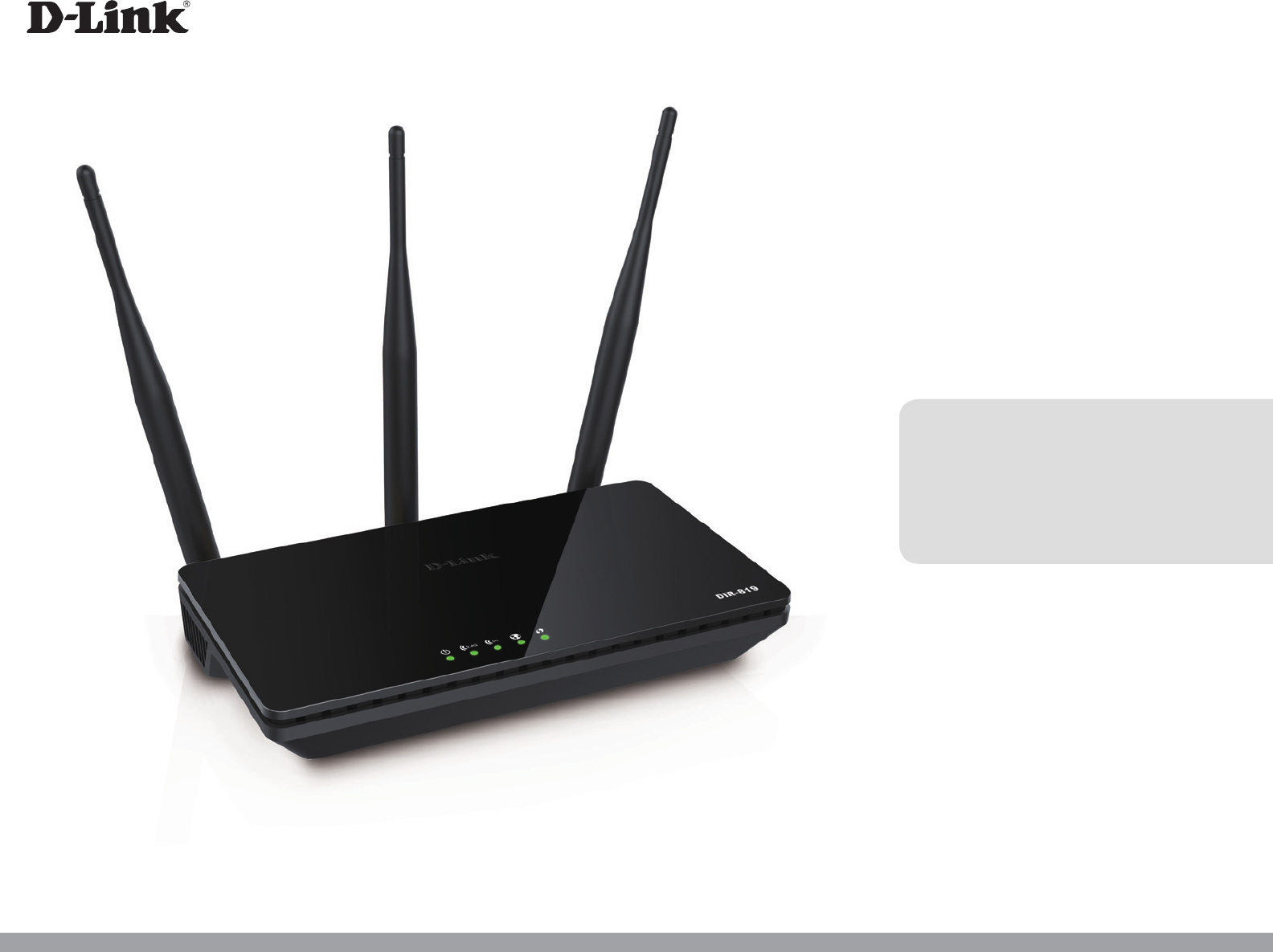
Version 1.01 | 11/04/2016
DIR-819
User Manual
Wireless AC750 Dual Band Router

iD-Link DIR-819 User Manual
D-Link reserves the right to revise this publication and to make changes in the content hereof without obligation to notify any person or organization
of such revisions or changes.
Manual Revisions
Revision Date Description
1.0 28 October, 2016 Initial release for revision A1
Trademarks
D-Link and the D-Link logo are trademarks or registered trademarks of D-Link Corporation or its subsidiaries in the United States or other countries.
All other company or product names mentioned herein are trademarks or registered trademarks of their respective companies.
Internet Explorer®, Windows® and the Windows logo are trademarks of the Microsoft group of companies.
Copyright © 2016 by D-Link Corporation, Inc.
All rights reserved. This publication may not be reproduced, in whole or in part, without prior expressed written permission from D-Link Corporation, Inc.
The purpose of this product is to create a constant network connection for your devices. As such, it does not have a standby mode or use a power
management mode. If you wish to power down this product, please simply unplug it from the power outlet.
Preface

iiD-Link DIR-819 User Manual
Table of Contents
Package Contents .............................................................. 1
System Requirements ................................................................. 2
Introduction ................................................................................... 3
Features ............................................................................................ 4
Hardware Overview ..................................................................... 5
LEDs ........................................................................................... 5
Connections ........................................................................... 6
Installation ......................................................................... 7
Before You Begin ........................................................................... 7
Wireless Installation Considerations ......................................8
Hardware Setup ............................................................................ 9
Completing Setup ......................................................................12
Setup Wizard ................................................................................13
Conguration ...................................................................21
Web UI Table of Contents ........................................................22
Setup ...............................................................................................23
Internet ................................................................................... 24
Internet Connection Setup Wizard ..........................25
Manual Internet Connection Setup ........................33
Wireless Settings .................................................................43
Wireless Connection Setup Wizard..........................44
Add Wireless Device with WPS ..................................47
Manual Wireless Connection Setup ........................50
Wireless Security Mode ...............................................52
Network Settings ................................................................54
IPv6 ..........................................................................................57
IPv6 Internet Connection Setup Wizard ................58
IPv6 Local Connectivity Settings ..............................62
Manual IPv6 Internet Connection Setup ...............63
Advanced ......................................................................................79
Virtual Server ........................................................................80
Port Forwarding ..................................................................81
Application Rules ................................................................82
QOS Engine ...........................................................................83
Network Filter.......................................................................85
Inbound Filter ......................................................................86
Access Control .....................................................................87
Add Policy ......................................................................... 88
Website Filter ........................................................................ 91
Firewall Settings ..................................................................92
Routing ...................................................................................94
Advanced Wireless .............................................................95
Wi-Fi Protected Setup .......................................................96
Advanced Network ............................................................97
Guest Zone ............................................................................98
IPv6 Firewall ..........................................................................99
IPv6 Routing ...................................................................... 101
Tools ............................................................................................. 102
Admin .................................................................................. 103
Time ...................................................................................... 104
Syslog ................................................................................... 105
System ................................................................................. 106
Firmware ............................................................................. 107
Table of Contents

iiiD-Link DIR-819 User Manual
Table of Contents
Dynamic DNS .................................................................... 108
System Check .................................................................... 109
Schedules ........................................................................... 110
Status ........................................................................................... 111
Device Info ......................................................................... 112
Logs ...................................................................................... 114
Statistics .............................................................................. 115
Internet Sessions .............................................................. 116
Wireless ............................................................................... 117
Routing ................................................................................ 118
IPV6 ....................................................................................... 119
IPv6 Routing ...................................................................... 120
Support ....................................................................................... 121
Connect a Wireless Client to Your Router .....................122
WPS Button ................................................................................ 122
Windows® 10 ............................................................................. 123
Windows® 8 ................................................................................ 125
WPA/WPA2 ......................................................................... 125
Windows® 7 ................................................................................ 127
WPA/WPA2 ......................................................................... 127
WPS ....................................................................................... 129
Windows Vista® ......................................................................... 133
WPA/WPA2 ......................................................................... 134
Troubleshooting ............................................................136
Wireless Basics ...............................................................140
What is Wireless? ...................................................................... 141
Tips ................................................................................................ 143
Wireless Modes ......................................................................... 144
Networking Basics .........................................................145
Check your IP address ............................................................ 145
Statically Assign an IP address ............................................ 146
Wireless Security ......................................................... 147
What is WPA? ................................................................ 147
Technical Specications ................................................148
Regulatory Information ................................................149

1D-Link DIR-819 User Manual
Section 1 - Product Overview
Package Contents
Note: Using a power supply with a dierent voltage rating than the one included with the DIR-819 will cause damage and void the warranty
for this product.
If any of the above items are missing, please contact your reseller.
DIR-819 Wireless AC750 Dual Band Router
Power Adapter
Ethernet Cable
Wi-Fi Conguration Card
Quick Install Guide

2D-Link DIR-819 User Manual
Section 1 - Product Overview
Network Requirements
• An Ethernet-based cable or DSL modem
• IEEE 802.11ac, 802.11n, 802.11a, 802.11g, or 802.11b wireless clients
• 10/100 Ethernet
Web-based Conguration
Utility Requirements
Computer with the following:
• Windows®, Macintosh, or Linux-based operating system
• An installed Ethernet adapter
Browser Requirements:
• Internet Explorer 9 or higher
• Firefox 20 or higher
• Safari 5.1 or higher
• Chrome 25 or higher
Windows® Users: Make sure you have the latest version of Java installed.
Visit www.java.com to download the latest version.
System Requirements

3D-Link DIR-819 User Manual
Section 1 - Product Overview
Introduction
The D-Link DIR-819 Wireless AC750 Dual Band Router shares your Internet connection over a blazing-fast wireless connection of up to 750 Mbps
(up to 433 Mbps over 5 GHz Wireless AC and up to 300 Mbps over 2.4 GHz Wireless N)1, using advanced AC beamforming technology to signicantly
outperform 802.11n and other 802.11ac devices. Equipped with one Fast Ethernet WAN/Internet port and four Fast Ethernet LAN ports, the DIR-819
creates an excellent networking experience.
Featuring four antennas, the Wireless AC750 Dual Band Router oers better data rates, fewer dead-spots, more coverage, and higher reliability.
Operating exclusively in the 5 GHz band, the DIR-819’s 802.11ac wireless connections avoid the crowded 2.4 GHz band, giving you faster speeds while
still maintaining backwards compatibility with older 802.11n/g/b devices. A stronger Wi-Fi signal means you can install more wireless surveillance
cameras, baby monitors, sensors, and alarms in the places where you need them.
The DIR-819 supports the latest security features to help prevent unauthorized access. Support for WPA™ and WPA2™ standards ensure that you
will be able to use the best possible encryption regardless of your client devices. This router is also equipped with a dual-active rewall (SPI and
NAT) to prevent potential attacks over the Internet.
The DIR-819 is full of features to improve your home network. The rich parental controls allow you to easily control when the Internet should be
available in your home and what content is allowed. With all this and more, the DIR-819 Wireless AC750 Dual Band Router will serve your network
well for years to come.
1 Maximum wireless signal rate derived from IEEE Standard 802.11a, 802.11g, 802.11n and 802.11ac specications. Actual data throughput will vary. Network conditions and
environmental factors, including volume of network trac, building materials and construction, and network overhead, lower actual data throughput rate. Environmental
conditions will adversely aect wireless signal range.

4D-Link DIR-819 User Manual
Section 1 - Product Overview
• Excellent Wireless Networking - The DIR-819 provides wireless speeds of up to a combined 750 Mbps (433 Mbps 802.11ac 5 GHz, plus
300 Mbps 802.11n 2.4 GHz)1. This capability rivals wired connections, allowing users to participate in real-time activities online, such
as HD video communication, online gaming, and use mobile devices from anywhere in your home while still oering full 802.11n/g/b
backward compatibility.
• Fast Wired LAN and WAN Networking - With four 10/100 Fast Ethernet LAN ports, and a 10/100 Fast Ethernet WAN port, the DIR-819
has an enormous amount of bandwidth to take full advantage of the highest speed broadband connections available.
• IPv6 Support - The DIR-819 fully supports IPv6 and includes support for a variety of IPv6 connection types including: SLAAC/DHCPv6,
6to4, 6rd, Static IPv6, IPv6 PPPoE, IPv6 in IPv4 tunneling, and local connectivity.
• Advanced Firewall Features - The web-based user interface displays a number of advanced network management features. Easily
apply content ltering based on MAC address, URL, and/or domain name. Schedule these lters to be active on certain days or for a
duration of hours or minutes.
• Secure Multiple/Concurrent Sessions - The DIR-819 can pass through VPN sessions. It supports multiple and concurrent IPSec and
PPTP sessions, so users behind the DIR-819 can securely access corporate networks.
• User-friendly Setup Wizard - Through its easy-to-use web-based user interface, the DIR-819 lets you quickly congure and secure
your router to your specic settings in minutes.
1 Maximum wireless signal rate derived from IEEE Standard 802.11a, 802.11g, 802.11n and 802.11ac specications. Actual data throughput will vary. Network
conditions and environmental factors, including volume of network trac, building materials and construction, and network overhead, lower actual data
throughput rate. Environmental conditions will adversely aect wireless signal range.
Features
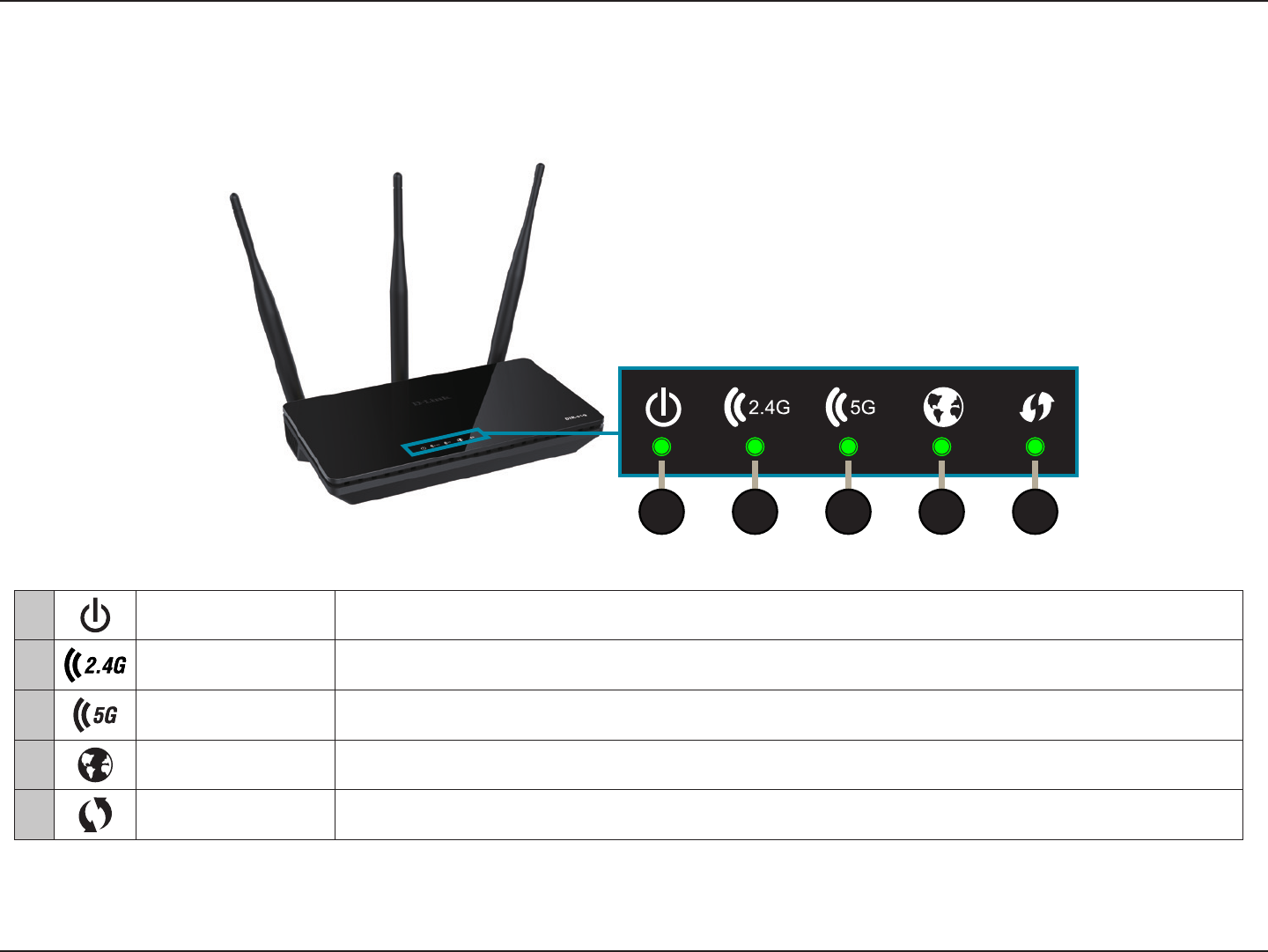
5D-Link DIR-819 User Manual
Section 1 - Product Overview
Hardware Overview
LEDs
1Power The Power LED indicates that the device is powered on with a proper connection to the power supply.
22.4 GHz Wireless The Wireless LED indicates that this wireless band is working. It blinks during wireless data transmission.
35 GHz Wireless The Wireless LED indicates that this wireless band is working. It blinks during wireless data transmission.
4 Internet The Internet LED indicates that an Internet link is established. It blinks during data transmission.
5 WPS The WPS LED blinks during the WPS pairing process.
1 2 3 4 5
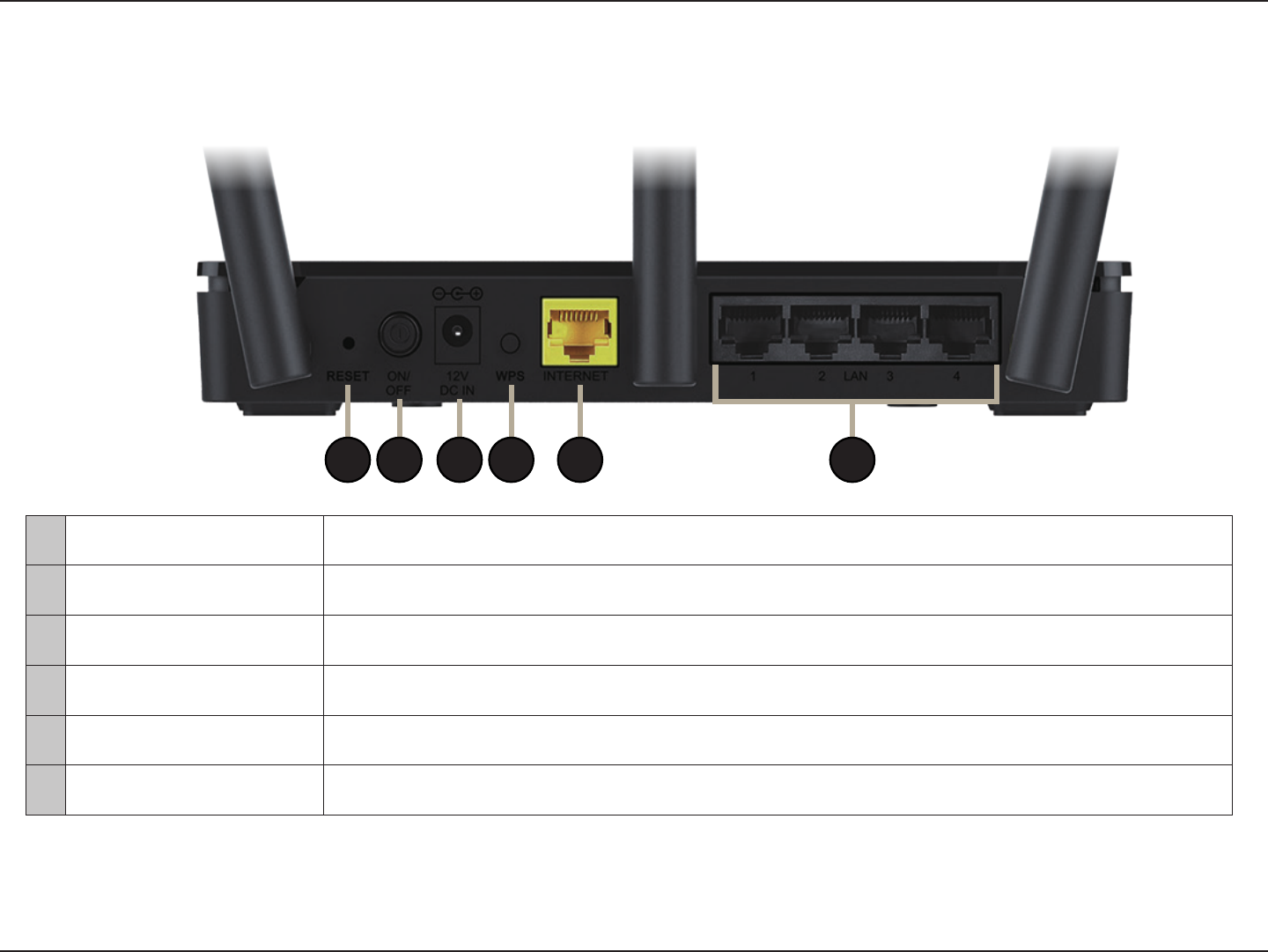
6D-Link DIR-819 User Manual
Section 1 - Product Overview
Hardware Overview
Connections
1 32 4 5 6
1 Reset Button Insert a paperclip in the hole, wait for 10 seconds, and release to reset the router to default settings.
2 Power Button Press the power button to power the device on and o.
3 Power Connector Connector for the supplied power adapter.
4 WPS Button Press to start the WPS process and automatically create a secure connection to a WPS client.
5 Internet Port Using an Ethernet cable, connect your broadband modem to this port.
6 LAN Ports (1-4) Connect Ethernet devices such as computers, switches, storage (NAS) devices and game consoles.

7D-Link DIR-819 User Manual
Section 2 - Installation
Before You Begin
Installation
• Placement of the router is very important. Do not place the router in an enclosed area such as a closet, cabinet, attic, or garage.
• Congure the router with the computer that was last connected directly to your Internet connection. Verify that it is connected to
the Internet before connecting additional devices.
• If your ISP provided you with a modem/router combo, you will need to set it to “bridge” mode so the router can work properly. Please
contact your Internet Service Provider (ISP) or refer to the user manual for your modem/router device.
• You can only use the Ethernet port on your modem. If you were using the USB connection before using the router, then you must
turn o your modem, disconnect the USB cable and connect an Ethernet cable to the Internet port on the router, and then turn the
modem back on. In some cases, you may need to call your ISP to change connection types (USB to Ethernet).
• If connecting to a DSL modem, make sure to have your DSL service information provided by your Internet Service Provider handy.
This information is likely to include your DSL account's username and password. Your ISP may also supply you with additional WAN
conguration settings which might be necessary to establish a connection.
• If you are connecting a considerable amount of networking equipment, it may be a good idea to take the time to label each cable
or take a picture of your existing setup before making any changes.
• If you have DSL and are connecting via PPPoE, make sure you disable or uninstall any PPPoE software such as WinPoET, BroadJump,
or EnterNet 300 from your computer or you will not be able to connect to the Internet.

8D-Link DIR-819 User Manual
Section 2 - Installation
Wireless Installation Considerations
This D-Link wireless device lets you access your network using a wireless connection from virtually anywhere within the operating range of your
wireless network. Keep in mind that the number, thickness and location of walls, ceilings, or other objects that the wireless signals must pass through
may limit the range. Typical ranges vary depending on the types of materials and background RF (radio frequency) noise in your home or business.
The key to maximizing wireless range is to follow these basic guidelines:
1. Keep the number of walls and ceilings between the D-Link router and other network devices to a minimum - each wall or ceiling
can reduce your adapter’s range from 1 to 30 meters (3 to 90 feet). Position your devices so that the number of walls or ceilings is
minimized.
2. Be aware of the direct line between network devices. A wall that is 0.5 meters (1.5 feet) thick, at a 45-degree angle appears to be
almost 1 meter (3 feet) thick. At a 2-degree angle it looks over 14 meters (42 feet) thick! Position devices so that the signal will
travel straight through a wall or ceiling (instead of at an angle) for better reception.
3. Building materials make a dierence. A solid metal door or aluminum studs may have a negative eect on range. Try to position
access points, wireless routers, and computers so that the signal passes through drywall or open doorways. Materials and objects
such as glass, steel, metal, walls with insulation, water (sh tanks), mirrors, le cabinets, brick, and concrete will degrade your
wireless signal.
4. Keep your product away at least 1 to 2 meters (3 to 6 feet) from electrical devices or appliances that generate RF noise.
5. If you are using 2.4 GHz cordless phones or X-10 (wireless products such as ceiling fans, lights, and home security systems), your
wireless connection may degrade dramatically or drop completely. Make sure your 2.4 GHz phone base is as far away from your
wireless devices as possible. The base transmits a signal even if the phone is not in use.
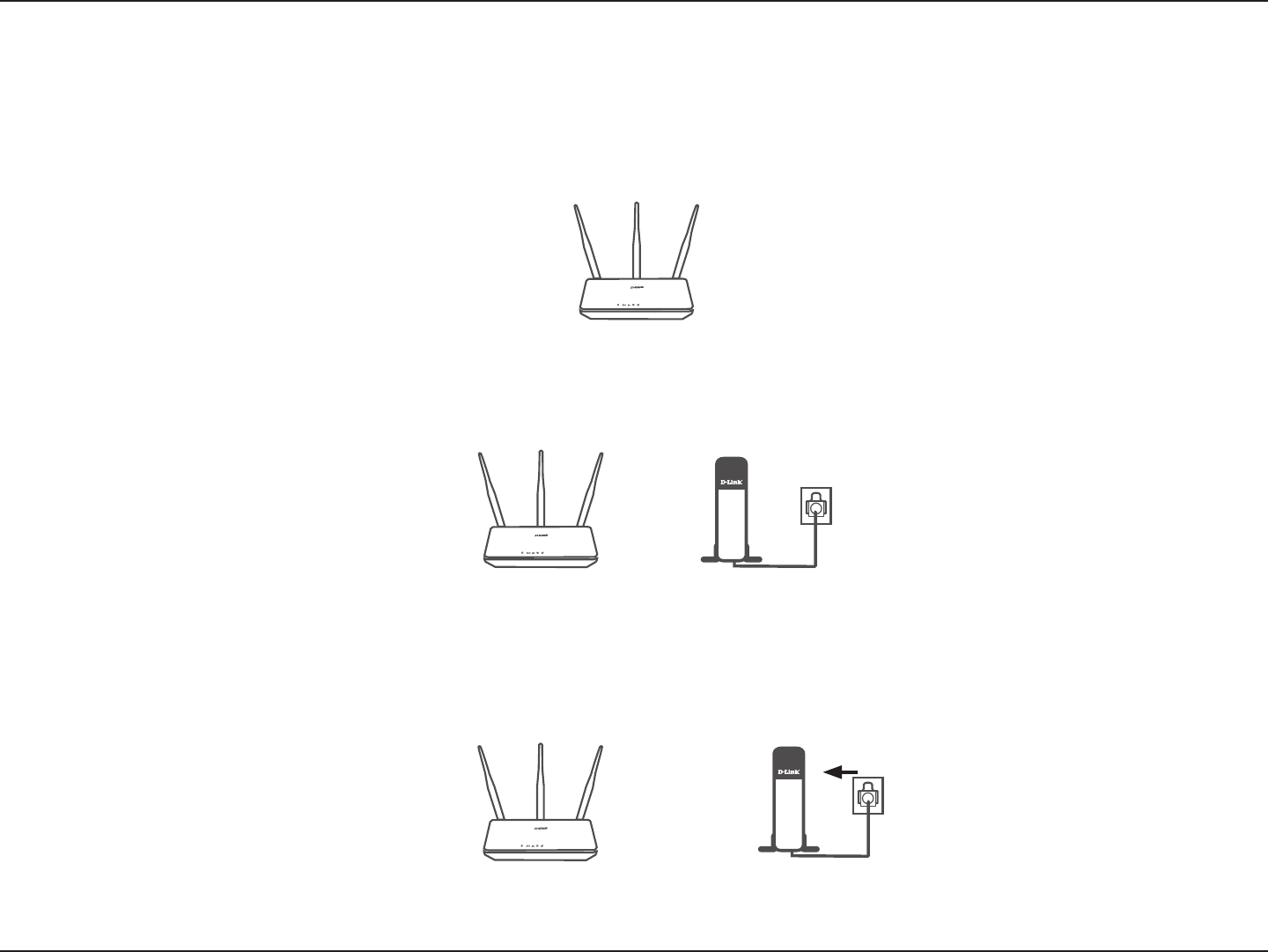
9D-Link DIR-819 User Manual
Section 2 - Installation
1. The DIR-819 is designed to give you the fastest, most stable network connection possible. In order to maximize performance, fully extend
the antennas to provide optimal wireless coverage. Keep the router in an open area for better wireless coverage.
2. Position your DIR-819 near your Internet-connected modem. Place it in an open area for better wireless coverage.
Hardware Setup
3. Turn o and unplug the power and Ethernet cable to your cable or DSL broadband modem. This is required. In some cases, you may need
to turn it o for up to ve minutes.
Modem
DIR-819
Modem
DIR-819
DIR-819
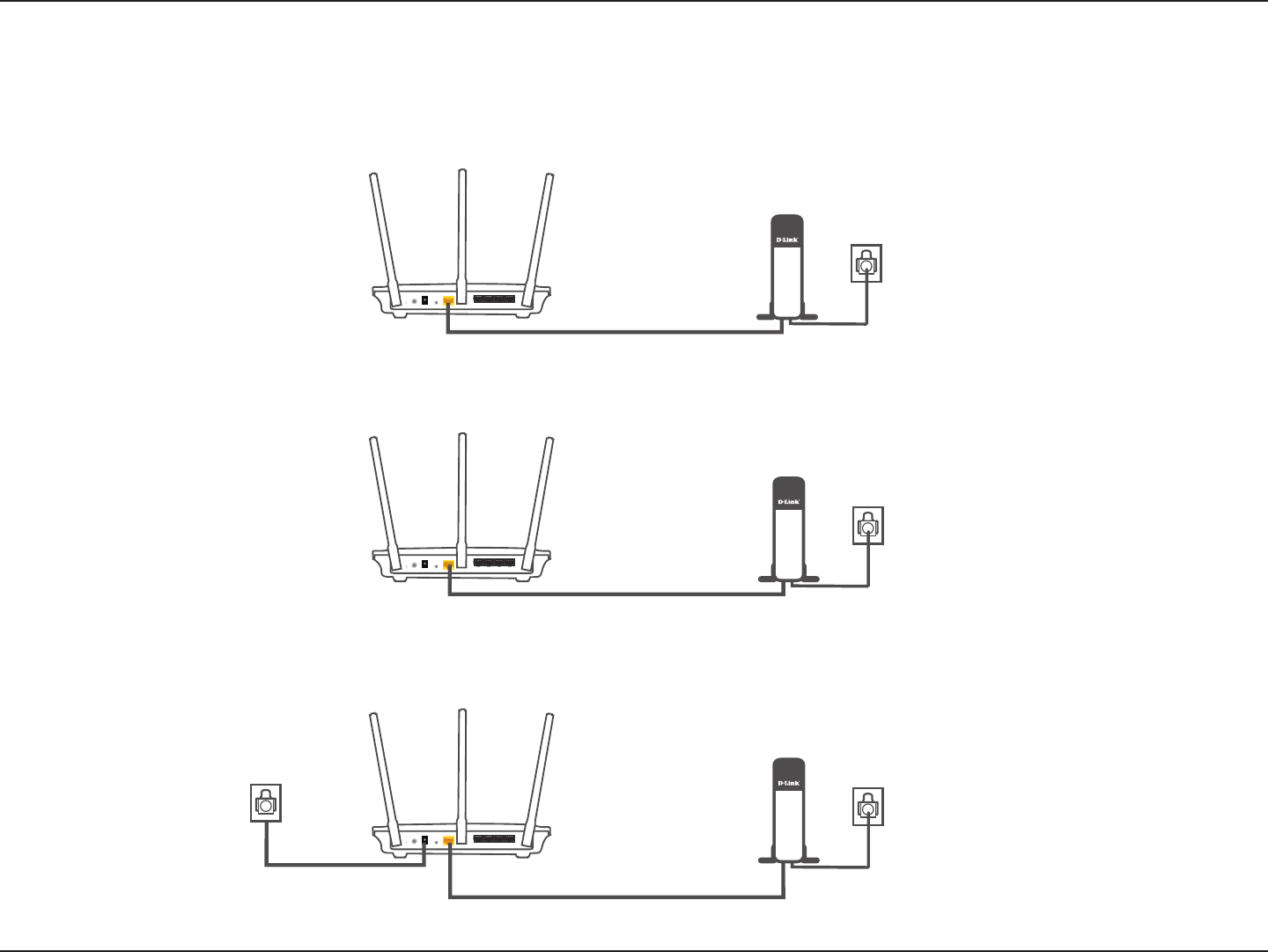
10D-Link DIR-819 User Manual
Section 2 - Installation
INTERNET
POWER POWER PORT WPS
4321
RESET
DIR-819
INTERNET
POWER POWER PORT WPS
4321
RESET
DIR-819
4. Use the included Ethernet cable to connect your modem to the yellow port labeled INTERNET on the router.
5. Turn on or plug your modem back in and wait approximately one minute before proceeding onward.
Modem
INTERNET
POWER POWER PORT WPS
4321
RESET
DIR-819
Modem
6. Connect the supplied power adapter to the router and a power outlet, press the power button, and verify that the power LED is lit. Allow
1 minute for the router to boot up.
Modem
Hardware Setup (continued)
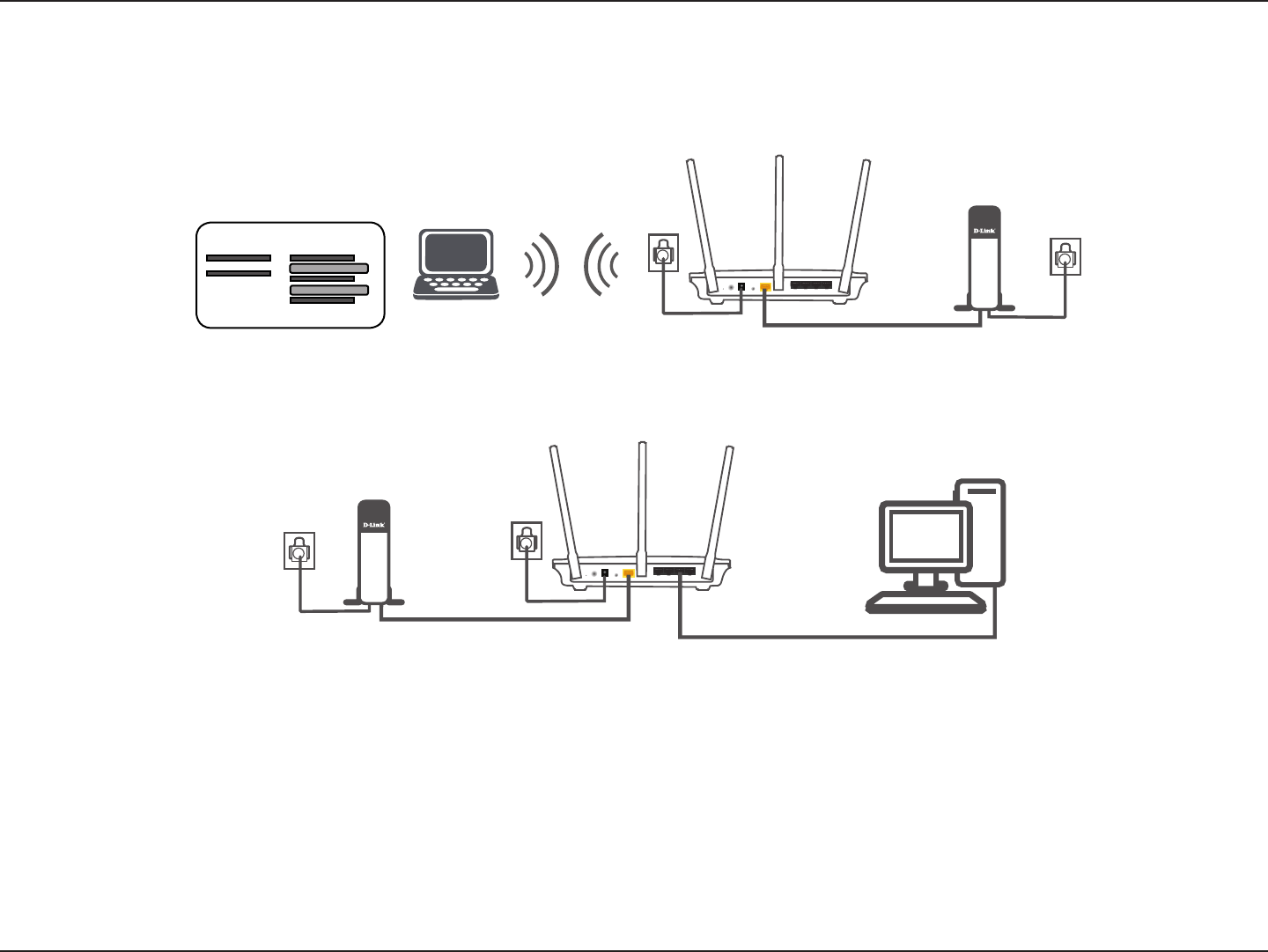
11D-Link DIR-819 User Manual
Section 2 - Installation
INTERNET
POWER POWER PORT WPS
4321
RESET
INTERNET
POWER POWER PORT WPS
4321
RESET
DIR-819
DIR-819
7. If you are conguring the DIR-819 wirelessly from a PC, connect to a Wi-Fi network printed on the included Wi-Fi conguration card. You
can also nd the Wi-Fi network names and passwords printed on the label attached to the bottom of your router.
8. If you are connecting to a broadband service that uses a dynamic connection (not PPPoE), you may be online already. Try opening a web
browser and connecting to a website. If the website does not load, proceed to Completing Setup on page 12.
If you are conguring the DIR-819 from a PC with a wired Ethernet connection, plug one end of an Ethernet cable into the port labeled
1 on the back of the router, and the other end into the Ethernet port on your computer.
Hardware Setup (continued)
Wi-Fi Conguration Card
Modem
Modem

12D-Link DIR-819 User Manual
Section 2 - Installation
Completing Setup
There are several dierent ways you can congure your router to connect to the Internet and connect to your clients:
• D-Link Setup Wizard - This wizard will launch when you log into the router for the rst time, refer to Setup Wizard on page 13.
• Manual Setup - Log into the router and manually congure your router, refer to Conguration on page 21.
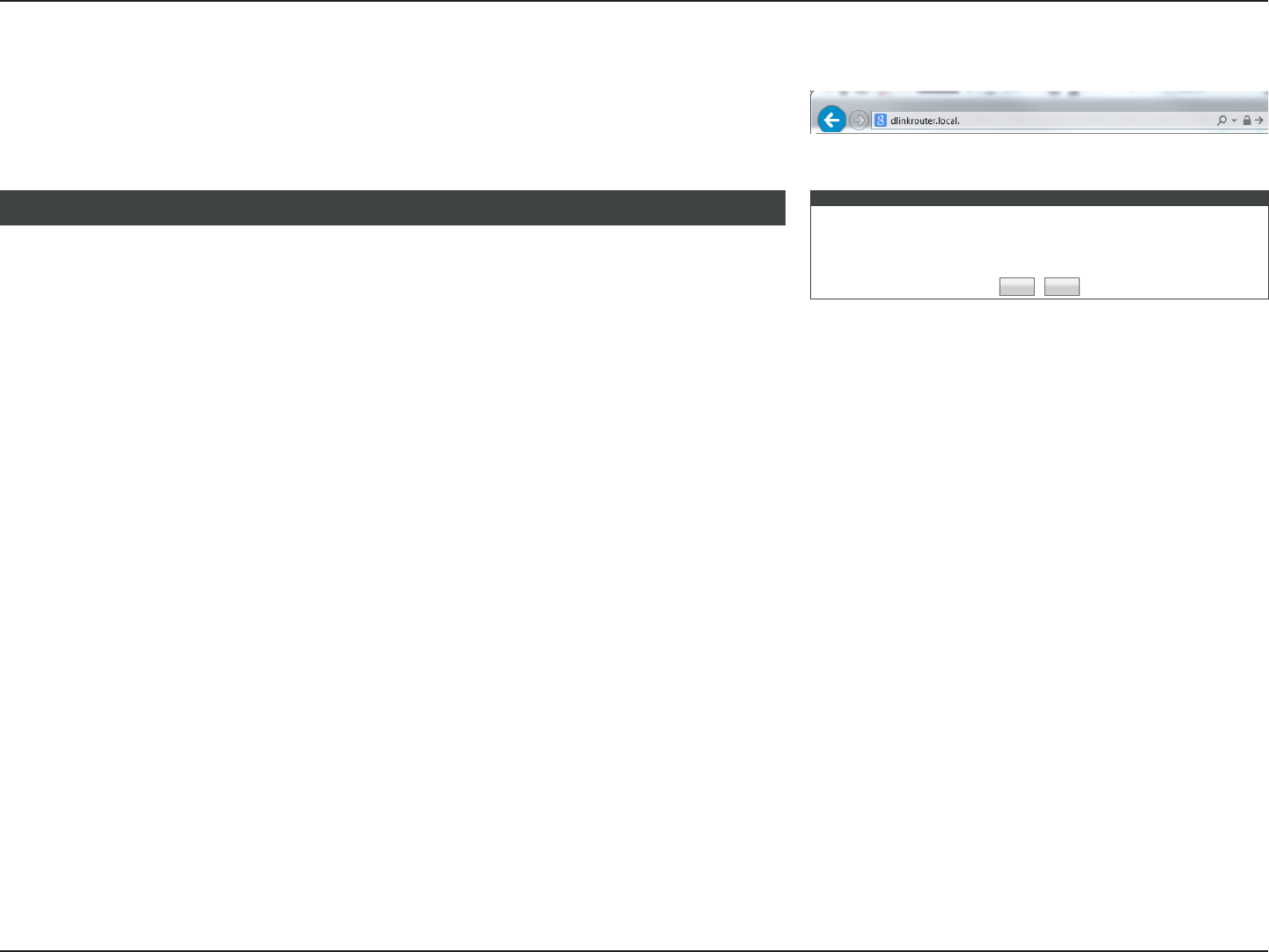
13D-Link DIR-819 User Manual
Section 2 - Installation
WELCOME TO THE D-LINK SETUP WIZARD
This wizard will guide you through a step-by-step process to congure your new D-Link router and connect to the
Internet.
• Step 1: Congure your Internet Connection
• Step 2: Congure your Wi-Fi Security
• Step 3: Set your Password
• Step 4: Select your Time Zone
• Step 5: Conrm Wi-Fi Settings
Cancel Next
The wizard is designed to guide you through a step-by-step process to congure your new
D-Link router and connect to the Internet.
Click Next to continue.
WELCOME TO THE DLINK SETUP WIZARD
Setup Wizard
If this is your first time installing the router, open your web browser and enter
http://dlinkrouter.local./ in the address bar. Alternatively, enter the IP address of the router
(default: http://192.168.0.1). The rst time you log in, the setup wizard will run.
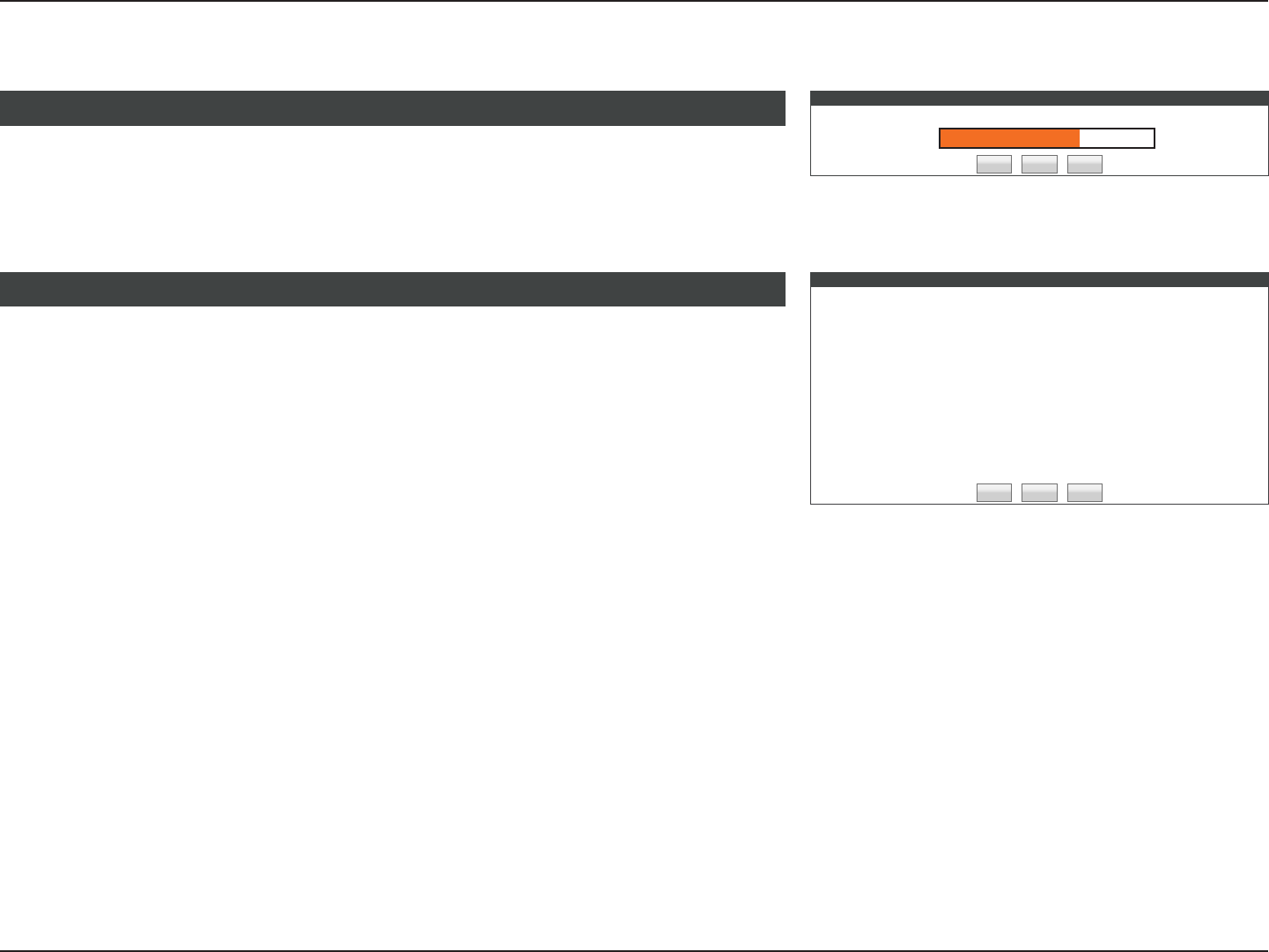
14D-Link DIR-819 User Manual
Section 2 - Installation
STEP 1: CONFIGURE YOUR INTERNET CONNECTION
The router is detecting your Internet connection type, please wait...
Cancel Prev Next
Please wait while your router attempts to detect your Internet connection type. You may
need to enter information such as your ISP account username and password.
Next to continue.
STEP 1: CONFIGURE YOUR INTERNET CONNECTION
Step 1 - Congure Your Internet Connection
STEP 1: CONFIGURE YOUR INTERNET CONNECTION
If your Internet Service Provider was not listed or you don’t know who it is, please select the Internet connection type
below:
DHCP Connection (Dynamic IP Address)
Choose this if your Internet connection automatically provides you with an IP Address. Most Cable Modems use this type of
connection.
Username / Password Connection (PPPoE)
Choose this option if your Internet connection requires a username and password to get online. Most DSL modems use this type
of connection.
Username / Password Connection (PPTP)
PPTP client.
Username / Password Connection (L2TP)
L2TP client.
Static IP Address Connection
Choose this option if your Internet Setup Provider provided you with IP Address information that has to be manually congured.
Cancel Prev Next
Select the connection type your ISP uses.
If you select DHCP Connection (Dynamic IP Address), proceed to Step 2 - Congure Your
Wi-Fi Security on page 19.
For Username / Password Connection (PPPoE) setup help refer to page 15.
For Username / Password Connection (PPTP) setup help refer to page 15.
For Username / Password Connection (L2TP) setup help refer to page 16.
For Static IP Address Connection setup help refer to page 18.
Select your connection type and click Next to continue.
STEP 1: CONFIGURE YOUR INTERNET CONNECTION
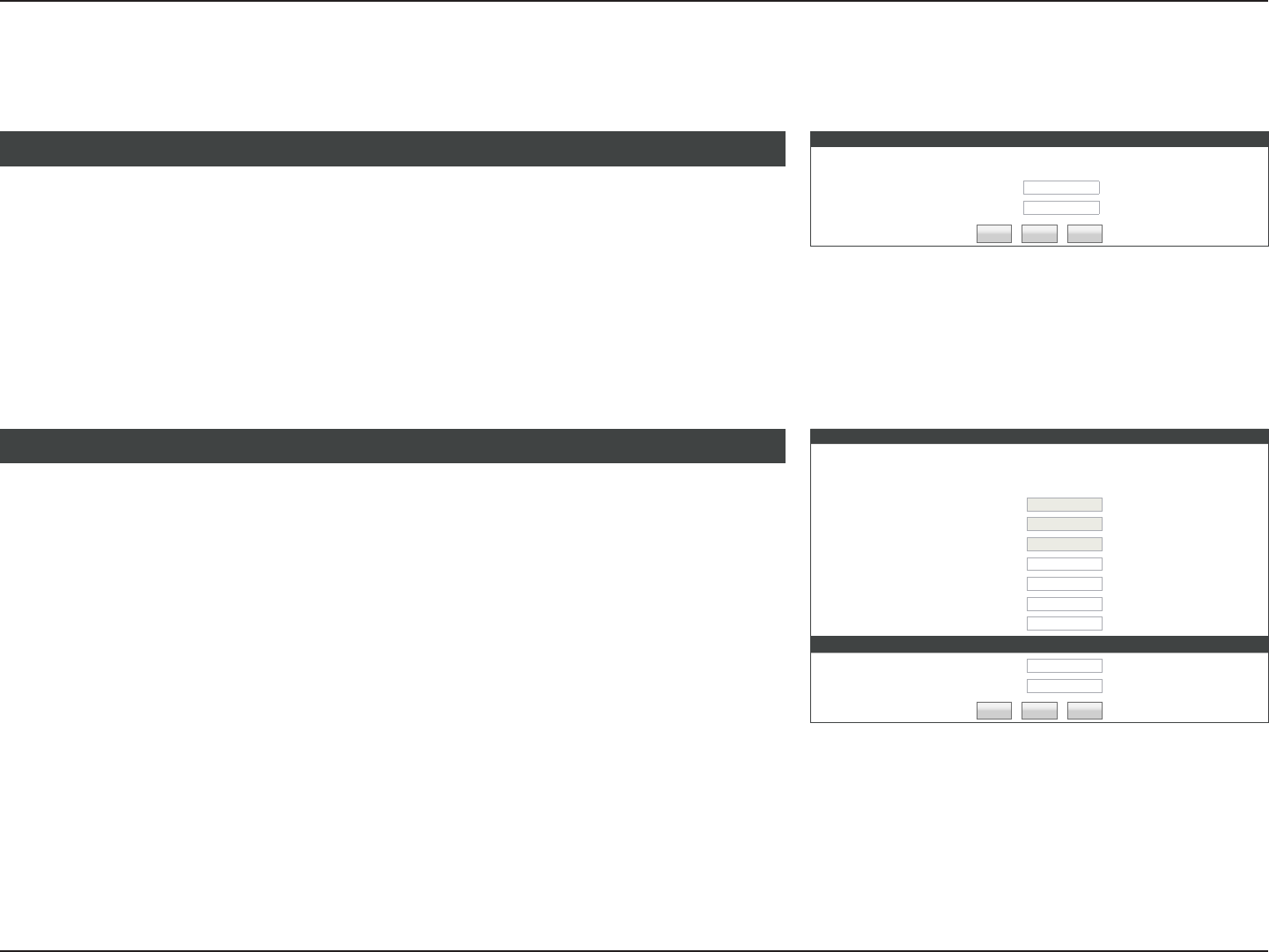
15D-Link DIR-819 User Manual
Section 2 - Installation
If you chose Username / Password Connection (PPPoE) as your Internet Connection, congure the following settings:
SET USERNAME AND PASSWORD CONNECTION (PPPOE)
To set up this connection you will need to have a Username and Password from your Internet Service Provider. If you do
not have this information, please contact your ISP.
User Name :
Password :
Cancel Prev Next
Username: Enter the username provided by your ISP.
Password: Enter the password provided by your ISP.
Click Next and proceed to Step 2 - Congure Your Wi-Fi Security on page 19.
SET USERNAME AND PASSWORD CONNECTION PPPOE
Username / Password Connection (PPPoE)
If you choose Username / Password Connection (PPTP) as your Internet Connection, enter your IP address, congure the following settings:
SET USERNAME AND PASSWORD CONNECTION (PPTP)
To set up this connection you will need to have a Username and Password from your Internet Service Provider. You also
need PPTP IP address. If you do not have this information, please contact your ISP.
Address Mode : Dynamic IP Static IP
PPTP IP Address :
PPTP Subnet Mask :
PPTP Gateway IP Address :
PPTP Server IP Address (may be
same as gateway):
User Name :
Password :
Verify Password :
DNS SETTINGS
Primary DNS Address :
Secondary DNS Address :
Cancel Prev Next
Address Mode: Select either Dynamic IP or Static IP
If you choose Static IP as the Address Mode, enter your IP address:
PPTP IP Address: Enter the PPTP IP Address provided by your ISP.
PPTP Subnet
Mask:
Enter the PPTP Subnet Mask provided by your ISP.
PPTP Gateway IP
Address:
Enter the PPTP Gateway IP Address provided by your ISP.
If you choose Dynamic IP or Static IP as the Address Mode, enter your PPTP Server IP
address:
PPTP Server IP
Address:
Enter the PPTP Server IP address provided by your ISP.
SET USERNAME AND PASSWORD CONNECTION PPTP
Username / Password Connection (PPTP)
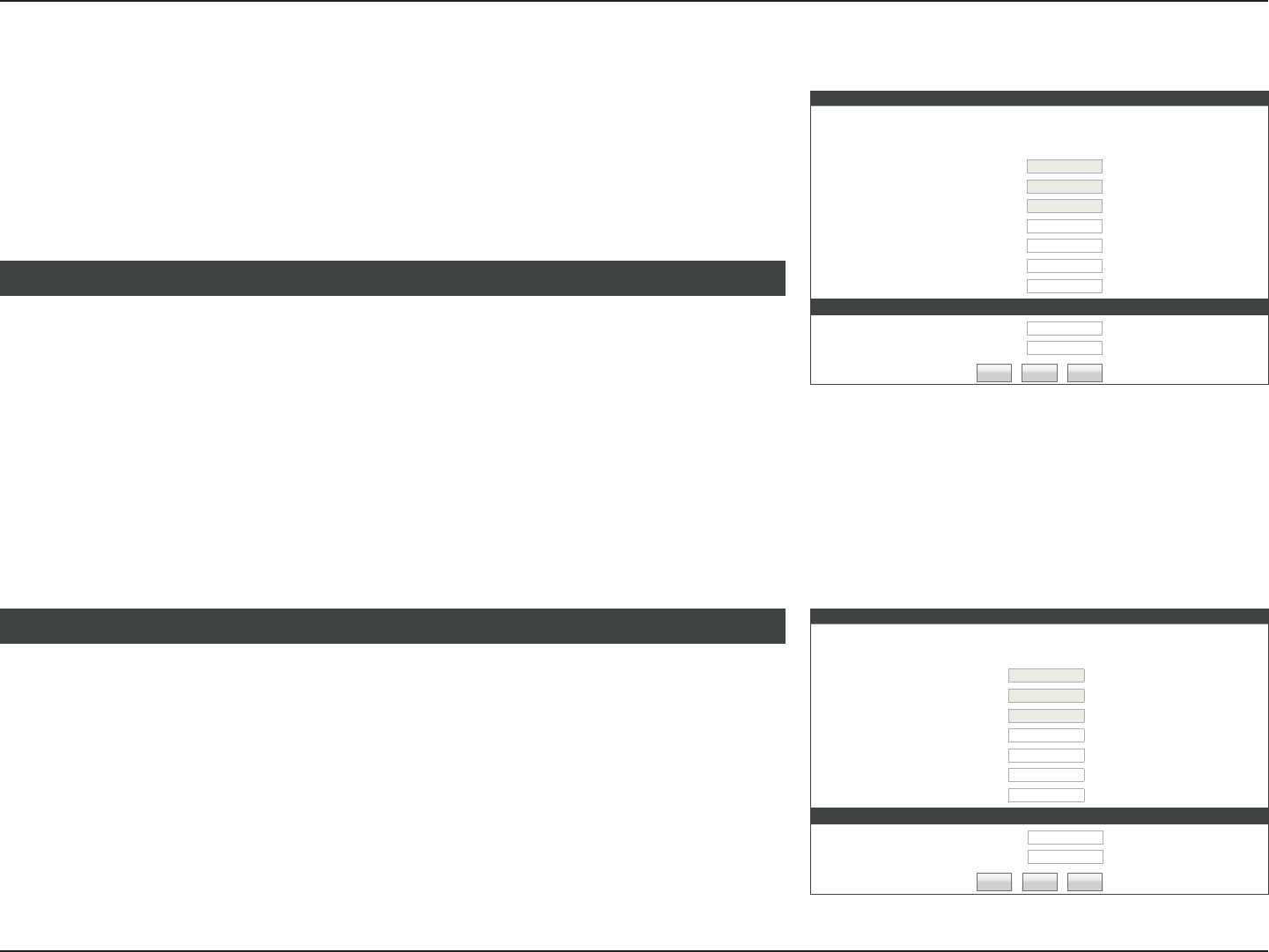
16D-Link DIR-819 User Manual
Section 2 - Installation
SET USERNAME AND PASSWORD CONNECTION (PPTP)
To set up this connection you will need to have a Username and Password from your Internet Service Provider. You also
need PPTP IP address. If you do not have this information, please contact your ISP.
Address Mode : Dynamic IP Static IP
PPTP IP Address :
PPTP Subnet Mask :
PPTP Gateway IP Address :
PPTP Server IP Address (may be
same as gateway):
User Name :
Password :
Verify Password :
DNS SETTINGS
Primary DNS Address :
Secondary DNS Address :
Cancel Prev Next
Username / Password Connection (PPTP) (continued)
Primary DNS
Server:
Enter the primary DNS server IP addresses.
Secondary DNS
Server:
Enter the secondary DNS server IP addresses.
Click Next and proceed to Step 2 - Congure Your Wi-Fi Security on page 19.
DNS SETTINGS
User Name: Enter the username provided by your ISP.
Password: Enter the password provided by your ISP.
Verify Password: Enter the password provided by your ISP one more time.
If you choose Username / Password Connection (L2TP) as your Internet Connection, enter your IP address, congure the following settings:
SET USERNAME AND PASSWORD CONNECTION (L2TP)
To set up this connection you will need to have a Username and Password from your Internet Service Provider. You also
need L2TP IP address. If you do not have this information, please contact your ISP.
Address Mode : Dynamic IP Static IP
L2TP IP Address :
L2TP Subnet Mask :
L2TP Gateway IP Address :
L2TP Server IP Address : (may be same as gateway)
User Name :
Password :
Verify Password :
DNS SETTINGS
Primary DNS Address :
Secondary DNS Address : (optional)
Cancel Prev Next
Address Mode: Select either Dynamic IP or Static IP
If you choose Static IP as the Address Mode, enter your IP address:
L2TP IP Address: Enter the L2TP IP Address provided by your ISP.
L2TP Subnet
Mask:
Enter the L2TP Subnet Mask provided by your ISP.
L2TP Gateway IP
Address:
Enter the L2TP Gateway IP Address provided by your ISP.
SET USERNAME AND PASSWORD CONNECTION L2TP
Username / Password Connection (L2TP)

17D-Link DIR-819 User Manual
Section 2 - Installation
Primary DNS
Server:
Enter the primary DNS server IP addresses.
Secondary DNS
Server:
Enter the secondary DNS server IP addresses.
Click Next and proceed to Step 2 - Congure Your Wi-Fi Security on page 19.
DNS SETTINGS
If you choose Dynamic IP or Static IP as the Address Mode, enter your PPTP Server IP
address:
L2TP Server IP
Address:
Enter the L2TP Server IP address provided by your ISP.
Username: Enter the username provided by your ISP.
Password: Enter the password provided by your ISP.
Verify Password: Enter the password provided by your ISP one more time.
Username / Password Connection (L2TP) (continued)
SET USERNAME AND PASSWORD CONNECTION (L2TP)
To set up this connection you will need to have a Username and Password from your Internet Service Provider. You also
need L2TP IP address. If you do not have this information, please contact your ISP.
Address Mode : Dynamic IP Static IP
L2TP IP Address :
L2TP Subnet Mask :
L2TP Gateway IP Address :
L2TP Server IP Address : (may be same as gateway)
User Name :
Password :
Verify Password :
DNS SETTINGS
Primary DNS Address :
Secondary DNS Address : (optional)
Cancel Prev Next
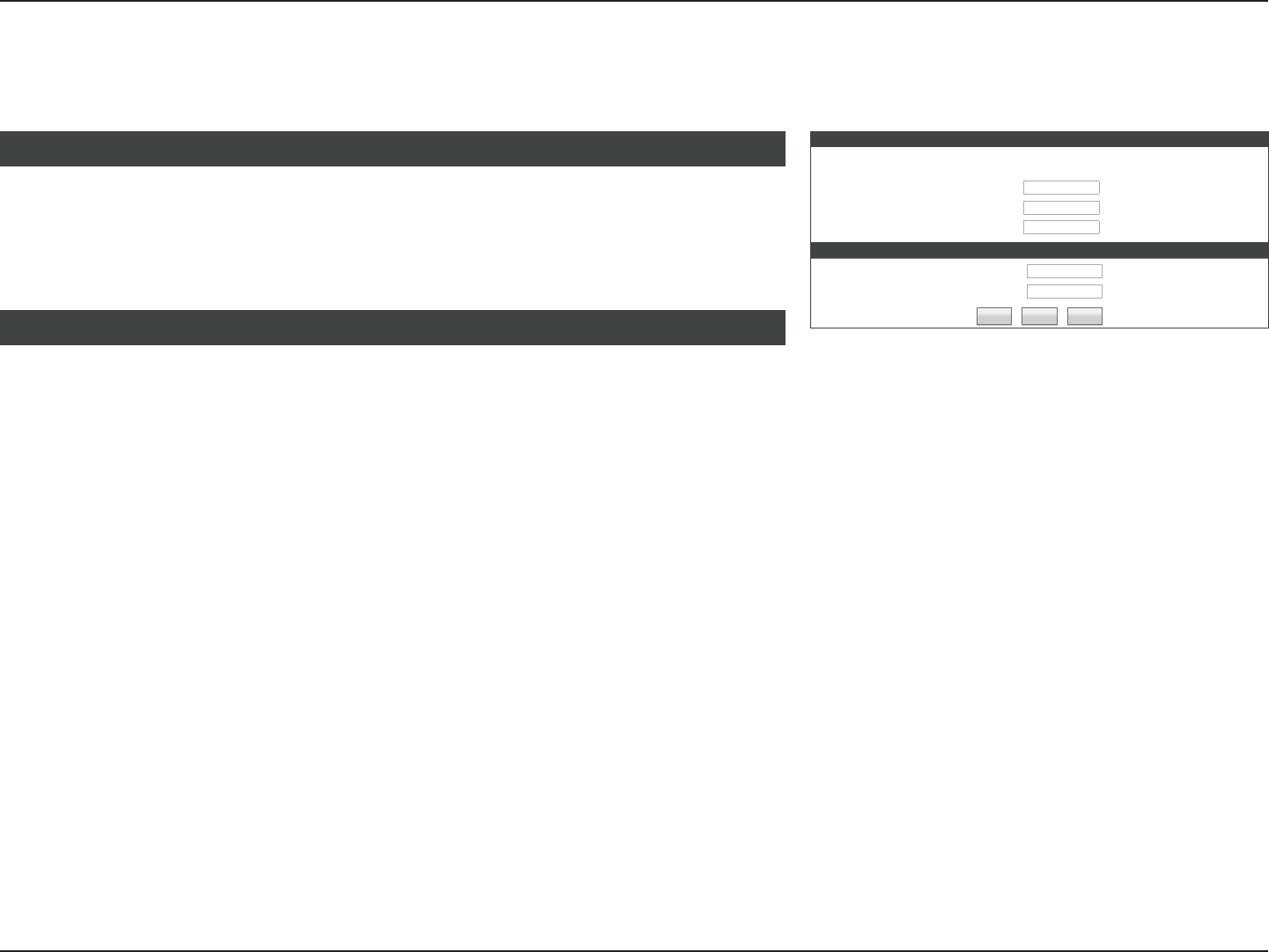
18D-Link DIR-819 User Manual
Section 2 - Installation
If you choose Static IP Address Connection as your Internet Connection, enter your IP address, congure the following settings:
SET STATIC IP ADDRESS CONNECTION
To set up this connection you will need to have a complete list of IP information provided by your Internet Service
Provider. If you have a Static IP connection and do not have this information, please contact your ISP.
IP Address :
Subnet Mask :
Default Gateway :
DNS SETTINGS
Primary DNS Address :
Secondary DNS Address : (optional)
Cancel Prev Next
IP Address: Enter the IP address provided by your ISP.
Subnet Mask: Enter the subnet mask.
Default Gateway: Enter the default gateway.
SET STATIC IP ADDRESS CONNECTION
Primary DNS
Server:
Enter the primary DNS server IP addresses.
Secondary DNS
Server:
Enter the secondary DNS server IP addresses.
Click Next and proceed to Step 2 - Congure Your Wi-Fi Security on page 19.
DNS SETTINGS
Static IP Address Connection
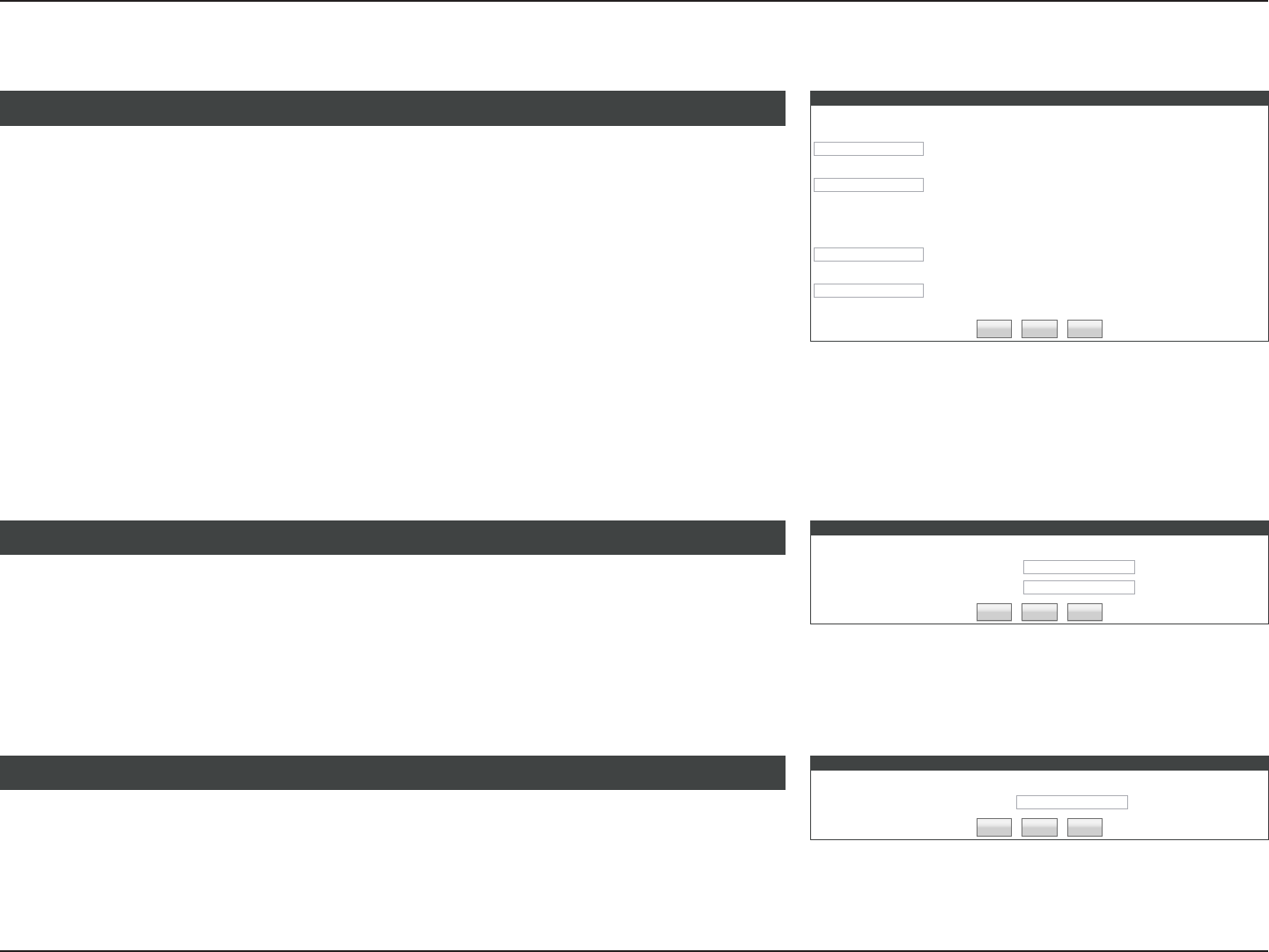
19D-Link DIR-819 User Manual
Section 2 - Installation
Step 2 - Congure Your Wi-Fi Security
STEP 2: CONFIGURE YOUR WI-FI SECURITY
Give your Wi-Fi network a name and a password. (2.4GHz Band)
Wi-Fi Network Name(SSID) :
Your_2.4GHz_Network (Using up to 32 characters)
Wi-Fi Password :
A_Str0ng_P@ssWord! (Between 8 and 63 characters)
Give your Wi-Fi network a name and a password. (5GHz Band)
Wi-Fi Network Name(SSID) :
Your_5GHz_Network (Using up to 32 characters)
Wi-Fi Password :
A_Str0ng_P@ssWord! (Between 8 and 63 characters)
Cancel Prev Next
Wi-Fi Network
Name(SSID):
Enter a name for the 2.4 GHz wireless network.
Wi-Fi Password: Enter a wireless password according to the onscreen guidelines.
Wi-Fi Network
Name(SSID):
Enter a name for the 5 GHz wireless network.
Wi-Fi Password: Enter a wireless password according to the onscreen guidelines.
Click Next to continue.
STEP 2: CONFIGURE YOUR WIFI SECURITY
Step 3: Set Your Password
Step 4: Select Your Time Zone
STEP 3: SET YOUR PASSWORD
By default, your new D-Link Router does not have a password congured for administrator access to the Web-based
conguration pages. To secure your new networking device, please set and verify a password below:
Password :
Verify Password :
Cancel Prev Next
Enter a new administration password. This is the password you will use to log in to the router.
Click Next to continue.
STEP 3: SET YOUR PASSWORD
STEP 4: SELECT YOUR TIME ZONE
Select the appropriate time zone for your location. This information is required to congure the time-based options for
the router.
Time Zone : (GMT+08:00) Taipei ▼
Cancel Prev Next
Select your time zone. Click Next to continue.
STEP 4: SELECT YOUR TIME ZONE
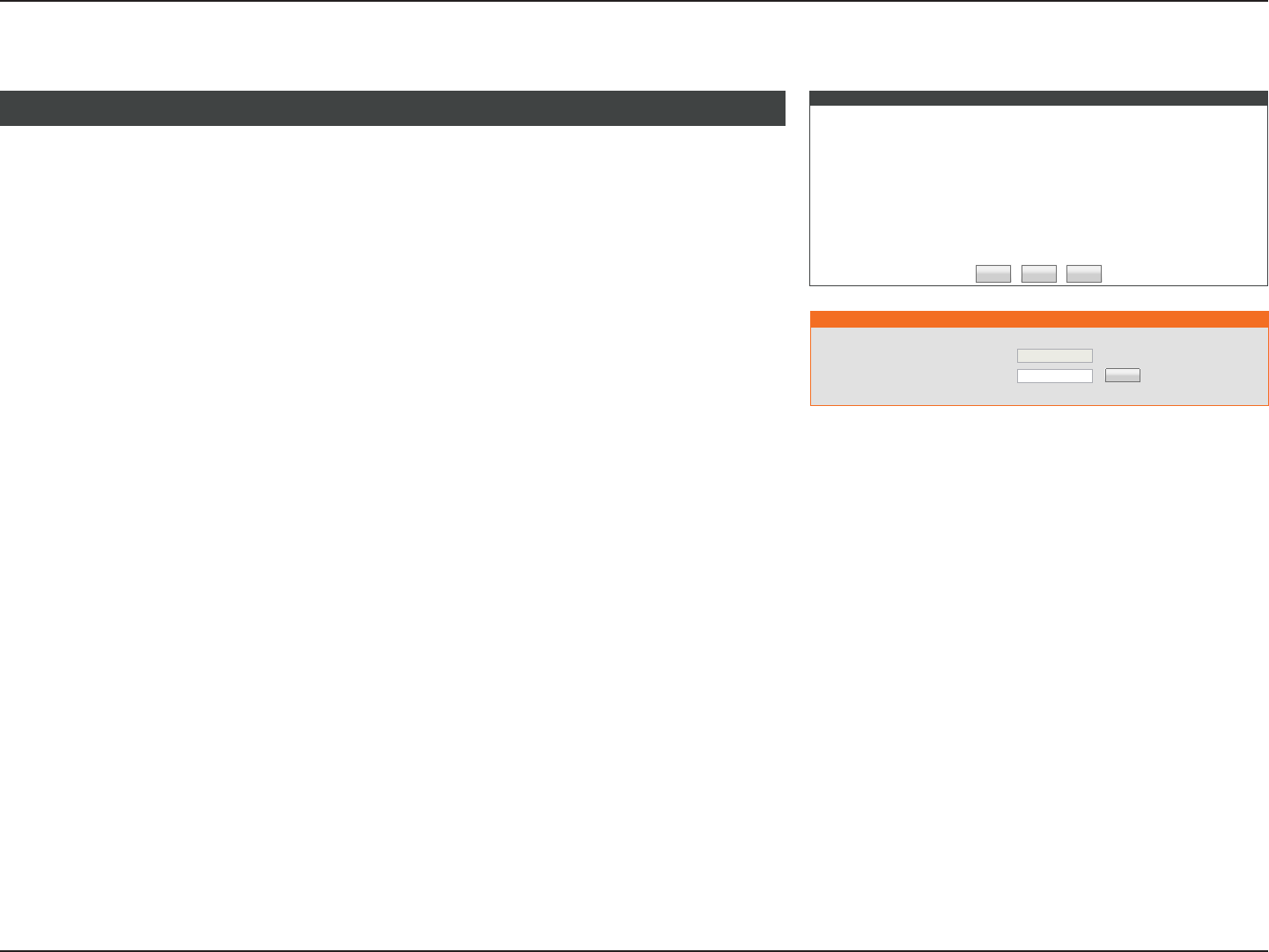
20D-Link DIR-819 User Manual
Section 2 - Installation
Step 5: Conrm Wi-Fi Settings
STEP 5: CONFIRM WI-FI SETTINGS
Below is a detailed summary of your wireless security settings. Please print this page out, or write the information on a
piece of paper, so you can congure the correct settings on your Wi-Fi devices.
Wi-Fi Network Name(SSID) 2.4GHz : Your_2.4GHz_Network
Wi-Fi Password A_Str0ng_P@ssWord!
Wi-Fi Network Name(SSID) 5GHz : Your_5GHz_Network
Wi-Fi Password A_Str0ng_P@ssWord!
Cancel Prev Next
Step 5 is a summary of your wireless settings. Click Next to nish the wizard.
STEP 5: CONFIRM WIFI SETTINGS
LOGIN
Login to the router :
User Name : Admin
Password : Login
Congratulations, your device has been successfully congured. The router will reboot and
display the login page.
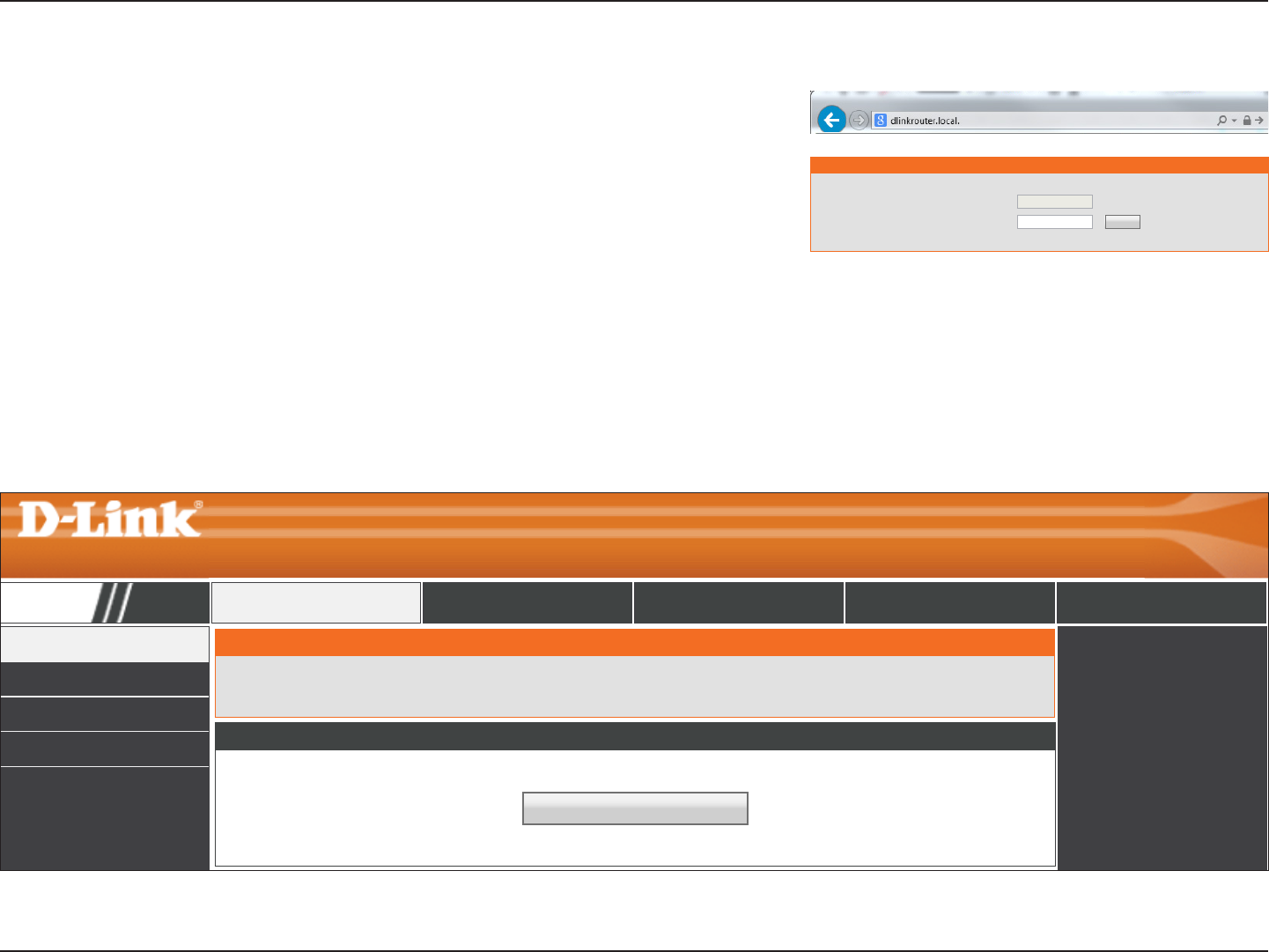
21D-Link DIR-819 User Manual
Section 3 - Conguration
This section will show you how to congure or change the default settings your D-Link
DIR-819 using the web-based conguration utility.
Conguration
To access the conguration utility, open a web browser such as Internet Explorer and enter
http://dlinkrouter.local./ or you may also connect by typing the IP address of the router
(by default this is http://192.168.0.1) in the address bar.
LOGIN
Login to the router :
User Name : Admin
Password : Login
Enter your password. If you previously followed the setup wizard, please use the
admin password you entered during the wizard. Otherwise, leave the password blank.
Click Login to proceed.
Note: If you cannot remember your password and cannot log in, press the reset button on the
back of the device for longer than 10 seconds to restore the router to its default settings.
If you are having trouble logging in or experiencing trouble with the conguration utility,
try clearing your browser cache or try using your web browser’s private browsing mode.
DIR-819 SETUP ADVANCED TOOLS STATUS SUPPORT
INTERNET
WIRELESS SETTINGS
NETWORK SETTINGS
IPV6
INTERNET CONNECTION
If you are conguring the device for the rst time, we recommend that you click on the Internet Connection Setup Wizard, and follow
the instructions on the screen. If you wish to modify or congure the device settings manually, click the Manual Internet Connection
Setup.
INTERNET CONNECTION SETUP WIZARD
If you would like to utilize our easy to use Web-based Wizard to assist you in connecting your new D-Link Systems Router to the
Internet, click on the button below.
Internet Connection Setup Wizard
Note:Before launching the wizard, please make sure you have followed all steps outlined in the Quick Installation Guide included in the
package.
MANUAL INTERNET CONNECTION OPTION
If you would like to congure the Internet settings of your new D-Link Router manually, then click on the button below.
Manual Internet Connection Setup
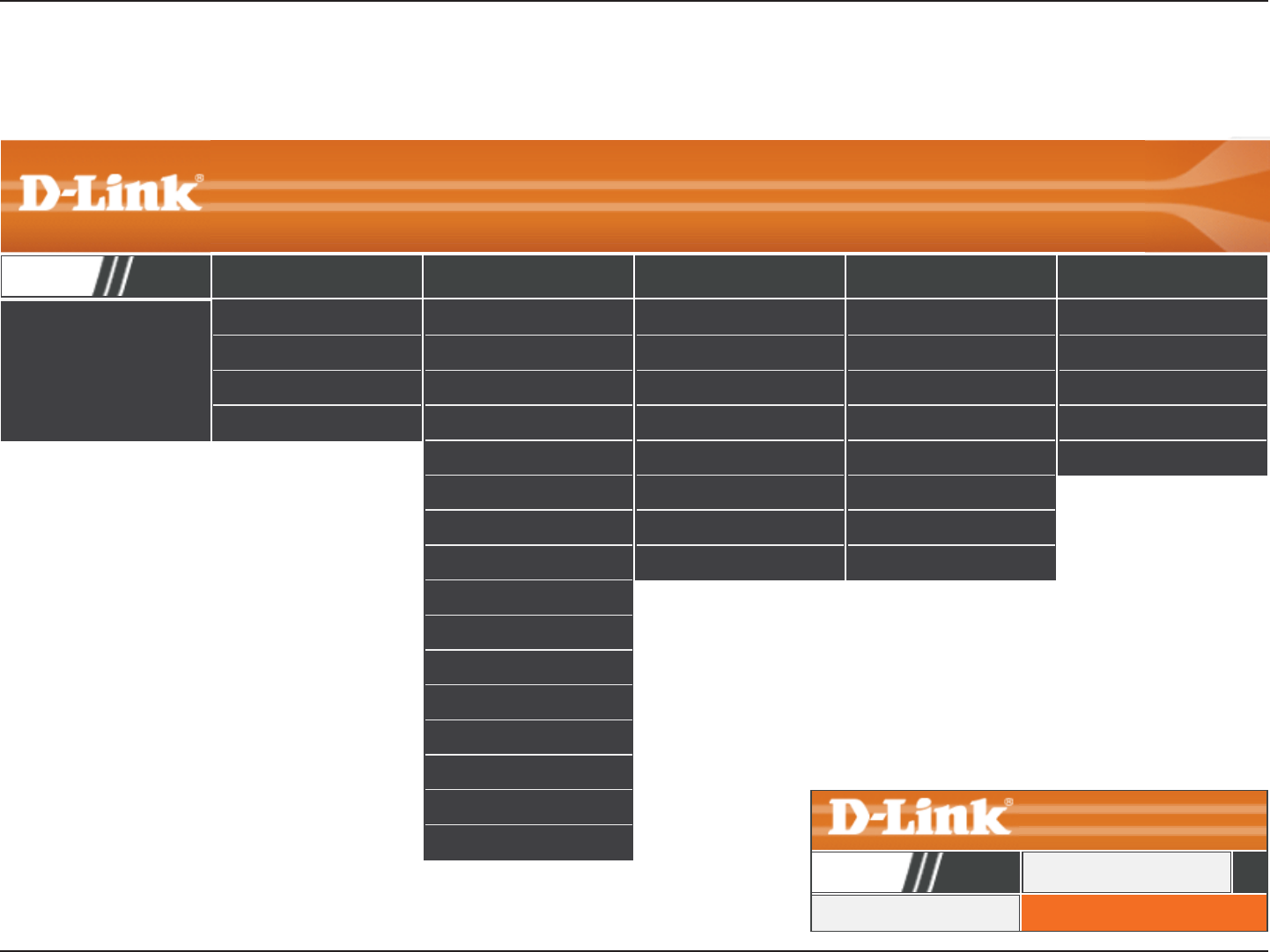
22D-Link DIR-819 User Manual
Section 3 - Conguration
Web UI Table of Contents
The web-based interface is divided into 5 horizontal tabs, each with a vertical menu bar running along the left side.
You may click on these section titles to quickly navigate to a section of this document.
To return to this Web UI Table of Contents page, simply click the D-Link logo on the top
right of each page.
DIR-819 SETUP ADVANCED TOOLS STATUS SUPPORT
INTERNET
WIRELESS SETTINGS
NETWORK SETTINGS
IPV6
ADMIN
TIME
SYSLOG
SYSTEM
FIRMWARE
DYNAMIC DNS
SYSTEM CHECK
SCHEDULES
DEVICE INFO
LOGS
STATISTICS
INTERNET SESSIONS
WIRELESS
ROUTING
IPV6
IPV6 ROUTING
MENU
SETUP
ADVANCED
TOOLS
STATUS
VIRTUAL SERVER
PORT FORWARDING
APPLICATION RULES
QOS ENGINE
NETWORK FILTER
INBOUND FILTER
ACCESS CONTROL
WEBSITE FILTER
FIREWALL SETTINGS
ROUTING
ADVANCED WIRELESS
WI-FI PROTECTED SETUP
ADVANCED NETWORK
GUEST ZONE
IPV6 FIREWALL
IPV6 ROUTING
INTERNET CONNECTIONINTERNET
DIR-819 SETUP
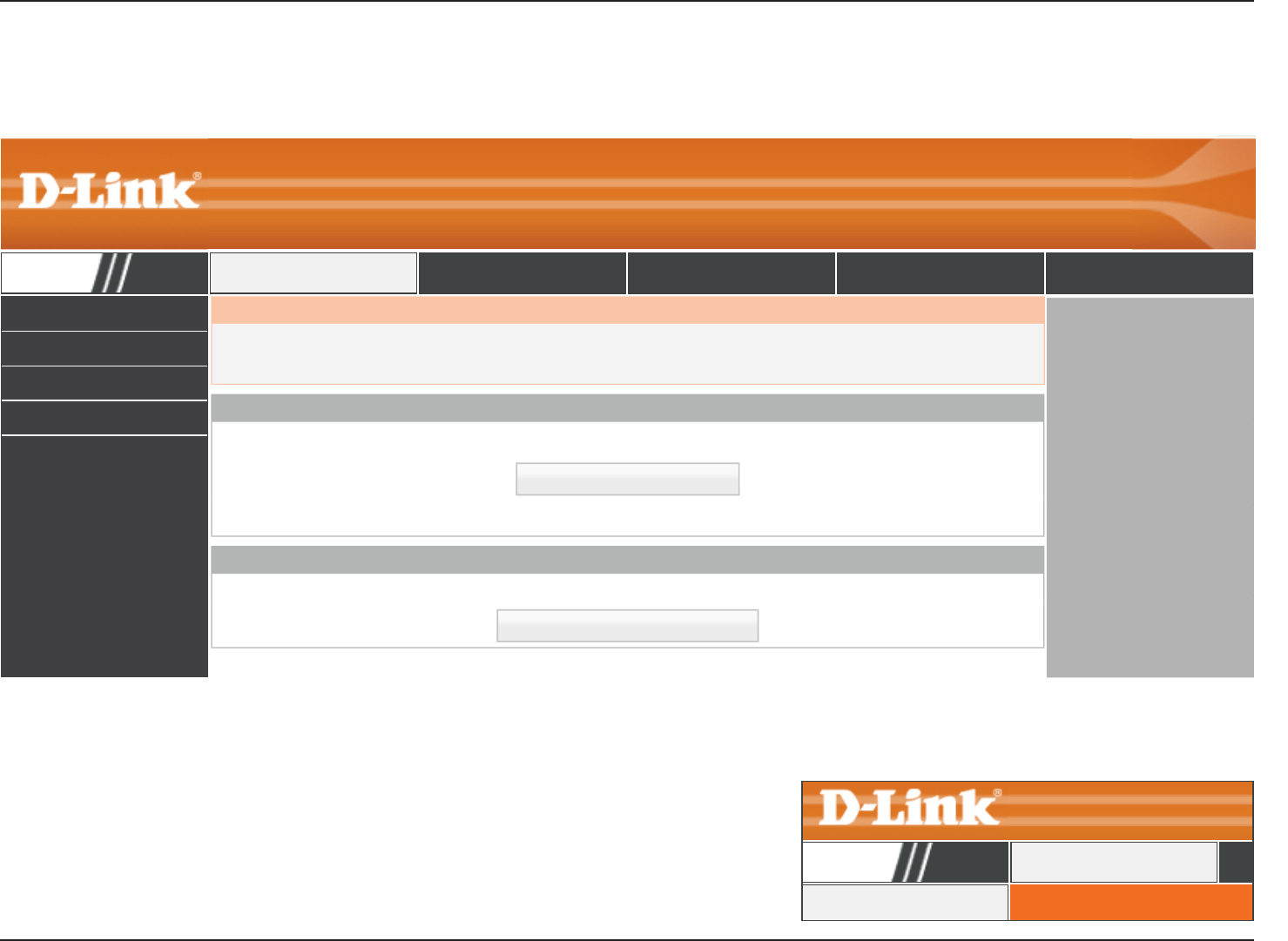
23D-Link DIR-819 User Manual
Section 3 - Conguration
Setup
INTERNET
WIRELESS SETTINGS
NETWORK SETTINGS
IPV6
The Setup tab provides access to congure the basic conguration settings of your DIR-819.
To return to the Web UI Table of Contents page, simply click the D-Link logo on the top right
of each page. INTERNET CONNECTIONINTERNET
DIR-819 SETUP
DIR-819 SETUP ADVANCED TOOLS STATUS SUPPORT
INTERNET CONNECTION
If you are conguring the device for the rst time, we recommend that you click on the Internet Connection Setup Wizard, and follow
the instructions on the screen. If you wish to modify or congure the device settings manually, click the Manual Internet Connection
Setup.
INTERNET CONNECTION SETUP WIZARD
If you would like to utilize our easy to use Web-based Wizard to assist you in connecting your new D-Link Systems Router to the
Internet, click on the button below.
Internet Connection Setup Wizard
Note:Before launching the wizard, please make sure you have followed all steps outlined in the Quick Installation Guide included in the
package.
MANUAL INTERNET CONNECTION OPTION
If you would like to congure the Internet settings of your new D-Link Router manually, then click on the button below.
Manual Internet Connection Setup
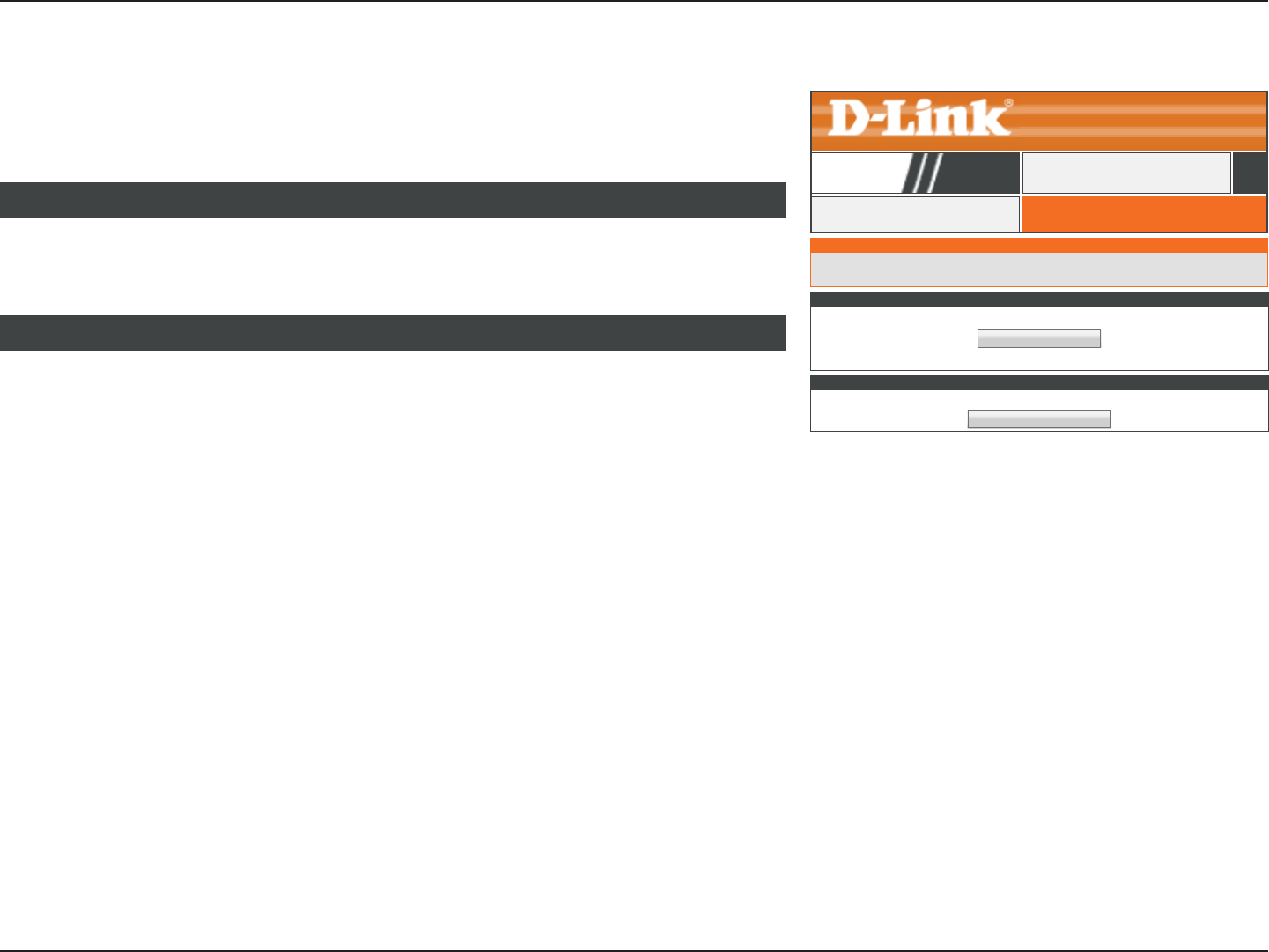
24D-Link DIR-819 User Manual
Section 3 - Conguration
Internet
INTERNET CONNECTIONINTERNET
DIR-819 SETUP
Click Internet on the navigation menu to congure your Internet connection. Using the
Internet Connection Setup Wizard is recommended. To manually congure your Internet
connection, select Manual Internet Connection Setup.
Click Internet Connection Setup Wizard to congure your Internet Connection. Refer to
Internet Connection Setup Wizard on page 25.
INTERNET CONNECTION SETUP WIZARD
Click Manual Internet Connection Setup to manually add or congure your Internet
connection. Refer to Manual Wireless Connection Setup on page 50.
MANUAL INTERNET CONNECTION OPTION
INTERNET CONNECTION
If you are conguring the device for the rst time, we recommend that you click on the Internet Connection Setup Wizard, and follow
the instructions on the screen. If you wish to modify or congure the device settings manually, click the Manual Internet Connection
Setup.
INTERNET CONNECTION SETUP WIZARD
If you would like to utilize our easy to use Web-based Wizard to assist you in connecting your new D-Link Systems Router to the
Internet, click on the button below.
Internet Connection Setup Wizard
Note:Before launching the wizard, please make sure you have followed all steps outlined in the Quick Installation Guide included in the
package.
MANUAL INTERNET CONNECTION OPTION
If you would like to congure the Internet settings of your new D-Link Router manually, then click on the button below.
Manual Internet Connection Setup
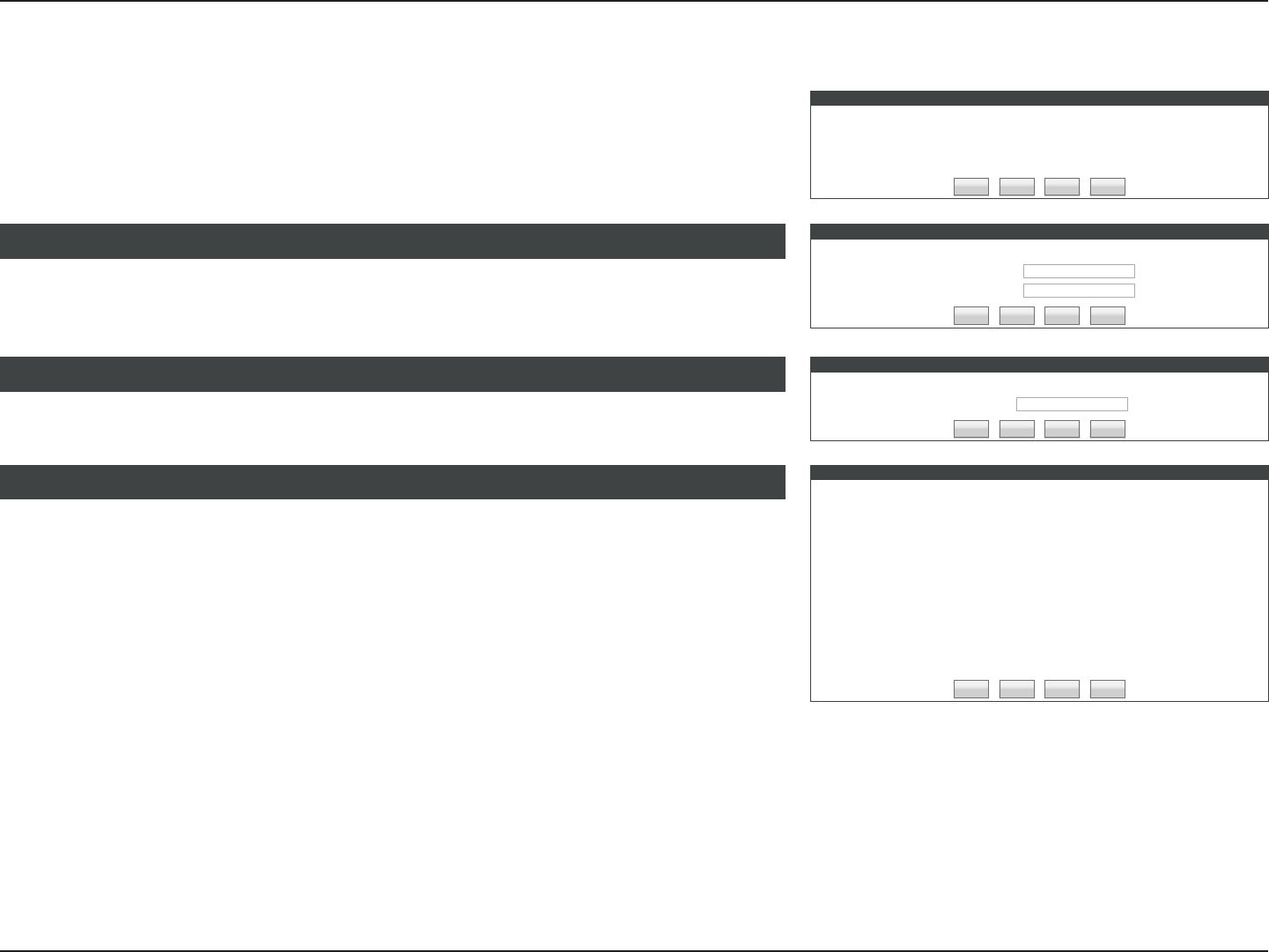
25D-Link DIR-819 User Manual
Section 3 - Conguration
Internet Connection Setup Wizard
WELCOME TO THE D-LINK INTERNET CONNECTION SETUP WIZARD
This wizard will guide you through a step-by-step process to congure your new D-Link router and connect to the
Internet.
• Step 1: Set your Password
• Step 2: Select your Time Zone
• Step 3: Congure your Internet Connection
• Step 4: Save Settings and Connect
Prev Next Cancel Connect
STEP 1: SET YOUR PASSWORD
By default, your new D-Link Router does not have a password congured for administrator access to the Web-based
conguration pages. To secure your new networking device, please set and verify a password below:
Password :
Verify Password :
Prev Next Cancel Connect
STEP 2: SELECT YOUR TIME ZONE
Select the appropriate time zone for your location. This information is required to congure the time-based options for
the router.
Time Zone : (GMT+08:00) Taipei ▼
Prev Next Cancel Connect
STEP 3: CONFIGURE YOUR INTERNET CONNECTION
Please select the Internet connection type below:
DHCP Connection (Dynamic IP Address)
Choose this if your Internet connection automatically provides you with an IP Address. Most Cable Modems use this type of
connection.
Username / Password Connection (PPPoE)
Choose this option if your Internet connection requires a username and password to get online. Most DSL modems use this type
of connection.
Username / Password Connection (PPTP)
Choose this option if your Internet connection requires a username and password to get online. Most DSL modems use this type
of connection.
Username / Password Connection (L2TP)
Choose this option if your Internet connection requires a username and password to get online. Most DSL modems use this type
of connection.
Static IP Address Connection
Choose this option if your Internet Setup Provider provided you with IP Address information that has to be manually congured.
Prev Next Cancel Connect
This Internet Connection Setup Wizard will guide you through a step-by-step process to
congure your new D-Link router and connect to the Internet.
Enter a new administration password. This is the password you will use to log in to the router.
Click Next to continue.
STEP 1: SET YOUR PASSWORD
Select your time zone. Click Next to continue.
STEP 2: SELECT YOUR TIME ZONE
Select the connection type your ISP uses and click Next to continue.
For DHCP setup help refer to page 26.
For PPPoE setup help refer to page 27.
For PPTP setup help refer to page 28.
For L2TP setup help refer to page 30.
For Static IP Address Connection setup help refer to page 32.
STEP 3: CONFIGURE YOUR INTERNET CONNECTION

26D-Link DIR-819 User Manual
Section 3 - Conguration
If you choose DHCP Connection (Dynamic IP Address) as your Internet Connection, enter your IP address, congure the following settings:
DHCP CONNECTION (DYNAMIC IP ADDRESS)
To set up this connection, please make sure that you are connected to the D-Link Router with the PC that was originally
connected to your broadband connection. If you are, then click the Clone MAC button to copy your computer’s MAC
Address to the D-Link Router.
MAC Address : (optional)
Clone Your PC’s MAC Address
Host Name : dlinkrouter
Note: You may also need to provide a Host Name.If you do not have or know this information, please contact your ISP.
DNS SETTINGS
Primary DNS Address :
Secondary DNS Address : (optional)
Prev Next Cancel Connect
MAC Address: If your Internet connection is tied to a specic PC or hardware, enter
it manually or click Clone Your PC’s MAC Address.
Host Name: Enter the host name of the router.
DHCP CONNECTION DYNAMIC IP ADDRESS
Primary DNS
Server:
Enter the primary DNS server IP addresses.
Secondary DNS
Server :
Enter the secondary DNS server IP addresses.
Click Next to continue.
DNS SETTINGS
Click Connect to nish the setup.
SETUP COMPLETE! SETUP COMPLETE!
The Internet Connection Setup Wizard has completed. Click the Connect button to save your settings.
Prev Next Cancel Connect
DHCP
Internet Connection Setup Wizard (continued)
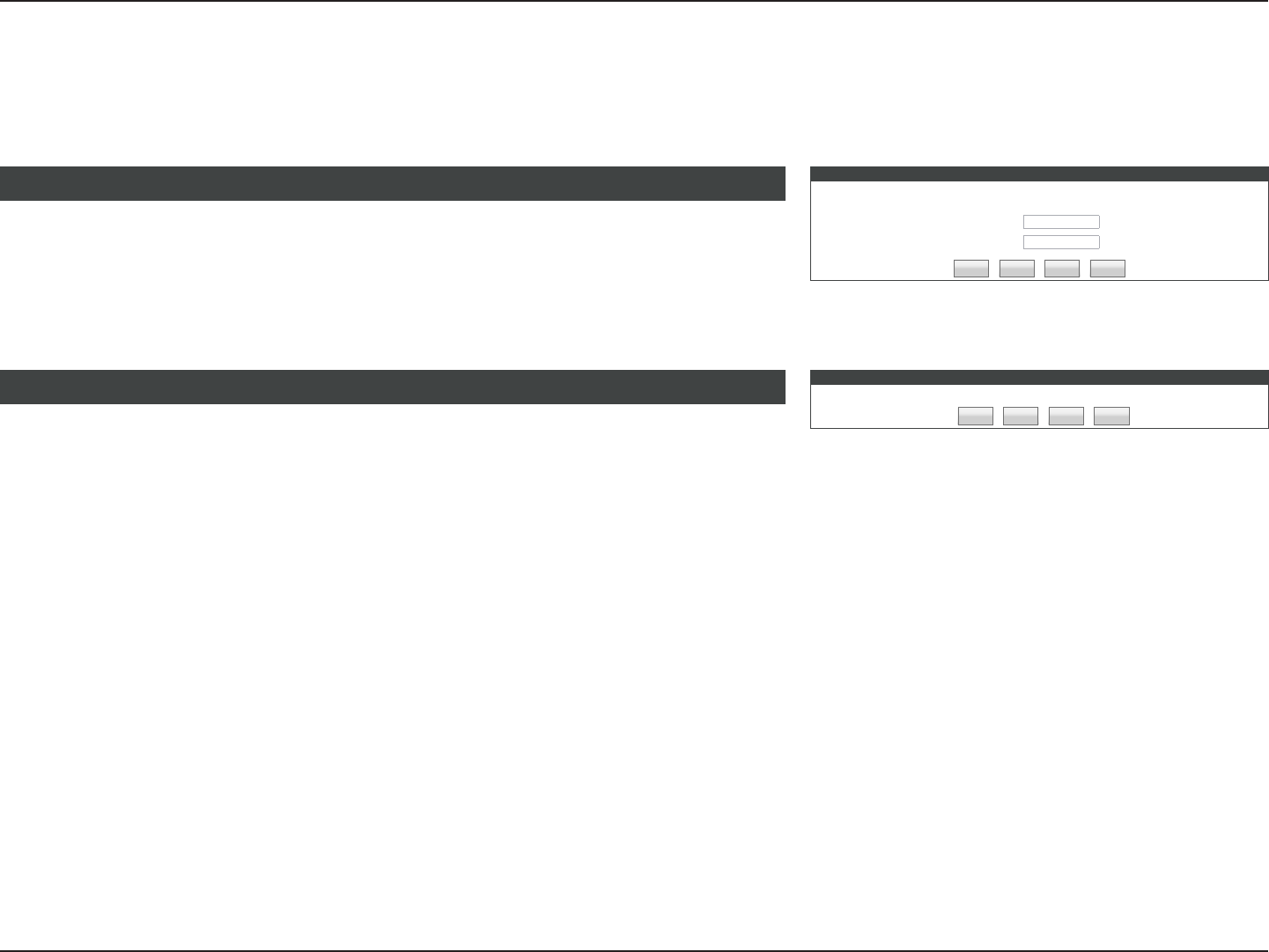
27D-Link DIR-819 User Manual
Section 3 - Conguration
If you choose Username / Password Connection (PPPoE) as your Internet Connection, enter your IP address, congure the following settings:
Click Connect to nish the setup.
SETUP COMPLETE! SETUP COMPLETE!
The Internet Connection Setup Wizard has completed. Click the Connect button to save your settings.
vPrev Next Cancel Connect
SET USERNAME AND PASSWORD CONNECTION (PPPOE)
To set up this connection you will need to have a Username and Password from your Internet Service Provider. If you do
not have this information, please contact your ISP.
User Name :
Password :
Prev Next Cancel Connect
Username: Enter the username provided by your ISP.
Password: Enter the password provided by your ISP.
Click Next to continue.
SET USERNAME AND PASSWORD CONNECTION PPPOE
PPPoE
Internet Connection Setup Wizard (continued)

28D-Link DIR-819 User Manual
Section 3 - Conguration
If you choose Username / Password Connection (PPTP) as your Internet Connection, enter your IP address, congure the following settings:
SET USERNAME AND PASSWORD CONNECTION (PPTP)
To set up this connection you will need to have a Username and Password from your Internet Service Provider. You also
need PPTP IP address. If you do not have this information, please contact your ISP.
Address Mode : Dynamic IP Static IP
PPTP IP Address :
PPTP Subnet Mask :
PPTP Gateway IP Address :
PPTP Server IP Address : (may be same as gateway)
User Name :
Password :
Verify Password :
DNS SETTINGS
Primary DNS Address :
Secondary DNS Address : (optional)
Prev Next Cancel Connect
Address Mode: Select either Dynamic IP or Static IP
If you choose Static IP as the Address Mode, enter your IP address:
PPTP IP Address: Enter the PPTP IP Address provided by your ISP.
PPTP Subnet
Mask:
Enter the PPTP Subnet mask provided by your ISP.
PPTP Gateway IP
Address:
Enter the PPTP Gateway IP Address provided by your ISP.
If you choose Dynamic IP or Static IP as the Address Mode, enter your PPTP Server IP
address:
PPTP Server IP
Address:
Enter the PPTP Server IP address provided by your ISP.
SET USERNAME AND PASSWORD CONNECTION PPTP
Username: Enter the username provided by your ISP.
Password: Enter the password provided by your ISP.
Verify Password: Enter the password provided by your ISP one more time.
Primary DNS
Server:
Enter the primary DNS server IP addresses.
DNS SETTINGS
PPTP
Internet Connection Setup Wizard (continued)

29D-Link DIR-819 User Manual
Section 3 - Conguration
Secondary DNS
Server :
Enter the secondary DNS server IP addresses.
Click Next to continue.
DNS SETTINGS
Primary DNS Address :
Secondary DNS Address : (optional)
Prev Next Cancel Connect
Click Connect to nish the setup.
SETUP COMPLETE! SETUP COMPLETE!
The Internet Connection Setup Wizard has completed. Click the Connect button to save your settings.
Prev Next Cancel Connect
PPTP (continued)
Internet Connection Setup Wizard (continued)

30D-Link DIR-819 User Manual
Section 3 - Conguration
If you choose Username / Password Connection (L2TP) as your Internet Connection, enter your IP address, congure the following settings:
L2TP
SET USERNAME AND PASSWORD CONNECTION (L2TP)
To set up this connection you will need to have a Username and Password from your Internet Service Provider. You also
need L2TP IP address. If you do not have this information, please contact your ISP.
Address Mode : Dynamic IP Static IP
L2TP IP Address :
L2TP Subnet Mask :
L2TP Gateway IP Address :
L2TP Server IP Address : (may be same as gateway)
User Name :
Password :
Verify Password :
DNS SETTINGS
Primary DNS Address :
Secondary DNS Address : (optional)
Prev Next Cancel Connect
Address Mode: Select either Dynamic IP or Static IP
If you choose Static IP as the Address Mode, enter your IP address:
L2TP IP Address: Enter the PPTP IP Address provided by your ISP.
L2TP Subnet
Mask:
Enter the PPTP Subnet mask provided by your ISP.
L2TP Gateway IP
ddress:
Enter the PPTP Gateway IP Address provided by your ISP.
If you choose Dynamic IP or Static IP as the Address Mode, enter your PPTP Server IP
address:
L2TP Server IP
Address:
Enter the PPTP Server IP address provided by your ISP.
SET USERNAME AND PASSWORD CONNECTION L2TP
Username: Enter the username provided by your ISP.
Password: Enter the password provided by your ISP.
Verify Password: Enter the password provided by your ISP one more time.
Primary DNS
Server:
Enter the primary DNS server IP addresses.
DNS SETTINGS
Internet Connection Setup Wizard (continued)

31D-Link DIR-819 User Manual
Section 3 - Conguration
L2TP (continued)
Secondary DNS
Server :
Enter the secondary DNS server IP addresses.
Click Next to continue.
DNS SETTINGS
Primary DNS Address :
Secondary DNS Address : (optional)
Prev Next Cancel Connect
Click Connect to nish the setup.
SETUP COMPLETE! SETUP COMPLETE!
The Internet Connection Setup Wizard has completed. Click the Connect button to save your settings.
Prev Next Cancel Connect
Internet Connection Setup Wizard (continued)
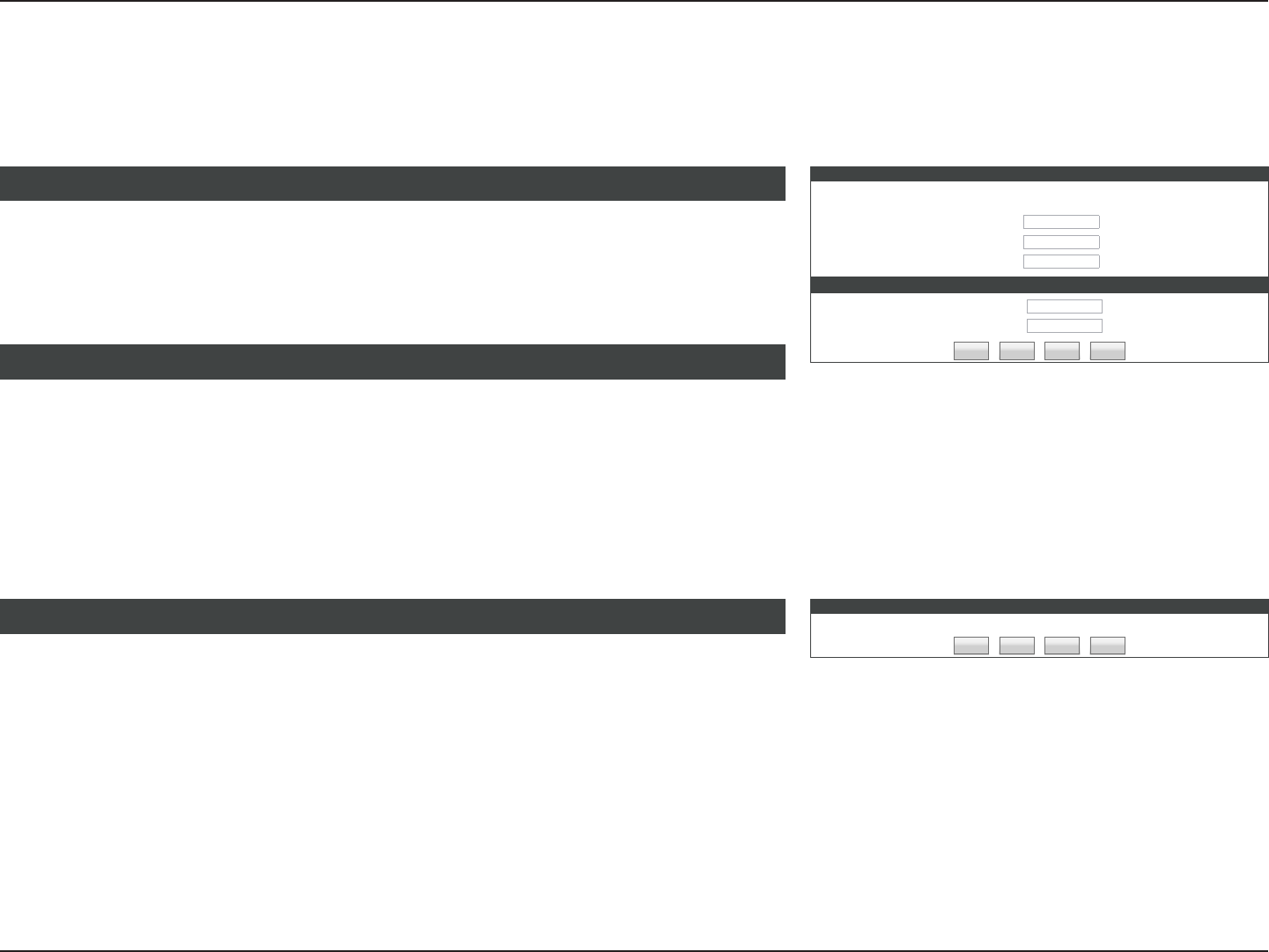
32D-Link DIR-819 User Manual
Section 3 - Conguration
Static IP Address Connection
If you choose Static IP Address Connection as your Internet Connection, enter your IP address, congure the following settings:
SET STATIC IP ADDRESS CONNECTION
To set up this connection you will need to have a complete list of IP information provided by your Internet Service
Provider. If you have a Static IP connection and do not have this information, please contact your ISP.
IP Address :
Subnet Mask :
Default Gateway :
DNS SETTINGS
Primary DNS Address :
Secondary DNS Address : (optional)
Prev Next Cancel Connect
IP Address: Enter the IP address provided by your ISP.
Subnet Mask: Enter the subnet mask.
Default Gateway: Enter the default gateway.
SET STATIC IP ADDRESS CONNECTION
Primary DNS
Server:
Enter the primary DNS server IP addresses.
Secondary DNS
Server :
Enter the secondary DNS server IP addresses.
Click Next to continue.
DNS SETTINGS
Click Connect to nish the setup.
SETUP COMPLETE! SETUP COMPLETE!
The Internet Connection Setup Wizard has completed. Click the Connect button to save your settings.
Prev Next Cancel Connect
Internet Connection Setup Wizard (continued)
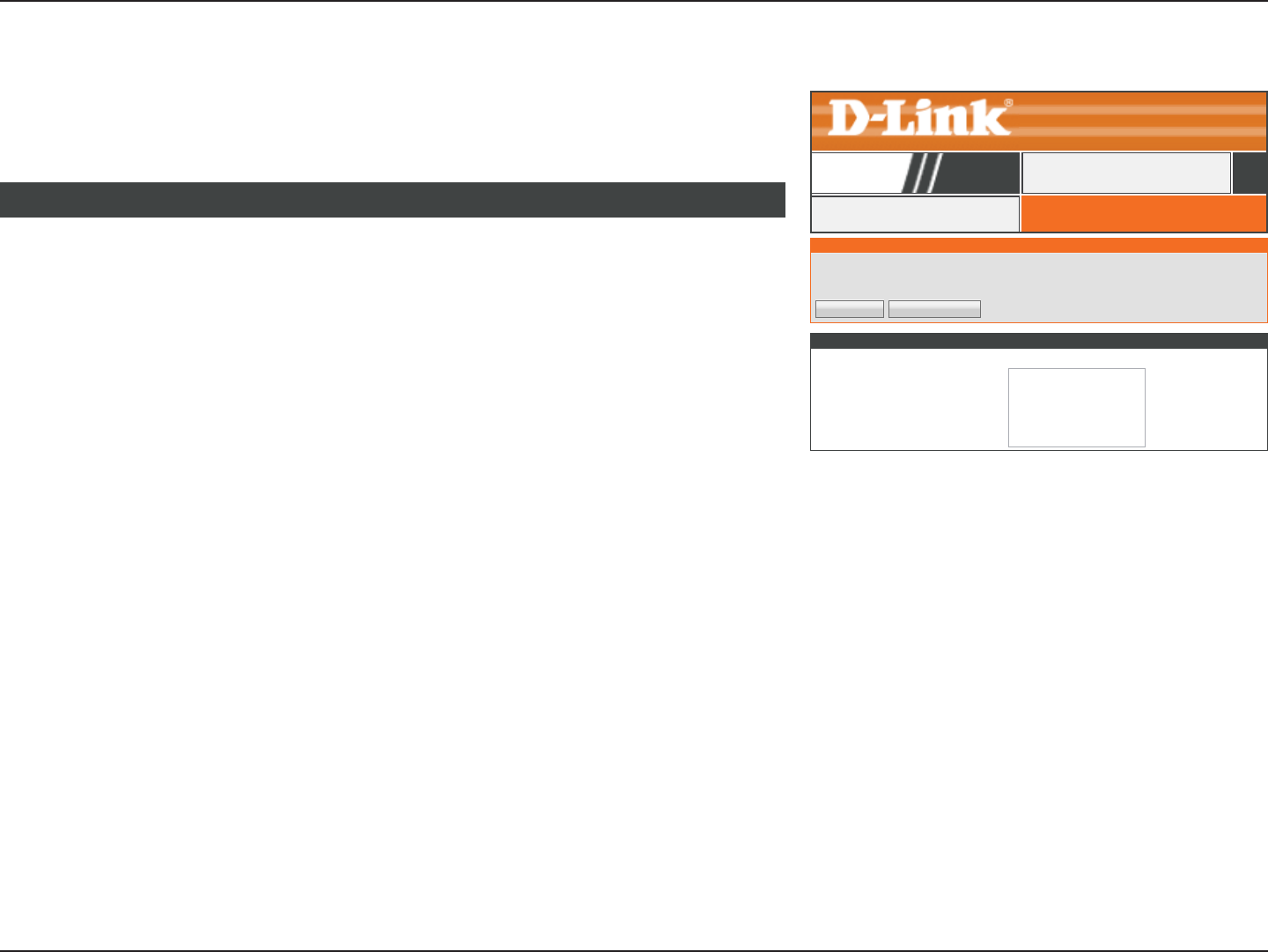
33D-Link DIR-819 User Manual
Section 3 - Conguration
Manual Internet Connection Setup
WANINTERNET
DIR-819 SETUP
WAN
Use this section to congure your Internet Connection type. There are several connection types to choose from: Static IP, DHCP, PPPoE,
PPTP, L2TP, and DS-Lite. If you are unsure of your connection method, please contact your Internet Service Provider.
Note : If using the PPPoE option, you will need to remove or disable any PPPoE client software on your computers.
Save Settings Don’t Save Settings
INTERNET CONNECTION TYPE
Choose the mode to be used by the router to connect to the Internet.
My Internet Connection is : Static IP ▼
Dynamic IP (DHCP)
PPPoE (Username / Password)
PPTP (Username / Password)
L2TP (Username / Password)
DS-Lite
Click Manual Internet Setup on from the Internet menu to congure your Internet
connection manually. This section is only recommended for advanced users. It is
recommended to use the Setup Wizard to set up your Internet connection.
My Internet
Connection is:
Select the Internet Connection protocol from the dropdown menu
your ISP uses. The options are Static IP, DHCP, PPPoE, PPTP, L2TP,
and DS-Lite.
INTERNET CONNECTION TYPE
For Static IP setup help refer to page 34. Select the connection type your ISP uses.
For Dynamic IP (DHCP) setup help refer to page 35.
For PPPoE (Username / Password) setup help refer to page 36.
For PPTP (Username / Password) setup help refer to page 38.
For L2TP (Username / Password) setup help refer to page 40.
For DS-Lite setup help refer to page 42.
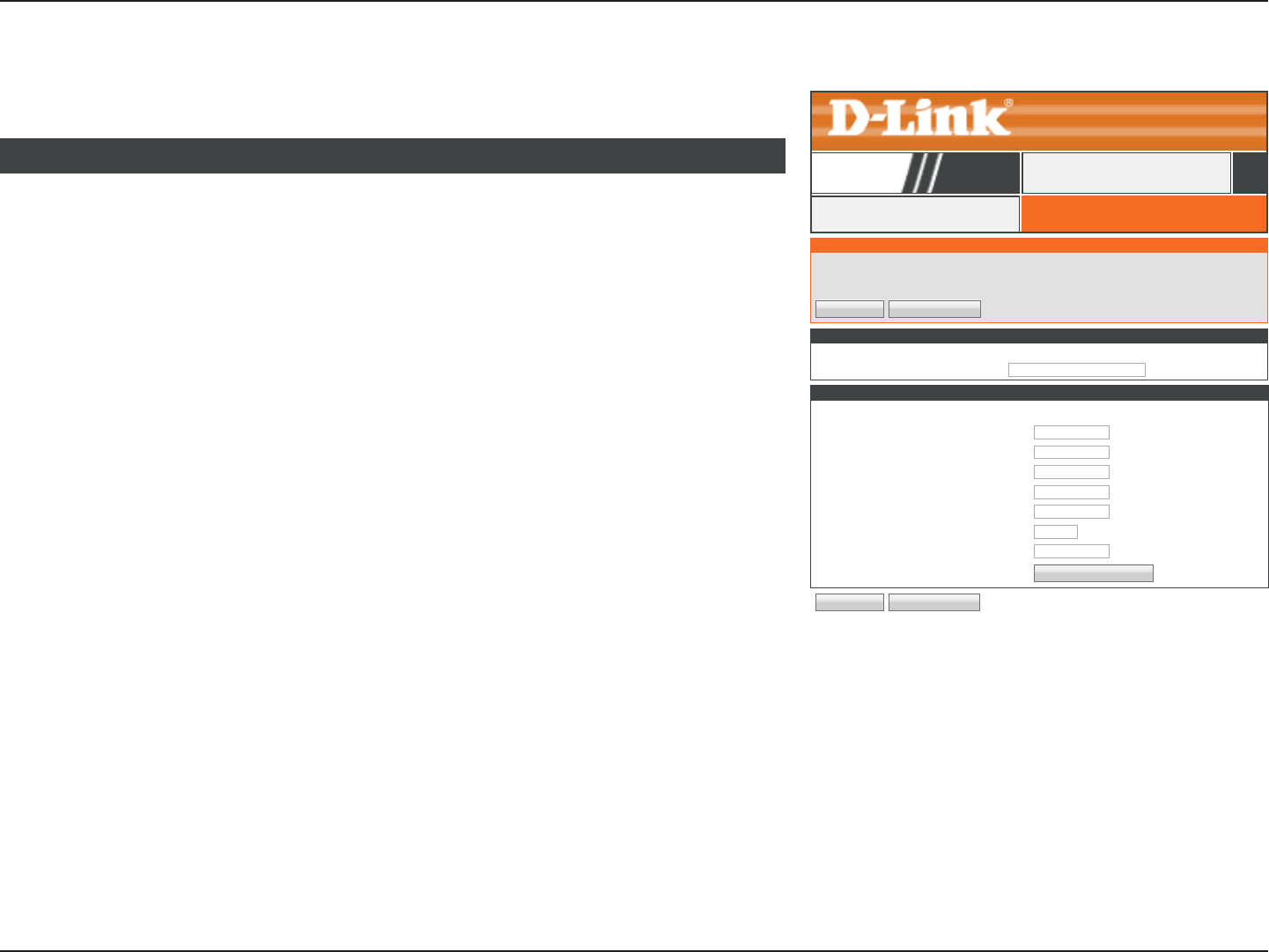
34D-Link DIR-819 User Manual
Section 3 - Conguration
INTERNET CONNECTION TYPE
Choose the mode to be used by the router to connect to the Internet.
My Internet Connection is : Static IP ▼
Save Settings Don’t Save Settings
STATIC IP ADDRESS INTERNET CONNECTION TYPE :
Enter the static address information provided by your Internet Service Provider (ISP).
IP Address :
Subnet Mask :
Default Gateway :
Primary DNS Server :
Secondary DNS Server : (optional)
MTU : 1500
MAC Address :
Clone Your PC’s MAC Address
WANINTERNET
DIR-819 SETUP
WAN
Use this section to congure your Internet Connection type. There are several connection types to choose from: Static IP, DHCP, PPPoE,
PPTP, L2TP, and DS-Lite. If you are unsure of your connection method, please contact your Internet Service Provider.
Note : If using the PPPoE option, you will need to remove or disable any PPPoE client software on your computers.
Save Settings Don’t Save Settings
Static IP
IP Address: Enter the IP address provided by your ISP.
Subnet Mask: Enter the subnet mask.
Default Gateway: Enter the default gateway.
Primary DNS
Server:
Enter the primary DNS server IP addresses.
Secondary DNS
Server :
Enter the secondary DNS server IP addresses.
MTU Size: Enter the MTU size.
MAC Address: If your Internet connection is tied to a specic PC or hardware, enter
it manually or click Clone Your PC’s MAC Address.
When you have nished conguring your Internet connection, click the Save Settings
button.
STATIC IP ADDRESS INTERNET CONNECTION TYPE :
If you choose Static IP, please congure the following elds:
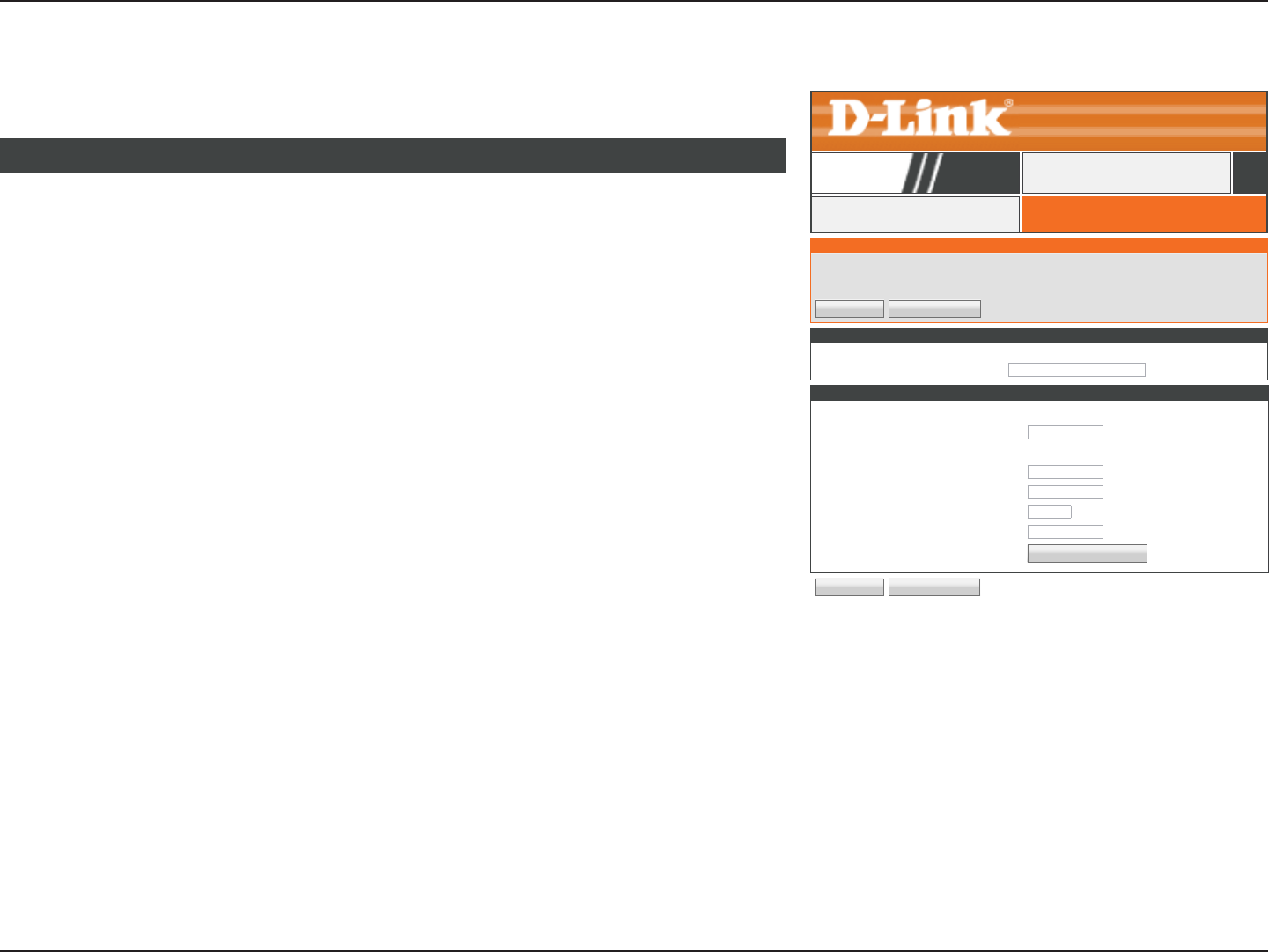
35D-Link DIR-819 User Manual
Section 3 - Conguration
INTERNET CONNECTION TYPE
Choose the mode to be used by the router to connect to the Internet.
My Internet Connection is : Dynamic IP (DHCP) ▼
Save Settings Don’t Save Settings
DYNAMIC IP (DHCP) INTERNET CONNECTION TYPE :
Use this Internet connection type if your Internet Service Provider (ISP) didn’t provide you with IP Address information
and/or a username and password.
Host Name : dlinkrouter
Use Unicasting : ☐ (compatibility for some DHCP Clients)
Primary DNS Server :
Secondary DNS Server : (optional)
MTU : 1500
MAC Address :
Clone Your PC’s MAC Address
WANINTERNET
DIR-819 SETUP
WAN
Use this section to congure your Internet Connection type. There are several connection types to choose from: Static IP, DHCP, PPPoE,
PPTP, L2TP, and DS-Lite. If you are unsure of your connection method, please contact your Internet Service Provider.
Note : If using the PPPoE option, you will need to remove or disable any PPPoE client software on your computers.
Save Settings Don’t Save Settings
Dynamic IP (DHCP)
Host Name: Enter the host name of the router.
Use Unicasting: Check this box if you are having diculty obtaining a DHCP address
from your ISP.
Primary DNS
Server:
Enter the primary DNS server IP addresses.
Secondary DNS
Server :
Enter the secondary DNS server IP addresses.
MTU Size: Enter the MTU size.
MAC Address: If your Internet connection is tied to a specic PC or hardware, enter
it manually or click Clone Your PC’s MAC Address.
When you have nished conguring your Internet connection, click the Save Settings
button.
STATIC IP ADDRESS INTERNET CONNECTION TYPE :
If you choose Dynamic IP (DHCP), please congure the following elds:
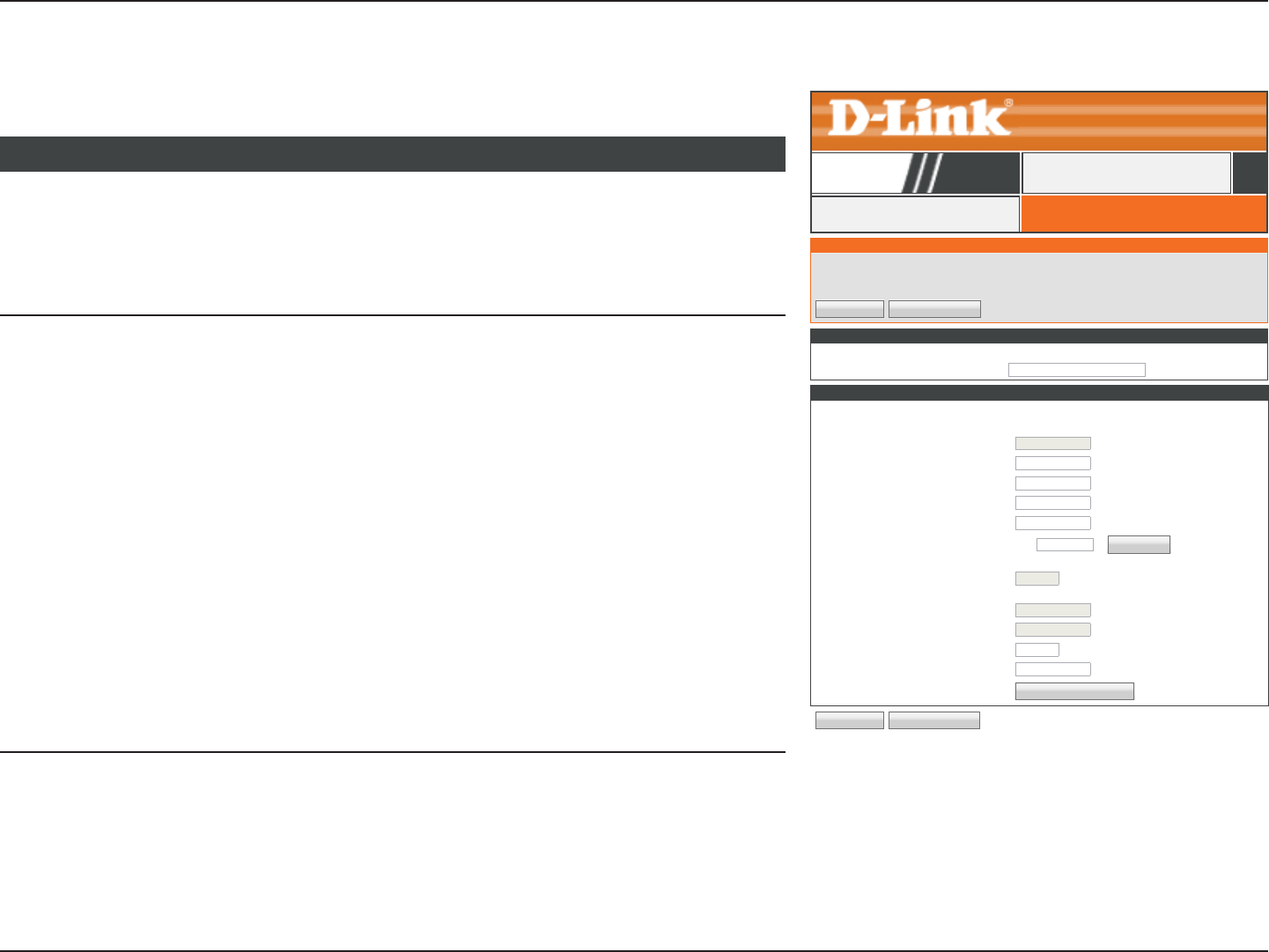
36D-Link DIR-819 User Manual
Section 3 - Conguration
PPPOE INTERNET CONNECTION TYPE :
Enter the information provided by your Internet Service Provider (ISP).
Address Mode : Dynamic IP Static IP
IP Address :
User Name :
Password :
Verify Password :
Service Name : (optional)
Reconnect Mode : AlwaysOn ▼New Schedule
On Demand Manual
Maximum Idle Time : (minutes)
DNS Mode : Receive DNS from ISP Enter DNS Manually
Primary DNS Server :
Secondary DNS Server : (optional)
MTU : 1492
MAC Address :
Clone Your PC’s MAC Address
INTERNET CONNECTION TYPE
Choose the mode to be used by the router to connect to the Internet.
My Internet Connection is : PPPoE (Username / Password) ▼
Save Settings Don’t Save Settings
WANINTERNET
DIR-819 SETUP
WAN
Use this section to congure your Internet Connection type. There are several connection types to choose from: Static IP, DHCP, PPPoE,
PPTP, L2TP, and DS-Lite. If you are unsure of your connection method, please contact your Internet Service Provider.
Note : If using the PPPoE option, you will need to remove or disable any PPPoE client software on your computers.
Save Settings Don’t Save Settings
PPPoE (Username / Password)
Address Mode: Select either Dynamic IP or Static IP
If you choose Static IP as the Address Mode, enter your IP address:
IP Address: Enter the IP address provided by your ISP.
PPPOE INTERNET CONNECTION TYPE :
If you choose PPPoE, please congure the following elds:
Username: Enter the username provided by your ISP.
Password: Enter the password provided by your ISP.
Verify Password: Enter the password provided by your ISP one more time.
Service Name: Enter the ISP service name (optional).
Reconnect Mode: Select either AlwaysOn, On Demand, or Manual. You may create
a schedule by clicking New Schedule. Refer to Schedules on page
110 for more information.
If you choose Manual as the Reconnect Mode, enter the Maximum Idle Time:
Maximum Idle
Time:
Set the length of time to wait before disconnecting if there is no
Internet activity. (Manual Only)
DNS Mode: Select either Receive DNS from ISP or Enter DNS Manually.
If you choose Enter DNS Manually as the DNS Mode, enter your DNS information:
Primary DNS
Server:
Enter the primary DNS server IP addresses.
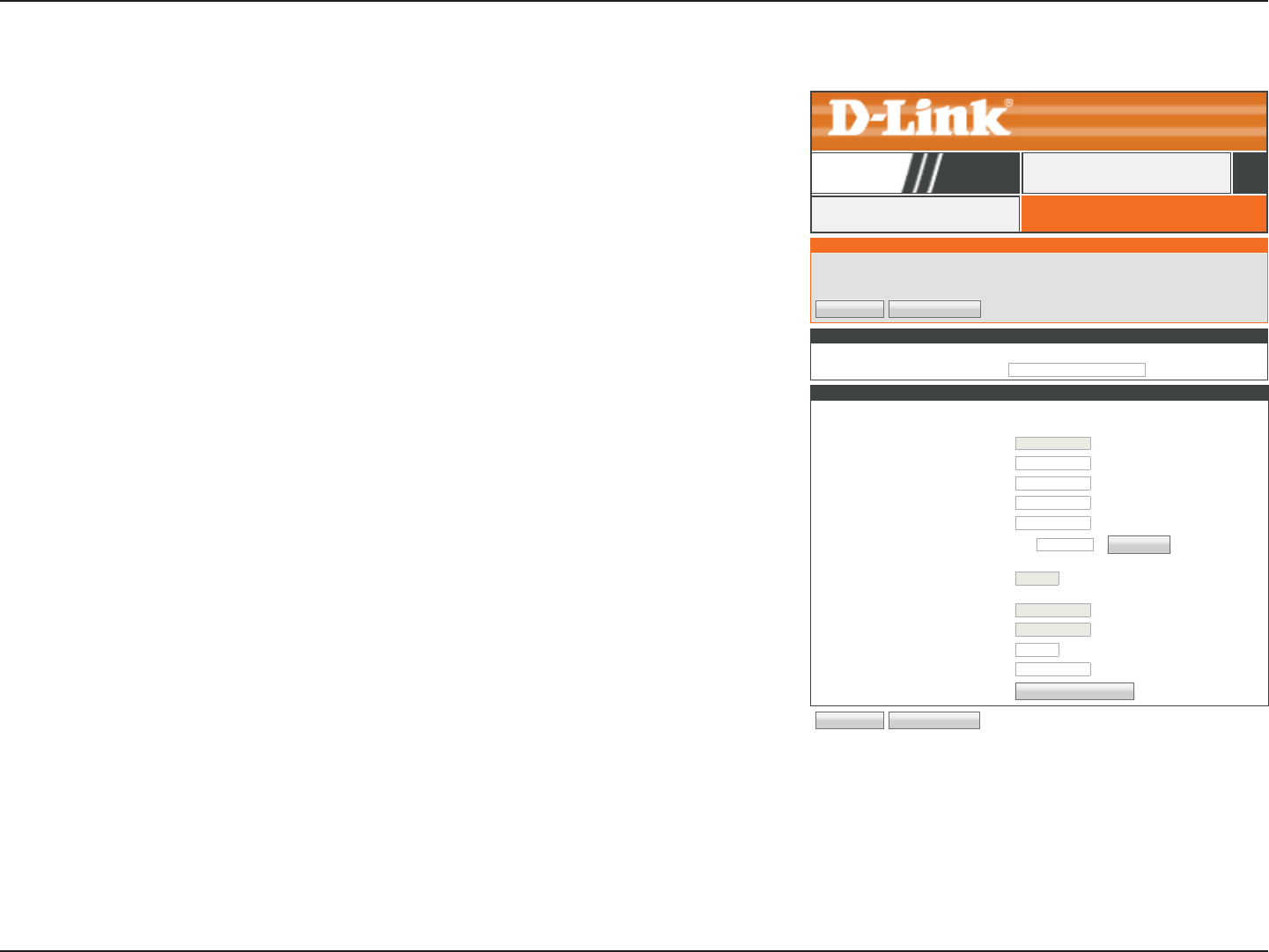
37D-Link DIR-819 User Manual
Section 3 - Conguration
PPPOE INTERNET CONNECTION TYPE :
Enter the information provided by your Internet Service Provider (ISP).
Address Mode : Dynamic IP Static IP
IP Address :
User Name :
Password :
Verify Password :
Service Name : (optional)
Reconnect Mode : AlwaysOn ▼New Schedule
On Demand Manual
Maximum Idle Time : (minutes)
DNS Mode : Receive DNS from ISP Enter DNS Manually
Primary DNS Server :
Secondary DNS Server : (optional)
MTU : 1492
MAC Address :
Clone Your PC’s MAC Address
INTERNET CONNECTION TYPE
Choose the mode to be used by the router to connect to the Internet.
My Internet Connection is : PPPoE (Username / Password) ▼
Save Settings Don’t Save Settings
WANINTERNET
DIR-819 SETUP
WAN
Use this section to congure your Internet Connection type. There are several connection types to choose from: Static IP, DHCP, PPPoE,
PPTP, L2TP, and DS-Lite. If you are unsure of your connection method, please contact your Internet Service Provider.
Note : If using the PPPoE option, you will need to remove or disable any PPPoE client software on your computers.
Save Settings Don’t Save Settings
PPPoE (Username / Password) (Continued)
Secondary DNS
Server :
Enter the secondary DNS server IP addresses.
MTU Size: Enter the MTU size.
MAC Address: If your Internet connection is tied to a specic PC or hardware, enter
it manually or click Clone Your PC’s MAC Address.
When you have nished conguring your Internet connection, click the Save Settings
button.
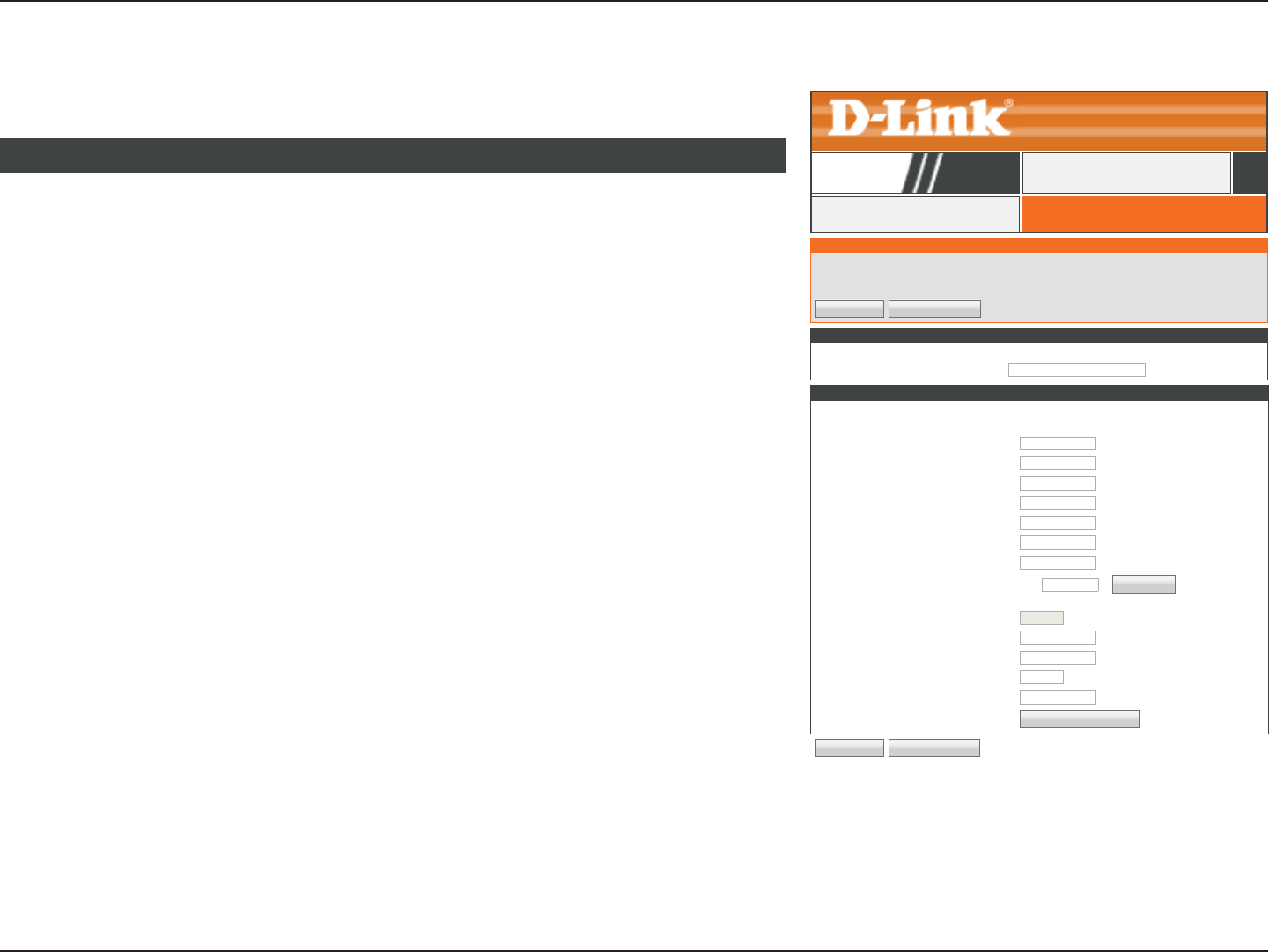
38D-Link DIR-819 User Manual
Section 3 - Conguration
INTERNET CONNECTION TYPE
Choose the mode to be used by the router to connect to the Internet.
My Internet Connection is : PPTP (Username / Password) ▼
Save Settings Don’t Save Settings
PPTP INTERNET CONNECTION TYPE :
Enter the information provided by your Internet Service Provider (ISP).
Address Mode : Dynamic IP Static IP
PPTP IP Address :
PPTP Subnet Mask :
PPTP Gateway IP Address :
PPTP Server IP Address :
Username :
Password :
Verify Password :
Reconnect Mode : AlwaysOn ▼New Schedule
On Demand Manual
Maximum Idle Time : (minutes)
Primary DNS Server :
Secondary DNS Server : (optional)
MTU : 1492
MAC Address :
Clone Your PC’s MAC Address
WANINTERNET
DIR-819 SETUP
WAN
Use this section to congure your Internet Connection type. There are several connection types to choose from: Static IP, DHCP, PPPoE,
PPTP, L2TP, and DS-Lite. If you are unsure of your connection method, please contact your Internet Service Provider.
Note : If using the PPPoE option, you will need to remove or disable any PPPoE client software on your computers.
Save Settings Don’t Save Settings
PPTP (Username / Password)
Address Mode: Select either Dynamic IP or Static IP
If you choose Static IP as the Address Mode, enter your IP address:
PPTP IP Address: Enter the PPTP IP Address provided by your ISP.
PPTP Subnet
Mask:
Enter the PPTP Subnet mask provided by your ISP.
PPTP Gateway IP
Address:
Enter the PPTP Gateway IP Address provided by your ISP.
If you choose Dynamic IP or Static IP as the Address Mode, enter your PPTP Server IP
address:
PPTP Server IP
Address:
Enter the PPTP Server IP address provided by your ISP.
Username: Enter the username provided by your ISP.
Password: Enter the password provided by your ISP.
Verify Password: Enter the password provided by your ISP one more time.
Reconnect Mode: Select either AlwaysOn, On Demand, or Manual. You may create
a schedule by clicking New Schedule. Refer to Schedules on page
110 for more information.
If you choose Manual as the Reconnect Mode, enter the Maximum Idle Time:
PPTP INTERNET CONNECTION TYPE :
If you choose PPTP, please congure the following elds:
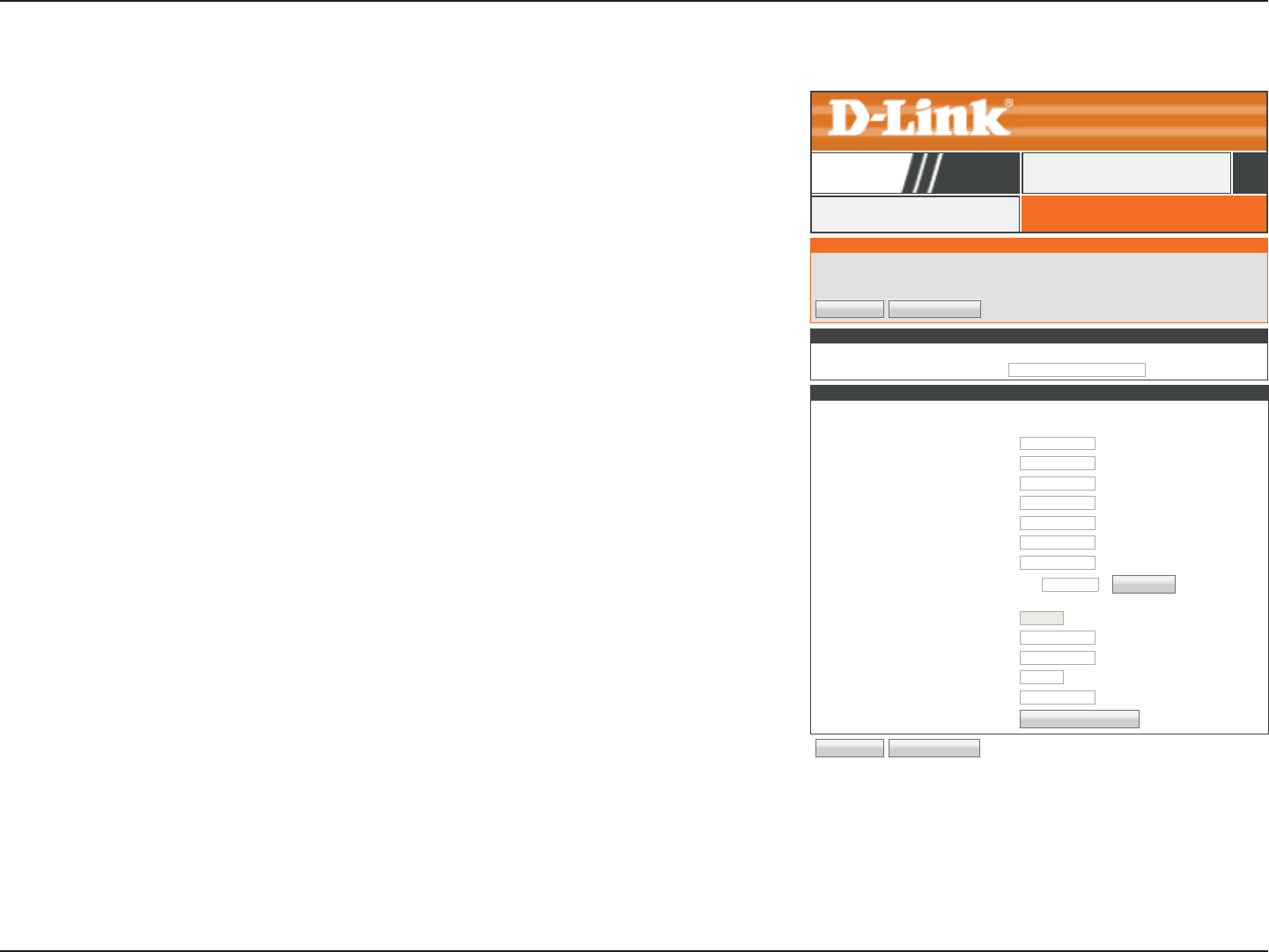
39D-Link DIR-819 User Manual
Section 3 - Conguration
INTERNET CONNECTION TYPE
Choose the mode to be used by the router to connect to the Internet.
My Internet Connection is : PPTP (Username / Password) ▼
Save Settings Don’t Save Settings
PPTP INTERNET CONNECTION TYPE :
Enter the information provided by your Internet Service Provider (ISP).
Address Mode : Dynamic IP Static IP
PPTP IP Address :
PPTP Subnet Mask :
PPTP Gateway IP Address :
PPTP Server IP Address :
Username :
Password :
Verify Password :
Reconnect Mode : AlwaysOn ▼New Schedule
On Demand Manual
Maximum Idle Time : (minutes)
Primary DNS Server :
Secondary DNS Server : (optional)
MTU : 1492
MAC Address :
Clone Your PC’s MAC Address
WANINTERNET
DIR-819 SETUP
WAN
Use this section to congure your Internet Connection type. There are several connection types to choose from: Static IP, DHCP, PPPoE,
PPTP, L2TP, and DS-Lite. If you are unsure of your connection method, please contact your Internet Service Provider.
Note : If using the PPPoE option, you will need to remove or disable any PPPoE client software on your computers.
Save Settings Don’t Save Settings
PPTP (Username / Password) (Continued)
Maximum Idle
Time:
Set the length of time to wait before disconnecting if there is no
Internet activity. (Manual Only)
Primary DNS
Server:
Enter the primary DNS server IP addresses.
Secondary DNS
Server :
Enter the secondary DNS server IP addresses.
MTU Size: Enter the MTU size.
MAC Address: If your Internet connection is tied to a specic PC or hardware, enter
it manually or click Clone Your PC’s MAC Address.
When you have nished conguring your Internet connection, click the Save Settings
button.
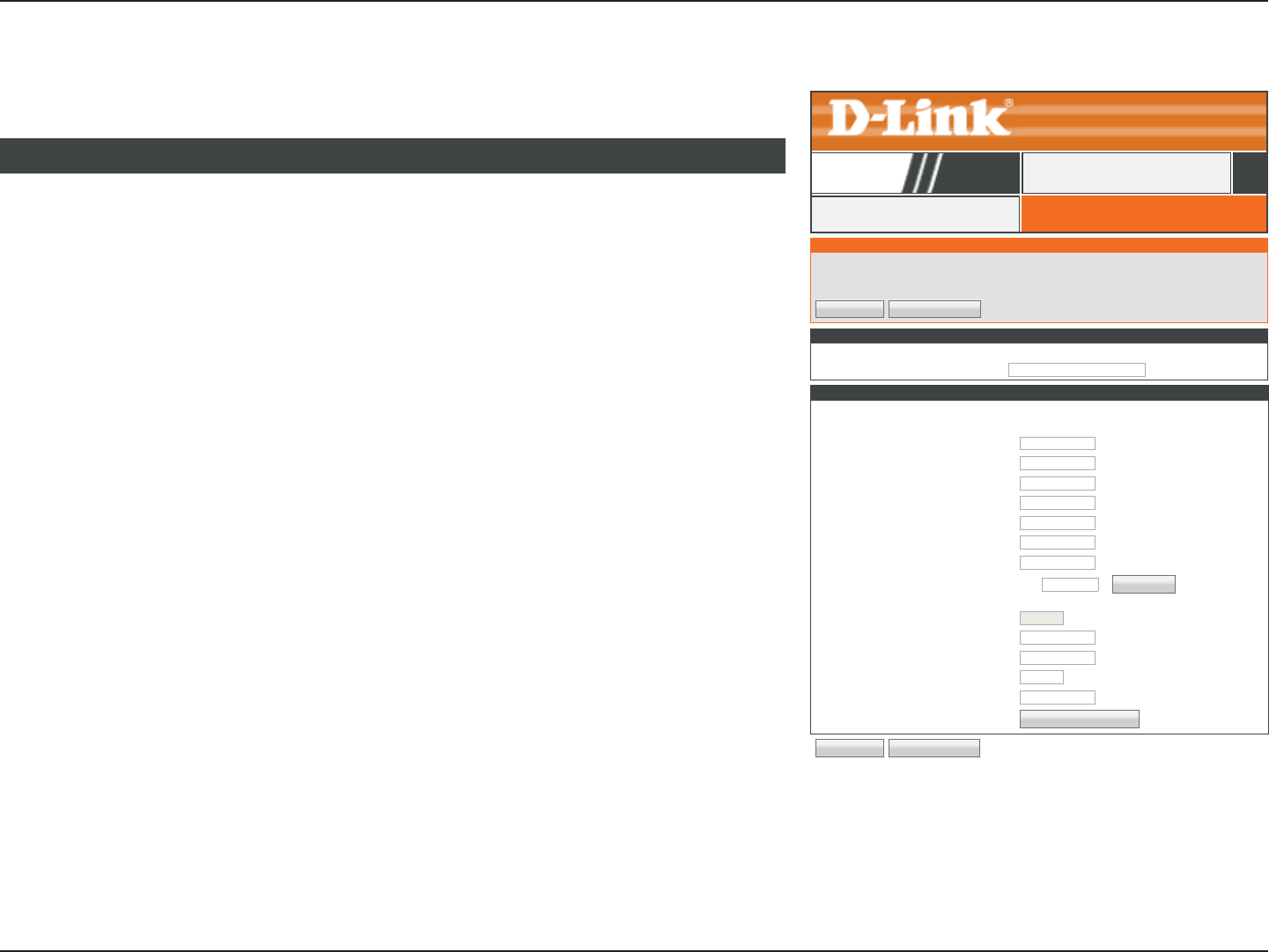
40D-Link DIR-819 User Manual
Section 3 - Conguration
INTERNET CONNECTION TYPE
Choose the mode to be used by the router to connect to the Internet.
My Internet Connection is : L2TP (Username / Password) ▼
Save Settings Don’t Save Settings
L2TP INTERNET CONNECTION TYPE :
Enter the information provided by your Internet Service Provider (ISP).
Address Mode : Dynamic IP Static IP
L2TP IP Address :
L2TP Subnet Mask :
L2TP Gateway IP Address :
L2TP Server IP Address :
Username :
Password :
Verify Password :
Reconnect Mode : AlwaysOn ▼New Schedule
On Demand Manual
Maximum Idle Time : (minutes)
Primary DNS Server :
Secondary DNS Server : (optional)
MTU : 1492
MAC Address :
Clone Your PC’s MAC Address
WANINTERNET
DIR-819 SETUP
WAN
Use this section to congure your Internet Connection type. There are several connection types to choose from: Static IP, DHCP, PPPoE,
PPTP, L2TP, and DS-Lite. If you are unsure of your connection method, please contact your Internet Service Provider.
Note : If using the PPPoE option, you will need to remove or disable any PPPoE client software on your computers.
Save Settings Don’t Save Settings
L2TP (Username / Password)
Address Mode: Select either Dynamic IP or Static IP
If you choose Static IP as the Address Mode, enter your IP address:
L2TP IP Address: Enter the PPTP IP Address provided by your ISP.
L2TP Subnet
Mask:
Enter the PPTP Subnet mask provided by your ISP.
L2TP Gateway IP
ddress:
Enter the PPTP Gateway IP Address provided by your ISP.
If you choose Dynamic IP or Static IP as the Address Mode, enter your PPTP Server IP
address:
L2TP Server IP
Address:
Enter the PPTP Server IP address provided by your ISP.
Username: Enter the username provided by your ISP.
Password: Enter the password provided by your ISP.
Verify Password: Enter the password provided by your ISP one more time.
Reconnect Mode: Select either AlwaysOn, On Demand, or Manual. You may create
a schedule by clicking New Schedule. Refer to Schedules on page
110 for more information.
If you choose Manual as the Reconnect Mode, enter the Maximum Idle Time:
L2TP INTERNET CONNECTION TYPE :
If you choose L2TP, please congure the following elds:
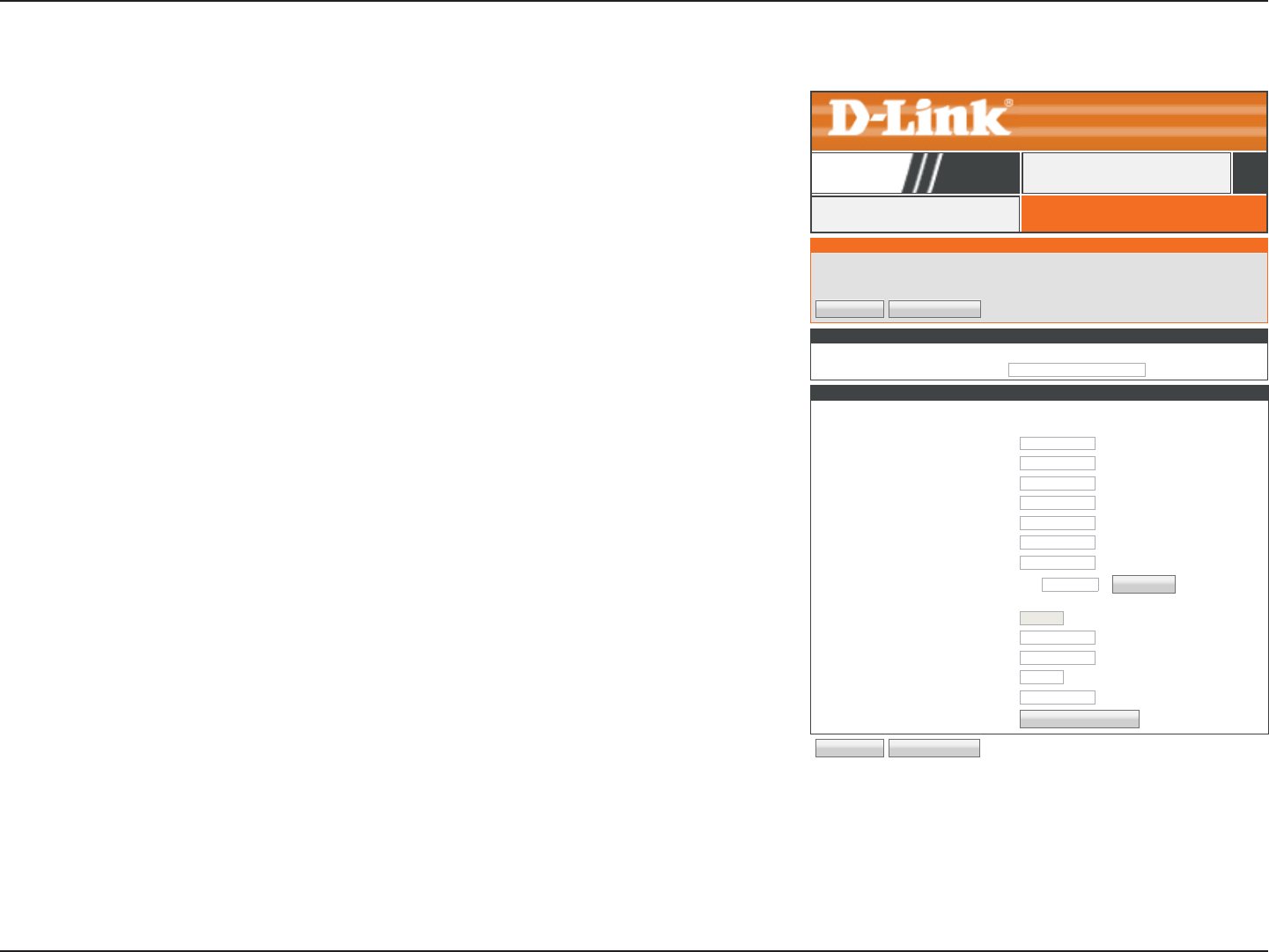
41D-Link DIR-819 User Manual
Section 3 - Conguration
Maximum Idle
Time:
Set the length of time to wait before disconnecting if there is no
Internet activity. (Manual Only)
Primary DNS
Server:
Enter the primary DNS server IP addresses.
Secondary DNS
Server :
Enter the secondary DNS server IP addresses.
MTU Size: Enter the MTU size.
MAC Address: If your Internet connection is tied to a specic PC or hardware, enter
it manually or click Clone Your PC’s MAC Address.
When you have nished conguring your Internet connection, click
the Save Settings button.
INTERNET CONNECTION TYPE
Choose the mode to be used by the router to connect to the Internet.
My Internet Connection is : L2TP (Username / Password) ▼
Save Settings Don’t Save Settings
L2TP INTERNET CONNECTION TYPE :
Enter the information provided by your Internet Service Provider (ISP).
Address Mode : Dynamic IP Static IP
L2TP IP Address :
L2TP Subnet Mask :
L2TP Gateway IP Address :
L2TP Server IP Address :
Username :
Password :
Verify Password :
Reconnect Mode : AlwaysOn ▼New Schedule
On Demand Manual
Maximum Idle Time : (minutes)
Primary DNS Server :
Secondary DNS Server : (optional)
MTU : 1492
MAC Address :
Clone Your PC’s MAC Address
WANINTERNET
DIR-819 SETUP
WAN
Use this section to congure your Internet Connection type. There are several connection types to choose from: Static IP, DHCP, PPPoE,
PPTP, L2TP, and DS-Lite. If you are unsure of your connection method, please contact your Internet Service Provider.
Note : If using the PPPoE option, you will need to remove or disable any PPPoE client software on your computers.
Save Settings Don’t Save Settings
L2TP (Username / Password) (continued)
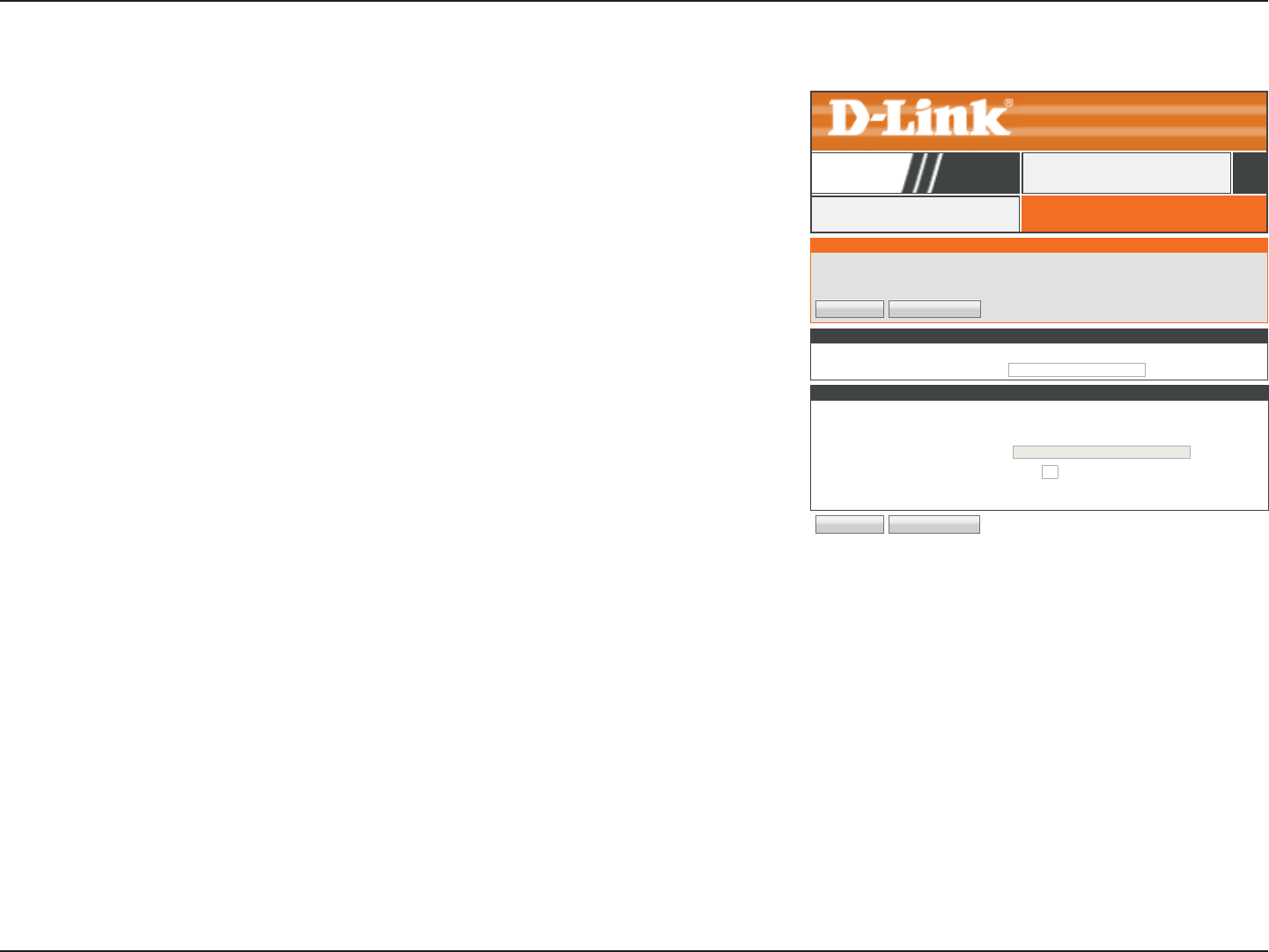
42D-Link DIR-819 User Manual
Section 3 - Conguration
AFTR ADDRESS INTERNET CONNECTION TYPE :
Enter the AFTR address information provided by your Internet Service Provider (ISP).
DS-Lite Conguration : DS-Lite DHCPv6 Option Manual Conguration
AFTR IPv6 Address :
B4 IPv4 Address : 192.0.0. (optional)
WAN IPv6 Address :
IPv6 WAN Default Gateway :
INTERNET CONNECTION TYPE
Choose the mode to be used by the router to connect to the Internet.
My Internet Connection is : DS-Lite ▼
Save Settings Don’t Save Settings
WANINTERNET
DIR-819 SETUP
WAN
Use this section to congure your Internet Connection type. There are several connection types to choose from: Static IP, DHCP, PPPoE,
PPTP, L2TP, and DS-Lite. If you are unsure of your connection method, please contact your Internet Service Provider.
Note : If using the PPPoE option, you will need to remove or disable any PPPoE client software on your computers.
Save Settings Don’t Save Settings
DS-Lite
If you choose DS-Lite, please congure the following elds:
DS-Lite Mode: Select either DS-Lite DHCPv6 Option or Manual Conguration.
If you choose Manual Conguration, congure the AFTR IPv6 Address eld:
AFTR Name or
Address:
Enter the AFTR Name or Address.
If you choose DS-Lite DHCPv6 Option or Manual Conguration, congure the B4 IPv6
Address eld:
B4 IPv6 Address: Enter the B4 IPv6 Address. (optional)
WAN IPv6
Address:
Your WAN IPv6 address is listed here.
IPv6 WAN Default
Gateway:
Your WAN IPv6 default gateway address is listed here.
When you have nished conguring your Internet connection, click
the Save Settings button.
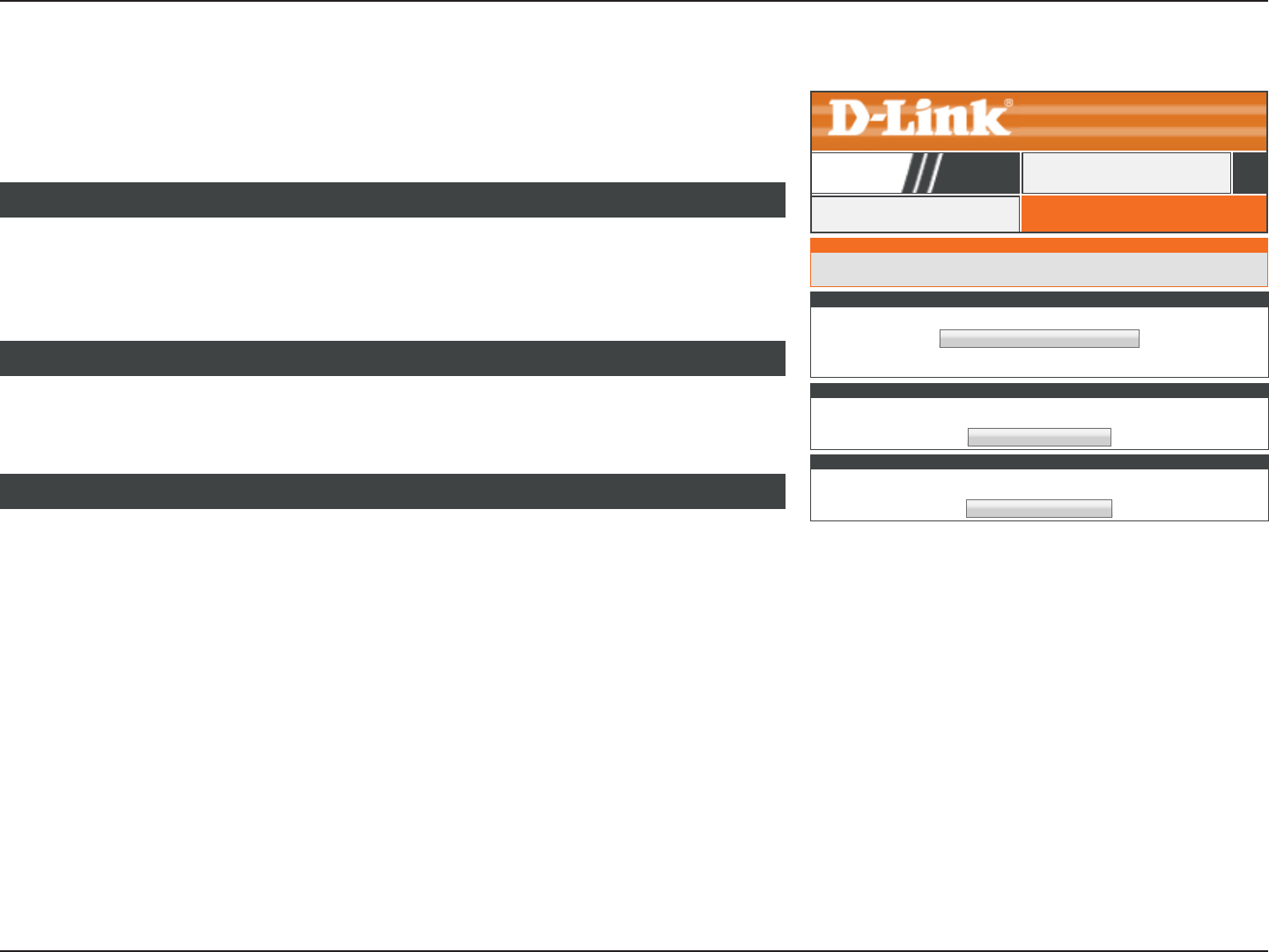
43D-Link DIR-819 User Manual
Section 3 - Conguration
Wireless Settings
WIRELESS SETTINGSWIRELESS SETTINGS
DIR-819 SETUP
Click the Wireless Connection Setup Wizard button to easily congure your wireless
settings. Refer to page Wireless Connection Setup Wizard on page 44 for more
information.
WIRELESS NETWORK SETUP WIZARD
Click the Add Wireless Device with WPS button (Wi-Fi Protected Setup) to add a device
using WPS Wizard.
ADD WIRELESS DEVICE WITH WPS WIFI PROTECTED SETUP WIZARD
Click the Manual Wireless Connection Setup button to manually congure your wireless
LAN settings.
MANUAL WIRELESS CONNECTION SETUP
WIRELESS SETTINGS
The following Web-based wizards are designed to assist you in your wireless network setup and wireless device connection.
Before launching these wizards, please make sure you have followed all steps outlined in the Quick Installation Guide included in the
package.
WIRELESS NETWORK SETUP WIZARD
This wizard is designed to assist you in your wireless network setup. It will guide you through step-by-step instructions on how to set up
your wireless network and how to make it secure.
Wireless Connection Setup Wizard
Note:Some changes made using this Setup Wizard may require you to change some settings on your wireless client adapters so they
can still connect to the D-Link Router.
ADD WIRELESS DEVICE WITH WPS (WI-FI PROTECTED SETUP) WIZARD
This wizard is designed to assist you in connecting your wireless device to your wireless router. It will guide you through step-by-step
instructions on how to get your wireless device connected. Click the button below to begin.
Add Wireless Device with WPS
MANUAL WIRELESS CONNECTION SETUP
If your wireless network is already set up with Wi-Fi Protected Setup, manual conguration of the wireless network will destroy the
existing wireless network. If you would like to congure the wireless settings of your new D-Link Systems Router manually, then click on
the Manual Wireless Network Setup button below.
Manual Wireless Connection Setup
Click Wireless Settings on the navigation menu to congure your Wireless Settings. You may
run the Wireless Connection Setup Wizard, Add a Device with WPS, or run the Manual
Wireless Connection Setup.
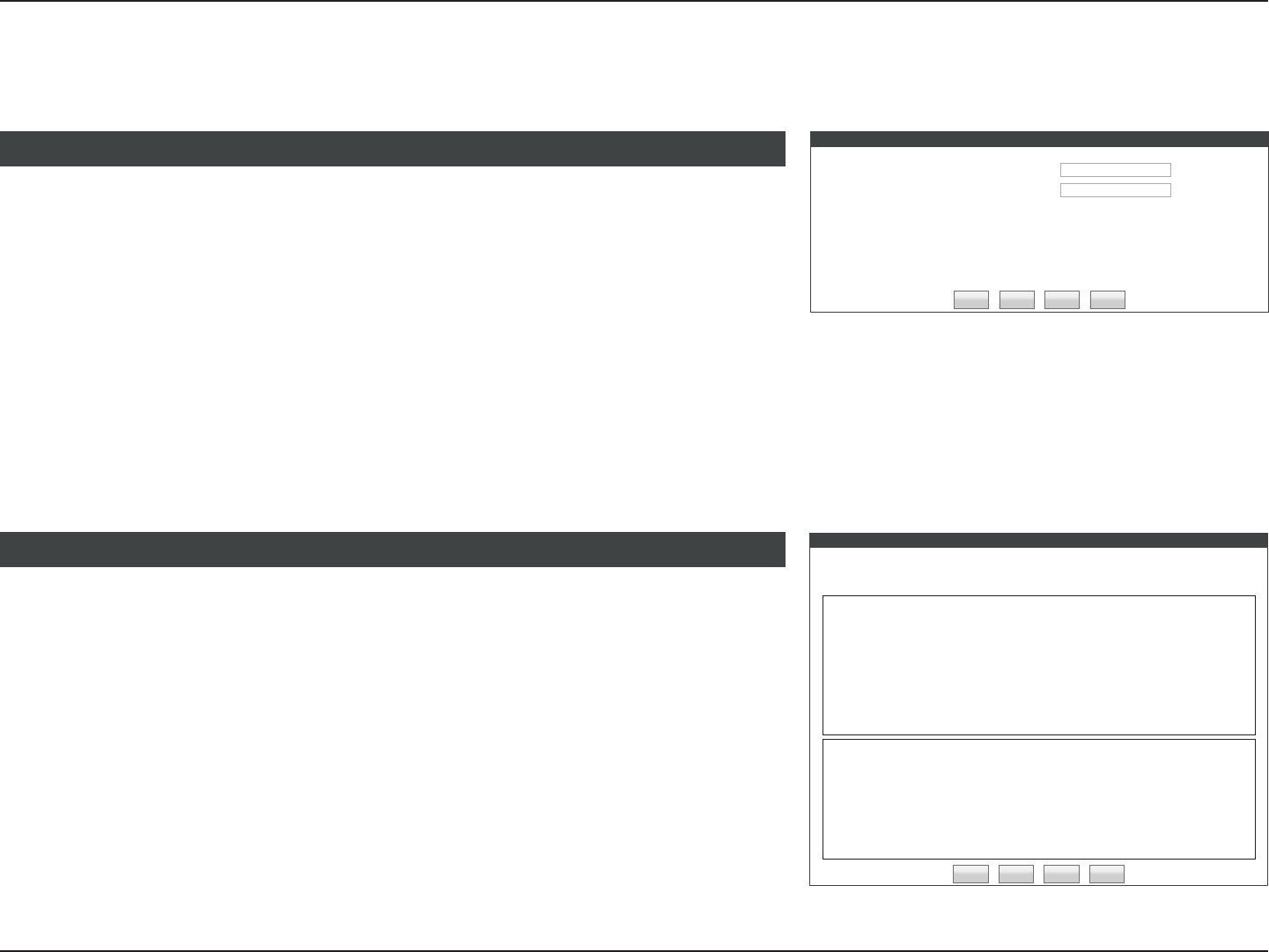
44D-Link DIR-819 User Manual
Section 3 - Conguration
Wireless Connection Setup Wizard
SETUP COMPLETE!
Below is a detailed summary of your wireless security settings. Please print this page out, or write the information on a
piece of paper, so you can congure the correct settings on your wireless client adapters.
Wireless Band : 2.4GHz Band
Wireless Network Name (SSID) : Your_2.4GHz_Network
Security Mode : Auto (WPA or WPA2) - Personal
Cipher Type: TKIP and AES
Pre-Shared Key : d80a73f50c
Wireless Band : 5GHz Band
Wireless Network Name (SSID) : Your_5GHz_Network
Security Mode : Auto (WPA or WPA2) - Personal
Cipher Type: TKIP and AES
Pre-Shared Key : d80a73f50c
Prev Next Cancel Save
If you choose Automatically assign a network, there is no further conguration. A summary
of your wireless conguration settings is displayed.
Click Save to nish.
SETUP COMPLETE!
STEP 1: WELCOME TO THE D-LINK WIRELESS SECURITY SETUP WIZARD
Give your network a name, using up to 32 characters.
Network Name (SSID) 2.4GHz : Your_2.4GHz_Network
Network Name (SSID) 5Ghz : Your_5GHz_Network
Automatically assign a network key (Recommended)
To prevent outsiders from accessing your network, the router will automatically assign a security key (also called WEP or WPA) to
your network.
Manually assign a network key
Use this options if you prefer to create our own key.
Note: All D-Link wireless adapters currently support WPA.
Prev Next Cancel Save
Network Name
(SSID) 2.4GHz:
Enter a name for the 2.4 GHz wireless network.
Network Name
(SSID) 5Ghz:
Enter a name for the 5 GHz wireless network.
Automatically
assign a network:
Choose this option to have the router automatically create a secure
wireless security key.
Manually assign a
network key:
Choose this option to create your own wireless security key.
Click Next to continue.
STEP 1: WELCOME TO THE DLINK WIRELESS SECURITY SETUP WIZARD
This section describes the Wireless Connection Setup Wizard.

45D-Link DIR-819 User Manual
Section 3 - Conguration
Wireless Connection Setup Wizard (continued)
STEP 2: SET YOUR WIRELESS SECURITY PASSWORD
You have selected your security level - you will need to set a wireless security password.
The WPA (Wi-Fi Protected Access) key must meet one of following guidelines:
- Between 8 and 63 characters (A longer WPA key is more secure than a short one )
- Exactly 64 characters using 0-9 and A-F
☑ Use the same Wireless Security Password on both 2.4GHz and 5GHz band
Wireless Security Password : A_Str0ng_P@ssWord!
Note: You will need to enter the same password as keys in this step into your wireless clients in order to enable proper
wireless communication.
Prev Next Cancel Save
STEP 2: SET YOUR WIRELESS SECURITY PASSWORD
You have selected your security level - you will need to set a wireless security password.
The WPA (Wi-Fi Protected Access) key must meet one of following guidelines:
- Between 8 and 63 characters (A longer WPA key is more secure than a short one )
- Exactly 64 characters using 0-9 and A-F
☐ Use the same Wireless Security Password on both 2.4GHz and 5GHz band
2.4GhzWireless Security Password : A_Str0ng_P@ssWord!
5GhzWireless Security Password : A_Str0ng_P@ssWord!
Note: You will need to enter the same password as keys in this step into your wireless clients in order to enable proper
wireless communication.
Prev Next Cancel Save
If you checked Use the same Wireless Security Password on both 2.4GHz and 5GHz
band, enter the Wireless Security Password.
Wireless Security
Password:
Enter a wireless password according to the onscreen guidelines.
If you unchecked Use the same Wireless Security Password on both 2.4GHz and 5GHz
band, enter a 2.4GhzWireless Security Password and 5GhzWireless Security Password:
2.4GhzWireless
Security Password:
Enter a wireless password according to the onscreen guidelines.
5GhzWireless
Security Password:
Enter a wireless password according to the onscreen guidelines.
Click Next to continue.
STEP 2: SET YOUR WIRELESS SECURITY PASSWORD
If you choose Manually assign a network key, there is no further conguration. A summary of your wireless conguration settings is displayed.

46D-Link DIR-819 User Manual
Section 3 - Conguration
SETUP COMPLETE!
Below is a detailed summary of your wireless security settings. Please print this page out, or write the information on a
piece of paper, so you can congure the correct settings on your wireless client adapters.
Wireless Band : 2.4GHz Band
Wireless Network Name (SSID) : Your_2.4GHz_Network
Security Mode : Auto (WPA or WPA2) - Personal
Cipher Type: TKIP and AES
Pre-Shared Key : A_Str0ng_P@ssWord!
Wireless Band : 5GHz Band
Wireless Network Name (SSID) : Your_5GHz_Network
Security Mode : Auto (WPA or WPA2) - Personal
Cipher Type: TKIP and AES
Pre-Shared Key : A_Str0ng_P@ssWord!
Prev Next Cancel Save
A summary of your wireless conguration settings is displayed. Click Save to nish.
Click Save to nish.
SETUP COMPLETE!
Wireless Connection Setup Wizard (continued)

47D-Link DIR-819 User Manual
Section 3 - Conguration
Add Wireless Device with WPS
STEP 1: SELECT CONFIGURATION METHOD FOR YOUR WIRELESS NETWORK
Please select one of following conguration methods and click next to continue.
Auto Select this option if your wireless device supports WPS (Wi-Fi Protected Setup)
Manual Select this option will display the current wireless settings for you to congure the wireless device manually
Prev Next Cancel Connect
Auto: Choose this option to automatically add a device to your network
using this ‘virtual’ WPS button.
Manual: Choose this option to see the currently congured wireless networking
settings to enter on your wireless client.
Choose your conguration type and refer to the following pages.
STEP 1: SELECT CONFIGURATION METHOD NETWORK
This section describes the Add Wireless Device with WPS wizard.

48D-Link DIR-819 User Manual
Section 3 - Conguration
Add Wireless Device with WPS - Auto
STEP 2: CONNECT YOUR WIRELESS DEVICE
There are two ways to add wireless device to your wireless network:
-PIN (Personal Identication Number)
-PBC (Push Button Conguration)
PIN :
please enter the PIN from your wireless device and click the below “Connect” Button within 120 seconds
PBC :
please press the push button on your wireless device and click the below “Connect” Button within 120 seconds
Prev Next Cancel Connect
Select the WPS method to use to connect your wireless device, either PIN or PBC. Using
WPS-PIN is not recommended due to security vulnerabilities.
PIN: Choose this option and enter the currently congured WPS PIN, refer
to Wi-Fi Protected Setup on page 96 for information on setting
the WPS Pin.
PBC: Choose this option to begin the WPS PBC (Push Button Control)
pairing process.
Click Continue to continue.
STEP 2: CONNECT YOUR WIRELESS DEVICE
STEP 2: CONNECT YOUR WIRELESS DEVICE
Please press down the Push Button (physical or virtual) on the wireless device you are adding to your wireless network.
Remain time in second: 120
Adding wireless device: Started
Prev Next Cancel Save
Press the WPS button or enter the WPS PIN on the client device which you wish to add to
your DIR-819’s network. The WPS process is only active for 120 seconds.
STEP 2: CONNECT YOUR WIRELESS DEVICE
STEP 2: CONNECT YOUR WIRELESS DEVICE
Adding wireless device: Session Time-Out.
Prev Next Cancel Save
STEP 2: CONNECT YOUR WIRELESS DEVICE
Adding wireless device: Succeeded. To add another device click on the Cancel button below or click on the Wireless Status button to
check wireless status.
Prev Next Cancel Wireless Status
If your device is successfully added, this screen is displayed. Click Wireless Status to be
directed to the Wireless Status page. Refer to Wireless on page 117 for more information.
If your device could not be found, this screen is displayed. You may click Cancel and retry
running the wizard again.
If you choose Auto and click Next, choose the WPS conguration type:

49D-Link DIR-819 User Manual
Section 3 - Conguration
If you choose Manual and click Next the currently congured wireless networking settings
to enter on your wireless client are displayed.
Click Wireless Status to be directed to the Wireless Status page. Refer to Wireless on page
117 for more information.
Add Wireless Device with WPS - Manual
SETUP COMPLETE!
Below is a detailed summary of your wireless security settings. Please print this page out, or write the information on a
piece of paper, so you can congure the correct settings on your wireless client adapters.
2.4 Ghz Frequency
SSID: Your_2.4GHz_Network
Security Mode: WPA2-PSK
Cipher Type: AES
-PIN (Personal Identication Number)
Pre-shared Key:
adc058dce7893caf98ca91
5 Ghz Frequency
SSID: Your_5GHz_Network
Security Mode: None
Prev Next Cancel Wireless Status
STEP 1: SELECT CONFIGURATION METHOD FOR YOUR WIRELESS NETWORK
Please select one of following conguration methods and click next to continue.
Auto Select this option if your wireless device supports WPS (Wi-Fi Protected Setup)
Manual Select this option will display the current wireless settings for you to congure the wireless device manually
Prev Next Cancel Connect
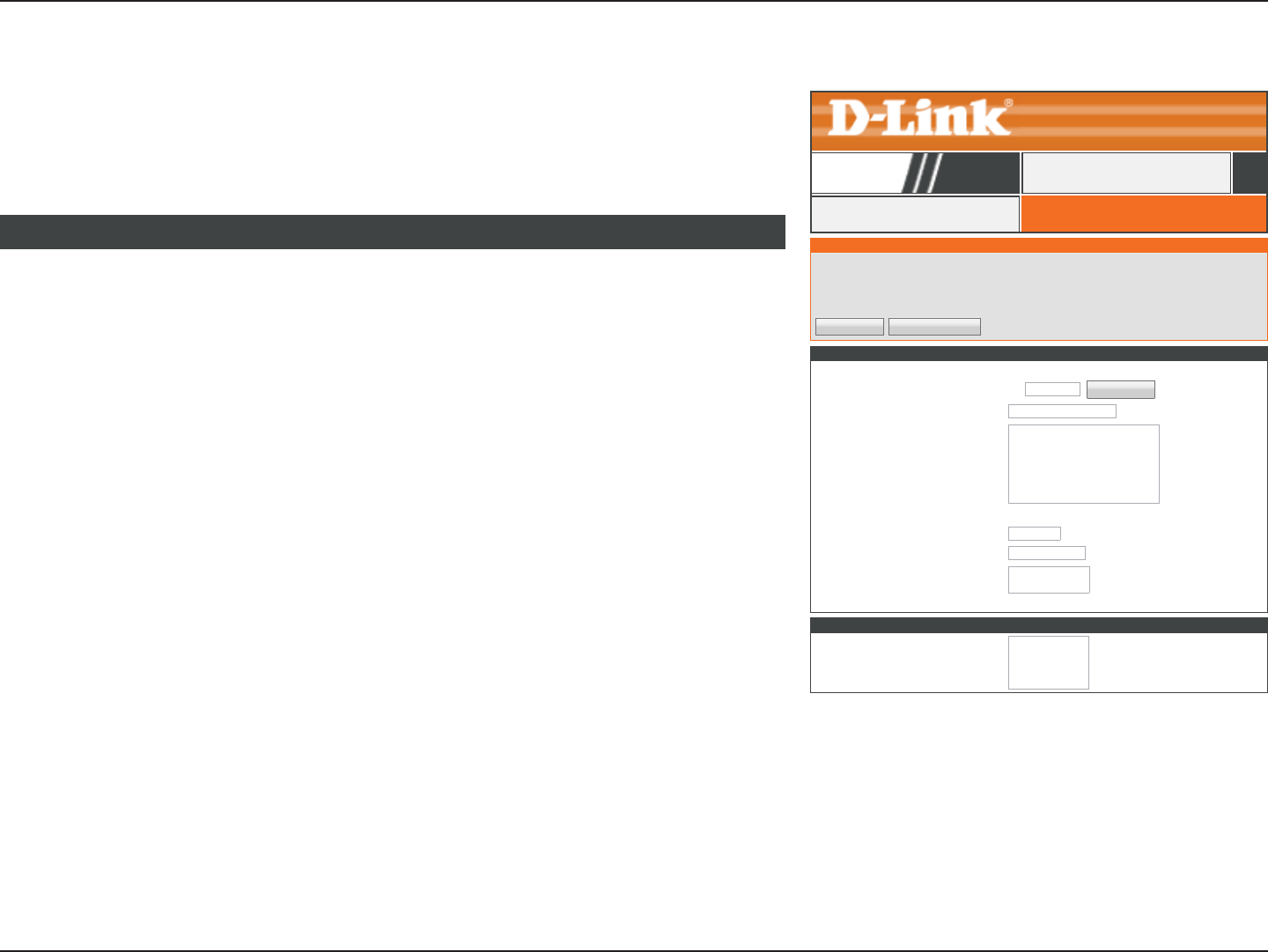
50D-Link DIR-819 User Manual
Section 3 - Conguration
Manual Wireless Connection Setup
WIRELESS NETWORK SETTINGS
Wireless Band : 2.4GHz Band
Enable Wireless : ☑Always ▼New Schedule
Wireless Network Name : Your_2.4GHz_Network
802.11 Mode: 802.11b only ▼
802.11g only
802.11n only
Mixed 802.11g and 802.11b
Mixed 802.11n and 802.11g
Mixed 802.11n, 802.11g and 802.11b
Enable Auto Channel Scan : ☑
Wireless Channel : 04 ▼
Transmission Rate : Best (automatic) ▼(Mbit/s)
Channel Width : 20 MHz ▼
20/40 MHz(Auto)
Visibility Status : Visible Invisible
WIRELESS NETWORKWIRELESS SETTINGS
DIR-819 SETUP
WIRELESS NETWORK
Use this section to congure the wireless settings for your D-Link router. Please note that changes made in this section may also need
to be duplicated on your wireless client.
To protect your privacy you can congure wireless security features. Securing your wireless network is important as it is used to protect
the integrity of the information being transmitted. The router is capable of 4 types of wireless security; WEP, WPA only, WPA2 only, and
WPA/WPA2 (auto-detect).
Save Settings Don’t Save Settings
Click Manual Wireless Connection Setup from the Wireless Settings menu to congure
your wireless LAN settings. From this page you can congure the wireless security and
network parameters for both the 2.4 GHz and 5 GHz network.
When you have nished
conguring your wireless network, click Save Settings.
Wireless Band: 2.4 GHz or 5 GHz
Enable Wireless: Enable or disable this wireless network. From the drop down menu
you may apply a schedule to enable or disable this wireless network.
Click New Schedule to create a new schedule. Refer to Schedules
on page 110 for more information.
Wireless Network
Name:
Create a name for your wireless network.
802.11 Mode
(2.4 GHz):
Select the desired wireless networking standards to use. The available
options for the 2.4 GHz wireless network are 802.11b only, 802.11g
only, 802.11n only, Mixed 802.11g and 802.11b, or the default
Mixed 802.11n, 802.11g and 802.11b.
802.11 Mode
(5 GHz):
Select the desired wireless networking standards to use. The available
options for the 2.4 GHz wireless network are 802.11a only, 802.11n
only, Mixed 802.11a and 802.11n, Mixed 802.11ac and 802.11n,
or the default Mixed 802.11ac, 802.11n and 802.11a.
Enable Auto
Channel Scan:
Check this box to have the router automatically determine the best
wireless channel to use.
Wireless Channel: If Auto Scan is disabled, use the dropdown menu to select the wireless
channel to use.
Transmission Rate: Select the desired wireless transmission rate.
WIRELESS NETWORK SETTINGS
WIRELESS SECURITY MODE
Security Mode : None ▼
WEP
WPA-Personal
WPA-Enterprise

51D-Link DIR-819 User Manual
Section 3 - Conguration
Channel Width
(2.4 GHz):
Select Auto 20/40 if you are using both 802.11n and non-802.11n
devices, or select 20 MHz if you are not using any 802.11n devices.
Channel Width
(5 GHz):
Select Auto 20/40/80 if you are using 802.11ac, 802.11n, and 802.11a
devices. Auto 20/40 select if you are using 802.11n and 802.11a
devices. 20 MHz if you are only using 802.11a devices. Higher channel
width allows for higher speeds.
Visibility Status: The default setting is Visible. Select Invisible if you do not want to
broadcast the SSID of your wireless network.
Note: Making a network invisible is not a form of security alone.
WIRELESS NETWORK SETTINGS
Wireless Band : 5GHz Band
Enable Wireless : ☑Always ▼New Schedule
Wireless Network Name : Your_5GHz_Network
802.11 Mode: 802.11a only ▼
802.11n only
Mixed 802.11a and 802.11n
Mixed 802.11ac and 802.11n
Mixed 802.11ac, 802.11n and 802.11a
Enable Auto Channel Scan : ☑
Wireless Channel : 153 ▼
Transmission Rate : Best (automatic) ▼(Mbit/s)
Channel Width : 20 MHz ▼
20/40 MHz(Auto)
20/40/80 MHz(Auto)
Visibility Status : Visible Invisible
Manual Wireless Connection Setup (continued)
WIRELESS SECURITY MODE
Security Mode : None ▼
WEP
WPA-Personal
WPA-Enterprise
Refer to Wireless Security Mode on page 52 for more information on conguring your
wireless network’s security.
WIRELESS SECURITY MODE

52D-Link DIR-819 User Manual
Section 3 - Conguration
Wireless Security Mode
WIRELESS SECURITY MODE
Security Mode : None ▼
WEP
WPA-Personal
WPA-Enterprise
Security Option: Select a wireless security encryption option. The options are
None, WEP, WPA-Personal, and WPA-Enterprise. Using WPA is
recommended.
WIRELESS SECURITY MODE
WIRELESS SECURITY MODE
Security Mode : None ▼
Security Option: None. Disabling encryption and leaving your wireless network open
is not recommended. Any wireless client will be able to access your
network, be able to use your Internet connection, and leaves you
open to security threats.
WIRELESS SECURITY MODE
None
The following pages describe each type of security option. When you have nished conguring your wireless network, click Save Settings.
WIRELESS SECURITY MODE
Security Mode : WEP ▼
Security Option: WEP. Using WEP encryption is not recommended, as it only oers a
trivial amount of protection for your wireless data. WEP encryption
is only available for use with 802.11b, 802.11g, and 802.11a.
WIRELESS SECURITY MODE
WEP
WEP Key Length: Select the Encryption cipher key bit strength. The available options
are 64 bit (10 hex digits) or 128 bit (26 hex digits).
Authentication: Select either Both or Shared Key.
WEP Key 1: Enter a wireless key to use on your wireless network.
WEP WEP
WEP Key Length : 64 bit (10 hex digits) ▼(length applies to all keys)
Authentication : Both ▼
WEP Key 1 :
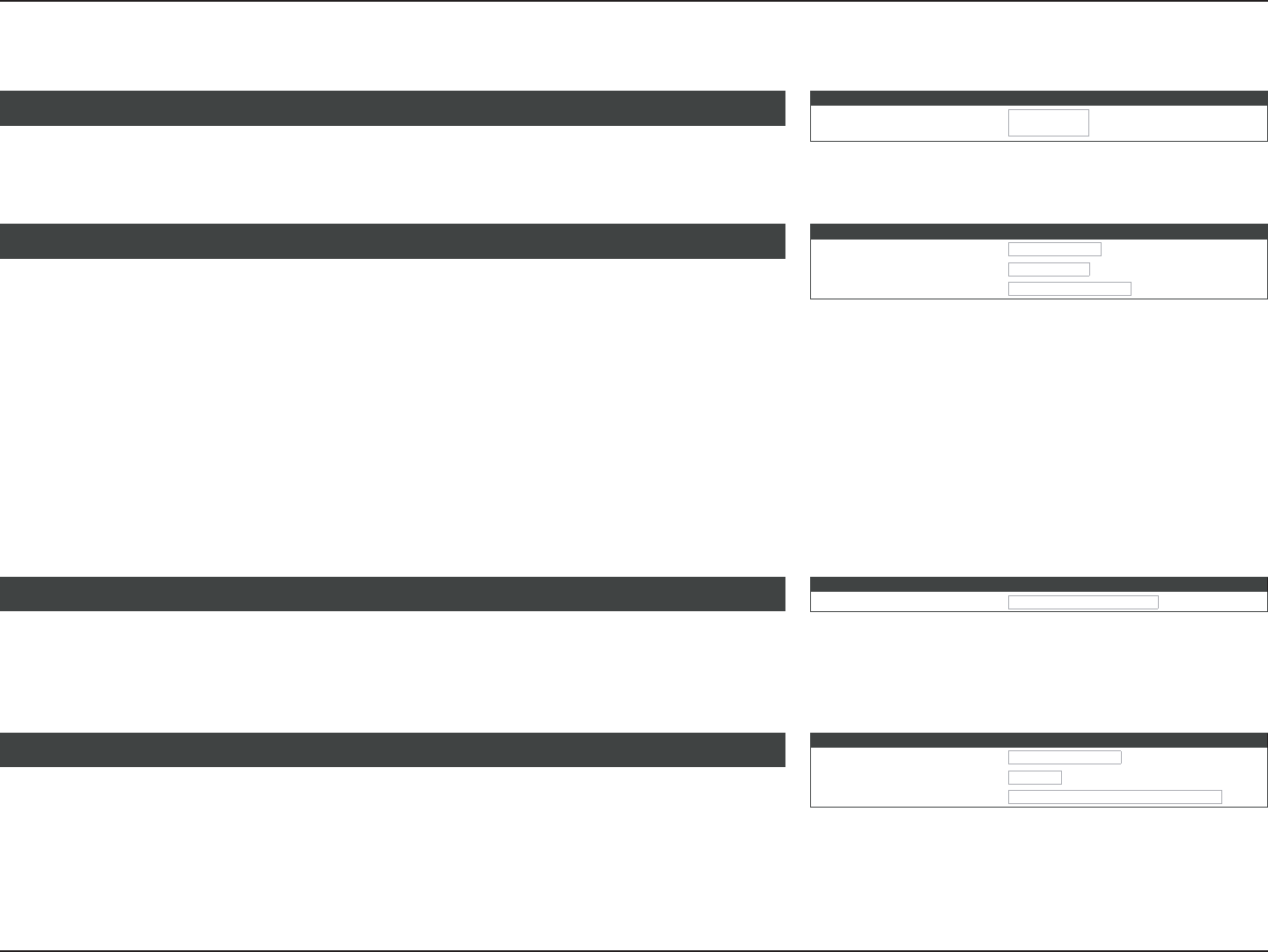
53D-Link DIR-819 User Manual
Section 3 - Conguration
WPA-Personal / WPA-Enterprise
WPA Mode: Select either Auto(WPA or WPA2) or WPA2 Only. WPA2 Only is the
recommended wireless security type. Select Auto (WPA or WPA2)
only if your wireless clients do not support WPA2.
Cipher Type: Select either TKIP and AES, TKIP, or AES. Using AES is the
recommended since TKIP is no longer considered secure.
Group Key Update
Interval:
Enter the group key update interval.
WPA WPA
WPA Mode : WPA2 Only ▼
Cipher Type : AES ▼
Group Key Update Interval : 3600 (seconds)
Pre-Shared Key: Enter a wireless key to use on your wireless network.
PRESHARED KEY PRE-SHARED KEY
Pre-Shared Key :
If you selected WPA-Personal, enter the Pre-Shared Key:
RADIUS server IP
Address:
Enter a wireless key to use on your wireless network.
RADIUS server Port: Enter your RADIUS server’s port number.
RADIUS server
Shared Secret:
Enter your RADIUS server’s shared secret.
EAP 802.1X EAP (802.1X)
RADIUS server IP Address :
RADIUS server Port:
RADIUS server Shared Secret:
If you selected WPA-Enterprise, enter your EAP 802.1X Radius server information:
Security Option: Select either WPA-Personal or WPA-Enterprise. If you are running
a dedicated RADIUS authentication server, choose WPA-Enterprise.
WIRELESS SECURITY MODE WIRELESS SECURITY MODE
Security Mode : WPA-Personal ▼
WPA-Enterprise
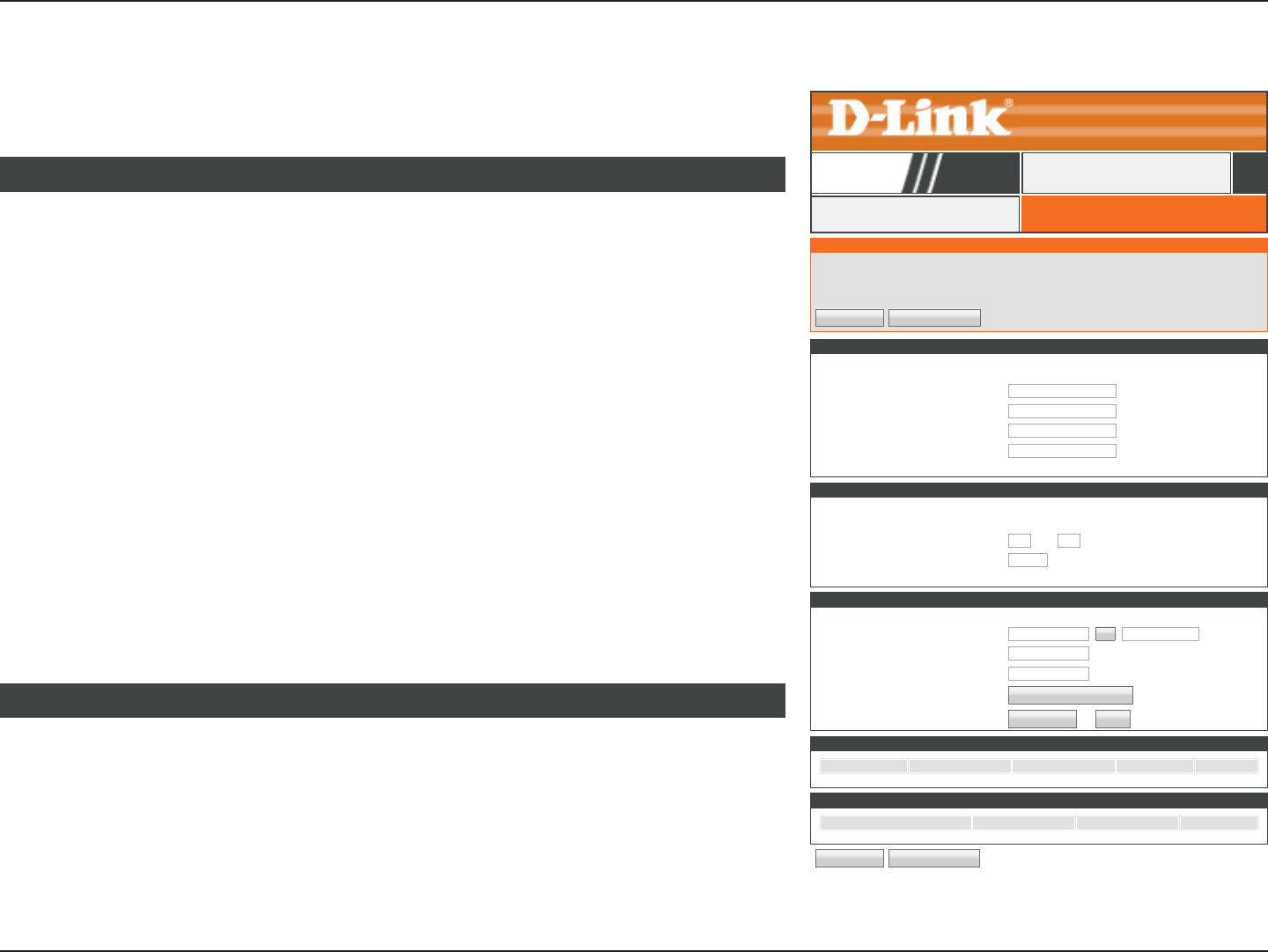
54D-Link DIR-819 User Manual
Section 3 - Conguration
Network Settings
NETWORK SETTINGSNETWORK SETTINGS
DIR-819 SETUP
Click Network Settings on the navigation menu to congure your local network settings.
When you are satised with your conguration, click Save Settings.
Router IP Address: Enter the IP address of the router. The default IP address is 192.168.0.1.
If you change the IP address, once you click Save Settings, you will
need to enter the new IP address in your browser to get back into
the conguration utility.
Default Subnet
Mask:
Enter the subnet mask of the router. The default subnet mask is
255.255.255.0.
Host Name: The default address to access the router’s configuration is
http://dlinkrouter.local./ Here, you can replace dlinkrouter with a
name of your choice.
Local Domain
Name:
Enter the domain name (optional).
Enable DNS Relay: Disable to transfer the DNS server information from your ISP to your
computers. If enabled, your computers will use the router for a DNS
server.
ROUTER SETTINGS
NETWORK SETTINGS
Use this section to congure the internal network settings of your router and also to congure the built-in DHCP server to assign IP
addresses to computers on your network.The IP address that is congured here is the IP address that you use to access the Web-
based management interface.If you change the IP address in this section, you may need to adjust your PC's network settings to access
the network again.
Please note that this section is optional and you do not need to change any of the settings here to get your network up and running.
Save Settings Don’t Save Settings
DHCP RESERVATIONS LIST
Enable Host Name IP Address
NUMBER OF DYNAMIC DHCP CLIENTS
Host Name IP Address MAC Address Expired Time
ROUTER SETTINGS
Use this section to congure the internal network settings of your router.The IP address that is congured here is the IP address that
you use to access the Web-based management interface.If you change the IP address here, you may need to adjust your PC’s network
settings to access the network again.
Router IP Address: 192.168.0.1
Default Subnet Mask : 255.255.255.0
Host Name : dlinkrouter
Local Domain Name : (optional)
Enable DNS Relay : ☑
ADD DHCP RESERVATION
Enable : ☐
Computer Name : << Computer Name ▼
IP Address :
MAC Address :
Clone Your PC’s MAC Address
Add / Update Clear
DHCP SERVER SETTINGS
Use this section to congure the built-in DHCP server to assign IP address to the computers on your network.
Enable DHCP Server : ☑
DHCP IP Address Range : 100 to 200 (addresses within the LAN subnet)
DHCP Lease Time : 10080 (minutes)
Always broadcast : ☐(compatibility for some DHCP Clients)
Save Settings Don’t Save Settings
Enable DHCP
Server:
Enable or disable the DHCP server.
DHCP IP Address
Range:
Enter the starting and ending IP addresses for the DHCP server’s IP
assignment.
Note: If you statically (manually) assign IP addresses to your computers
or devices, make sure the IP addresses are outside of this range or you
may have an IP conict.
DHCP SERVER SETTINGS
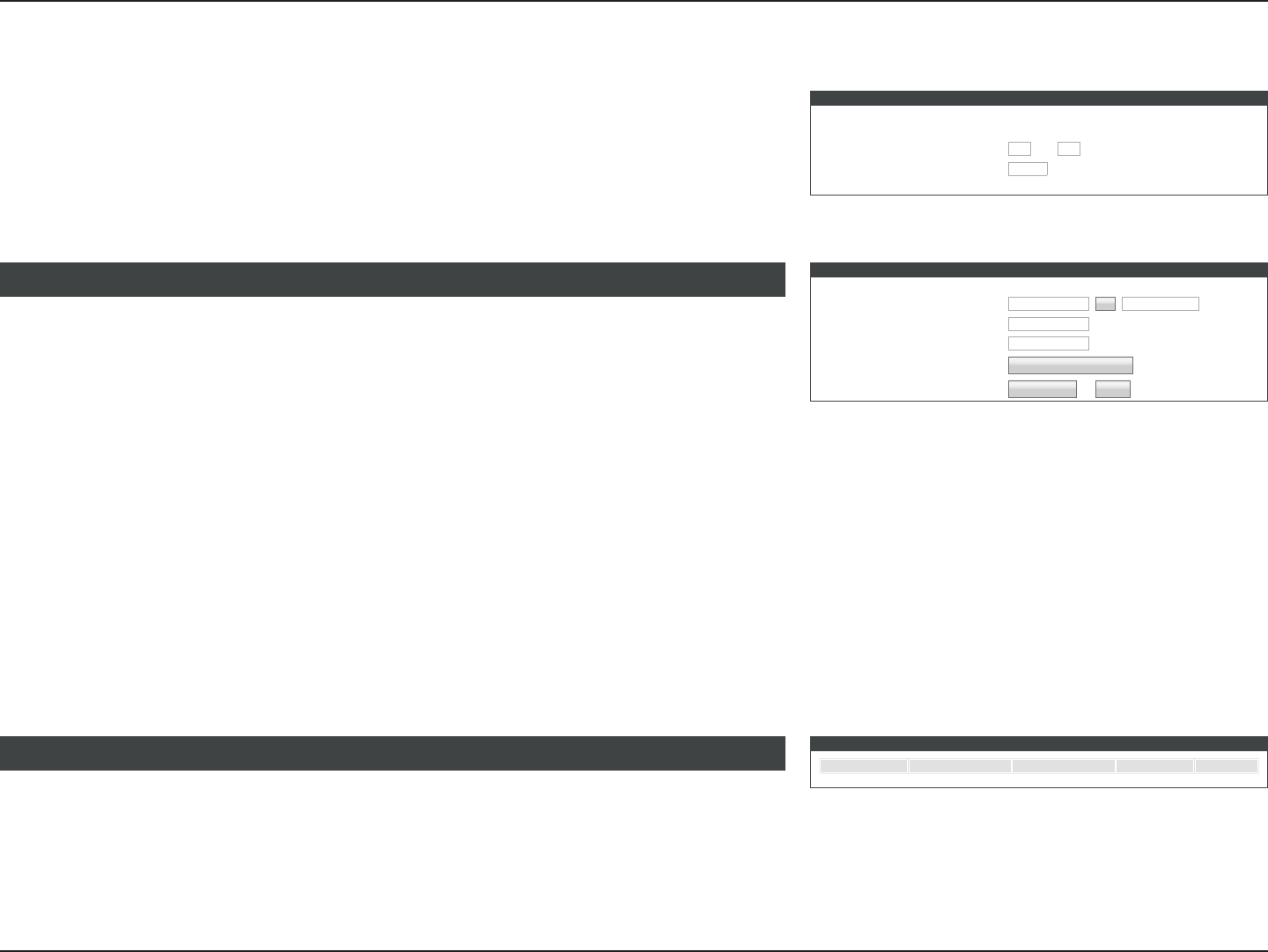
55D-Link DIR-819 User Manual
Section 3 - Conguration
DHCP Lease Time: The maximum length of time for the IP address lease. Enter the Lease
time in minutes.
Always broadcast: Check this box if your clients are having diculty obtaining an IP
address.
Network Settings (continued)
DHCP RESERVATIONS LIST
Enable Host Name IP Address
ADD DHCP RESERVATION
Enable : ☐
Computer Name : << Computer Name ▼
IP Address :
MAC Address :
Clone Your PC’s MAC Address
Add / Update Clear
DHCP SERVER SETTINGS
Use this section to congure the built-in DHCP server to assign IP address to the computers on your network.
Enable DHCP Server : ☑
DHCP IP Address Range : 100 to 200 (addresses within the LAN subnet)
DHCP Lease Time : 10080 (minutes)
Always broadcast : ☐(compatibility for some DHCP Clients)
DHCP Reservation allows you to reserve IP addresses for specic machines based on their
unique hardware MAC addresses. During DHCP IP address assignment, these devices will
receive the same IP address. This is particularly useful if you run servers on your network.
Enable: Enable or disable DHCP reservation.
Computer Name: Enter a name for your DHCP reservation rule. To easily add an IP
reservation for an existing device select it from the drop down menu
and click the << button. The elds will automatically populate.
IP Address: Enter the IP address you wish to have assigned to this device.
MAC Address: Enter the MAC address of the device you wish to apply the DHCP
reservation rule to. Click Clone Your PC’s MAC Address to ll this eld.
Click Add / Update when you are done.
ADD DHCP RESERVATION
The currently dened DHCP Reservations are listed here.
DHCP RESERVATIONS LIST
Enable: Enable or disable this DHCP Reservation rule.
Host Name: The host name for this rule.
IP Address: The DHCP IP address reservation.
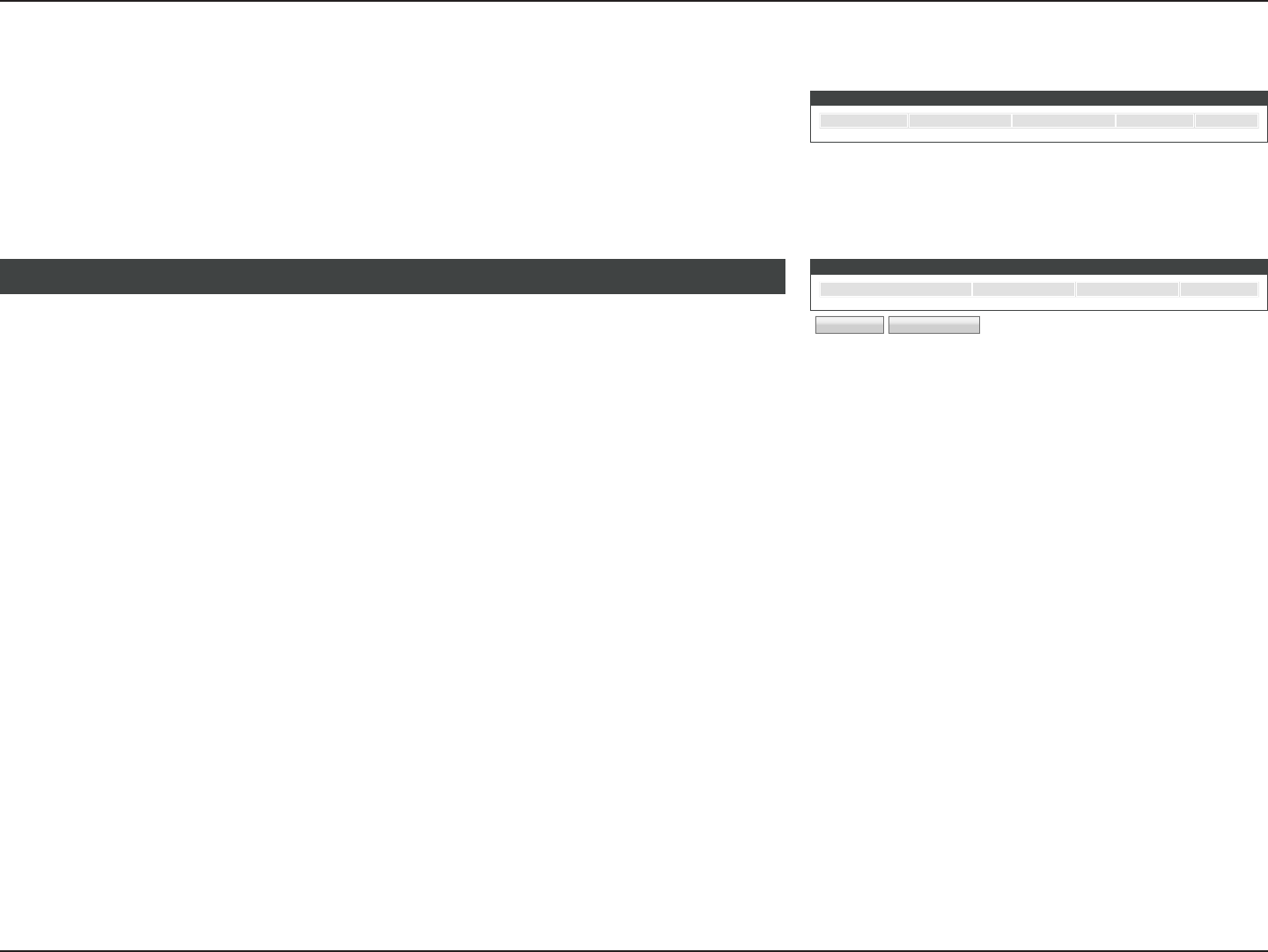
56D-Link DIR-819 User Manual
Section 3 - Conguration
DHCP RESERVATIONS LIST
Enable Host Name IP Address
NUMBER OF DYNAMIC DHCP CLIENTS
Host Name IP Address MAC Address Expired Time
Save Settings Don’t Save Settings
NUMBER OF DYNAMIC DHCP CLIENTS
MAC Address: The MAC address of the device.
Edit Button: Click this button to edit this rules settings.
Delete Button: Click this button to delete this DHCP IP Reservation.
Network Settings (continued)
This section displays all of the currently connected DHCP cclients. The Host Name, IP address,
MAC Address, and expiration time of each client is displayed in the table.
Click Save Settings when you are nished.

57D-Link DIR-819 User Manual
Section 3 - Conguration
IPv6
IPV6 INTERNET CONNECTIONIPV6
DIR-819 SETUP
Click IPv6 on the navigation menu to congure IPv6 connectivity.
The IPv6 Internet Connection Setup Wizard allows you to quickly set up an IPv6 Internet
connection which uses PPPoE, Static IP, or 6rd. See IPv6 Internet Connection Setup
Wizard on page 58 for more information.
To congure your router to use IPv6 locally on your LAN only see IPv6 Local Connectivity
Settings on page 62.
You may also manually configure your IPv6 connection. See Manual IPv6 Internet
Connection Setup on page 63.
IPV6 INTERNET CONNECTION
There are two ways to set up your IPv6 Internet connection. You can use the Web-based IPv6 Internet Connection Setup Wizard, or
you can manually congure the connection.
IPV6 INTERNET CONNECTION SETUP WIZARD
If you would like to utilize our easy to use Web-based Wizard to assist you in connecting your new D-Link Systems Router to the IPv6
Internet, click on the button below.
IPv6 Internet Connection Setup Wizard
Note:Before launching the wizards, please make sure you have followed all steps outlined in the Quick Installation Guide included in
the package.
MANUAL IPV6 LOCAL CONNECTIVITY SETUP
If you would like to congure the IPv6 local connectivity settings of your D-Link Router, then click on the button below.
IPv6 Local Connectivity Settings
MANUAL IPV6 INTERNET CONNECTION SETUP
If you would like to congure the IPv6 Internet settings of your new D-Link Router manually, then click on the button below.
Manual IPv6 Internet Connection Setup

58D-Link DIR-819 User Manual
Section 3 - Conguration
IPv6 Internet Connection Setup Wizard
The IPv6 Internet Connection Setup Wizard allows you to quickly set up an IPv6 Internet
connection which uses PPPoE, Static IP, or 6rd. Click Next to begin.
WELCOME TO THE D-LINK IPV6 INTERNET CONNECTION SETUP WIZARD
This wizard will guide you through a step-by-step process to congure your new D-Link router and connect to the IPv6
Internet.
• Step 1: Congure your IPv6 Internet Connection
• Step 2: Save Settings and Connectnect
Prev Next Cancel Connect
STEP 1: CONFIGURE YOUR IPV6 INTERNET CONNECTION
Please select your IPv6 Internet Connection type:
IPv6 over PPPoE
Choose this option if your IPv6 Internet connection requires a username and password to get online. Most DSL modems use this
type of connection.
Static IPv6 address and Route
Choose this option if your Internet Setup Provider (ISP) provided you with IPv6 Address information that has to be manually
congured.
Tunneling Connection (6rd)
Choose this option if your Internet Setup Provider (ISP) provided you a IPv6 Internet Connection by using 6rd automatic tunneling
mechanism.
Prev Next Cancel Connect
Choose your IPv6 connection type and click Next.
STEP 1: CONFIGURE YOUR IPV6 INTERNET CONNECTION
For IPv6 over PPPoE setup help refer to page 59.
For Static IPv6 address and Route setup help refer to page 60.
For Tunneling Connection (6rd) setup help refer to page 61.

59D-Link DIR-819 User Manual
Section 3 - Conguration
If you choose IPv6 over PPPoE as your Internet Connection, enter your IP address, congure the following settings:
IPv6 over PPPoE
IPv6 Internet Connection Setup Wizard
Click Connect to nish the setup.
SETUP COMPLETE! SETUP COMPLETE!
The IPv6 Internet Connection Setup Wizard has completed. Click the Connect button to save your settings and reboot
the router.
Prev Next Cancel Connect
PPPoE Session : Select whethe to Share with IPv4 or Create a new session.
If you choose Create a new session as the PPPoE Session, ll in the following elds:
Username: Enter the username provided by your ISP.
Password: Enter the password provided by your ISP.
Verify Password: Enter the password provided by your ISP one more time.
Service Name: Enter the ISP service name (optional).
Click Next to continue.
SET USERNAME AND PASSWORD CONNECTION PPPOE SET USERNAME AND PASSWORD CONNECTION (PPPOE)
To set up this connection you will need to have a Username and Password from your IPv6 Internet Service Provider. If
you do not have this information, please contact your ISP.
PPPoE Session : Share with IPv4 Create a new session
User Name :
Password :
Verify Password :
Service Name : (optional)
Note: You may also need to provide a Service Name. If you do not have or know this information, please contact your ISP.
Prev Next Cancel Connect

60D-Link DIR-819 User Manual
Section 3 - Conguration
If you choose Static IPv6 address and Route as your Internet Connection, enter your IP address, congure the following settings:
Click Connect to nish the setup.
SETUP COMPLETE! SETUP COMPLETE!
The IPv6 Internet Connection Setup Wizard has completed. Click the Connect button to save your settings and reboot
the router.
Prev Next Cancel Connect
SET STATIC IPV6 ADDRESS CONNECTION
To set up this connection you will need to have a complete list of IPv6 information provided by your IPv6 Internet
Service Provider. If you have a Static IPv6 connection and do not have this information, please contact your ISP.
Use Link-Local Address : ☑
IPv6 Address :
Subnet Prex Length :
Default Gateway :
Primary IPv6 DNS Address :
Secondary IPv6 DNS Address :
LAN IPv6 Address :
Prev Next Cancel Connect
SET STATIC IPV6 ADDRESS CONNECTION
Use Link-Local
Address:
Enable or disable using the Link-Local Address. The IPv6 Address and
Subnet Prex Length is automatically populated with this function.
IPv6 Address: Enter the address supplied by your ISP.
Subnet Prefix
Length:
Enter the subnet prex length supplied by your ISP.
Default Gateway: Enter the default gateway for your IPv6 connection.
Primary IPv6 DNS
Address:
Enter the primary DNS server address.
Secondary IPv6
DNS Address:
Enter the secondary DNS server address.
LAN IPv6 Address: Enter your the LAN IPv6 Address you want to use.
Click Next to continue.
Static IPv6 address and Route
IPv6 Internet Connection Setup Wizard

61D-Link DIR-819 User Manual
Section 3 - Conguration
If you choose Tunneling Connection (6rd) as your Internet Connection, enter your IP address, congure the following settings:
Click Connect to nish the setup.
SETUP COMPLETE! SETUP COMPLETE!
The IPv6 Internet Connection Setup Wizard has completed. Click the Connect button to save your settings and reboot
the router.
Prev Next Cancel Connect
SET UP 6RD TUNNELING CONNECTION
To set up this 6rd tunneling connection you will need to have the following information from your IPv6 Internet Service
Provider. If you do not have this information, please contact your ISP.
6rd IPv6 Prex : /
IPv4 Address : Mask Length :
Assigned IPv6 Prex :
6rd Border Relay IPv4 Address :
Primary IPv6 DNS Address :
Prev Next Cancel Connect
SET UP 6RD TUNNELING CONNECTION
6rd IPv6 Prefix: Enter the 6rd IPv6 prex and mask length supplied by your ISP.
IPv4 Address: Displays the router’s IPv4 address and mask length.
Assigned IPv6
Prefix:
Displays the router’s assigned IPv6 prex.
6rd Border Relay
IPv4 Address:
Enter the 6rd border relay IPv4 address settings supplied by your ISP.
IPv6 DNS Server: Enter the IPv6 DNS server address.
Click Next to continue.
Tunneling Connection (6rd)
IPv6 Internet Connection Setup Wizard
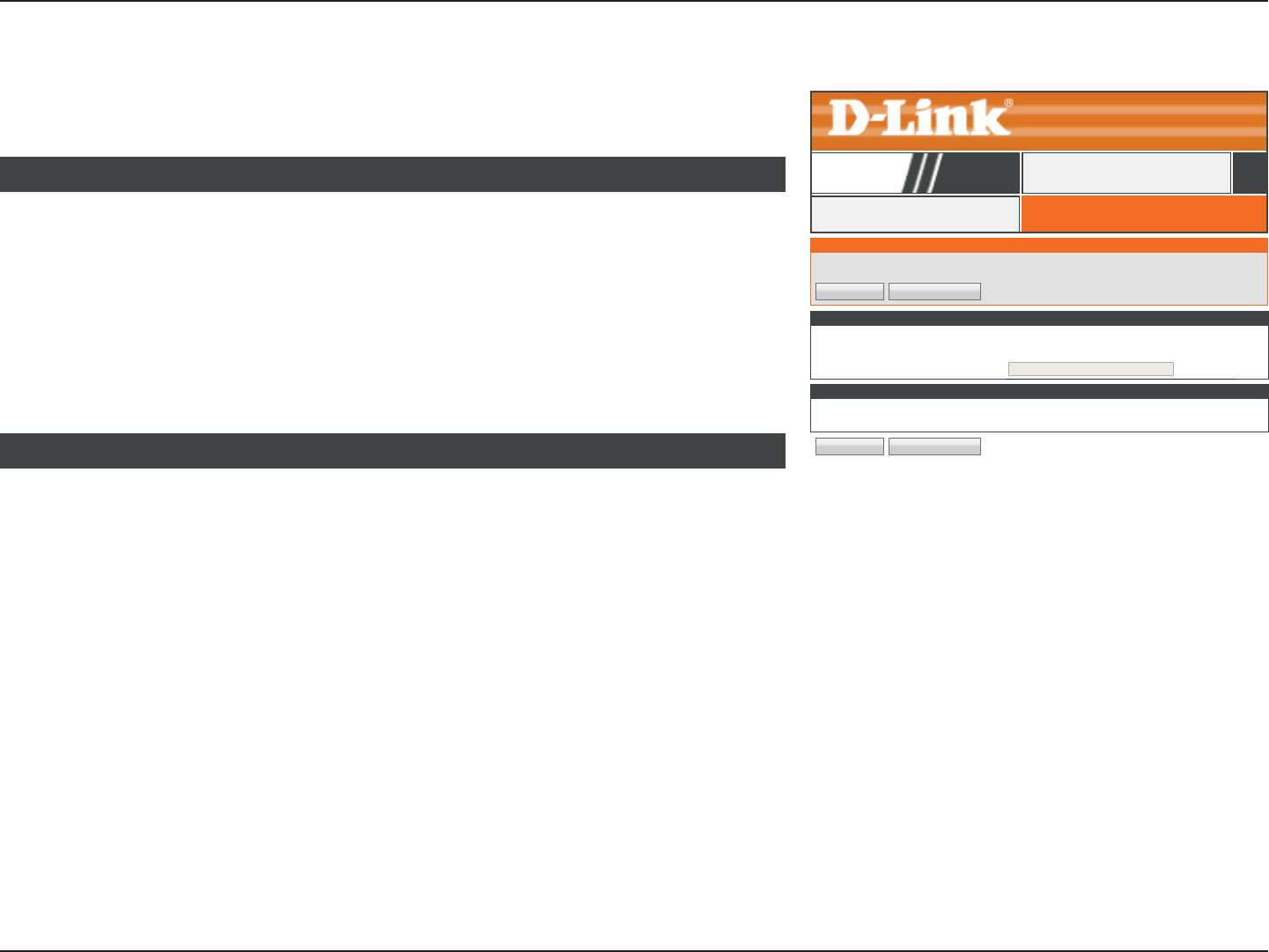
62D-Link DIR-819 User Manual
Section 3 - Conguration
IPv6 Local Connectivity Settings
IPV6 LOCAL CONNECTIVITY SETTINGS
IPV6
DIR-819 SETUP
IPV6 LOCAL CONNECTIVITY SETTINGS
Use this section to congure Unique Local IPv6 Unicast Address (ULA) settings for your router.ULA is intended for local communications
and not expected to be routable on the global Internet.
Save Settings Don’t Save Settings
IPV6 ULA SETTINGS
Enable ULA : ☑
Use default ULA prex : ☑
Use default ULA prex : /64
CURRENT IPV6 ULA SETTINGS
Current ULA Prex : /64
LAN IPv6 ULA : /64
Save Settings Don’t Save Settings
Click the IPv6 Local Connectivity Settings button to congure IPv6 on your local network.
When you are satised with your conguration, click Save Settings.
Enable ULA: Enable or disable ULA.
Use default ULA
prefix:
Enable or disable the use of the default ULA prex.
If you enabled ULA, enter your ULA prex:
ULA Prefix: Enter your ULA prex.
IPV6 ULA SETTINGS
Current ULA
Prefix:
The current ULA Prex is displayed here.
LAN IPv6 ULA: The current LAN IPv6 ULA is displayed here.
When you have nished conguring your IPv6 connection, click the Save Settings button.
IPV6 ULA SETTINGS
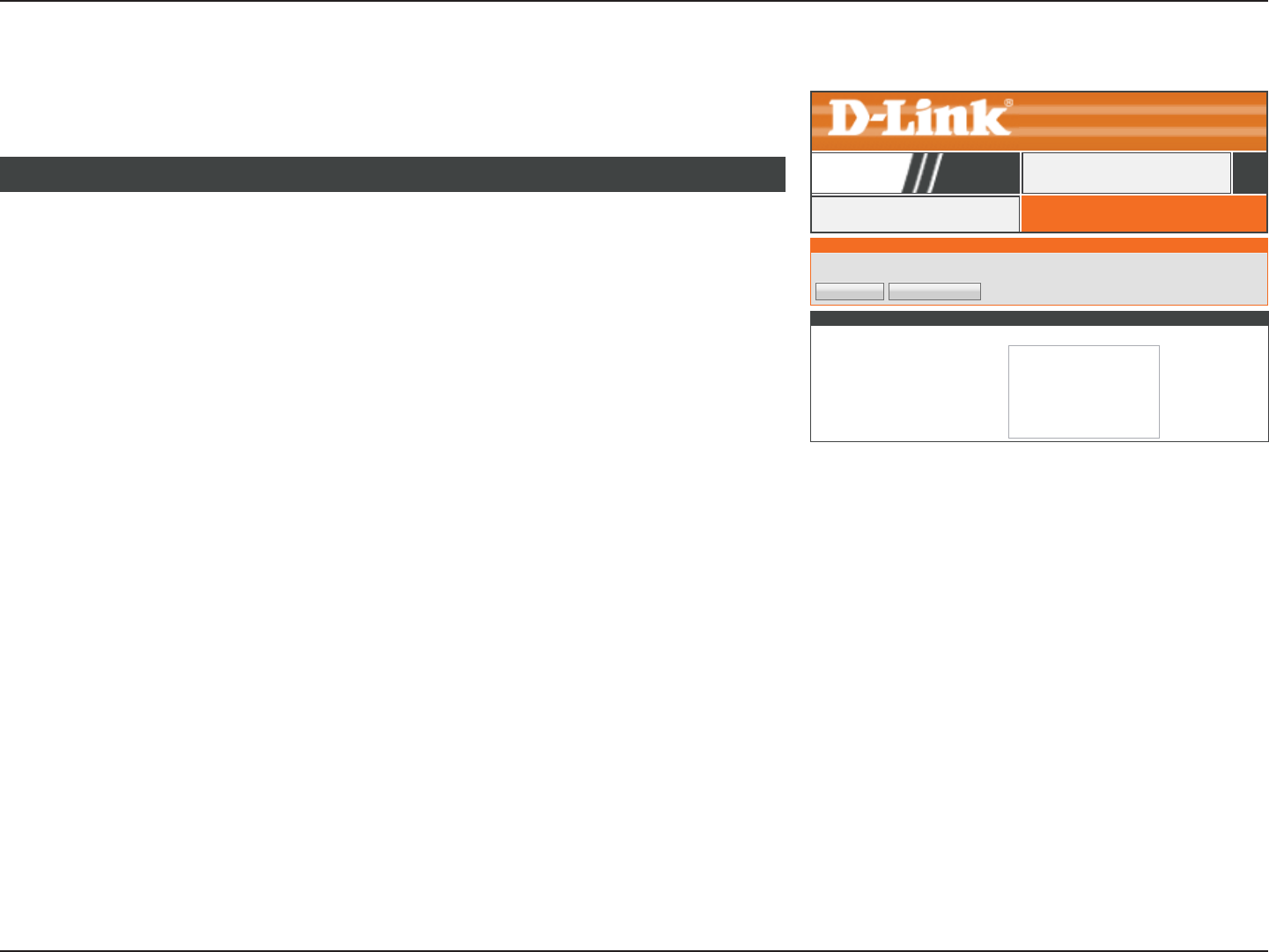
63D-Link DIR-819 User Manual
Section 3 - Conguration
Manual IPv6 Internet Connection Setup
IPV6 IPV6
DIR-819 SETUP
IPV6
Use this section to congure your IPv6 Connection Type.If you are unsure of your connection method, please contact your Internet
Service Provider.
Save Settings Don’t Save Settings
IPV6 CONNECTION TYPE
Choose the mode to be used by the router to connect to the IPv6 Internet.
My IPv6 Connection is: Static IPv6 ▼
Autoconguration(SLAAC/DHCPv6)
PPPoE
IPv6 in IPv4 Tunnel
6to4
6rd
Local Connectivity Only
My IPv6
Connection is:
Choose your IPv6 connection type from the drop-down menu. You will
be presented with the appropriate options for your connection type.
IPV6 INTERNET CONNECTION SETUP WIZARD
For Static IPv6 refer to page 64.
For Autoconguration(SLAAC/DHCPv6) refer to page 66.
For PPPoE refer to page 68.
For IPv6 in an IPv4 Tunnel refer to page 71.
For 6to4 refer to page 74.
For 6rd refer to page 76.
For Local Connectivity Only refer to page 78.
When you have nished conguring your IPv6 connection, click the Save Settings button.
Click the Manual IPv6 Internet Connection Setup button to manually congure your IPv6
connection to your ISP. When you are satised with your conguration, click Save Settings.
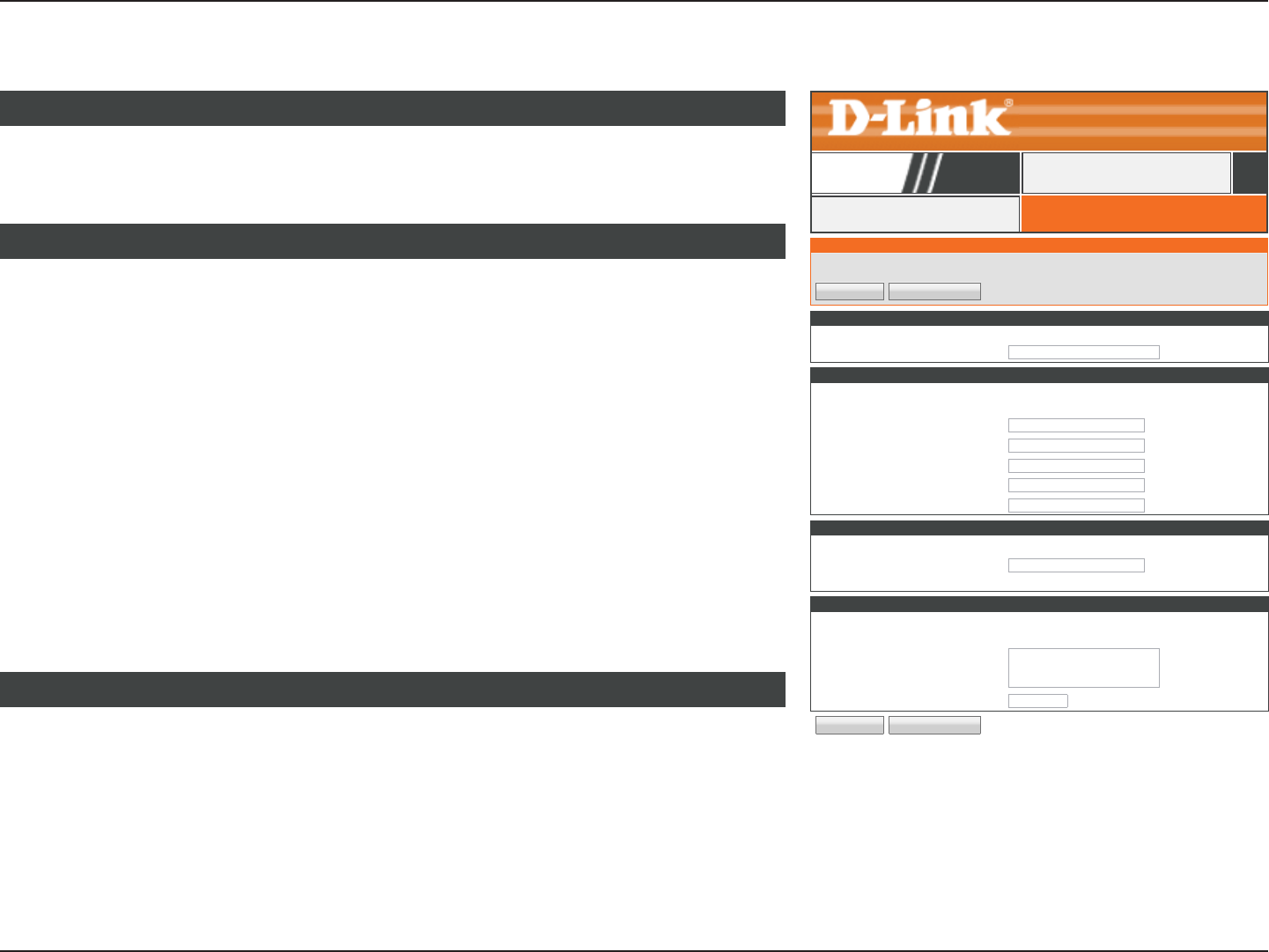
64D-Link DIR-819 User Manual
Section 3 - Conguration
Static IPv6
IPV6 CONNECTION TYPE
Choose the mode to be used by the router to connect to the IPv6 Internet.
My IPv6 Connection is: Static IPv6 ▼
ADDRESS AUTOCONFIGURATION SETTINGS
Use this section to setup IPv6 Autoconguration to assign IP addresses to the computers on your network.
Enable Automatic IPv6 address assignment : ☑
Autoconguration Type : SLAAC+RDNSS ▼
SLAAC+Stateless DHCP
Stateful DHCPv6
Router Advertisement Lifetime : (minutes)
WAN IPV6 ADDRESS SETTINGS
Enter the IPv6 address information provided by your Internet Service Provider (ISP).
Use Link-Local Address : ☑
IPv6 Address :
Subnet Prex Length :
Default Gateway :
Primary DNS Address :
Secondary DNS Address :
LAN IPV6 ADDRESS SETTINGS
Use this section to congure the internal network settings of your router. If you change the LAN IPv6 Address here, you may need to
adjust your PC network settings to access the network again.
LAN IPv6 Address : /64
LAN IPv6 Link-Local Address : ffff::fff:ffff:ffff:1234 /64
IPV6 IPV6
DIR-819 SETUP
IPV6
Use this section to congure your IPv6 Connection Type.If you are unsure of your connection method, please contact your Internet
Service Provider.
Save Settings Don’t Save Settings
Use Link-Local
Address:
Enable or disable using the Link-Local Address. The IPv6 Address and
Subnet Prex Length is automatically populated with this function.
IPv6 Address: Enter the address supplied by your ISP.
Subnet Prefix
Length:
Enter the subnet prex length supplied by your ISP.
Default Gateway: Enter the default gateway for your IPv6 connection.
Primary DNS
Address:
Enter the primary DNS server address.
Secondary DNS
Address:
Enter the secondary DNS server address.
WAN IPV6 ADDRESS SETTINGS
LAN IPv6 Address: Enter the LAN (local) IPv6 address for the router.
LAN IPv6 Link-
Local Address:
Displays the router’s LAN link-local address.
LAN IPv6 Address Settings
My IPv6
Connection is:
Select Static IPv6 if your IPv6 information is provided by your ISP.
IPV6 CONNECTION TYPE
Save Settings Don’t Save Settings
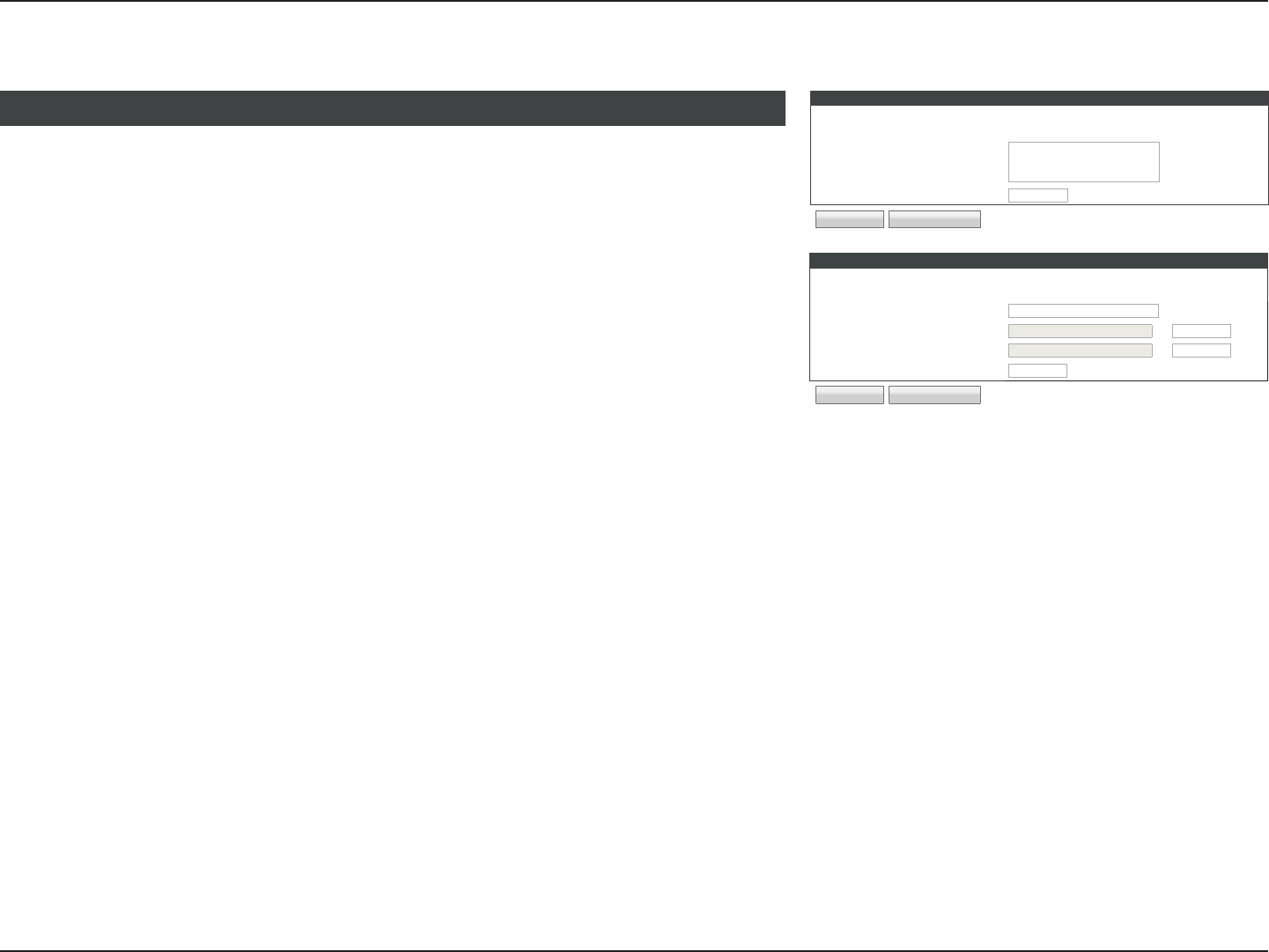
65D-Link DIR-819 User Manual
Section 3 - Conguration
Enable Automatic
IPv6 address
assignment:
Enable or disable the Automatic IPv6 Address Assignment feature. If
you disable this option, no further conguration is available.
Autoconfiguration
Type:
Select SLAAC+RDNSS, SLAAC+Stateless DHCP, or Stateful DHCPv6.
If you choose SLAAC+Stateless DHCP, please congure the following eld:
Router
Advertisement
Lifetime:
Enter the IPv6 address lifetime (in minutes).
If you choose Stateful DHCPv6, please congure the following elds:
IPv6 Address
Range(Start):
Enter the starting IPv6 address for the DHCP server’s IPv6 assignment.
IPv6 Address
Range(End):
Enter the ending IPv6 address for the DHCP server’s IPv6 assignment.
Router
Advertisement
Lifetime:
Enter the IPv6 address lifetime (in seconds).
When you have nished conguring your IPv6 connection, click the Save Settings button.
Address Autoconfiguration Settings
Static IPv6 (continued)
ADDRESS AUTOCONFIGURATION SETTINGS
Use this section to setup IPv6 Autoconguration to assign IP addresses to the computers on your network.
Enable Automatic IPv6 address assignment : ☑
Autoconguration Type : Stateful DHCPv6 ▼
IPv6 Address Range (Start) : :00 1
IPv6 Address Range (End) : :00 ff
Router Advertisement LIfetime : (minutes)
Save Settings Don’t Save Settings
ADDRESS AUTOCONFIGURATION SETTINGS
Use this section to setup IPv6 Autoconguration to assign IP addresses to the computers on your network.
Enable Automatic IPv6 address assignment : ☑
Autoconguration Type : SLAAC+RDNSS ▼
SLAAC+Stateless DHCP
Stateful DHCPv6
Router Advertisement LIfetime : (minutes)
Save Settings Don’t Save Settings
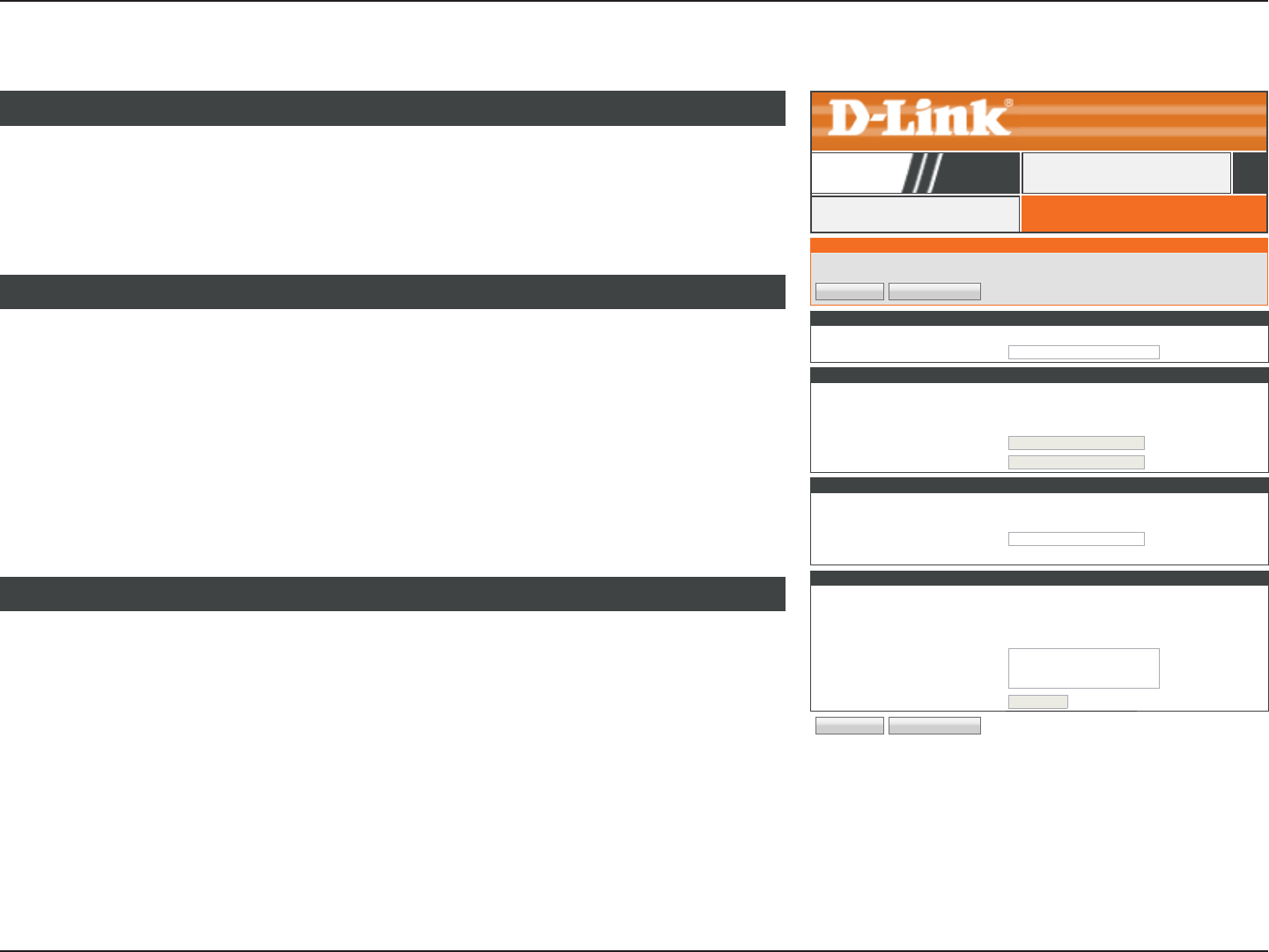
66D-Link DIR-819 User Manual
Section 3 - Conguration
Autoconguration(SLAAC/DHCPv6)
IPV6 CONNECTION TYPE
Choose the mode to be used by the router to connect to the IPv6 Internet.
My IPv6 Connection is: Autoconguration(SLAAC/DHCPv6) ▼
ADDRESS AUTOCONFIGURATION SETTINGS
Use this section to setup IPv6 Autoconguration to assign IP addresses to the computers on your network. You can also enable DHCP-PD
to delegate prexes for routers in your LAN.
Enable Automatic IPv6 address assignment : ☑
Enable Automatic DHCP-PD in LAN : ☑
Autoconguration Type : SLAAC+RDNSS ▼
SLAAC+Stateless DHCP
Stateful DHCPv6
Router Advertisement Lifetime : (minutes)
IPV6 DNS SETTINGS
Obtain DNS server address automatically or enter a specic DNS server address.
Obtain IPv6 DNS Servers automatically
Use the following IPv6 DNS Servers
Primary DNS Address :
Secondary DNS Address :
LAN IPV6 ADDRESS SETTINGS
Use this section to congure the internal network settings of your router. If you change the LAN IPv6 Address here, you may need to
adjust your PC network settings to access the network again.
Enable DHCP-PD : ☑
LAN IPv6 Address : /64
LAN IPv6 Link-Local Address : ffff::fff:ffff:ffff:1234 /64
IPV6 IPV6
DIR-819 SETUP
IPV6
Use this section to congure your IPv6 Connection Type.If you are unsure of your connection method, please contact your Internet
Service Provider.
Save Settings Don’t Save Settings
Select either Obtain DNS server address automatically or Use the following DNS address.
If you choose Use the following DNS address, please congure the following eld:
Primary DNS
Address:
Enter the primary DNS server address.
Secondary DNS
Address:
Enter the secondary DNS server address.
IPV6 DNS SETTINGS
My IPv6
Connection is:
Select Autoconguration(SLAAC/DHCPv6) if your ISP assigns your
IPv6 address when your router requests one from the ISP’s server.
Some ISPs require you to adjust settings on your side before your
router can connect to the IPv6 Internet.
IPV6 CONNECTION TYPE
Enable DHCP-PD: Check this box to enable DHCP-PD.
LAN IPv6 Address: Enter the LAN (local) IPv6 address for the router.
LAN IPv6 Link-
Local Address:
Displays the router’s LAN link-local address.
LAN IPv6 Address Settings
Save Settings Don’t Save Settings
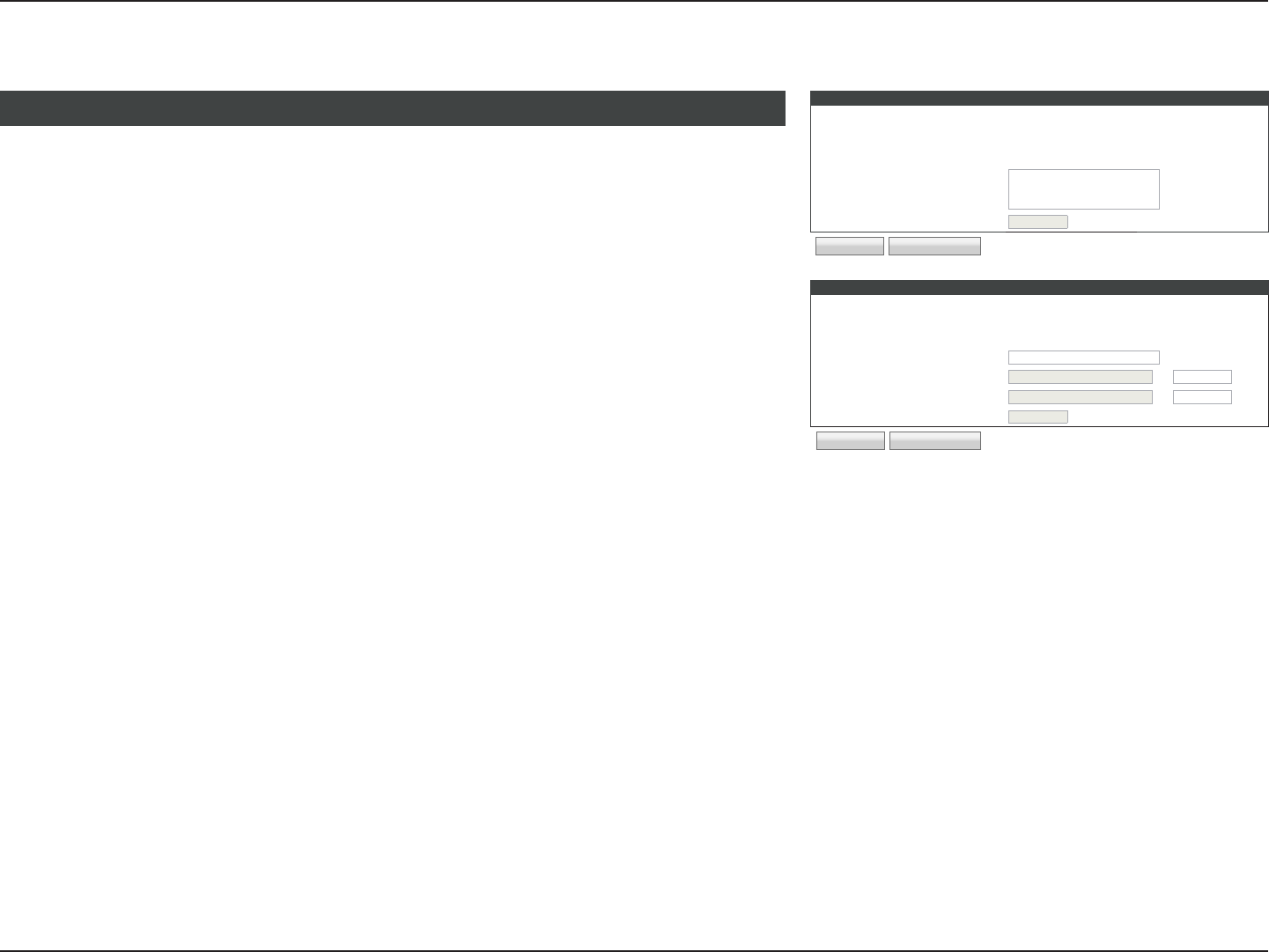
67D-Link DIR-819 User Manual
Section 3 - Conguration
ADDRESS AUTOCONFIGURATION SETTINGS
Use this section to setup IPv6 Autoconguration to assign IP addresses to the computers on your network. You can also enable DHCP-PD
to delegate prexes for routers in your LAN.
Enable Automatic IPv6 address assignment : ☑
Enable Automatic DHCP-PD in LAN : ☑
Autoconguration Type : Stateful DHCPv6 ▼
IPv6 Address Range (Start) : :00 1
IPv6 Address Range (End) : :00 ff
Router Advertisement Lifetime : (minutes)
Save Settings Don’t Save Settings
Enable Automatic
IPv6 address
assignment:
Enable or disable the Automatic IPv6 Address Assignment feature. If
you disable this option, no further conguration is available.
Enable Automatic
DHCP-PD in LAN:
Enable or disable the Automatic IPv6 Address Assignment feature
for the LAN.
Autoconfiguration
Type:
Select SLAAC+RDNSS, SLAAC+Stateless DHCP, or Stateful DHCPv6.
If you choose SLAAC+Stateless DHCP, the following eld appears:
Router
Advertisement
Lifetime:
The currently dened router advertisement lifetime is displayed.
If you choose Stateful DHCPv6, please congure the following elds:
IPv6 Address
Range(Start):
Enter the starting IPv6 address for the DHCP server’s IPv6 assignment.
IPv6 Address
Range(End):
Enter the ending IPv6 address for the DHCP server’s IPv6 assignment.
Router
Advertisement
Lifetime:
The currently dened router advertisement lifetime is displayed.
When you have nished conguring your IPv6 connection, click the Save Settings button.
Address Autoconfiguration Settings ADDRESS AUTOCONFIGURATION SETTINGS
Use this section to setup IPv6 Autoconguration to assign IP addresses to the computers on your network. You can also enable DHCP-PD
to delegate prexes for routers in your LAN.
Enable Automatic IPv6 address assignment : ☑
Enable Automatic DHCP-PD in LAN : ☑
Autoconguration Type : SLAAC+RDNSS ▼
SLAAC+Stateless DHCP
Stateful DHCPv6
Router Advertisement Lifetime : (minutes)
Save Settings Don’t Save Settings
Autoconguration(SLAAC/DHCPv6) (continued)
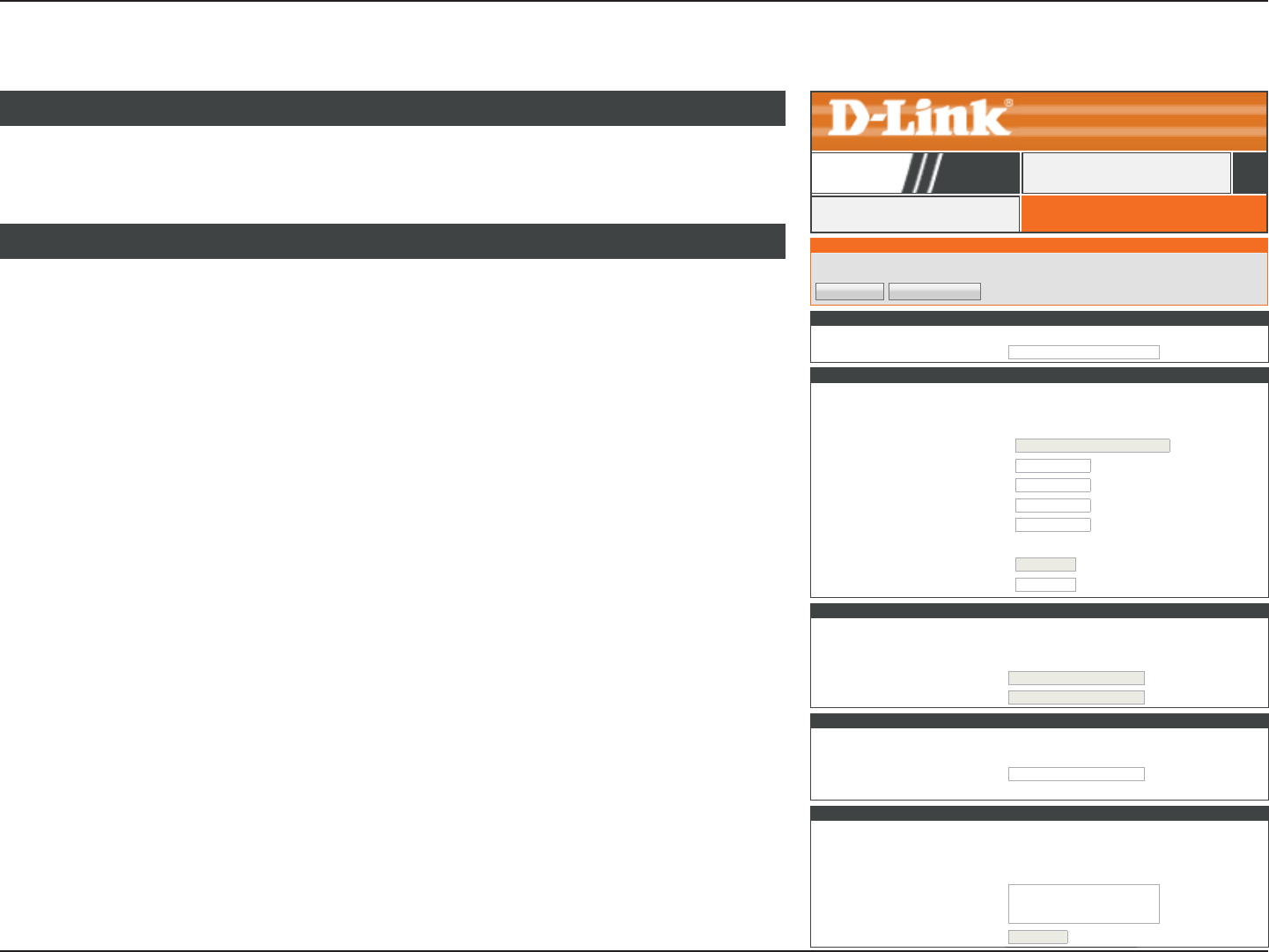
68D-Link DIR-819 User Manual
Section 3 - Conguration
IPV6 CONNECTION TYPE
Choose the mode to be used by the router to connect to the IPv6 Internet.
My IPv6 Connection is: PPPoE ▼
IPV6 IPV6
DIR-819 SETUP
IPV6
Use this section to congure your IPv6 Connection Type.If you are unsure of your connection method, please contact your Internet
Service Provider.
Save Settings Don’t Save Settings
PPPoE
PPPOE INTERNET CONNECTION TYPE :
Enter the information provided by your Internet Service Provider (ISP).
PPPoE Session : Share with IPv4 Create a new session
Address Mode : Dynamic IP Static IP
IP Address :
User Name :
Password :
Verify Password :
Service Name : (optional)
Reconnect Mode : Always on On Demand Manual
Maximum Idle Time : (minutes, 0=innite)
MTU : 1492 (byes) MTU default=1492
IPV6 DNS SETTINGS
Obtain DNS server address automatically or enter a specic DNS server address.
Obtain IPv6 DNS Servers automatically
Use the following IPv6 DNS Servers
Primary DNS Address :
Secondary DNS Address :
ADDRESS AUTOCONFIGURATION SETTINGS
Use this section to setup IPv6 Autoconguration to assign IP addresses to the computers on your network. You can also enable DHCP-PD
to delegate prexes for routers in your LAN.
Enable Automatic IPv6 address assignment : ☑
Enable Automatic DHCP-PD in LAN : ☑
Autoconguration Type : SLAAC+RDNSS ▼
SLAAC+Stateless DHCP
Stateful DHCPv6
Router Advertisement Lifetime : (minutes)
LAN IPV6 ADDRESS SETTINGS
Use this section to congure the internal network settings of your router. If you change the LAN IPv6 Address here, you may need to
adjust your PC network settings to access the network again.
Enable DHCP-PD : ☑
LAN IPv6 Address : /64
LAN IPv6 Link-Local Address : ffff::fff:ffff:ffff:1234 /64
My IPv6
Connection is:
Select PPPoE if your ISP provides and requires you to enter a PPPoE
username and password in order to connect to the Internet.
IPV6 CONNECTION TYPE
PPPoE Session : Select whethe to Share with IPv4 or Create a new session.
Address Mode: Select either Dynamic IP or Static IP.
If you chose Share with IPv4 as the PPPoE Session with Static IP as the Address Mode,
enter your IP address:
IP Address: Enter the IP address provided by your ISP.
If you choose Create a new session as the PPPoE Session, ll in the following elds:
Username: Enter the username provided by your ISP.
Password: Enter the password provided by your ISP.
Verify Password: Enter the password provided by your ISP one more time.
Service Name: Enter the ISP service name (optional).
Reconnect Mode: Select either AlwaysOn or Manual.
Maximum Idle
Time:
Set the length of time to wait before disconnecting if there is no
Internet activity. (Manual Only)
MTU Size: Enter the MTU size.
PPPOE INTERNET CONNECTION TYPE :

69D-Link DIR-819 User Manual
Section 3 - Conguration
Select either Obtain DNS server address automatically or Use the following DNS address.
If you choose Use the following DNS address, please congure the following eld:
Primary DNS
Address:
Enter the primary DNS server address.
Secondary DNS
Address:
Enter the secondary DNS server address.
IPV6 DNS SETTINGS
If you chose Dynamic IP as the Address Mode, you have the option to enable DHCP-PD
appears:
Enable DHCP-PD: Check this box to enable DHCP-PD.
If you chose Static IP as the Address Mode, or disabled DHCP-PD, enter your LAN IPv6
Address:
LAN IPv6 Address: Enter the LAN (local) IPv6 address for the router.
LAN IPv6 Link-
Local Address:
Displays the router’s LAN link-local address.
LAN IPv6 Address Settings
PPPoE (continued)
IPV6 DNS SETTINGS
Obtain DNS server address automatically or enter a specic DNS server address.
Obtain IPv6 DNS Servers automatically
Use the following IPv6 DNS Servers
Primary DNS Address :
Secondary DNS Address :
ADDRESS AUTOCONFIGURATION SETTINGS
Use this section to setup IPv6 Autoconguration to assign IP addresses to the computers on your network. You can also enable DHCP-PD
to delegate prexes for routers in your LAN.
Enable Automatic IPv6 address assignment : ☑
Enable Automatic DHCP-PD in LAN : ☑
Autoconguration Type : SLAAC+RDNSS ▼
SLAAC+Stateless DHCP
Stateful DHCPv6
Router Advertisement Lifetime : (minutes)
LAN IPV6 ADDRESS SETTINGS
Use this section to congure the internal network settings of your router. If you change the LAN IPv6 Address here, you may need to
adjust your PC network settings to access the network again.
Enable DHCP-PD : ☑
LAN IPv6 Address : /64
LAN IPv6 Link-Local Address : ffff::fff:ffff:ffff:1234 /64
Save Settings Don’t Save Settings
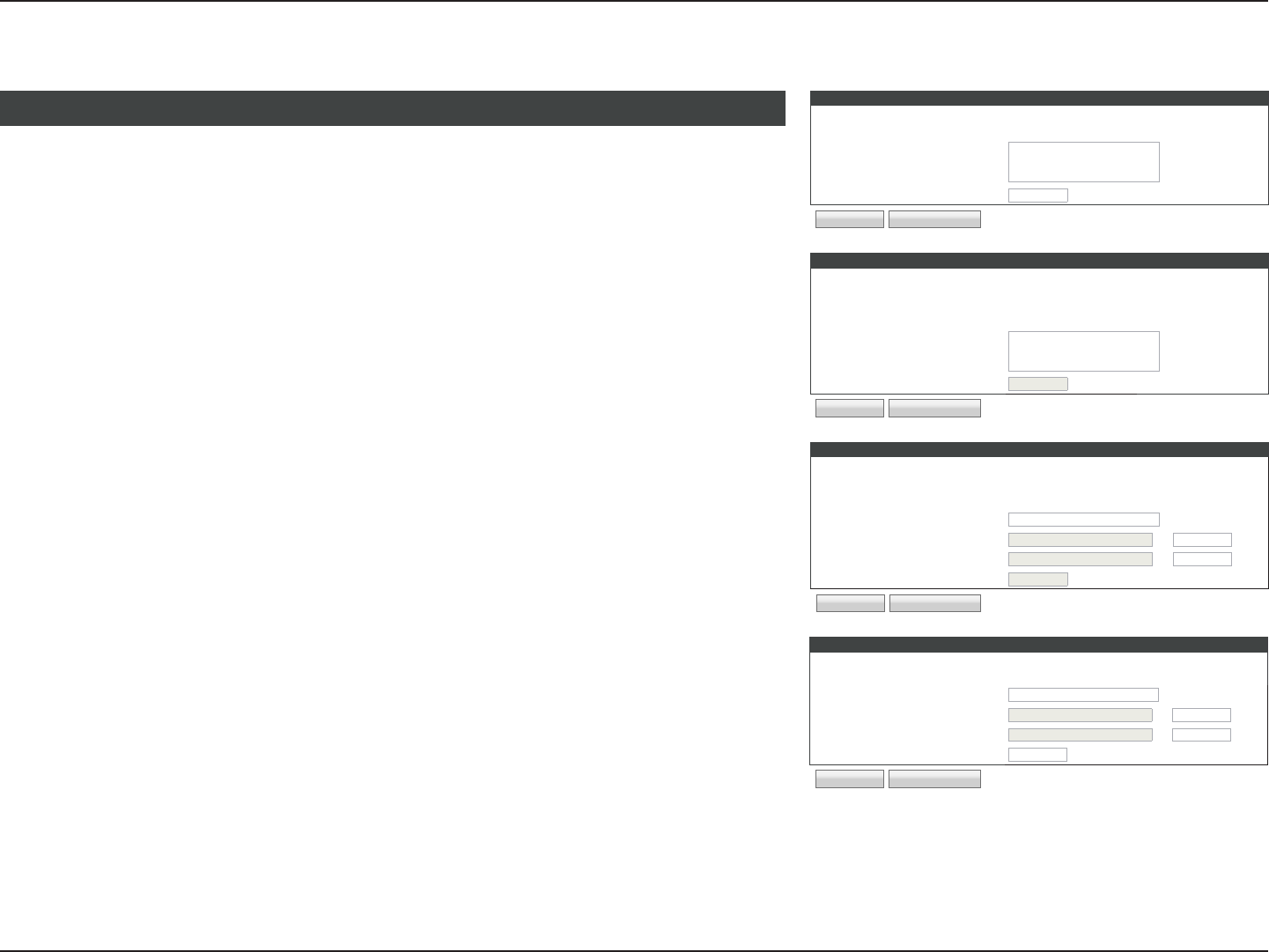
70D-Link DIR-819 User Manual
Section 3 - Conguration
ADDRESS AUTOCONFIGURATION SETTINGS
Use this section to setup IPv6 Autoconguration to assign IP addresses to the computers on your network. You can also enable DHCP-PD
to delegate prexes for routers in your LAN.
Enable Automatic IPv6 address assignment : ☑
Enable Automatic DHCP-PD in LAN : ☑
Autoconguration Type : Stateful DHCPv6 ▼
IPv6 Address Range (Start) : :00 1
IPv6 Address Range (End) : :00 ff
Router Advertisement Lifetime : (minutes)
Save Settings Don’t Save Settings
Enable Automatic
IPv6 address
assignment:
Enable or disable the Automatic IPv6 Address Assignment feature. If
you disable this option, no further conguration is available.
If you chose Dynamic IP as the Address Mode and enabled DHCP-PD in LAN IPv6 Address
Settings, you may enable DHCP-PD for the LAN:
Enable Automatic
DHCP-PD in LAN:
Enable or disable the Automatic IPv6 Address Assignment feature
for the LAN.
Autoconfiguration
Type:
Select SLAAC+RDNSS, SLAAC+Stateless DHCP, or Stateful DHCPv6.
If you choose SLAAC+Stateless DHCP, the following eld appears:
Router
Advertisement
Lifetime:
The currently dened router advertisement lifetime is displayed.
If you choose Stateful DHCPv6, please congure the following elds:
IPv6 Address
Range(Start):
Enter the starting IPv6 address for the DHCP server’s IPv6 assignment.
IPv6 Address
Range(End):
Enter the ending IPv6 address for the DHCP server’s IPv6 assignment.
Router
Advertisement
Lifetime:
The currently dened router advertisement lifetime is displayed.
When you have nished conguring your IPv6 connection, click the Save Settings button.
Address Autoconfiguration Settings
ADDRESS AUTOCONFIGURATION SETTINGS
Use this section to setup IPv6 Autoconguration to assign IP addresses to the computers on your network. You can also enable DHCP-PD
to delegate prexes for routers in your LAN.
Enable Automatic IPv6 address assignment : ☑
Enable Automatic DHCP-PD in LAN : ☑
Autoconguration Type : SLAAC+RDNSS ▼
SLAAC+Stateless DHCP
Stateful DHCPv6
Router Advertisement Lifetime : (minutes)
Save Settings Don’t Save Settings
PPPoE (continued)
ADDRESS AUTOCONFIGURATION SETTINGS
Use this section to setup IPv6 Autoconguration to assign IP addresses to the computers on your network.
Enable Automatic IPv6 address assignment : ☑
Autoconguration Type : Stateful DHCPv6 ▼
IPv6 Address Range (Start) : :00 1
IPv6 Address Range (End) : :00 ff
Router Advertisement LIfetime : (minutes)
Save Settings Don’t Save Settings
ADDRESS AUTOCONFIGURATION SETTINGS
Use this section to setup IPv6 Autoconguration to assign IP addresses to the computers on your network.
Enable Automatic IPv6 address assignment : ☑
Autoconguration Type : SLAAC+RDNSS ▼
SLAAC+Stateless DHCP
Stateful DHCPv6
Router Advertisement LIfetime : (minutes)
Save Settings Don’t Save Settings
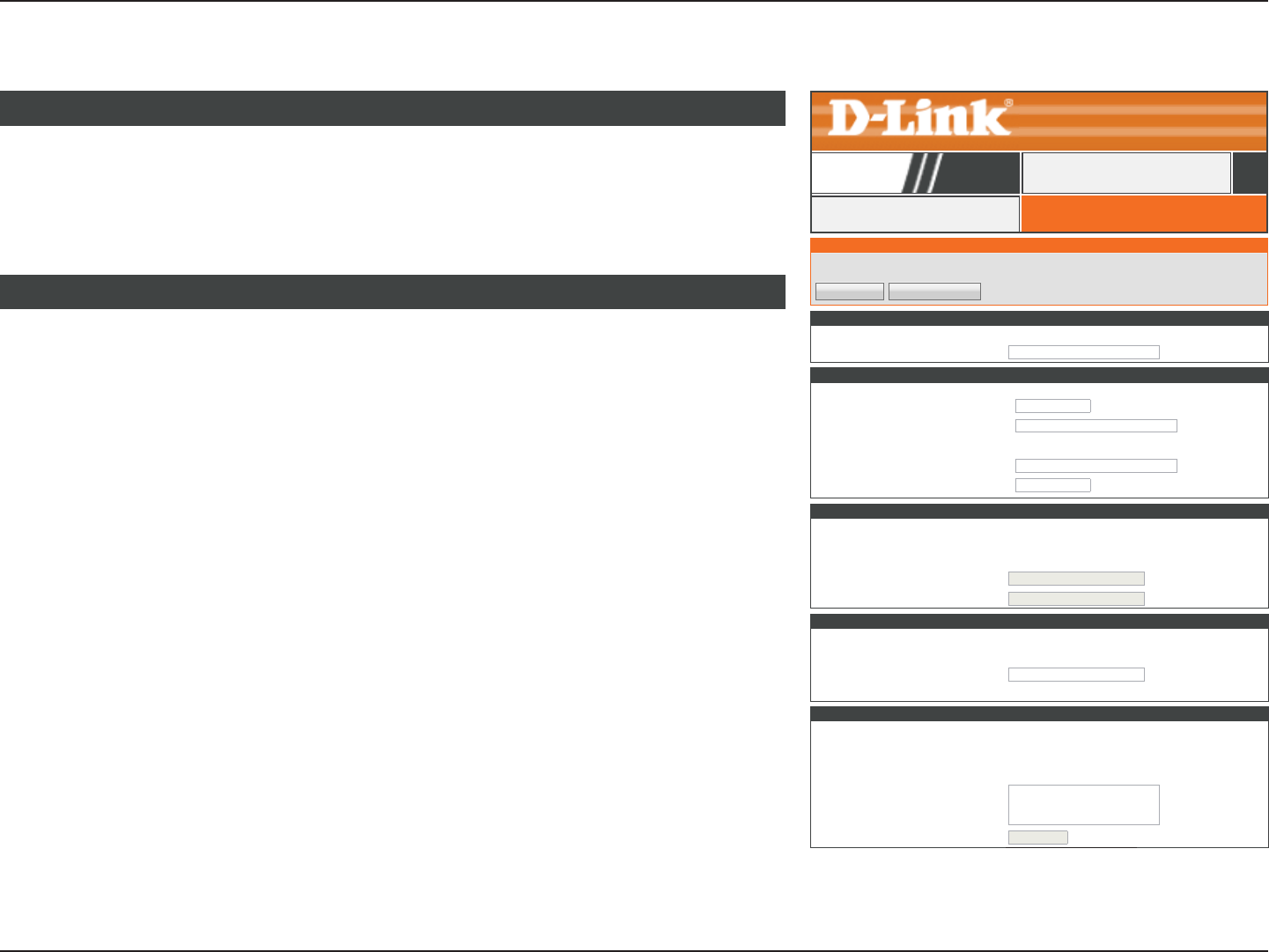
71D-Link DIR-819 User Manual
Section 3 - Conguration
IPv6 in an IPv4 Tunnel
IPV6 CONNECTION TYPE
Choose the mode to be used by the router to connect to the IPv6 Internet.
My IPv6 Connection is: IPv6 in IPv4 Tunnel ▼
IPV6 IPV6
DIR-819 SETUP
IPV6
Use this section to congure your IPv6 Connection Type.If you are unsure of your connection method, please contact your Internet
Service Provider.
Save Settings Don’t Save Settings
IPV6 IN IPV4 TUNNEL SETTINGS
Enter the information provided by your Internet Service Provider (ISP).
Remote IPv4 Address :
Remote IPv6 Address :
Local IPv4 Address :
Local IPv6 Address :
Subnet Prex Length :
IPV6 DNS SETTINGS
Obtain DNS server address automatically or enter a specic DNS server address.
Obtain IPv6 DNS Servers automatically
Use the following IPv6 DNS Servers
Primary DNS Address :
Secondary DNS Address :
ADDRESS AUTOCONFIGURATION SETTINGS
Use this section to setup IPv6 Autoconguration to assign IP addresses to the computers on your network. You can also enable DHCP-PD
to delegate prexes for routers in your LAN.
Enable Automatic IPv6 address assignment : ☑
Enable Automatic DHCP-PD in LAN : ☑
Autoconguration Type : SLAAC+RDNSS ▼
SLAAC+Stateless DHCP
Stateful DHCPv6
Router Advertisement Lifetime : (minutes)
LAN IPV6 ADDRESS SETTINGS
Use this section to congure the internal network settings of your router. If you change the LAN IPv6 Address here, you may need to
adjust your PC network settings to access the network again.
Enable DHCP-PD : ☑
LAN IPv6 Address : /64
LAN IPv6 Link-Local Address : ffff::fff:ffff:ffff:1234 /64
My IPv6
Connection is:
Select IPv6 In IPv4 Tunnel if you wish to congure the IPv6 connection
to run in IPv4 Tunnel mode. IPv6 over IPv4 tunnelling encapsulates
IPv6 packets in IPv4 packets so that IPv6 packets can be sent over an
IPv4 infrastructure.
IPV6 CONNECTION TYPE
Remote IPv4
Address:
Enter the IPv4 remote address.
Remote IPv6
Address:
Enter the IPv6 remote address.
Local IPv4
Address:
Displays the current local IPv4 address.
Local IPv6
Address:
Enter the IPv6 local address.
Subnet Prefix
Length:
Enter the IPv6 subnet prex length.
IPv6 in IPv4 Tunnel Settings

72D-Link DIR-819 User Manual
Section 3 - Conguration
Select either Obtain DNS server address automatically or Use the following DNS address.
If you choose Use the following DNS address, please congure the following eld:
Primary DNS
Address:
Enter the primary DNS server address.
Secondary DNS
Address:
Enter the secondary DNS server address.
IPV6 DNS SETTINGS
Enable DHCP-PD: Check this box to enable DHCP-PD.
LAN IPv6 Address: Enter the LAN (local) IPv6 address for the router. Not available if
DHCP-PD is enabled.
LAN IPv6 Link-
Local Address:
Displays the router’s LAN link-local address.
LAN IPv6 Address Settings
IPv6 in and IPv4 Tunnel (continued)
IPV6 DNS SETTINGS
Obtain DNS server address automatically or enter a specic DNS server address.
Obtain IPv6 DNS Servers automatically
Use the following IPv6 DNS Servers
Primary DNS Address :
Secondary DNS Address :
ADDRESS AUTOCONFIGURATION SETTINGS
Use this section to setup IPv6 Autoconguration to assign IP addresses to the computers on your network. You can also enable DHCP-PD
to delegate prexes for routers in your LAN.
Enable Automatic IPv6 address assignment : ☑
Enable Automatic DHCP-PD in LAN : ☑
Autoconguration Type : SLAAC+RDNSS ▼
SLAAC+Stateless DHCP
Stateful DHCPv6
Router Advertisement Lifetime : (minutes)
LAN IPV6 ADDRESS SETTINGS
Use this section to congure the internal network settings of your router. If you change the LAN IPv6 Address here, you may need to
adjust your PC network settings to access the network again.
Enable DHCP-PD : ☑
LAN IPv6 Address : /64
LAN IPv6 Link-Local Address : ffff::fff:ffff:ffff:1234 /64
Save Settings Don’t Save Settings
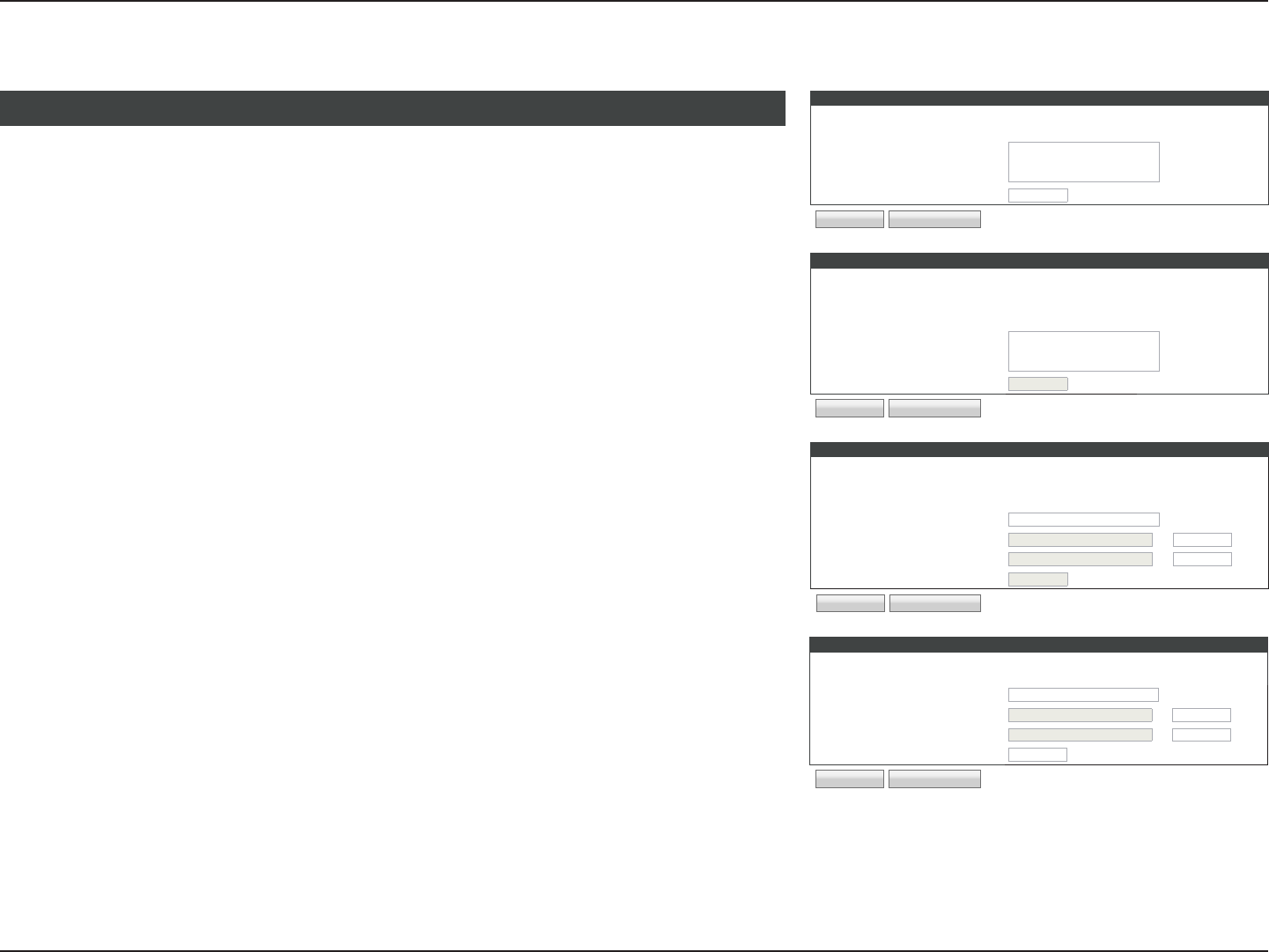
73D-Link DIR-819 User Manual
Section 3 - Conguration
IPv6 in an IPv4 Tunnel (continued)
ADDRESS AUTOCONFIGURATION SETTINGS
Use this section to setup IPv6 Autoconguration to assign IP addresses to the computers on your network. You can also enable DHCP-PD
to delegate prexes for routers in your LAN.
Enable Automatic IPv6 address assignment : ☑
Enable Automatic DHCP-PD in LAN : ☑
Autoconguration Type : Stateful DHCPv6 ▼
IPv6 Address Range (Start) : :00 1
IPv6 Address Range (End) : :00 ff
Router Advertisement Lifetime : (minutes)
Save Settings Don’t Save Settings
Enable Automatic
IPv6 address
assignment:
Enable or disable the Automatic IPv6 Address Assignment feature. If
you disable this option, no further conguration is available.
If you enabled DHCP-PD in LAN IPv6 Address Settings, you may enable DHCP-PD for the
LAN:
Enable Automatic
DHCP-PD in LAN:
Enable or disable the Automatic IPv6 Address Assignment feature
for the LAN.
Autoconfiguration
Type:
Select SLAAC+RDNSS, SLAAC+Stateless DHCP, or Stateful DHCPv6.
If you choose SLAAC+Stateless DHCP, the following eld appears:
Router
Advertisement
Lifetime:
The currently dened router advertisement lifetime is displayed.
If you choose Stateful DHCPv6, please congure the following elds:
IPv6 Address
Range(Start):
Enter the starting IPv6 address for the DHCP server’s IPv6 assignment.
IPv6 Address
Range(End):
Enter the ending IPv6 address for the DHCP server’s IPv6 assignment.
Router
Advertisement
Lifetime:
The currently dened router advertisement lifetime is displayed.
Address Autoconfiguration Settings
ADDRESS AUTOCONFIGURATION SETTINGS
Use this section to setup IPv6 Autoconguration to assign IP addresses to the computers on your network. You can also enable DHCP-PD
to delegate prexes for routers in your LAN.
Enable Automatic IPv6 address assignment : ☑
Enable Automatic DHCP-PD in LAN : ☑
Autoconguration Type : SLAAC+RDNSS ▼
SLAAC+Stateless DHCP
Stateful DHCPv6
Router Advertisement Lifetime : (minutes)
Save Settings Don’t Save Settings
When you have nished conguring your IPv6 connection, click the Save Settings button.
ADDRESS AUTOCONFIGURATION SETTINGS
Use this section to setup IPv6 Autoconguration to assign IP addresses to the computers on your network.
Enable Automatic IPv6 address assignment : ☑
Autoconguration Type : Stateful DHCPv6 ▼
IPv6 Address Range (Start) : :00 1
IPv6 Address Range (End) : :00 ff
Router Advertisement LIfetime : (minutes)
Save Settings Don’t Save Settings
ADDRESS AUTOCONFIGURATION SETTINGS
Use this section to setup IPv6 Autoconguration to assign IP addresses to the computers on your network.
Enable Automatic IPv6 address assignment : ☑
Autoconguration Type : SLAAC+RDNSS ▼
SLAAC+Stateless DHCP
Stateful DHCPv6
Router Advertisement LIfetime : (minutes)
Save Settings Don’t Save Settings
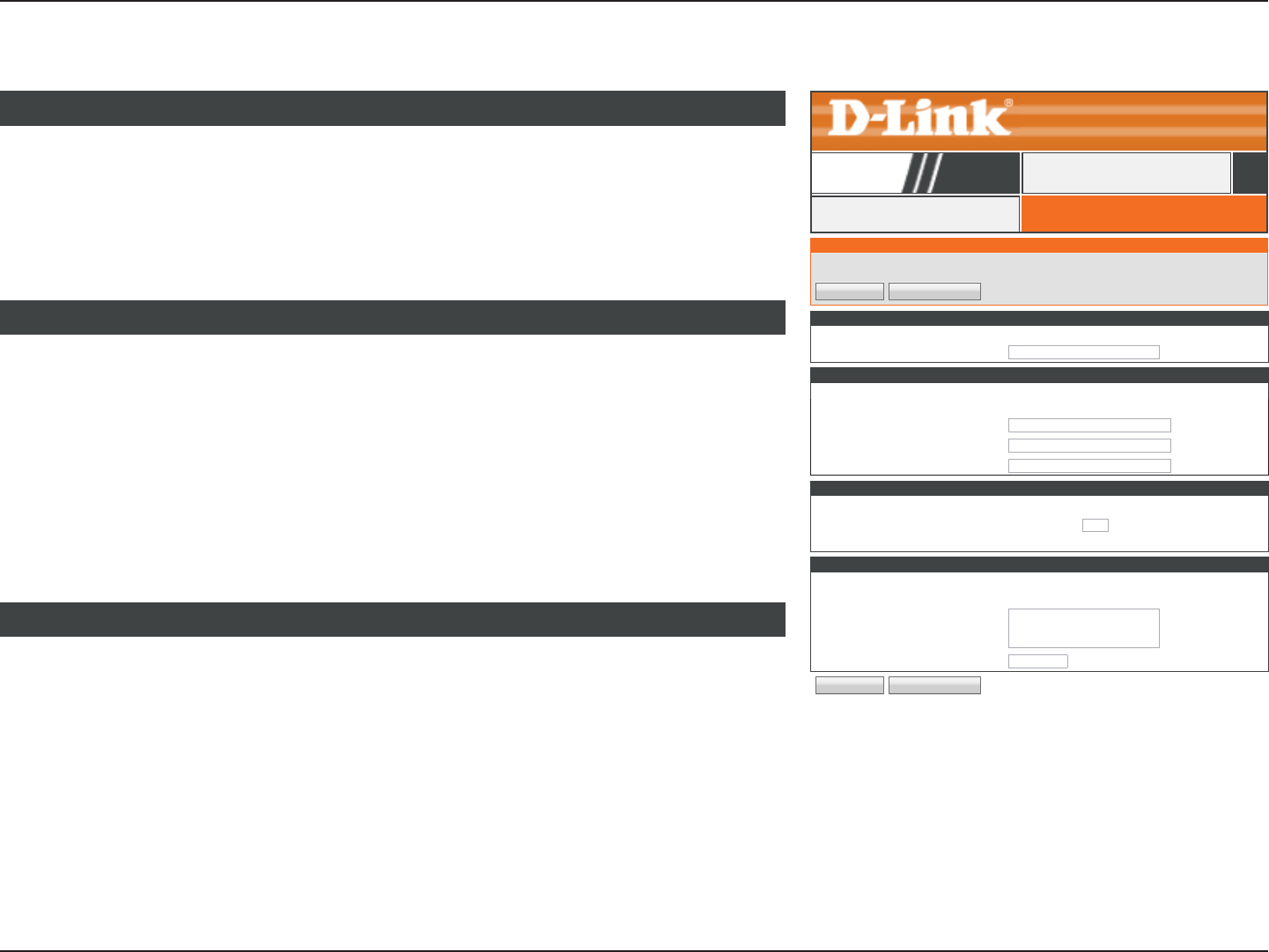
74D-Link DIR-819 User Manual
Section 3 - Conguration
6to4
IPV6 CONNECTION TYPE
Choose the mode to be used by the router to connect to the IPv6 Internet.
My IPv6 Connection is: 6to4 ▼
IPV6 IPV6
DIR-819 SETUP
IPV6
Use this section to congure your IPv6 Connection Type.If you are unsure of your connection method, please contact your Internet
Service Provider.
Save Settings Don’t Save Settings
WAN IPV6 ADDRESS SETTINGS
Enter the IPv6 address information provided by your Internet Service Provider (ISP).
6to4 Address :
6to4 relay :
Primary DNS Address :
Secondary DNS Address :
LAN IPV6 ADDRESS SETTINGS
Use this section to congure the internal network settings of your router. If you change the LAN IPv6 Address here, you may need to
adjust your PC network settings to access the network again.
LAN IPv6 Address : XXXX:XXXX:XXXX: ::1 /64
LAN IPv6 Link-Local Address : ffff::fff:ffff:ffff:1234 /64
My IPv6
Connection is:
Select IPv6 In IPv4 Tunnel if you wish to congure your router to
connect to your ISP using 6 to 4. 6 to 4 is an IPv6 address assignment
and automatic tunneling technology that is used to provide unicast
IPv6 connectivity between IPv6 sites and hosts across the IPv4
Internet.
IPV6 CONNECTION TYPE
ADDRESS AUTOCONFIGURATION SETTINGS
Use this section to setup IPv6 Autoconguration to assign IP addresses to the computers on your network.
Enable Automatic IPv6 address assignment : ☑
Autoconguration Type : SLAAC+RDNSS ▼
SLAAC+Stateless DHCP
Stateful DHCPv6
Router Advertisement Lifetime : (minutes)
Save Settings Don’t Save Settings
6to4 Address: The current 6to4 address is displayed here.
6to4 Relay: Enter the 6 to 4 relay address supplied by your ISP.
Primary DNS
Address:
Enter the primary DNS server address.
Secondary DNS
Address:
Enter the secondary DNS server address.
WAN IPV6 ADDRESS SETTINGS
LAN IPv6 Address: Enter the LAN (local) IPv6 address for the router.
LAN IPv6 Link-
Local Address:
Displays the router’s LAN link-local address.
LAN IPv6 Address Settings
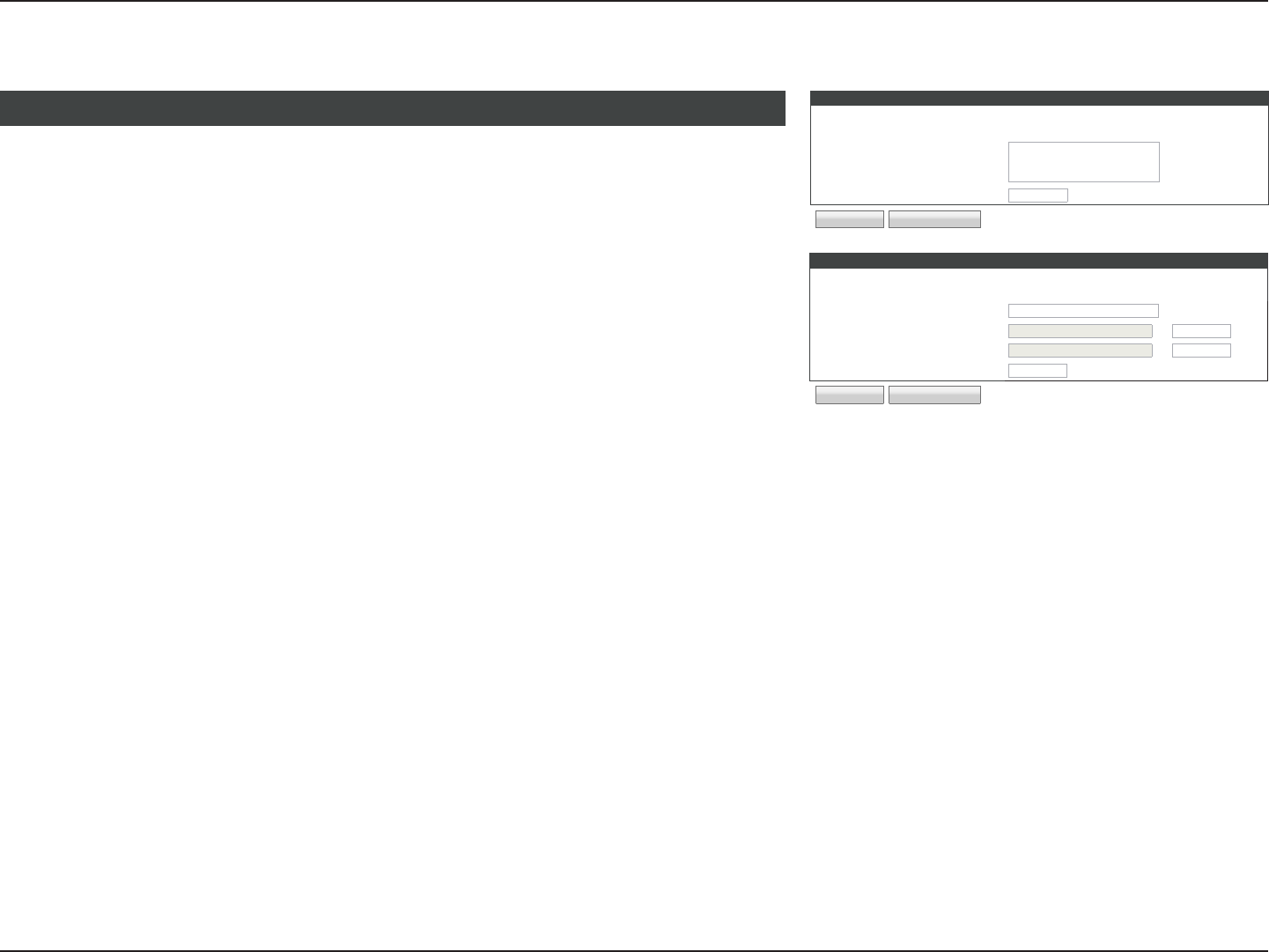
75D-Link DIR-819 User Manual
Section 3 - Conguration
Enable Automatic
IPv6 address
assignment:
Enable or disable the Automatic IPv6 Address Assignment feature. If
you disable this option, no further conguration is available.
Autoconfiguration
Type:
Select SLAAC+RDNSS, SLAAC+Stateless DHCP, or Stateful DHCPv6.
If you choose SLAAC+Stateless DHCP, please congure the following eld:
Router
Advertisement
Lifetime:
Enter the IPv6 address lifetime (in minutes).
If you choose Stateful DHCPv6, please congure the following elds:
IPv6 Address
Range(Start):
Enter the starting IPv6 address for the DHCP server’s IPv6 assignment.
IPv6 Address
Range(End):
Enter the ending IPv6 address for the DHCP server’s IPv6 assignment.
Router
Advertisement
Lifetime:
Enter the IPv6 address lifetime (in seconds).
When you have nished conguring your IPv6 connection, click the Save Settings button.
Address Autoconfiguration Settings
ADDRESS AUTOCONFIGURATION SETTINGS
Use this section to setup IPv6 Autoconguration to assign IP addresses to the computers on your network.
Enable Automatic IPv6 address assignment : ☑
Autoconguration Type : Stateful DHCPv6 ▼
IPv6 Address Range (Start) : :00 1
IPv6 Address Range (End) : :00 ff
Router Advertisement LIfetime : (minutes)
Save Settings Don’t Save Settings
ADDRESS AUTOCONFIGURATION SETTINGS
Use this section to setup IPv6 Autoconguration to assign IP addresses to the computers on your network.
Enable Automatic IPv6 address assignment : ☑
Autoconguration Type : SLAAC+RDNSS ▼
SLAAC+Stateless DHCP
Stateful DHCPv6
Router Advertisement LIfetime : (minutes)
Save Settings Don’t Save Settings
6to4 (continued)
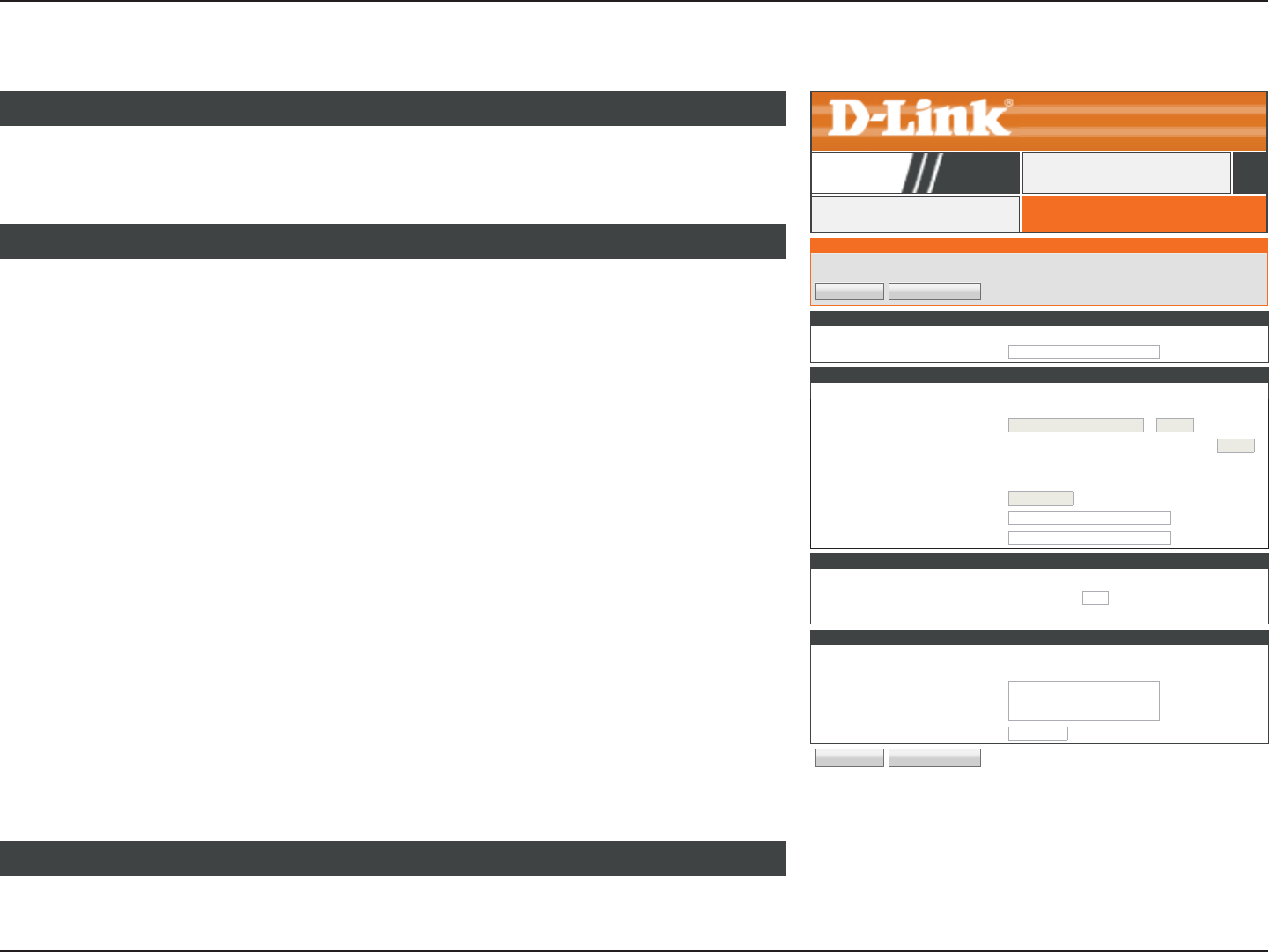
76D-Link DIR-819 User Manual
Section 3 - Conguration
6rd
IPV6 CONNECTION TYPE
Choose the mode to be used by the router to connect to the IPv6 Internet.
My IPv6 Connection is: 6rd ▼
IPV6 IPV6
DIR-819 SETUP
IPV6
Use this section to congure your IPv6 Connection Type.If you are unsure of your connection method, please contact your Internet
Service Provider.
Save Settings Don’t Save Settings
WAN IPV6 ADDRESS SETTINGS
Enter the IPv6 address information provided by your Internet Service Provider (ISP).
6rd Conguration : 6rd DHCPv4 option Manual Conguration
6rd IPv6 Prex : /
IPv4 Address : Mask Length :
Assigned IPv6 Prex :
Tunnel Link-Local Address :
6rd Border Relay IPv4 Address :
Primary DNS Address :
Secondary DNS Address :
LAN IPV6 ADDRESS SETTINGS
Use this section to congure the internal network settings of your router. If you change the LAN IPv6 Address here, you may need to
adjust your PC network settings to access the network again.
LAN IPv6 Address : XXXX:XXXX:XXXX: ::1 /64
LAN IPv6 Link-Local Address : ffff::fff:ffff:ffff:1234 /64
My IPv6
Connection is:
Select 6rd if your ISP uses the 6rd IPv6 connection protocol.
IPV6 CONNECTION TYPE
ADDRESS AUTOCONFIGURATION SETTINGS
Use this section to setup IPv6 Autoconguration to assign IP addresses to the computers on your network.
Enable Automatic IPv6 address assignment : ☑
Autoconguration Type : SLAAC+RDNSS ▼
SLAAC+Stateless DHCP
Stateful DHCPv6
Router Advertisement Lifetime : (minutes)
Save Settings Don’t Save Settings
6rd Configuration: Select either 6rd DHCPv4 or Manual Conguration.
If you selected Manual Conguration, ll in the following elds:
6rd IPv6 Prefix: Enter the 6rd IPv6 prex and mask length supplied by your ISP.
IPv4 Address: Displays the router’s IPv4 address and mask length.
Assigned IPv6
Prefix:
Displays the router’s assigned IPv6 prex.
Tunnel Link-Local
Address:
Displays the tunnel link-local address.
6rd Border Relay
IPv4 Address:
Enter the 6rd border relay IPv4 address settings supplied by your ISP.
Primary DNS
Address:
Enter the primary DNS server address.
Secondary DNS
Address:
Enter the secondary DNS server address.
WAN IPV6 ADDRESS SETTINGS
LAN IPv6 Address: Enter the LAN (local) IPv6 address for the router.
LAN IPV6 ADDRESS SETTINGS
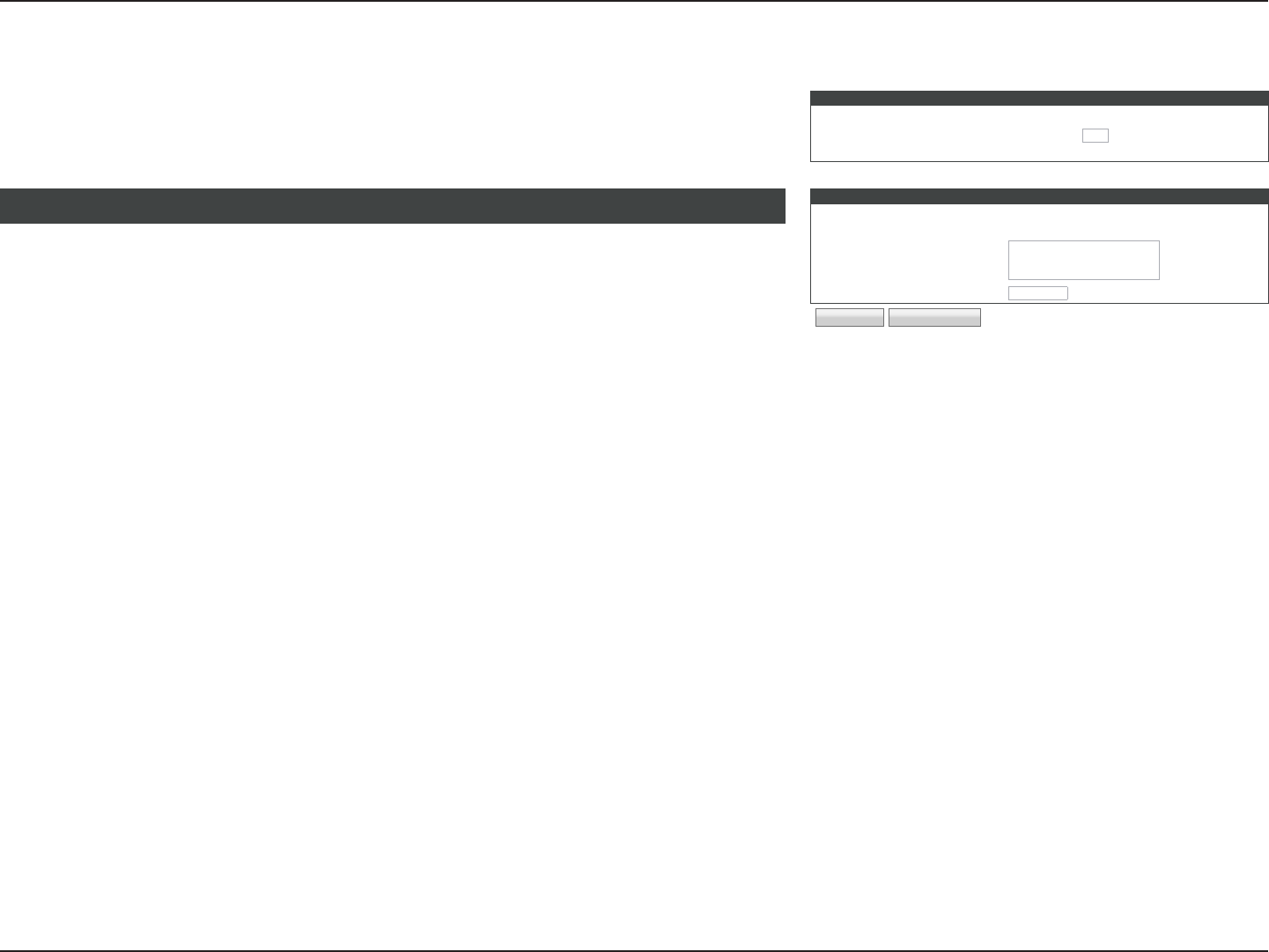
77D-Link DIR-819 User Manual
Section 3 - Conguration
LAN IPV6 ADDRESS SETTINGS
Use this section to congure the internal network settings of your router. If you change the LAN IPv6 Address here, you may need to
adjust your PC network settings to access the network again.
LAN IPv6 Address : XXXX:XXXX:XXXX: ::1 /64
LAN IPv6 Link-Local Address : ffff::fff:ffff:ffff:1234 /64
ADDRESS AUTOCONFIGURATION SETTINGS
Use this section to setup IPv6 Autoconguration to assign IP addresses to the computers on your network.
Enable Automatic IPv6 address assignment : ☑
Autoconguration Type : SLAAC+RDNSS ▼
SLAAC+Stateless DHCP
Stateful DHCPv6
Router Advertisement Lifetime : (minutes)
Enable Automatic
IPv6 address
assignment:
Enable or disable the Automatic IPv6 Address Assignment feature. If
you disable this option, no further conguration is available.
Autoconfiguration
Type:
Select SLAAC+RDNSS, SLAAC+Stateless DHCP, or Stateful DHCPv6.
If you choose SLAAC+Stateless DHCP, please congure the following eld:
Router
Advertisement
Lifetime:
Enter the IPv6 address lifetime (in minutes).
If you choose Stateful DHCPv6, please congure the following elds:
IPv6 Address
Range(Start):
Enter the starting IPv6 address for the DHCP server’s IPv6 assignment.
IPv6 Address
Range(End):
Enter the ending IPv6 address for the DHCP server’s IPv6 assignment.
Router
Advertisement
Lifetime:
Enter the IPv6 address lifetime (in seconds).
When you have nished conguring your IPv6 connection, click the Save Settings button.
Address Autoconfiguration Settings
6rd (continued)
LAN IPv6 Link-
Local Address:
Displays the router’s LAN link-local address.
Save Settings Don’t Save Settings
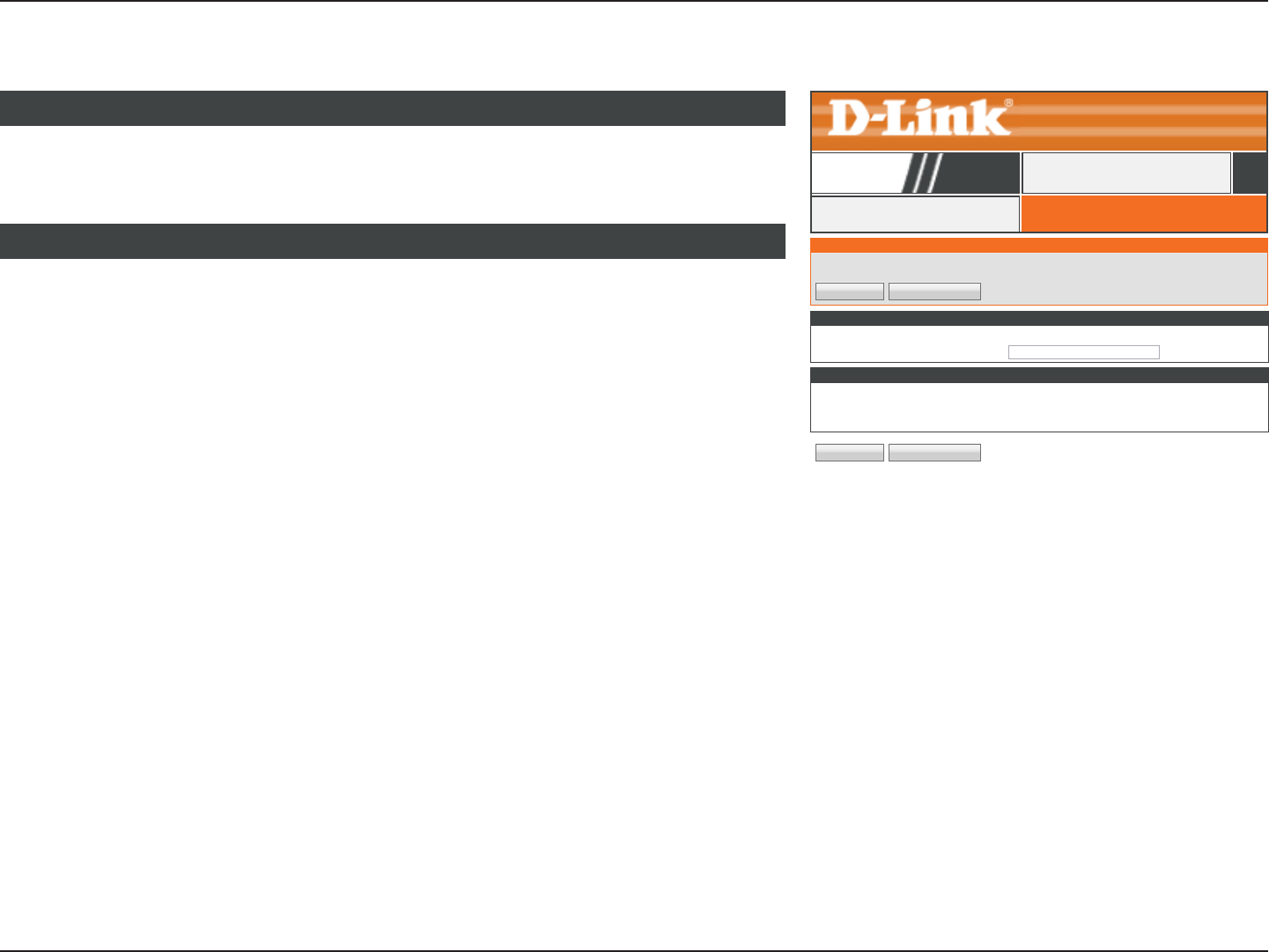
78D-Link DIR-819 User Manual
Section 3 - Conguration
Local Connectivity Only
IPV6 CONNECTION TYPE
Choose the mode to be used by the router to connect to the IPv6 Internet.
My IPv6 Connection is: Local Connectivity Only ▼
IPV6 IPV6
DIR-819 SETUP
IPV6
Use this section to congure your IPv6 Connection Type.If you are unsure of your connection method, please contact your Internet
Service Provider.
Save Settings Don’t Save Settings
LAN IPV6 ADDRESS SETTINGS
Use this section to congure the internal network settings of your router.
LAN IPv6 Link-Local Address : XXXX:XXXX:XXXX:XXXX / 64
LAN IPv6 Unique Local Address : ffff::fff:ffff:ffff:1234 /64
Save Settings Don’t Save Settings
My IPv6
Connection is:
Select Local Connectivity Only allows you to set up a local IPv6
connection that does not connect to the Internet.
IPV6 CONNECTION TYPE
LAN IPv6 Link-
Local Address :
Displays the router’s LAN IPv6 Link-Local address and mask length.
LAN IPv6 Unique
Local Address :
Displays the router’s LAN IPv6 unique local address and mask length.
When you have nished conguring your IPv6 connection, click the Save Settings button.
IPV6 CONNECTION TYPE
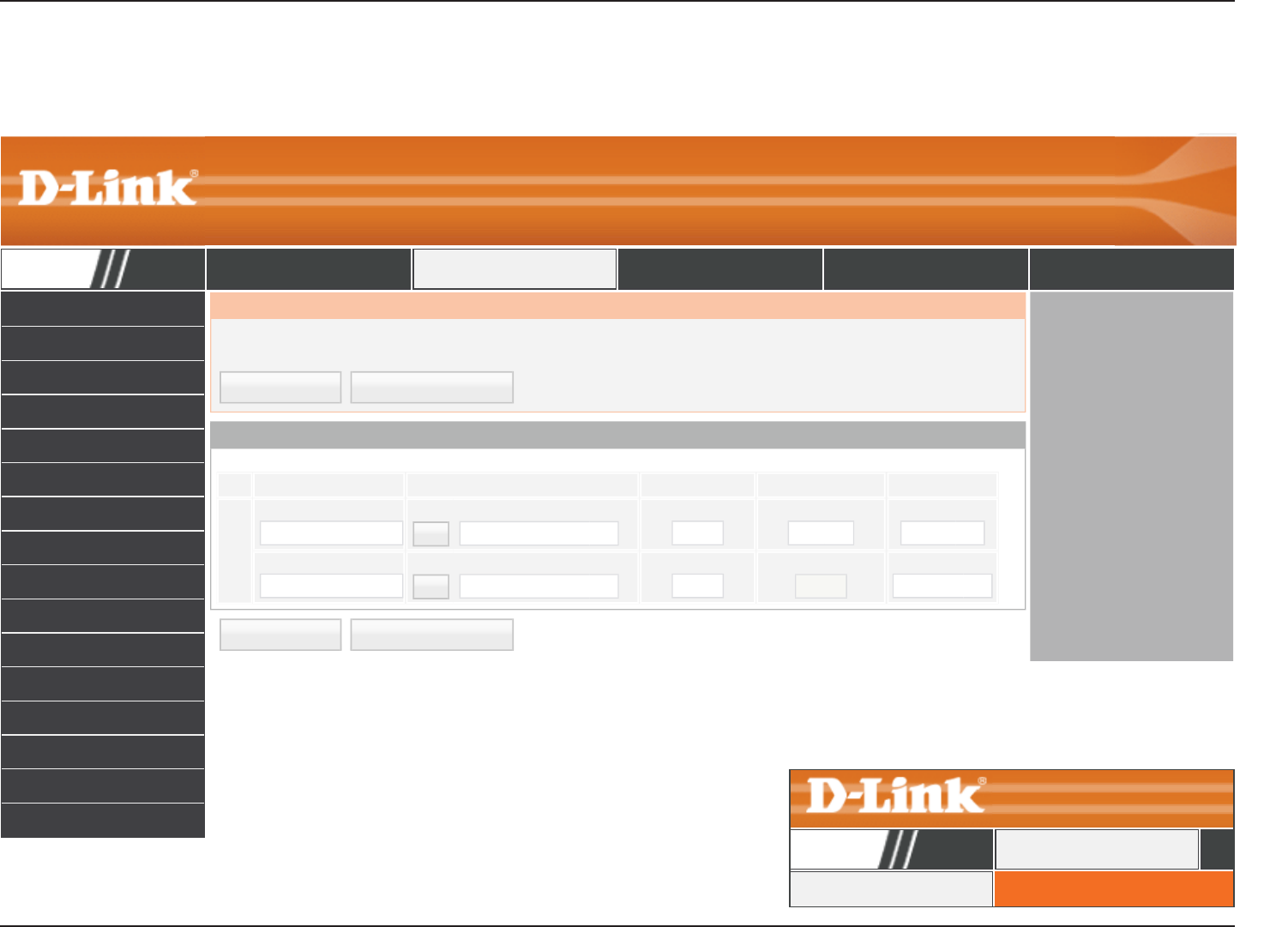
79D-Link DIR-819 User Manual
Section 3 - Conguration
Advanced
VIRTUAL SERVER
PORT FORWARDING
APPLICATION RULES
QOS ENGINE
NETWORK FILTER
INBOUND FILTER
ACCESS CONTROL
WEBSITE FILTER
FIREWALL SETTINGS
ROUTING
ADVANCED WIRELESS
WI-FI PROTECTED SETUP
ADVANCED NETWORK
GUEST ZONE
IPV6 FIREWALL
IPV6 ROUTING
The Advanced tab provides access to congure the advanced features of your DIR-819.
To return to the Web UI Table of Contents page, simply click the D-Link logo on the top right
of each page. INTERNET CONNECTIONINTERNET
DIR-819 SETUP
DIR-819 SETUP ADVANCED TOOLS STATUS SUPPORT
VIRTUAL SERVER
The Virtual Server option allows you to dene a single public port on your router for redirection to an internal LAN IP Address and
Private LAN port if required.This feature is useful for hosting online services such as FTP or Web Servers.
Save Settings Don’t Save Settings
24 - VIRTUAL SERVERS LIST
Remaining number of rules that can be created: 24
Port Trafc Type
☐
Name
<< Application Name ▼
Public Port Protocol
TCP ▼
Schedule
Always ▼
IP Address
<< Computer Name ▼
Private Port
6
Inbound Filter
Allow All ▼
Save Settings Don’t Save Settings
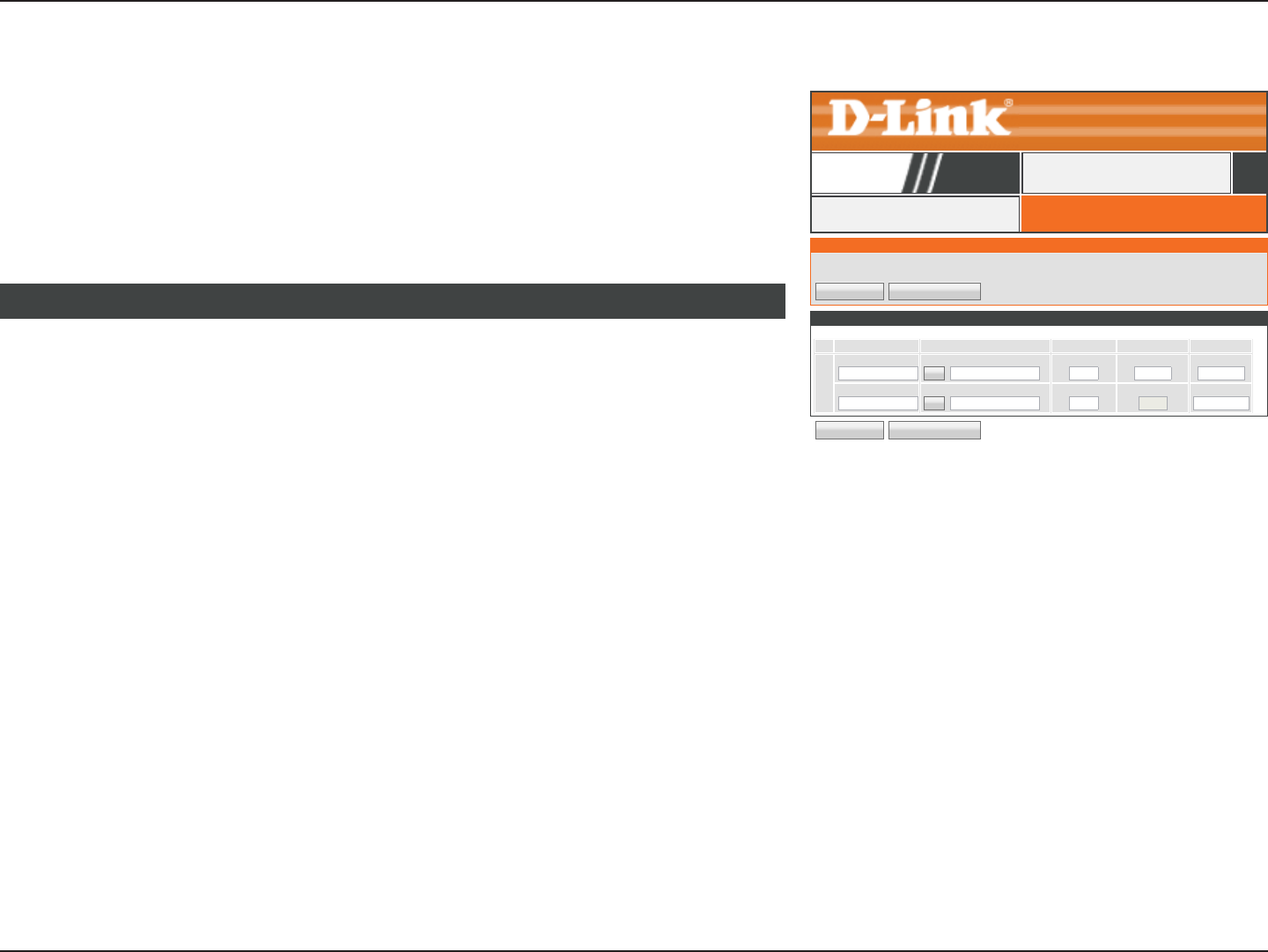
80D-Link DIR-819 User Manual
Section 3 - Conguration
Virtual Server
VIRTUAL SERVERVIRTUAL SERVER
DIR-819 ADVANCED
Enable: Check the box to enable this rule.
Name: Enter a name for the application you wish to apply the virtual server
to. Use the Application Name dropdown menu and the << button to
quickly select commonly used applications. The name, private port,
public port, and protocol type are automatically populated.
Public Port: Enter or adjust the WAN port number in order to remap trac.
Protocol: Select TCP or UDP from the Protocol drop-down menu.
Schedule: Select the schedule from the drop-down menu. The default is Always.
Refer to Schedules on page 110 for more information on creating
new schedules.
IP Address: Enter the IP address of the computer on your local network that you
want to allow the incoming service to or use the Computer Name
dropdown menu and the << button to quickly insert a device’s IP
address.
Private Port: Enter the LAN port number.
Inbound Filter: You may set the trac lter to Allow All or Block All trac.
Click the Save Settings button when you are nished.
24 VIRTUAL SERVERS LIST
VIRTUAL SERVER
The Virtual Server option allows you to dene a single public port on your router for redirection to an internal LAN IP Address and
Private LAN port if required.This feature is useful for hosting online services such as FTP or Web Servers.
Save Settings Don’t Save Settings
24 - VIRTUAL SERVERS LIST
Remaining number of rules that can be created: 24
Port Trafc Type
☐
Name
<< Application Name ▼
Public Port Protocol
TCP ▼
Schedule
Always ▼
IP Address
<< Computer Name ▼
Private Port
6
Inbound Filter
Allow All ▼
Save Settings Don’t Save Settings
Click Virtual Server on the navigation menu to congure the virtual server. The virtual
server performs port-redirection, which allows remote users to access multiple services
on your local network via your public IP address. For example, you may want to connect
two FTP servers on two dierent machines on your local network to the Internet. Using
Port Forwarding only allows a single machine use port 21, but with port forwarding you
can remap two dierent external ports to each machine. When you are satised with your
conguration, click Save Settings.
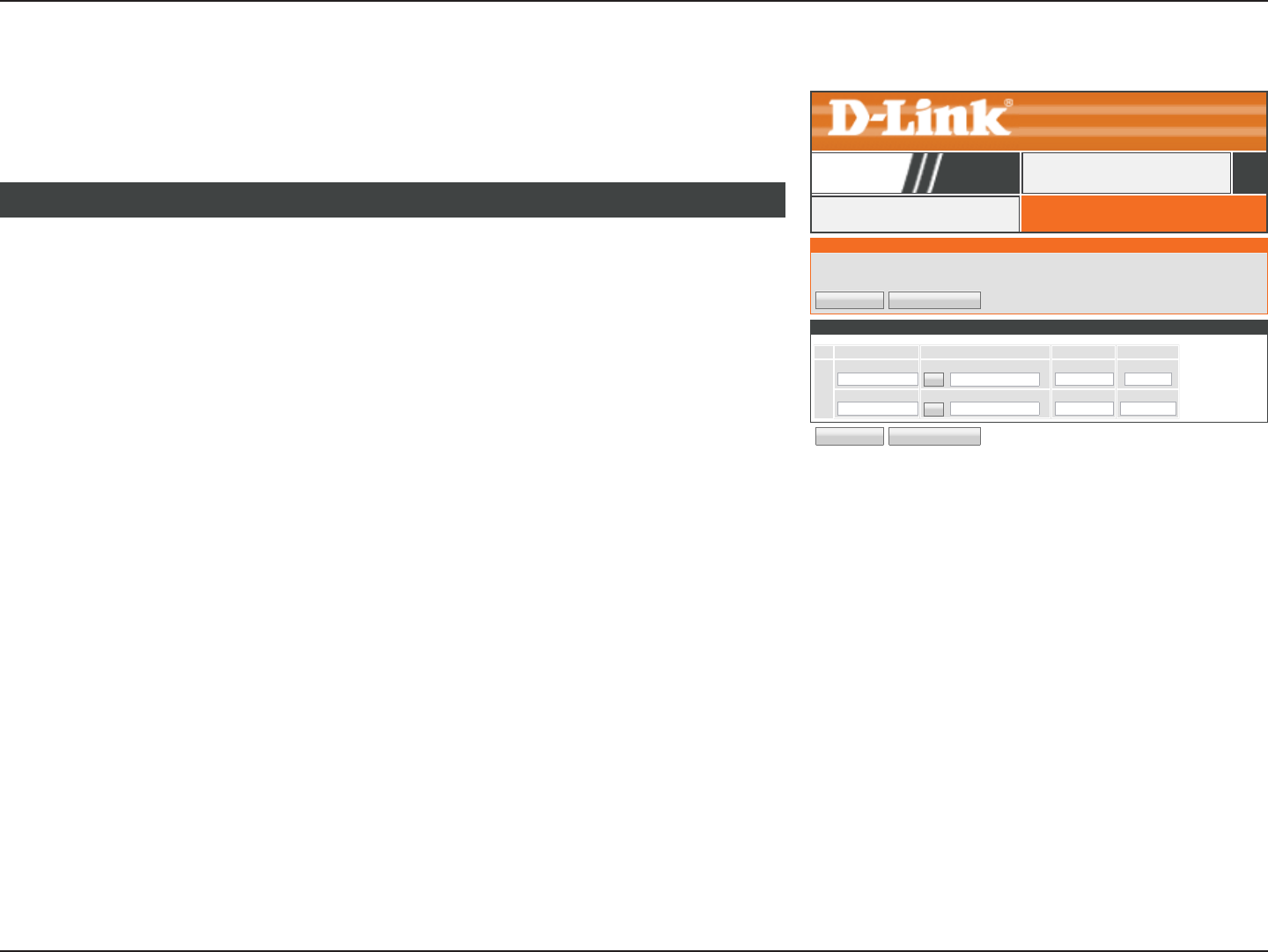
81D-Link DIR-819 User Manual
Section 3 - Conguration
Port Forwarding
PORT FORWARDINGPORT FORWARDING
DIR-819 ADVANCED
PORT FORWARDING
This option is used to open multiple ports or a range of ports in your router and redirect data through those ports to a single PC on
your network. This feature allows you to enter ports in the format, Port Ranges (100-150), Individual Ports (80, 68, 888), or Mixed
(1020-5000, 689). This option is only applicable to the INTERNET session.
Save Settings Don’t Save Settings
24 -- PORT FORWARDING RULES
Remaining number of rules that can be created: 24
Ports to Open
☐
Name
<< Application Name ▼
TCP Schedule
Always ▼
IP Address
<< Computer Name ▼
UDP Inbound Filter
Allow All ▼
Save Settings Don’t Save Settings
Enable: Check the box to enable this rule.
Name: Enter a name for the application you wish to apply the virtual server
to. Use the Application Name dropdown menu and the << button
to quickly select an application. The name, TCP port, and UDP port
are automatically populated.
TCP: Enter the TCP port number to forward.
Schedule: Select the schedule from the drop-down menu. The default is Always.
Refer to Schedules on page 110 for more information on creating
new schedules.
IP Address: Enter the IP address of the computer on your local network that you
want to allow the incoming service to or use the Computer Name
dropdown menu and the << button to quickly insert a device’s IP
address.
UDP: Enter the UDP port number to forward.
Inbound Filter: You may set the trac lter to Allow All or Block All trac.
Click the Save Settings button when you are nished.
24 PORT FORWARDING RULES
Click Port Forwarding on the navigation menu to configure Port Forwarding. Port
Forwarding allows you to expose devices, applications, and servers on your local network
to the Internet. When you are satised with your conguration, click Save Settings.
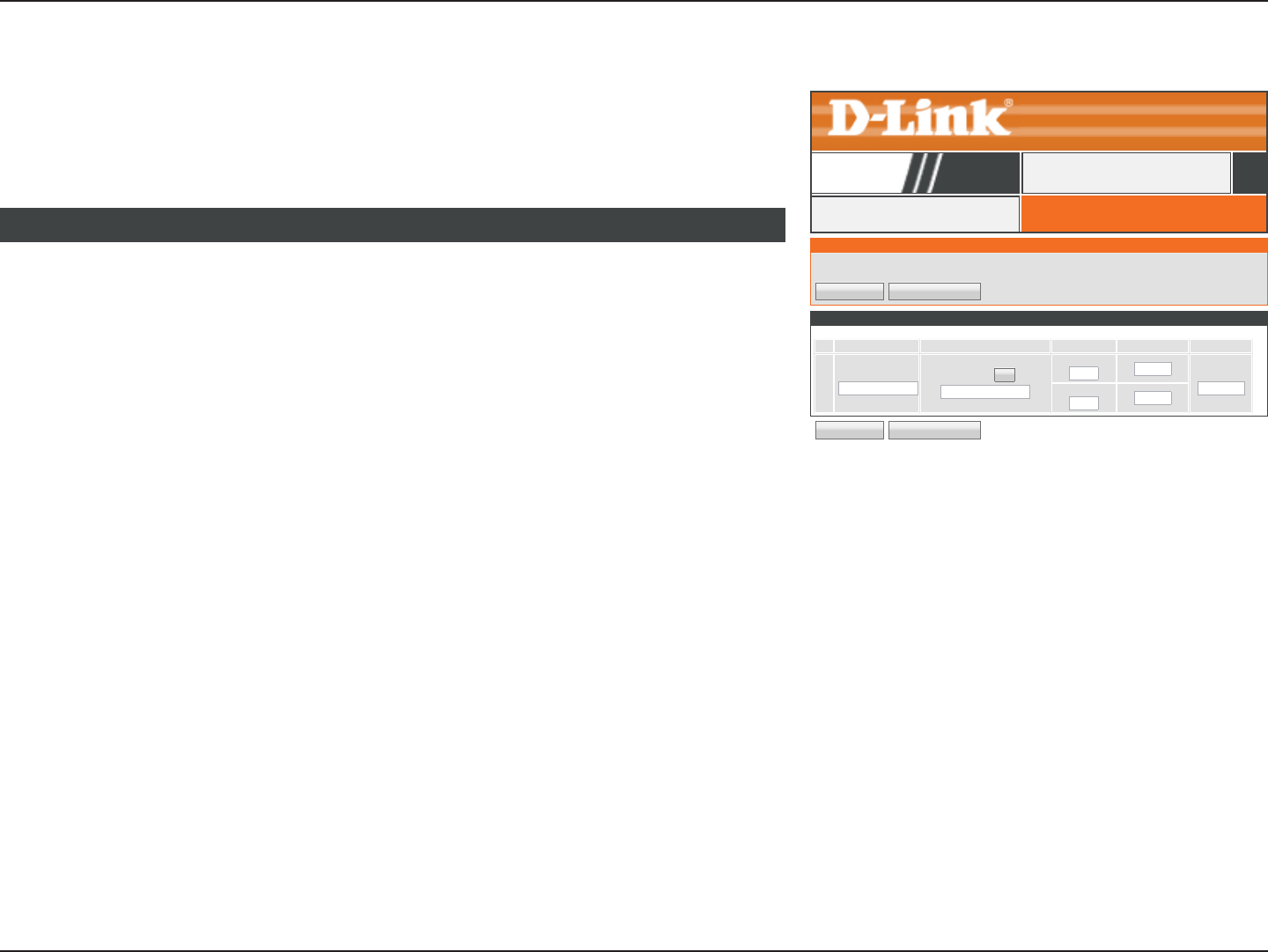
82D-Link DIR-819 User Manual
Section 3 - Conguration
Application Rules
APPLICATION RULESAPPLICATION RULES
DIR-819 ADVANCED
APPLICATION RULES
The Application Rules option is used to open single or multiple ports in your rewall when the router senses data sent to the Internet
on an outgoing "Trigger" port or port range. Special Application rules apply to all computers on your internal network.
Save Settings Don’t Save Settings
24 -- APPLICATION RULES
Remaining number of rules that can be created: 24
Port Trafc Type
☐Name Application <<
Application Name ▼
Trigger
TCP ▼
Schedule
Always ▼
Firewall
TCP ▼
Save Settings Don’t Save Settings
Click Port Triggering on the navigation menu to congure Port Triggering. Port triggering
allows external ports to be opened for remote access when triggered by activity by a local
computer on specied ports. When you are satised with your conguration, click Save
Settings.
Enable: Check the box to enable this rule.
Name: Enter a name for the application you wish to apply the virtual server
to. Use the Application Name dropdown menu and the << button
to quickly select an application. The name, port numbers, and trac
type are automatically populated.
Trigger Port: Enter the trigger port.
Trac Type: Select TCP, UDP, or All.
Firewall Port: Enter the rewall port to open once triggered.
Trac Type: Select TCP, UDP, or All.
Schedule: Select the schedule from the drop-down menu. The default is Always.
Refer to Schedules on page 110 for more information on creating
new schedules.
Click the Save Settings button when you are nished.
24 APPLICATION RULES
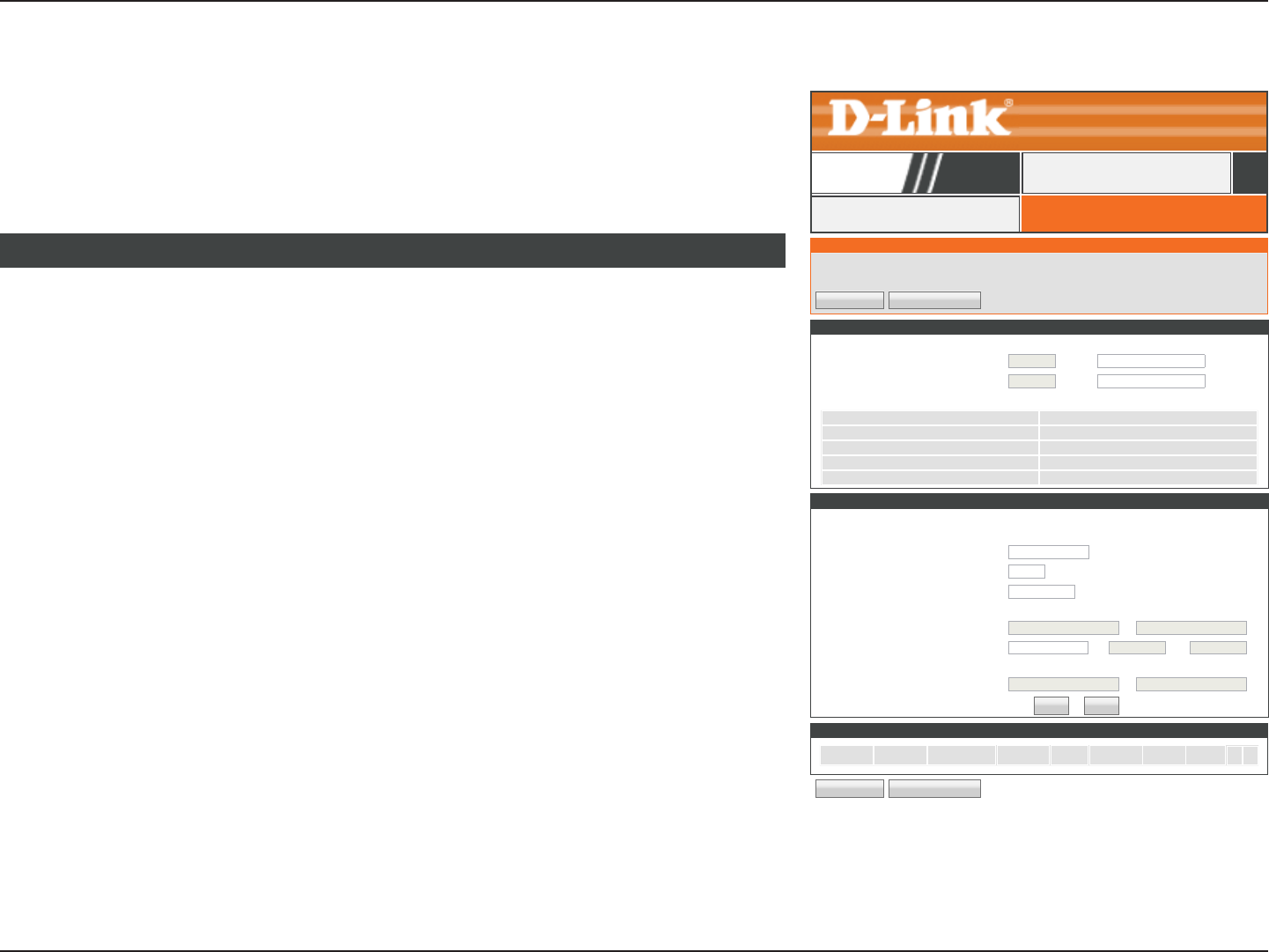
83D-Link DIR-819 User Manual
Section 3 - Conguration
QOS Engine
QOS SETTINGSQOS ENGINE
DIR-819 ADVANCED
Click QoS Engine on the navigation menu to congure Quality of Service (QoS). QoS allows
you to prioritize Internet trac to ensure a better web browsing experience in situations
where bandwidth is limited or large numbers of devices are in use. QoS can improve your
online experience by ensuring that specic trac is prioritized over other network trac,
such as VoIP, FTP, or Web. When you are satised with your conguration, click Save Settings.
QOS SETTINGS
Use this section to congure D-Link's QoS Engine powered by QoS Engine Technology. This QoS Engine improves your online gaming
experience by ensuring that your game trafc is prioritized over other network trafc, such as FTP or Web.For best performance, use
the Automatic Classication option to automatically set the priority for your applications.
Save Settings Don’t Save Settings
CLASSIFICATION RULES
Enable Name Queue ID Protocol Classify Application
Port
Remote
IP Range
Local IP
Range
32 -- ADD CLASSIFICATION RULE
Enable : ☐
Name :
Queue ID : 1 - Highest ▼
Protocol : ALL ▼
Classify : Upstream ▼
Local IP Range : Local IP Start Local IP End
to
Application Port : Application Name ▼>> to
Remote IP Range : Remote IP Start Remote IP End
to
Add Cancel
Save Settings Don’t Save Settings
Enable QoS: Enable or disable QoS.
Uplink Speed: Enter your Internet connection’s Uplink Speed in kbps or use the
Select Transmission Rate dropdown menu and the << button to
quickly select and populate a speed.
Downlink Speed: Enter your Internet connection’s Downlink Speed in kbps or use the
Select Transmission Rate dropdown menu and the << button to
quickly select and populate a speed.
Queue Type: Choose either Strict Priority Queue or Weighted Fair Queue. If you
select Weighted Fair Queue, you may adjust the percentage weights
for each queue.
Click the Save Settings button before proceeding to 32 -- ADD CLASSIFICATION RULE.
QOS SETUP
QOS SETUP
Enable Qos : ☐
Uplink Speed : 0kbps << Select Transmission Rate ▼
Downlink Speed : 0kbps << Select Transmission Rate ▼
Queue Type : Strict Priority Queue Weighted Fair Queue
Queue ID Queue Priority
1 Highest
2 Higher
3 Normal
4 Best Effort(default)
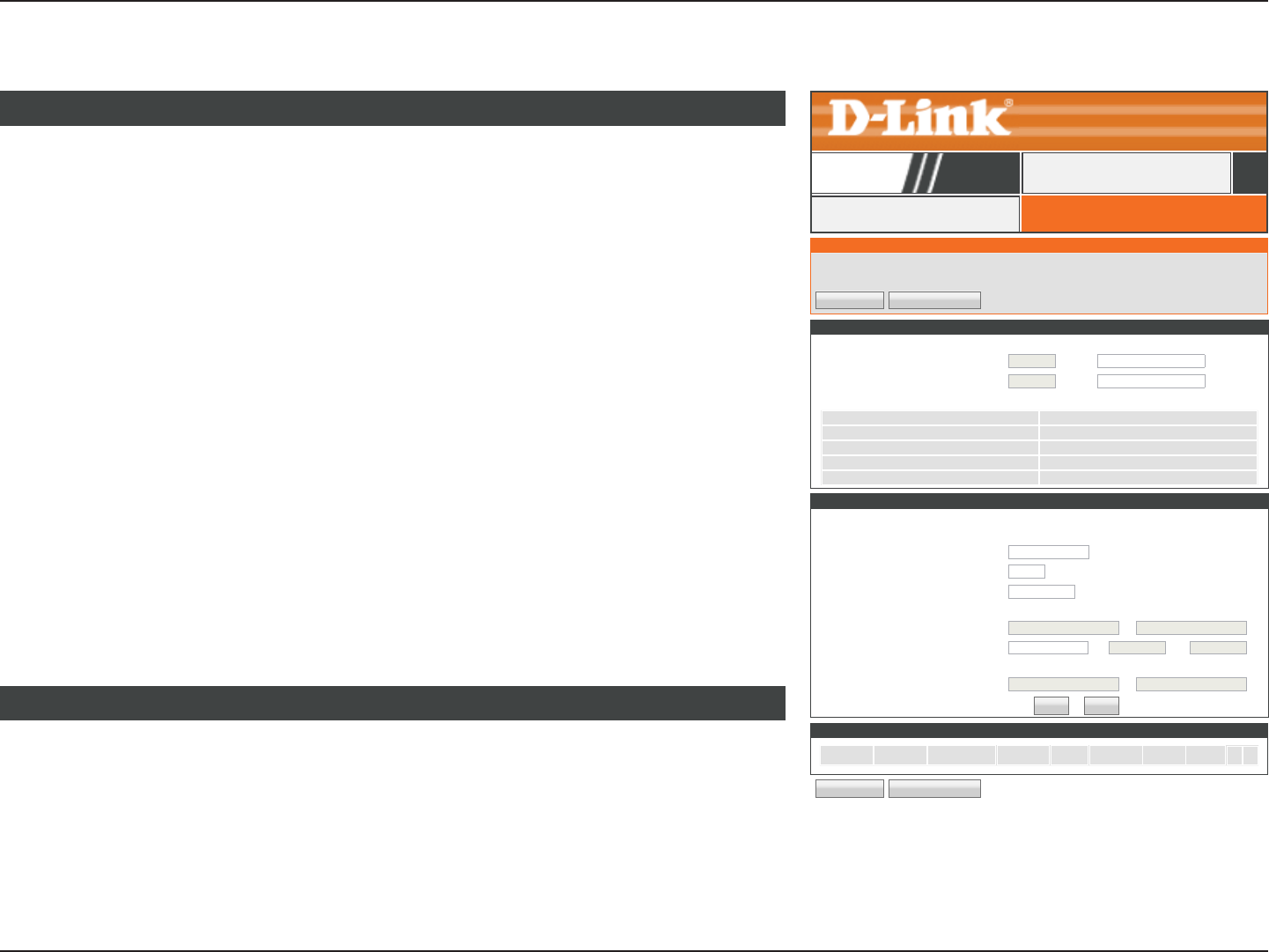
84D-Link DIR-819 User Manual
Section 3 - Conguration
Enable: Check the box to enable this rule.
Name: Enter a name for this QoS rule.
Queue ID: Select the queue to apply this rule to.
Protocol: Select the protocol to apply the rule to: TCP, UDP, or All.
Classify: Select to apply the rule to Upstream or Downstream trac.
Local IP Range: If you selected Upstream as the Classify type, enter the local IP
Range, excluding the router IP and broadcast IP, to apply this rule to.
For example 192.168.0.2 to 192.168.0.254.
Application Port: Enter the port range you wish to apply this rule to. Use the Application
Name dropdown menu and the << button to quickly select an
application. The protocol, and port range are automatically populated.
Remote IP Range: If you selected Downstream as the Classify type, enter the Remote
IP Range, excluding the router IP and broadcast IP, to apply this rule
to. For example 192.168.0.2 to 192.168.0.254.
32 ADD CLASSIFICATION RULE
The currently dened QoS rules are listed here.
Click the Save Settings button when you are nished.
CLASSIFICATION RULES
QOS Engine (continued)
QOS SETTINGSQOS ENGINE
DIR-819 ADVANCED
QOS SETTINGS
Use this section to congure D-Link's QoS Engine powered by QoS Engine Technology. This QoS Engine improves your online gaming
experience by ensuring that your game trafc is prioritized over other network trafc, such as FTP or Web.For best performance, use
the Automatic Classication option to automatically set the priority for your applications.
Save Settings Don’t Save Settings
CLASSIFICATION RULES
Enable Name Queue ID Protocol Classify Application
Port
Remote
IP Range
Local IP
Range
QOS SETUP
Enable Qos : ☐
Uplink Speed : 0kbps << Select Transmission Rate ▼
Downlink Speed : 0kbps << Select Transmission Rate ▼
Queue Type : Strict Priority Queue Weighted Fair Queue
Queue ID Queue Priority
1 Highest
2 Higher
3 Normal
4 Best Effort(default)
32 -- ADD CLASSIFICATION RULE
Enable : ☐
Name :
Queue ID : 1 - Highest ▼
Protocol : ALL ▼
Classify : Upstream ▼
Local IP Range : Local IP Start Local IP End
to
Application Port : Application Name ▼>> to
Remote IP Range : Remote IP Start Remote IP End
to
Add Cancel
Save Settings Don’t Save Settings
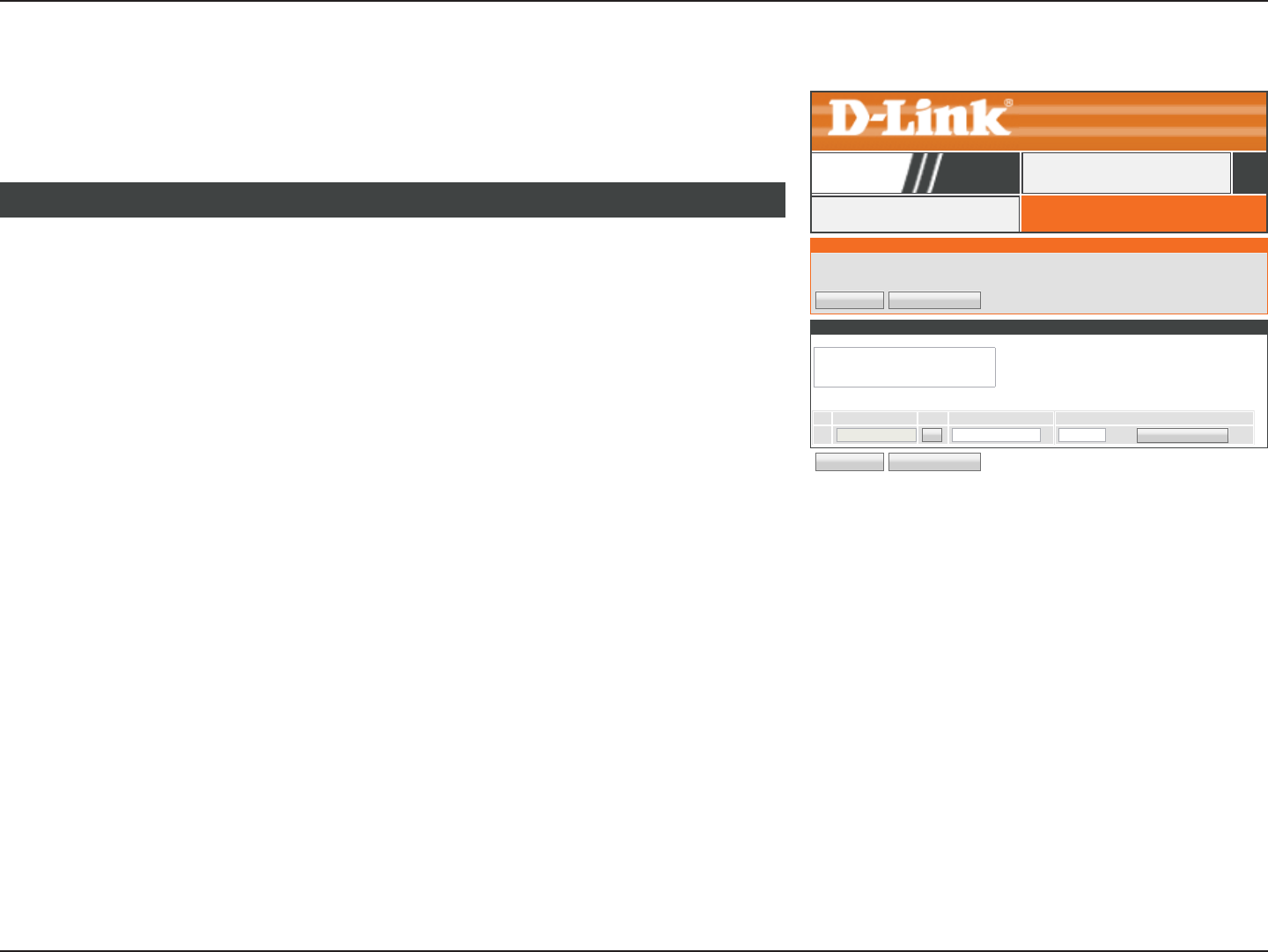
85D-Link DIR-819 User Manual
Section 3 - Conguration
Network Filter
MAC ADDRESS FILTERNETWORK FILTER
DIR-819 ADVANCED
Click Network Filter on the navigation menu to congure the Network Filter. The Network
Filter allows you to allow or block a device’s access to the network or Internet based on its
MAC address. When you are satised with your conguration, click Save Settings.
MAC ADDRESS FILTER
The MAC (Media Access Controller) Address lter option is used to control network access based on the MAC Address of the network
adapter.A MAC address is a unique ID assigned by the manufacturer of the network adapter.This feature can be congured to ALLOW
or DENY network/Internet access.
Save Settings Don’t Save Settings
24 -- MAC FILTERING RULES
Congure MAC Filtering below:
Turn MAC Filtering OFF ▼
Turn MAC Filtering ON and ALLOW rules listed
Turn MAC Filtering ON and DENY rules listed
Remaining number of rules that can be created: 24
MAC Address DHCP Client List Schedule
☐<< Computer Name ▼Always ▼New Schedule
Save Settings Don’t Save Settings
Congure MAC
Filtering below:
Select the function of the MAC Filter, the options are Turn MAC
Filtering OFF, Turn MAC Filtering ON and ALLOW rules listed, or
Turn MAC Filtering ON and DENY rules listed.
Enable: Check the box to enable this rule.
MAC Address: Enter the MAC Address of the device you wish to apply the Network
Filter to. Use the Computer Name dropdown menu and the <<
button to quickly select a device. The MAC Address is automatically
populated.
Schedule: Select the schedule from the drop-down menu. The default is Always.
Refer to Schedules on page 110 for more information on creating
new schedules.
Click the Save Settings button when you are nished.
24 MAC FILTERING RULES
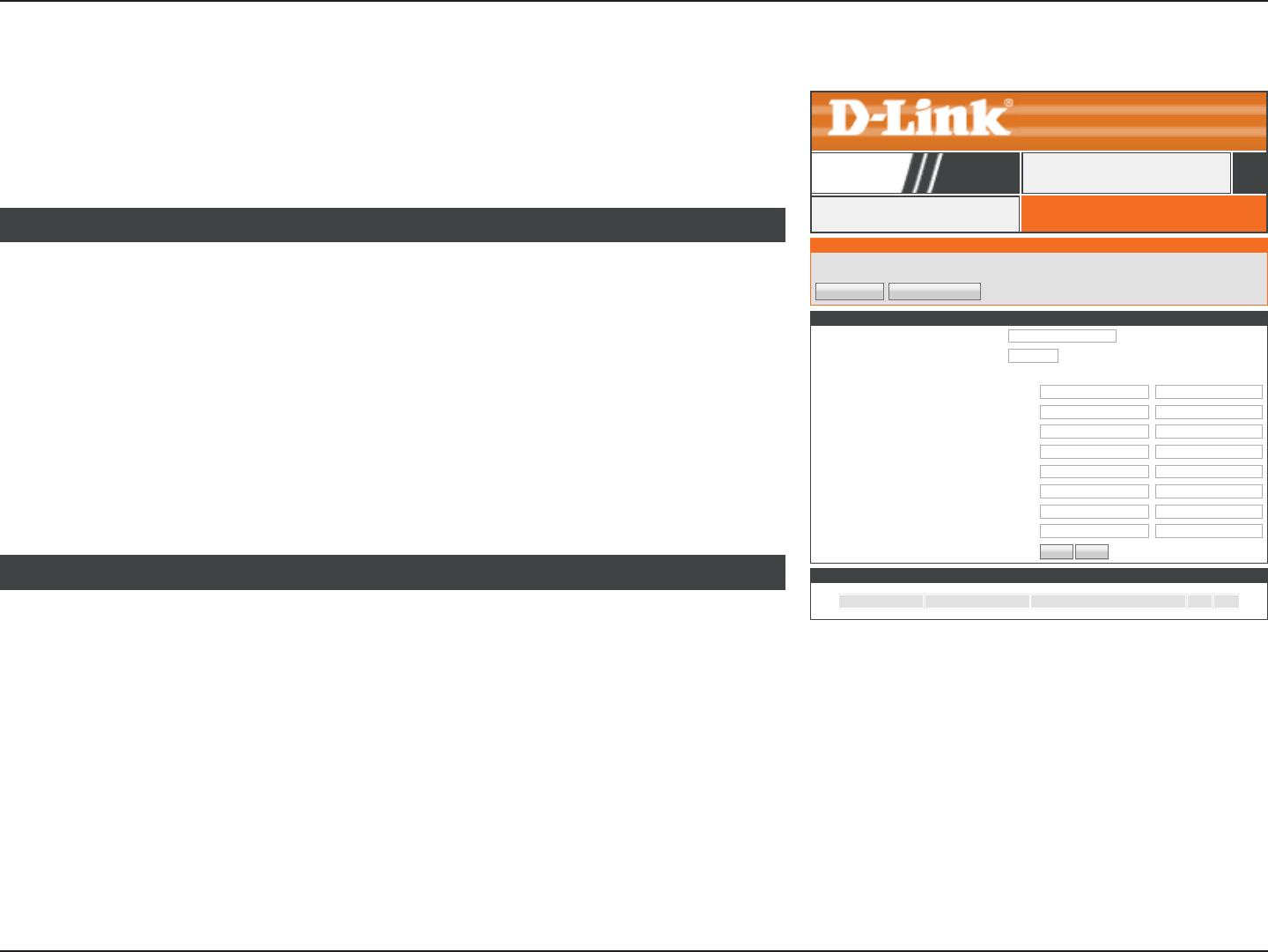
86D-Link DIR-819 User Manual
Section 3 - Conguration
Inbound Filter
INBOUND FILTERINBOUND FILTER
DIR-819 ADVANCED
Click Inbound Filter on the navigation menu to congure the Inbound Filter. The Inbound
Filter allows you to place ltering rules on a per IP basis. Using this tool you may restrict
access to or block trac to a specic remote IP address or range. When you are satised
with your conguration, click Save Settings.
ORANGE
OrangeText
Save Settings Don’t Save Settings
INBOUND FILTER RULES LIST
Name Action Remote IP Range
ADD INBOUND FILTER RULE
Name :
Action : Allow ▼
Remote IP Range : Enable Remote IP Start Remote IP End
☐0.0.0.0 255.255.255.255
☐0.0.0.0 255.255.255.255
☐0.0.0.0 255.255.255.255
☐0.0.0.0 255.255.255.255
☐0.0.0.0 255.255.255.255
☐0.0.0.0 255.255.255.255
☐0.0.0.0 255.255.255.255
☐0.0.0.0 255.255.255.255
Add Cancel
The currently dened Inbound Filter rules are listed here.
Click the Save Settings button when you are nished.
INBOUND FILTER RULES LIST
Name: Enter a name for this Inbound Filter.
Action: Allow or Deny trac.
Remote IP Range
Enable: Check the box to enable this rule.
Remote IP Start: Enter the starting IP address to apply the rule to.
Remote IP End: Enter the ending IP address to apply the rule to.
ADD INBOUND FILTER RULE
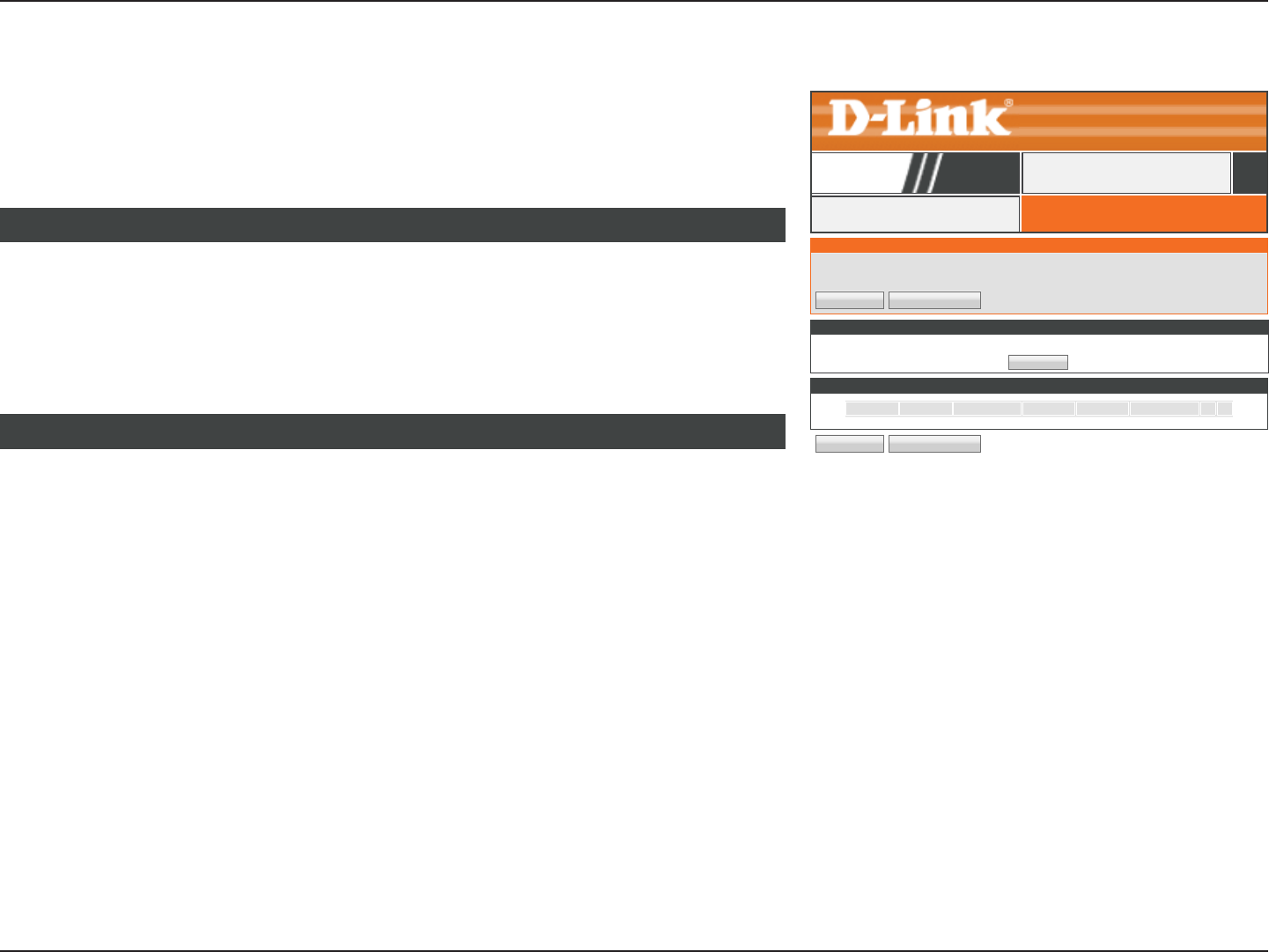
87D-Link DIR-819 User Manual
Section 3 - Conguration
Access Control
ACCESS CONTROLACCESS CONTROL
DIR-819 ADVANCED
Click Access Control on the navigation menu to congure Access Control. The Access Control
function allows you to control access to the Internet. You may also monitor which web sites
were accessed. The Add Policy Wizard allows you to easily add access control policies. When
you are satised with your conguration, click Save Settings.
Enable Access
Control:
Enable or disable Access Control. You must click Save Settings after
enabling Access Control before you can add policies.
Add Policy: Click this button to add a policy. Refer to Add Policy on page 88
for more information on running the Add Policy Wizard.
ACCESS CONTROL
ACCESS CONTROL
The Access Control option allows you to control access in and out of your network. Use this feature as Access Controls to only grant
access to approved sites, limit web access based on time or dates, and/or block Internet access for applications like P2P utilities or
games.
Save Settings Don’t Save Settings
POLICY TABLE
Enable Policy Machine Filtering Logged Schedule
ACCESS CONTROL
Enable Access Control : ☑
Add Policy
Save Settings Don’t Save Settings
The currently dened access control policies are listed in this table.
Click the Save Settings button when you are nished.
POLICY TABLE
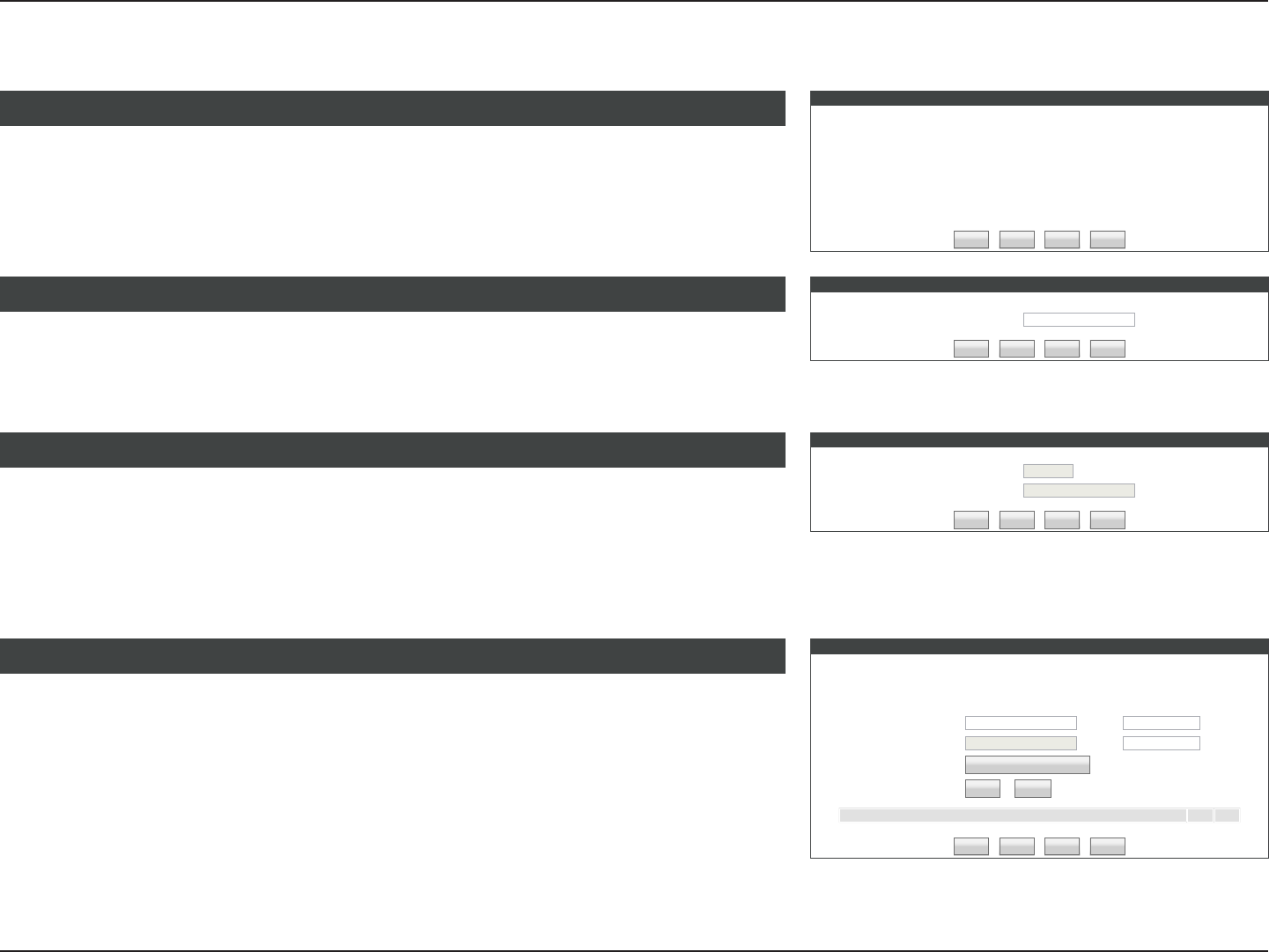
88D-Link DIR-819 User Manual
Section 3 - Conguration
Add Policy
ADD NEW POLICY
This wizard will guide you through the following steps to add a new policy for Access Control.
Step 1 - Choose a unique name for your policy
Step 2 - Select a schedule
Step 3 - Select the machine to which this policy applies
Step 4 - Select ltering method
Step 5 - Select lters
Step 6 - Congure Web Access Logging
Prev Next Save Cancel
Click Next to begin the add policy wizard.
ADD NEW POLICY
STEP 1: CHOOSE POLICY NAME
Choose a unique name for your policy.
Policy Name :
Prev Next Save Cancel
Policy Name : Enter a name for your policy.
Click Next to continue.
STEP 1: CHOOSE POLICY NAME
STEP 2: SELECT SCHEDULE
Choose a schedule to apply to this policy.
Always ▼
Details : Always
Prev Next Save Cancel
Details: Select a schedule from the drop-down menu. The default is Always.
Refer to Schedules on page 110 for more information on creating
new schedules.
Click Next to continue.
STEP 2: SELECT SCHEDULE
STEP 3: SELECT MACHINE
Select the machine to which this policy applies.
Specify a machine with its IP or MAC address.
Address Type : IP MAC
IP Address : << Computer Name ▼
Machine Addres : << Computer Name ▼
Clone Your PC’s MAC Address
Add Cancel
Machine
Prev Next Save Cancel
Address Type: Choose whether this policy is applied by IP or MAC address.
IP Address: If you select IP as the address type, enter the IP address of the device
you wish to apply the policy to or use the Computer Name dropdown
menu to quickly select a computer. The IP address is automatically
populated.
STEP 3: SELECT MACHINE
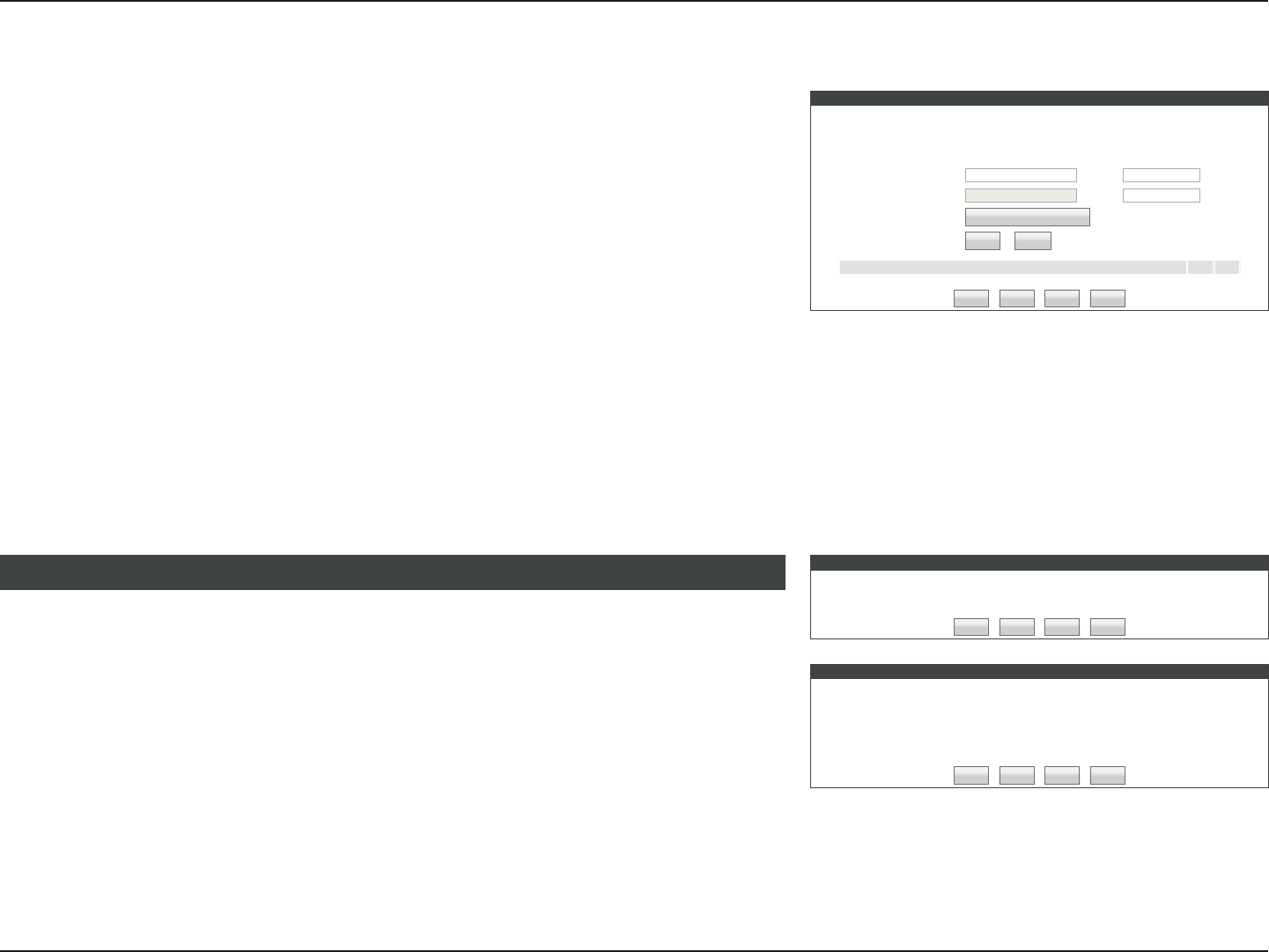
89D-Link DIR-819 User Manual
Section 3 - Conguration
Machine Address: If you select MAC as the address type, enter the IP address of the
device you wish to apply the policy to or use the Computer Name
dropdown menu to quickly select a computer. The MAC address is
automatically populated. You may also use the Clone Your PC’s MAC
Address button to use the MAC address of the device you are running
the wizard from.
Add: Click this button to add the machine to the table.
Cancel: Click this button to clear the currently congured information
Machine
IP or MAC Address: To edit a machine added to the table, click its corresponding pencil
icon. To remove a machine click its corresponding trashcan icon.
Click Next to continue.
STEP 3: SELECT MACHINE
Select the machine to which this policy applies.
Specify a machine with its IP or MAC address.
Address Type : IP MAC
IP Address : << Computer Name ▼
Machine Addres : << Computer Name ▼
Clone Your PC’s MAC Address
Add Cancel
Machine
Prev Next Save Cancel
Add Policy (continued)
STEP 4: SELECT FILTERING METHOD
Select the method for ltering.
Method : Log Web Access Only Block All Access Block Some Access
Prev Next Save Cancel
STEP 4: SELECT FILTERING METHOD
Select the method for ltering.
Method : Log Web Access Only Block All Access Block Some Access
Apply Web Filter : ☑
Apply Advanced Port Filters : ☑
Prev Next Save Cancel
Method: Select the method for ltering. The available options are Log Web
Access Only, Block All Access, or Block Some Access.
If you select Log Web Access Only or Block Some Access, click Save to nish the wizard.
If you select Block Some Access, select the following options:
Apply Web Filter: Check this box to enable Web Access Logging.
Apply Advanced
Port Filters:
Check this box to enable port ltering.
Click Next to continue.
STEP 4: SELECT FILTERING METHOD

90D-Link DIR-819 User Manual
Section 3 - Conguration
STEP 5: PORT FILTER
Add Port Filters Rules.
Specify rules to prohibit access to specic IP addresses and ports.
Enable Name Dest IP Start Dest IP End Protocol Dest Port Start Dest Port End
☑0.0.0.0 255.255.255.255 Any ▼1 65535
☑0.0.0.0 255.255.255.255 Any ▼1 65535
☑0.0.0.0 255.255.255.255 Any ▼1 65535
☑0.0.0.0 255.255.255.255 Any ▼1 65535
☑0.0.0.0 255.255.255.255 Any ▼1 65535
☑0.0.0.0 255.255.255.255 Any ▼1 65535
☑0.0.0.0 255.255.255.255 Any ▼1 65535
☑0.0.0.0 255.255.255.255 Any ▼1 65535
Prev Next Save Cancel
STEP 6: CONFIGURE WEB ACCESS LOGGING
Select the method for ltering.
Web Access Logging : Disabled
Enabled
Prev Next Save Cancel
Add Policy (continued)
Enable: Check the box to enable this rule.
Name: Enter a name for port ltering rule.
Dest IP Start: Enter the start of the IP address range to lter.
Dest IP End: Enter the end of the IP address range to lter.
Protocol: Select the protocol to apply the port lter to. The options are Any,
ICMP, TCP, and UDP.
If you select TCP or UDP, enter the port range:
Des Port Start: Enter the start of the port range to lter.
Des Port End: Enter the end of the port range to lter.
Click Next to continue.
STEP 5: PORT FILTER
Web Access
Logging:
Enable or disable Web Access logging. You may view the web access
log from the Status > Logs section of the web conguration utility.
Click Save to nish.
STEP 6: CONFIGURE WEB ACCESS LOGGING
If you selected Block Some Access, congure the following options:
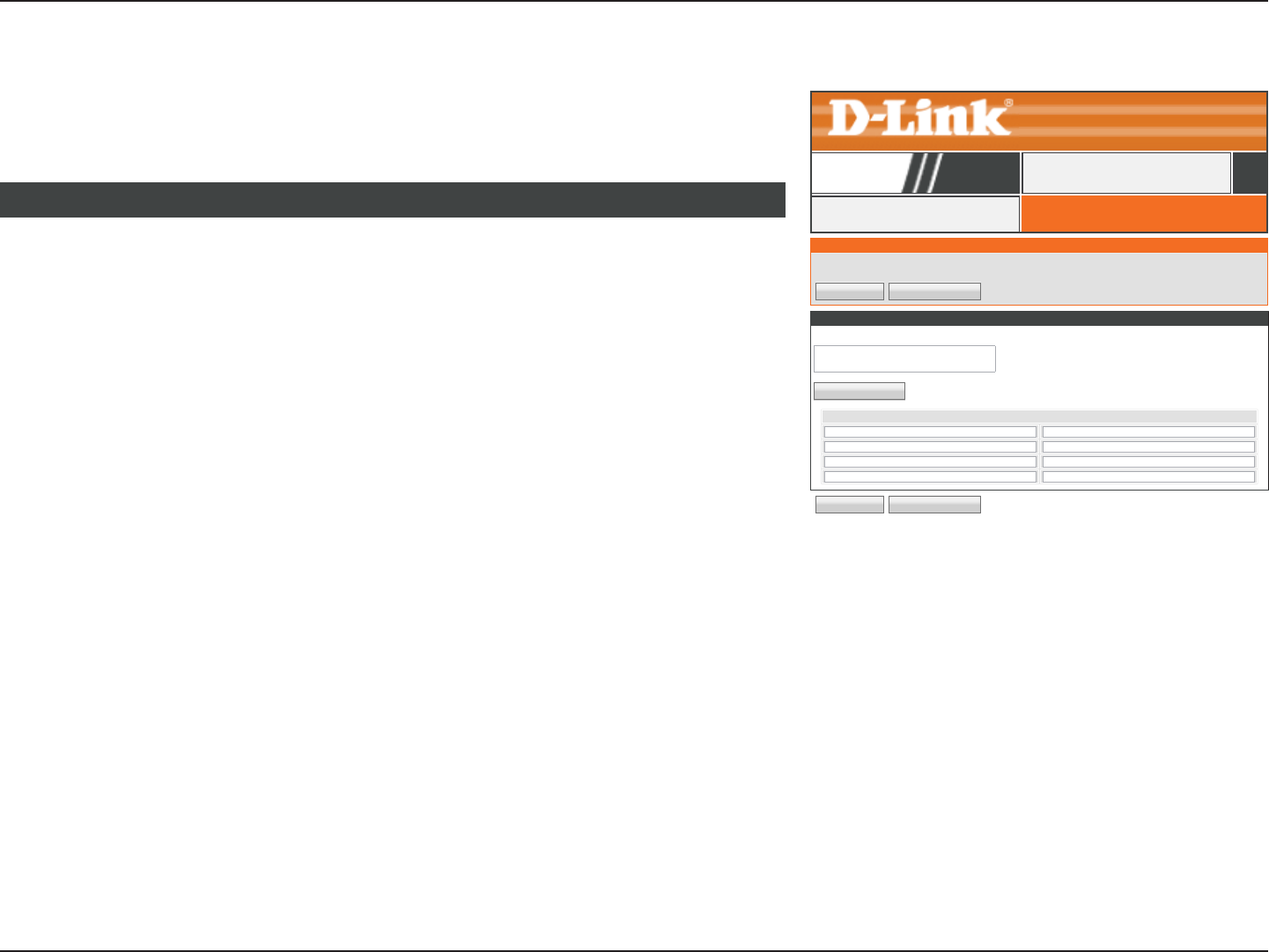
91D-Link DIR-819 User Manual
Section 3 - Conguration
Save Settings Don’t Save Settings
WEBSITE FILTERWEBSITE FILTER
DIR-819 ADVANCED
Click Website Filter on the navigation menu to congure the Website Filter. The Website
Filter function allows you to control access to specic websites. When you are satised with
your conguration, click Save Settings.
WEBSITE FILTER
The Website Filter option allows you to set up a list of Web sites you would like to allow or deny through your network.
Save Settings Don’t Save Settings
Website Filter
40 -- WEBSITE FILTERING RULES
Congure Website Filter below:
ALLOW computers access to ONLY these sites ▼
DENY computers access to ONLY these sites
Clear the list below...
Website URL/Domain
Congure Website
Filter below:
Select the function of the Website Filter, the options are ALLOW
computers access to ONLY these sites or DENY computers access
to ONLY these sites.
Clear the list
below...
Click this button to clear the website lter.
Website URL/
Domain:
Enter website URL/Domains in each box.
Click the Save Settings button when you are nished.
40 WEBSITE FILTERING RULES
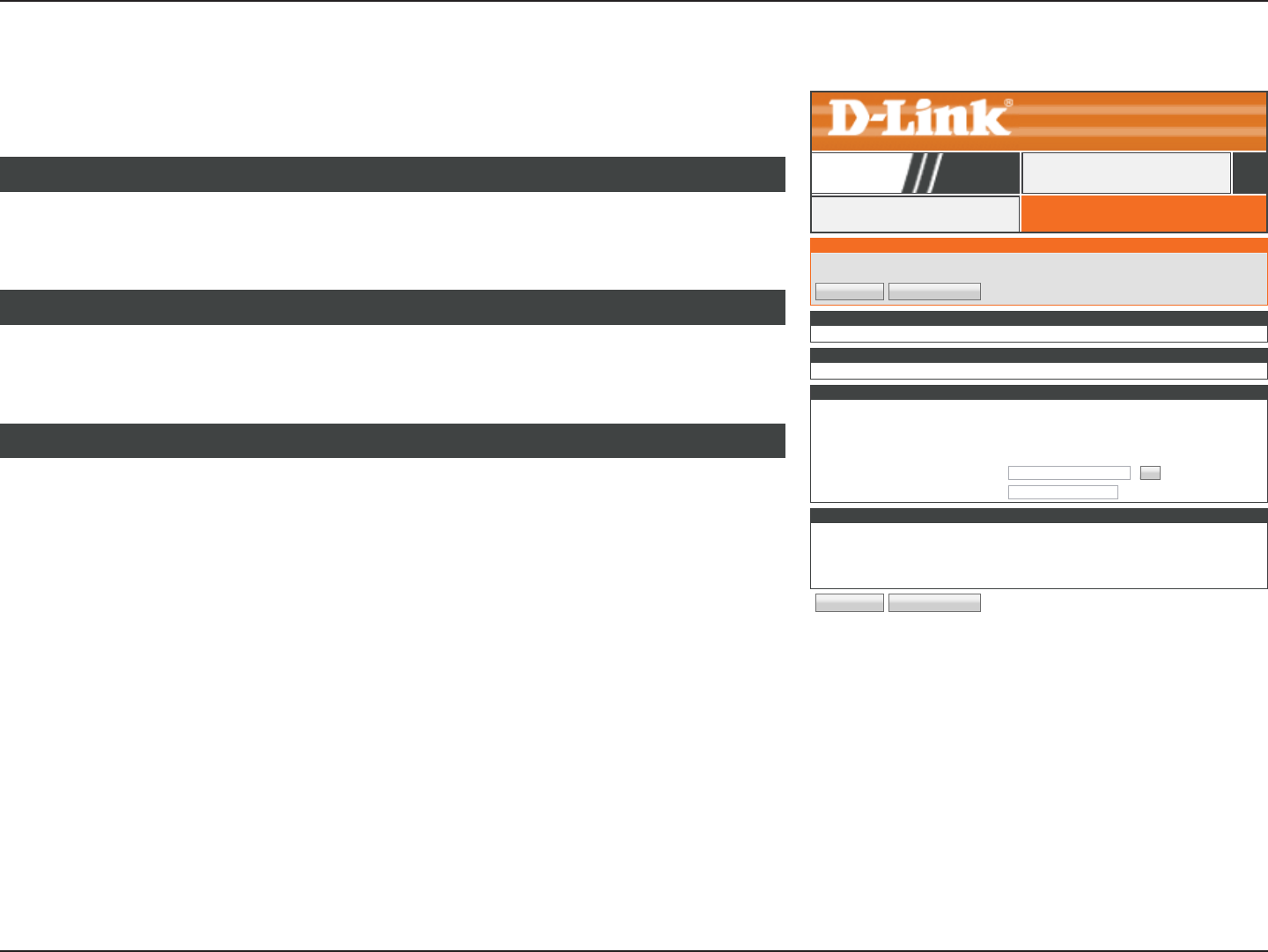
92D-Link DIR-819 User Manual
Section 3 - Conguration
Save Settings Don’t Save Settings
Firewall Settings
FIREWALL & DMZ SETTINGSFIREWALL SETTINGS
DIR-819 ADVANCED
Enable SPI: Enable or disable the Stateful Packet Inspection (SPI) firewall.
Disabling the rewall is not recommended.
FIREWALL SETTINGS
FIREWALL & DMZ SETTINGS
DMZ means "Demilitarized Zone". DMZ allows computers behind the router rewall to be accessible to Internet trafc.Typically, your
DMZ would contain Web servers, FTP servers and others.b
Save Settings Don’t Save Settings
FIREWALL SETTINGS
Enable SPI : ☑
APPLICATION LEVEL GATEWAY (ALG) CONFIGURATION
PPTP : ☑
IPSec (VPN) : ☑
RTSP : ☑
SIP : ☑
ANTI-SPOOF CHECKING
Enable anti-spoof checking : ☐
DMZ HOST
The DMZ (Demilitarized Zone) option lets you set a single computer on your network outside of the router.If you have a computer that
cannot run Internet applications successfully from behind the router, then you can place the computer into the DMZ for unrestricted
Internet access.
Note:Putting a computer in the DMZ may expose that computer to a variety of security risks. Use of this option is only recommended
as a last resort.
Enable DMZ : ☐
DMZ IP Address : <<
Computer Name ▼
Enable anti-spoof
checking:
Enable or disable anti-spoof checking.
ANTISPOOF CHECKING
This option allows you to manually congure the router’s demilitarized zone (DMZ). The
DMZ should only be used as a last resort when you are having diculty using other port
forwarding tools since the device using this IP address is not protected by the rewall. If
you use DMZ, take measures such as client-based virus protection to protect the remaining
client PCs on your LAN from possible attacks through DMZ’d device.
Enable DMZ: Check the box to enable the DMZ function.
DMZ Host IP
Address:
Enter the IP address of the machine that you wish to place in the DMZ.
If the machine receives an IP address from the DHCP server, you should
create a static DHCP reservation to ensure that the machine always
receives the same address from the DHCP server. Use the Computer
Name dropdown menu and the << button to quickly select a device.
The IP address is automatically populated.
DMZ HOST
Click Firewall Settings on the navigation menu to congure the Firewall Settings. When
you are satised with your conguration, click Save Settings.
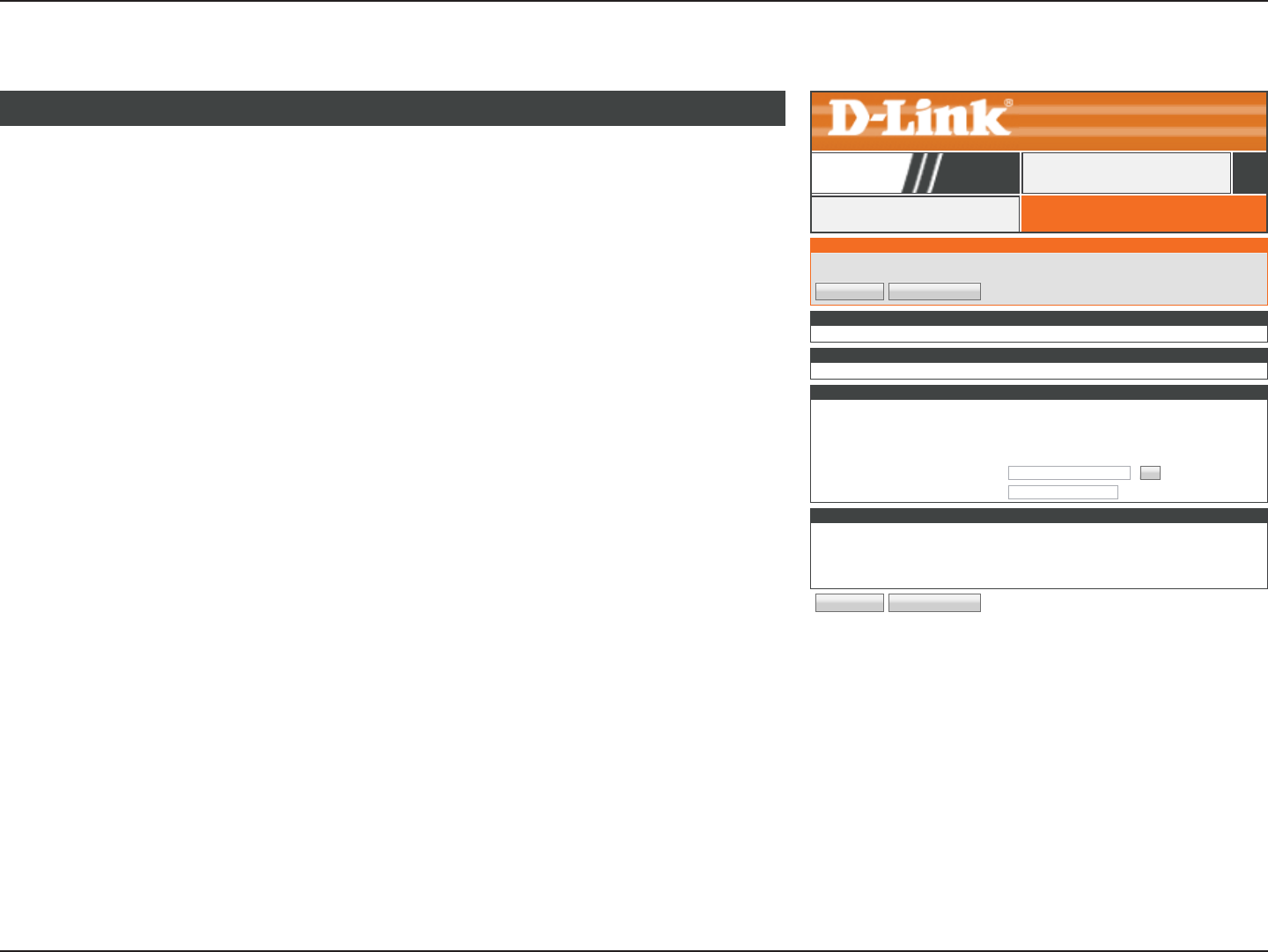
93D-Link DIR-819 User Manual
Section 3 - Conguration
Firewall Settings (continued)
Save Settings Don’t Save Settings
FIREWALL & DMZ SETTINGSFIREWALL SETTINGS
DIR-819 ADVANCED
FIREWALL & DMZ SETTINGS
DMZ means "Demilitarized Zone". DMZ allows computers behind the router rewall to be accessible to Internet trafc.Typically, your
DMZ would contain Web servers, FTP servers and others.b
Save Settings Don’t Save Settings
FIREWALL SETTINGS
Enable SPI : ☑
APPLICATION LEVEL GATEWAY (ALG) CONFIGURATION
PPTP : ☑
IPSec (VPN) : ☑
RTSP : ☑
SIP : ☑
ANTI-SPOOF CHECKING
Enable anti-spoof checking : ☐
DMZ HOST
The DMZ (Demilitarized Zone) option lets you set a single computer on your network outside of the router.If you have a computer that
cannot run Internet applications successfully from behind the router, then you can place the computer into the DMZ for unrestricted
Internet access.
Note:Putting a computer in the DMZ may expose that computer to a variety of security risks. Use of this option is only recommended
as a last resort.
Enable DMZ : ☐
DMZ IP Address : <<
Computer Name ▼
PPTP: Allows multiple machines on the LAN to connect to their corporate
network using the Point-to-Point Tunneling protocol (PPTP) based
VPNs.
IPSec (VPN): Allows VPN clients to connect to their corporate IPSec-based network.
Some VPN clients support traversal of IPSec through NAT. This
Application Level Gateway (ALG) may interfere with the operation
of such VPN clients. If you are having trouble connecting with your
corporate network, try turning this ALG o. Please check with the
system administrator of your corporate network whether your VPN
client supports NAT traversal.
RTSP: A llows applications that use Real Time Streaming Protocol (RTSP)to
receive streaming media from the Internet.
SIP: Enabling Session Initiation Protocol (SIP) allows devices and
applications using VoIP (Voice over IP). Some VoIP applications and
devices have the ability to discover NAT devices and work around
them. This ALG may interfere with the operation of such devices. If
you are having trouble making VoIP calls, try turning this ALG o.
Click the Save Settings button when you are nished.
APPLICATION LEVEL GATEWAY ALG CONFIGURATION
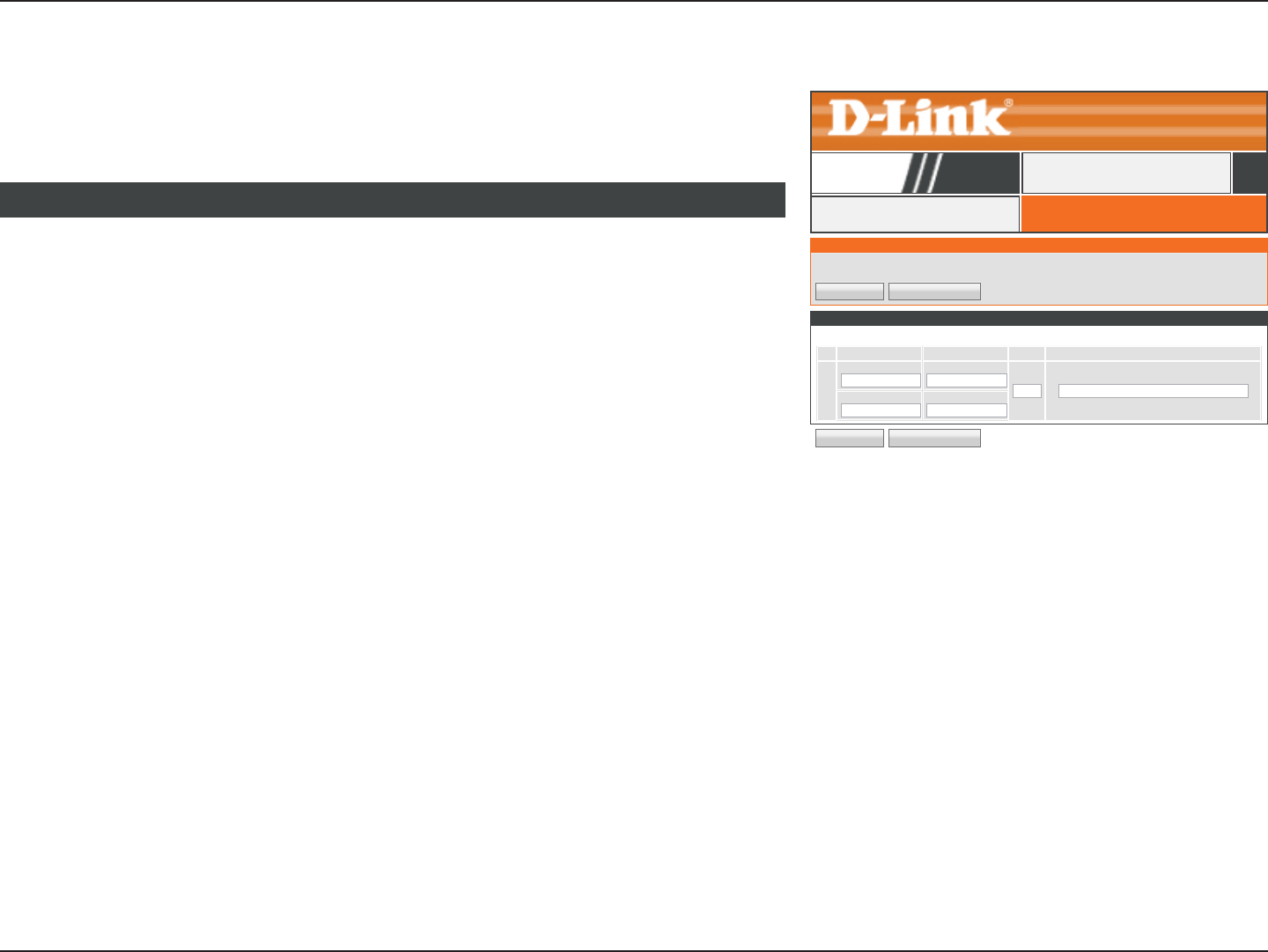
94D-Link DIR-819 User Manual
Section 3 - Conguration
Save Settings Don’t Save Settings
Routing
ROUTINGROUTING
DIR-819 ADVANCED
ROUTING
The Routing option allows you to dene static routes to specic destinations.
Save Settings Don’t Save Settings
24 -- APPLICATION RULES
Remaining number of rules that can be created: 24
Metric Interface
☐
Name Destination IP
1WAN(172.17.5.x) ▼
Netmask Gateway
Enable: Check the box to enable this rule.
Name: Enter a name for this static route.
Destination IP: Enter the destination IP address.
Gateway: Enter the gateway IP address.
Metric: Enter the metric value between 1-255.
Interface: Select the Interface from the drop-down menu.
Click the Save Settings button when you are nished.
32 ROUTE LIST
Click Routing on the navigation menu to congure Routing. The routing page allows you
to dene custom static routes to control the route which your data takes. When you are
satised with your conguration, click Save Settings.
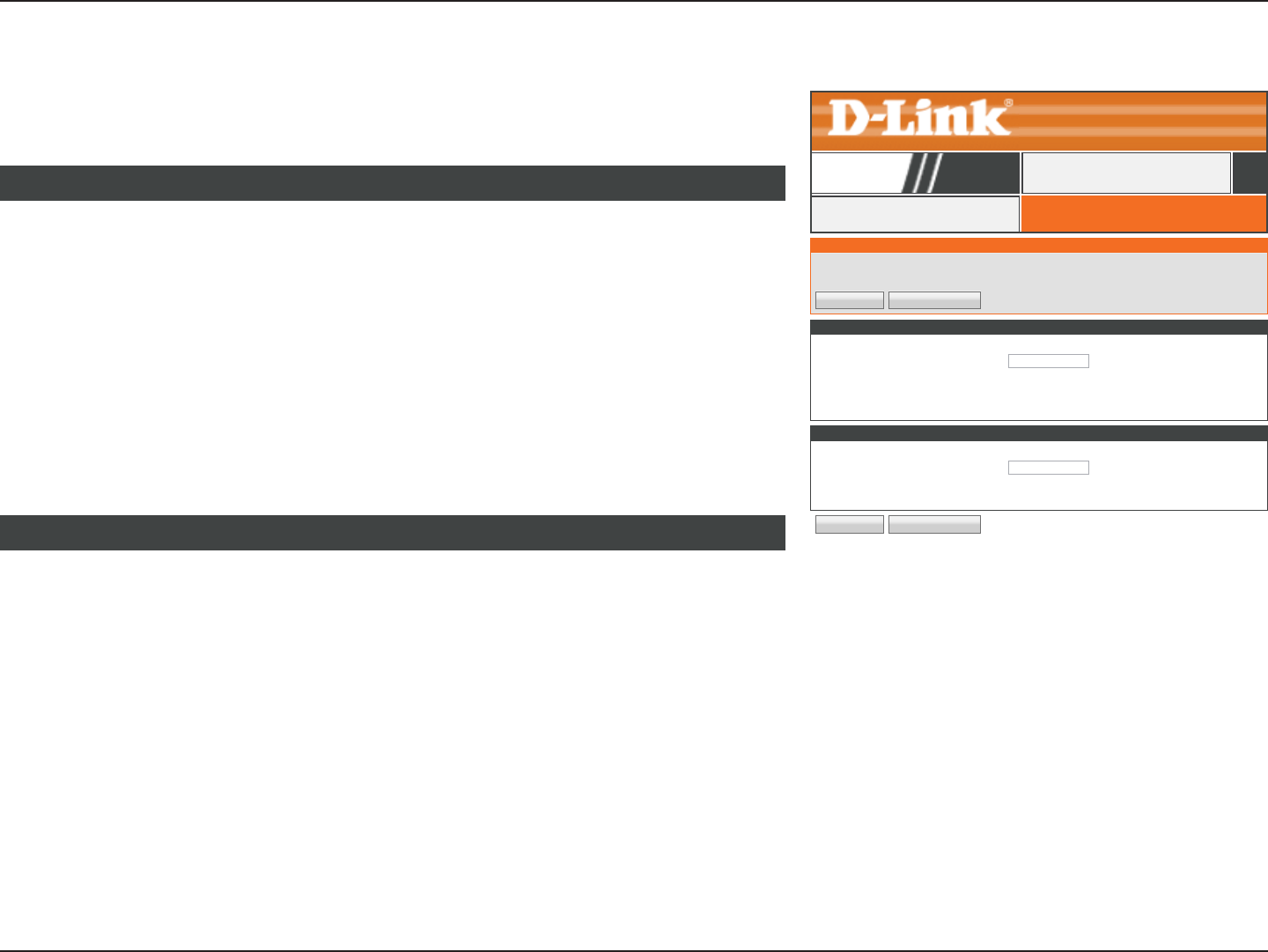
95D-Link DIR-819 User Manual
Section 3 - Conguration
Save Settings Don’t Save Settings
Advanced Wireless
ADVANCED WIRELESS SETTINGSADVANCED WIRELESS
DIR-819 ADVANCED
Click Advanced Wireless on the navigation menu to congure the advanced wireless
options. When you are satised with your conguration, click Save Settings.
Wireless Band: 2.4 GHz Band
Transmit Power: Select the desired wireless transmission power.
WLAN Partition: Check this box to enable user isolation. User isolation forces wireless
clients to communicate with each other through the access point.
WMM Enable: Enable or Disable Wi-Fi MultiMedia QoS.
HT 20/40
Coexistence:
Enable or disable HT20/40 Coexistence.
ADVANCED WIRELESS SETTINGS
Wireless Band: 5 GHz Band
Transmit Power: Select the desired wireless transmission power.
WLAN Partition: Check this box to enable user isolation. User isolation forces wireless
clients to communicate with each other through the access point.
WMM Enable: Enable or Disable Wi-Fi MultiMedia QoS.
Click the Save Settings button when you are nished.
ADVANCED WIRELESS SETTINGS
ADVANCED WIRELESS SETTINGS
These options are for users that wish to change the behavior of their 802.11n wireless radio from the standard settings. We do not
recommend changing these settings from the factory defaults. Incorrect settings may impact the performance of your wireless radio.
The default settings should provide the best wireless radio performance in most environments.
Save Settings Don’t Save Settings
ADVANCED WIRELESS SETTINGS
Wireless Band : 2.4GHz Band
Transmit Power : High ▼
WLAN Partition : ☐
WMM Enable : ☑
HT 20/40 Coexistence : Enable Disable
ADVANCED WIRELESS SETTINGS
Wireless Band : 5GHz Band
Transmit Power : High ▼
WLAN Partition : ☑
WMM Enable : ☑
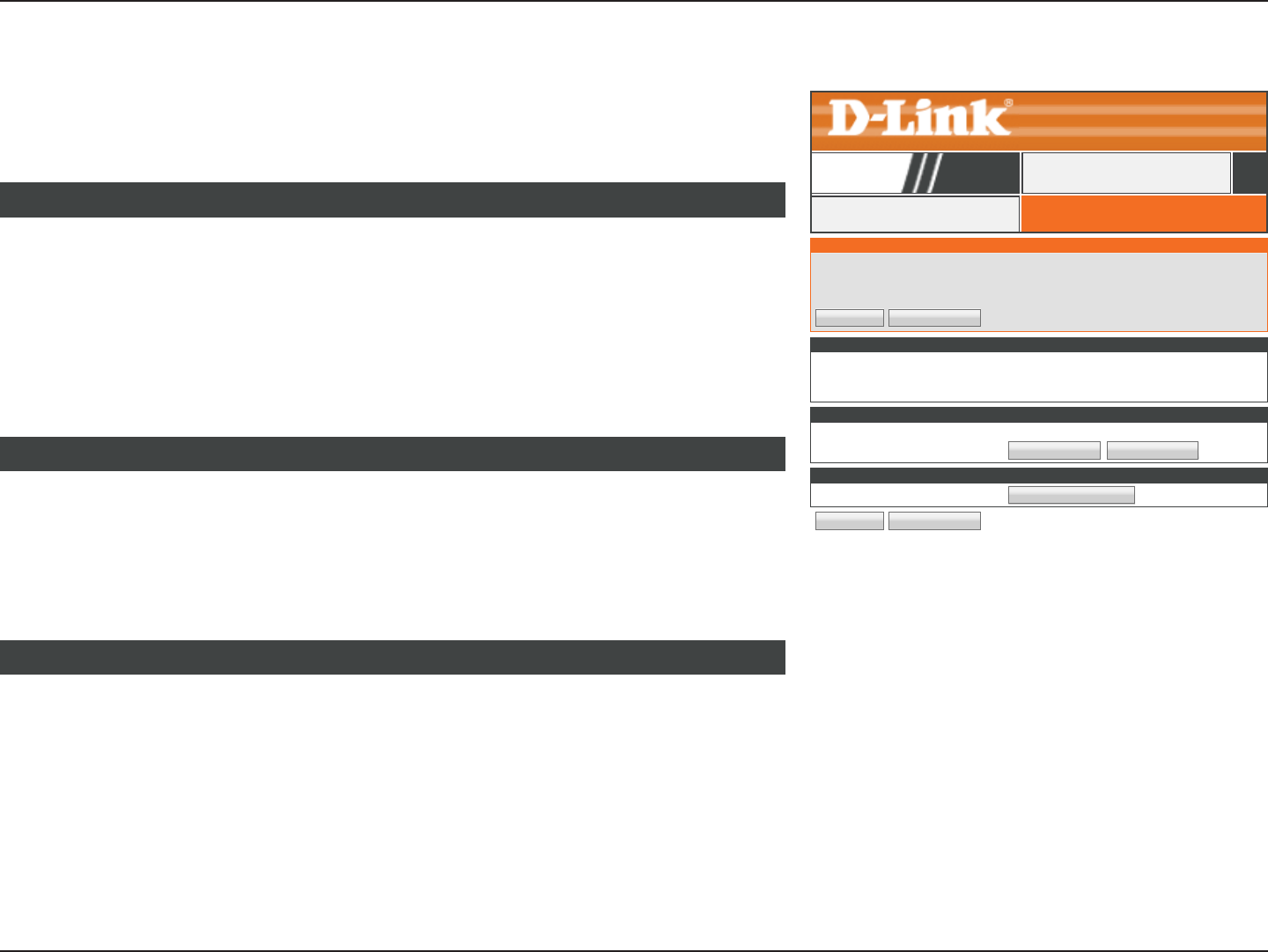
96D-Link DIR-819 User Manual
Section 3 - Conguration
Save Settings Don’t Save Settings
Wi-Fi Protected Setup
WI-FI PROTECTED SETUPWI-FI PROTECTED SETUP
DIR-819 ADVANCED
Enable: Check the box to enable WPS.
WiFi Protected
Setup:
The current status of the WPS feature is displayed here.
Lock WPS-PIN
Setup:
Enable or disable WPS-PIN functionality.
WIFI PROTECTED SETUP
PIN: The currently dened WPS-PIN is displyaed here.
Reset PIN to Default Click this button to reset the WPS-PIN to the factory default.
Generate New PIN Click this button to generate a new WPS PIN.
PIN SETTINGS
Connect your
Wireless Device:
Click this button to launch the WPS Add Device Wizard. Refer to Add
Wireless Device with WPS on page 47 for more information.
Click the Save Settings button when you are nished.
ADD WIRELESS STATION
WI-FI PROTECTED SETUP
Wi-Fi Protected Setup is used to easily add devices to a network using a PIN or button press. Devices must support Wi-Fi Protected
Setup in order to be congured by this method.
If the PIN changes, the new PIN will be used in following Wi-Fi Protected Setup process. Clicking on ''Don't Save Settings'' button will
not reset the PIN.
However, if the new PIN is not saved, it will get lost when the device reboots or loses power.
Save Settings Don’t Save Settings
PIN SETTINGS
PIN : 49445183
Reset PIN to Default Generate New Pin
ADD WIRELESS STATION
Connect your Wireless Device
WI-FI PROTECTED SETUP
Enable : ☑
WiFi Protected Setup : Enabled/Congured
Lock WPS-PIN Setup : ☐
Click Wi-Fi Protected Setup on the navigation menu to congure the Wi-Fi Protected Setup
(WPS) feature. Refer to WPS Button on page 122 for more information about WPS. When
you are satised with your conguration, click Save Settings.
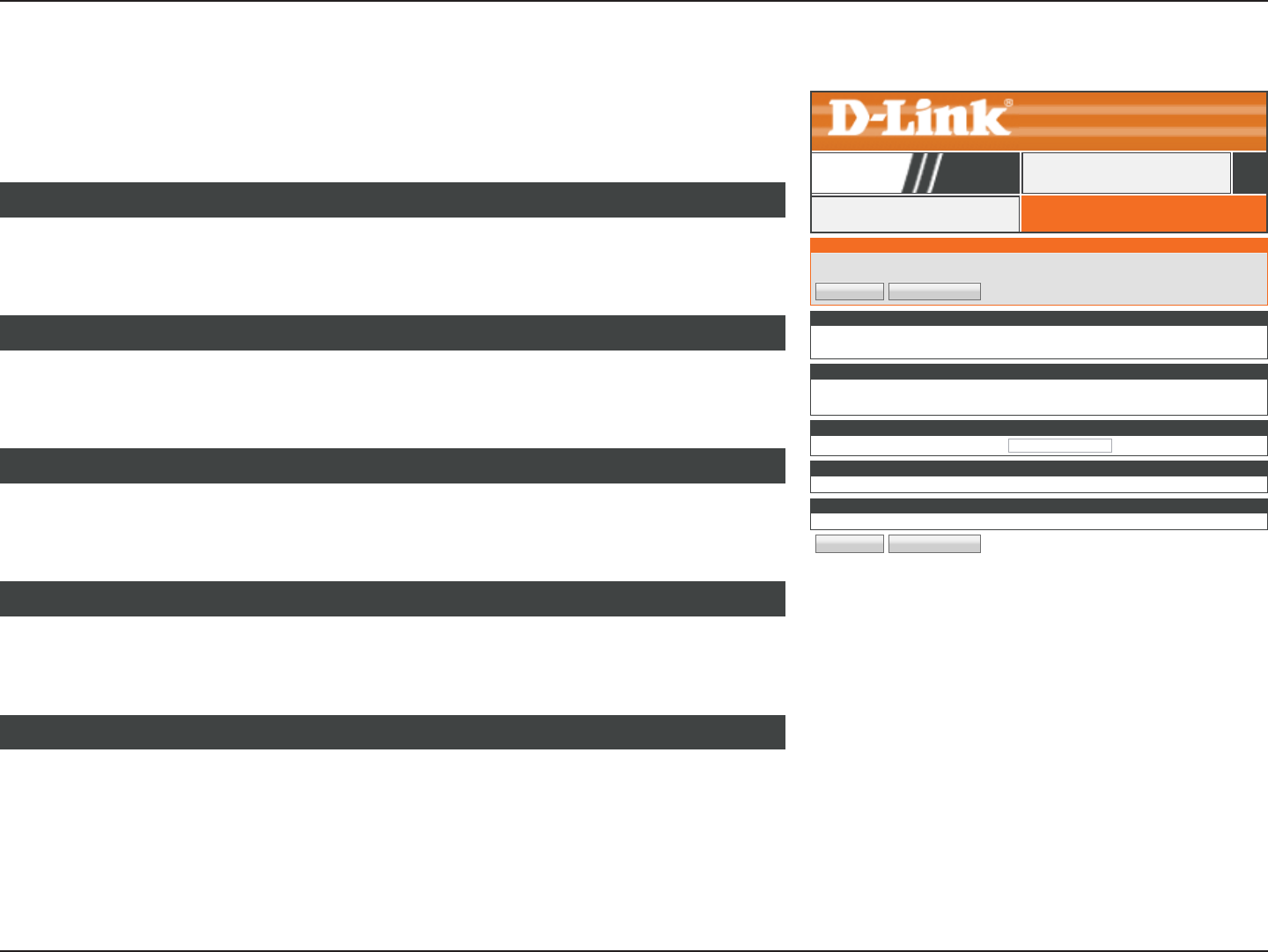
97D-Link DIR-819 User Manual
Section 3 - Conguration
Save Settings Don’t Save Settings
Advanced Network
ADVANCED NETWORK SETTINGSADVANCED NETWORK
DIR-819 ADVANCED
Click Advanced Network on the navigation menu to congure the Advanced Wireless
settings. This page allows for the conguration of miscillaneous settings. When you are
satised with your conguration, click Save Settings.
Enable UPnP IGD: Click Enable to use the UPnP feature. UPnP provides compatibility
with networking equipment, software, and peripherals.
UPNP
ADVANCED NETWORK SETTINGS
These options are for users that wish to change the LAN settings. We do not recommend changing these settings from factory default.
Changing these settings may affect the behavior of your network.
Save Settings Don’t Save Settings
UPNP
Universal Plug and Play(UPnP) supports peer-to-peer Plug and Play functionality for network devices.
Enable UPnP IGD : ☐
WAN PING
If you enable this feature, the WAN port of your router will respond to ping requests from the Internet that are sent to the WAN IP
Address.
Enable WAN Ping Response : ☐
WAN PORT SPEED
WAN Port Speed : Auto 10/100Mbps ▼
MULTICAST STREAMS
Enable Multicast Streams : ☐
IPV6 MULTICAST STREAMS
Enable IPv6 Multicast Streams : ☐
Enable WAN Ping
Response:
Enable or disable the router to reply to pings.
WAN PING
WAN Port Speed: You may set the port speed of the Internet port to 10 Mbps, 100 Mbps,
or Auto 10/100Mbps. Using Auto 10/100Mbps is recommended.
WAN PORT SPEED
Enable Multicast
Streams:
Enable to allow IPv4 multicast trac to pass through the router from
the Internet.
MULTICAST STREAMS
Enable IPv6
Multicast Streams:
Enable to allow IPv6 multicast trac to pass through the router from
the Internet.
Click the Save Settings button when you are nished.
IPV6 MULTICAST STREAMS
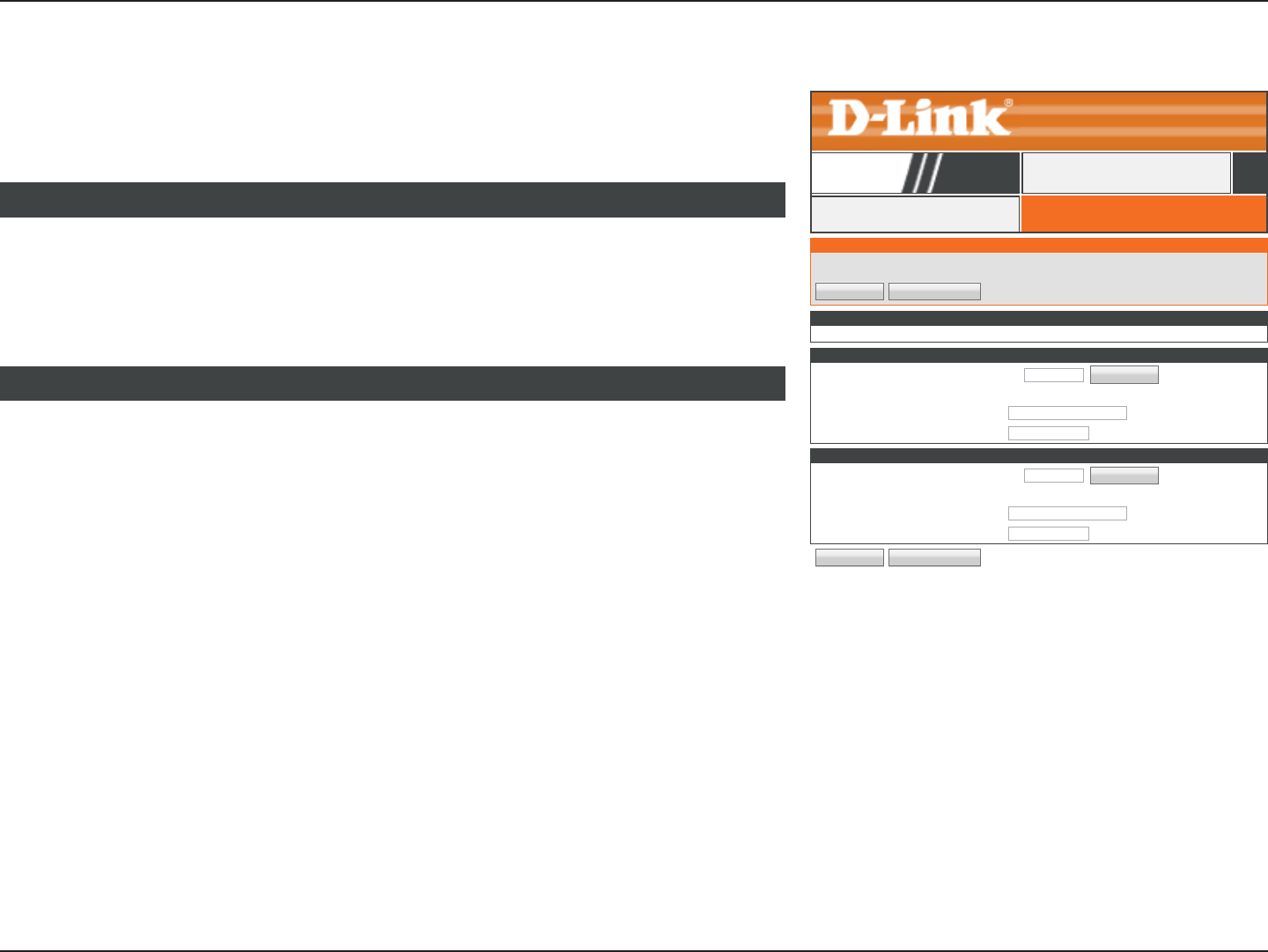
98D-Link DIR-819 User Manual
Section 3 - Conguration
Save Settings Don’t Save Settings
Guest Zone
GUEST ZONEGUEST ZONE
DIR-819 ADVANCED
Click Guest Zone on the navigation menu to congure Guest Zones. The guest zone feature
allows you to create wireless networks for visitors. This allows you to keep your devices
secure. When you are satised with your conguration, click Save Settings.
Enable Routing
Between Zones:
If a guest zone or zones are enabled and this option is disabled, guest
device network connectivity is restricted to the Internet. If this option
is enabled, guest devices are allowed access to other local network
devices.
GUEST ZONE
Enable Guest Zone: Enable or disable this guest wireless network. From the drop down
menu you may apply a schedule to enable or disable this wireless
network. Click New Schedule to create a new schedule. Refer to
Schedules on page 110 for more information.
Wireless Band: The current wireless band is displayed here, either 2.4GHz or 5GHz.
Wireless Network
Name:
Create a name for your wireless network.
Security Mode: Select a wireless security encryption option. The options are
None, WEP, WPA-Personal, and WPA-Enterprise. Using WPA is
recommended. Refer to Wireless Security Mode on page 52 for
more information.
Click the Save Settings button when you are nished.
SESSION 2.4GHZ / SESSION 5GHZ
GUEST ZONE
Use this section to congure the guest zone settings of your router. The guest zone provide a separate network zone for guest to
access Internet.
Save Settings Don’t Save Settings
SESSION 2.4GHZ
Enable Guest Zone : ☑Always ▼New Schedule
Wireless Band : 2.4GHz Band
Wireless Network Name : (Also called the SSID)
Security Mode : None ▼
SESSION 5GHZ
Enable Guest Zone : ☑Always ▼New Schedule
Wireless Band : 5GHz Band
Wireless Network Name : (Also called the SSID)
Security Mode : None ▼
GUEST ZONE
Enable Routing Between Zones : ☑
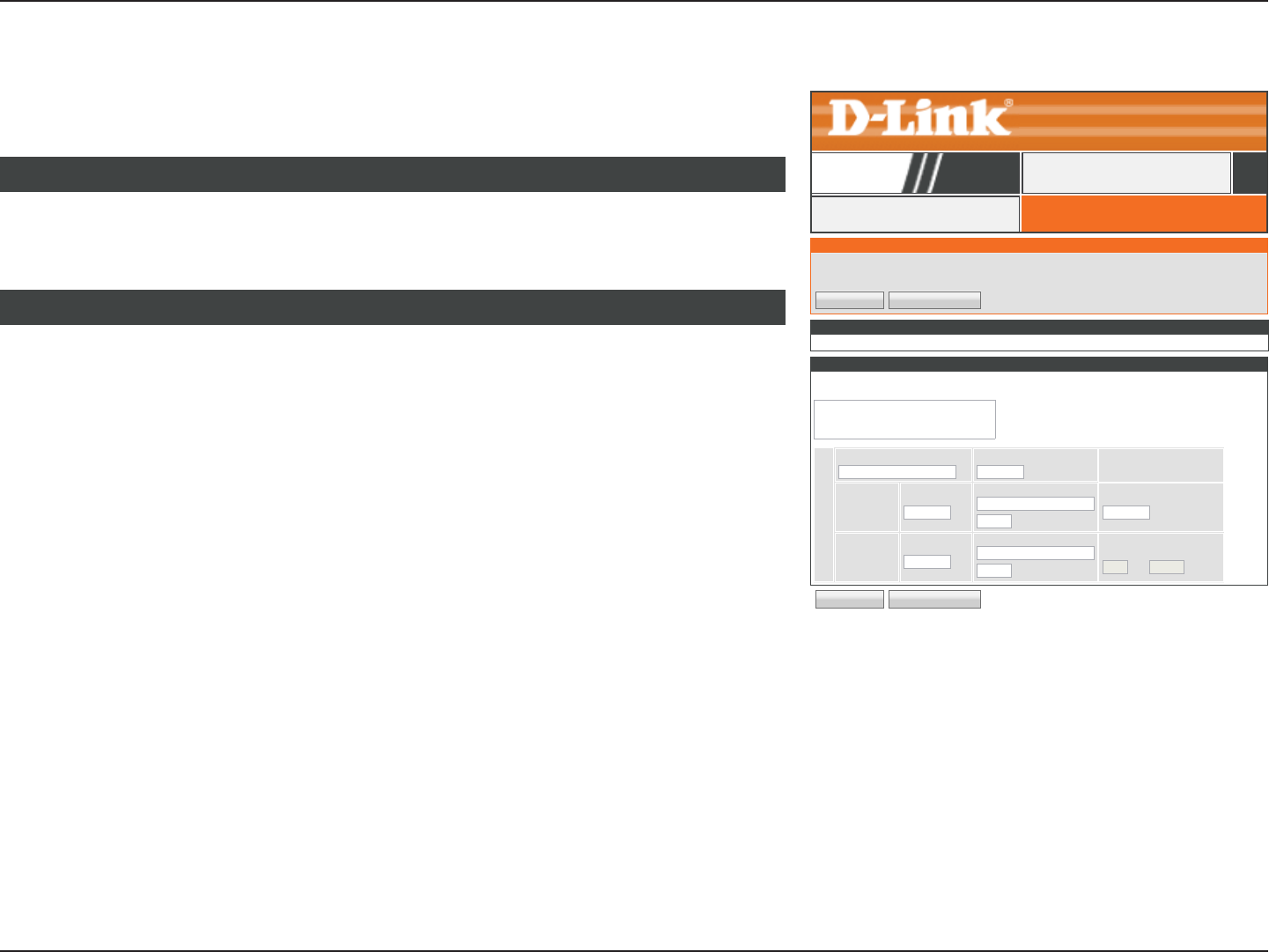
99D-Link DIR-819 User Manual
Section 3 - Conguration
Save Settings Don’t Save Settings
IPv6 Firewall
IPV6 FIREWALLIPV6 FIREWALL
DIR-819 ADVANCED
Click IPv6 Firewall on the navigation menu to congure the IPv6 Firewall Settings. When
you are satised with your conguration, click Save Settings.
Enable IPv6 Simple
Security:
Enable or disable the IPv6 rewall.
IPV6 SIMPLE SECURITY
Congure IPv6
Filtering below:
Select the function of the IPv6 Filter, the options are Turn IPv6
Filtering OFF, Turn IPv6 Filtering ON and ALLOW rules listed, Turn
IPv6 Filtering ON and DENY rules listed.
Enable: Check the box to enable this rule.
Name: Enter a name for the rule.
Schedule: Select the schedule from the drop-down menu. The default is Always.
Refer to Schedules on page 110 for more information on creating
new schedules.
Source Interface: Select the source interface, WAN or LAN, from the drop down menu.
Source IP Address /
PrexLength:
Enter the source IP address and specify the prex length for the rule.
Protocol: Select the protocol to apply the rule to, either ALL, TCP, UDP, or ICMP.
Destination
Interface:
Select the destination interface, WAN or LAN, from the drop down
menu.
20 IPV6 FIREWALL RULES
IPV6 FIREWALL
The rewall settings section is an advance feature used to allow or deny trafc from passing through the device. It works in the same
way as IP Filters with additional settings. You can create more detailed rules for the device.
Save Settings Don’t Save Settings
20 -- IPV6 FIREWALL RULES
Remaining number of rules that can be created: 24
Congure IPv6 Filtering below:
Turn IPv6 Filtering OFF ▼
Turn IPv6 Filtering ON and ALLOW rules listed
Turn IPv6 Filtering ON and DENY rules listed
☐
Name Schedule
Always ▼
Source
Interface
LAN ▼
IP Address /PrexLength
Protocol
ALL ▼
Dest
Interface
LAN ▼
IP Address /PrexLength
Port Range
~
IPV6 SIMPLE SECURITY
Enable IPv6 Simple Security : ☐
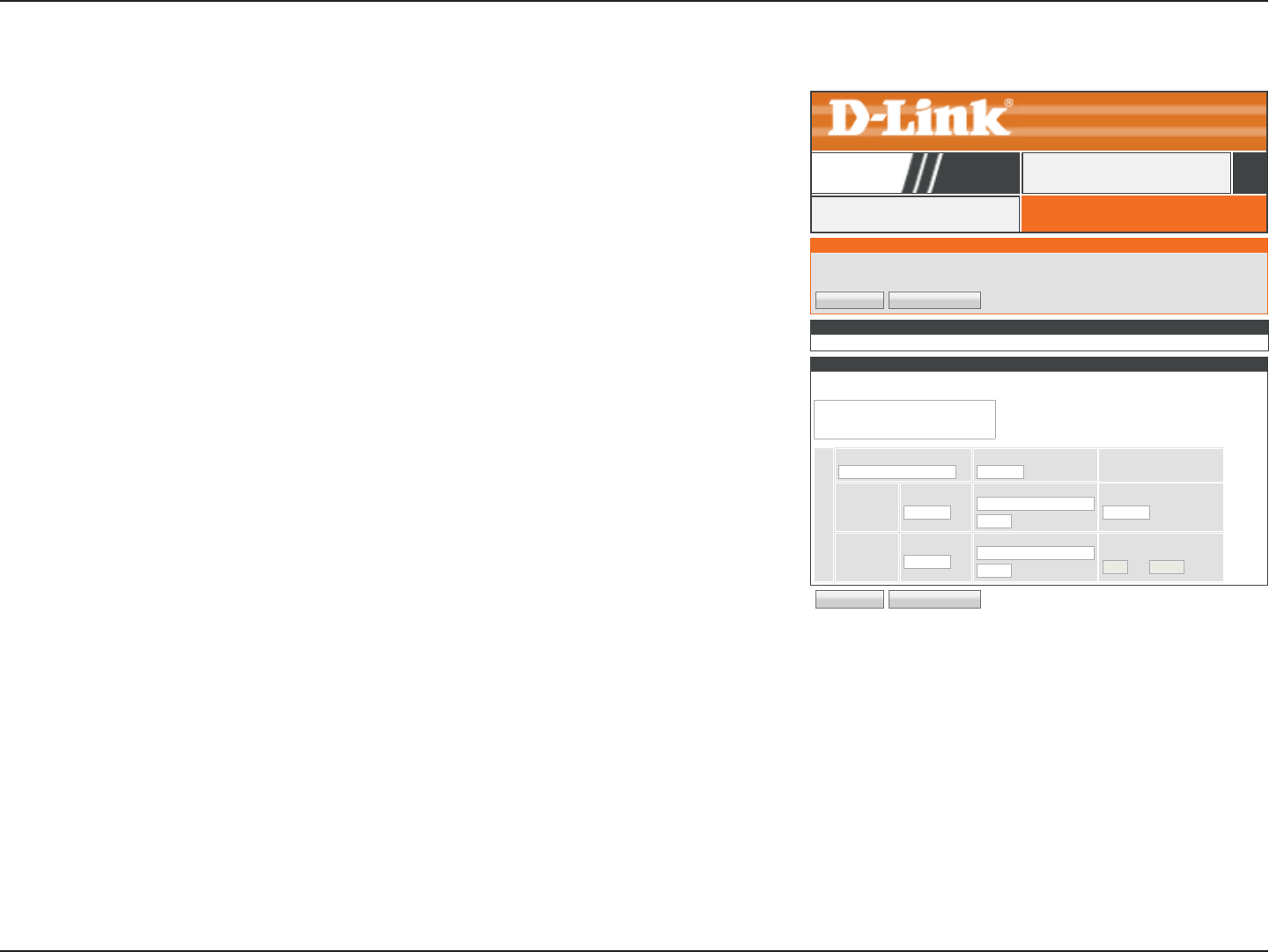
100D-Link DIR-819 User Manual
Section 3 - Conguration
Destination
IP Address /
PrexLength:
Enter the destination IP address and specify the prex length for the
rule.
Port Range: Enter the port range to apply the rule to. If the protocol is set as ALL
or ICMP this feature is disabled.
Click the Save Settings button when you are nished.
Save Settings Don’t Save Settings
IPV6 FIREWALLIPV6 FIREWALL
DIR-819 ADVANCED
IPV6 FIREWALL
The rewall settings section is an advance feature used to allow or deny trafc from passing through the device. It works in the same
way as IP Filters with additional settings. You can create more detailed rules for the device.
Save Settings Don’t Save Settings
20 -- IPV6 FIREWALL RULES
Remaining number of rules that can be created: 24
Congure IPv6 Filtering below:
Turn IPv6 Filtering OFF ▼
Turn IPv6 Filtering ON and ALLOW rules listed
Turn IPv6 Filtering ON and DENY rules listed
☐
Name Schedule
Always ▼
Source
Interface
LAN ▼
IP Address /PrexLength
Protocol
LAN ▼
Dest
Interface
LAN ▼
IP Address /PrexLength
Port Range
~
IPV6 SIMPLE SECURITY
Enable IPv6 Simple Security : ☐
IPv6 Firewall (continued)
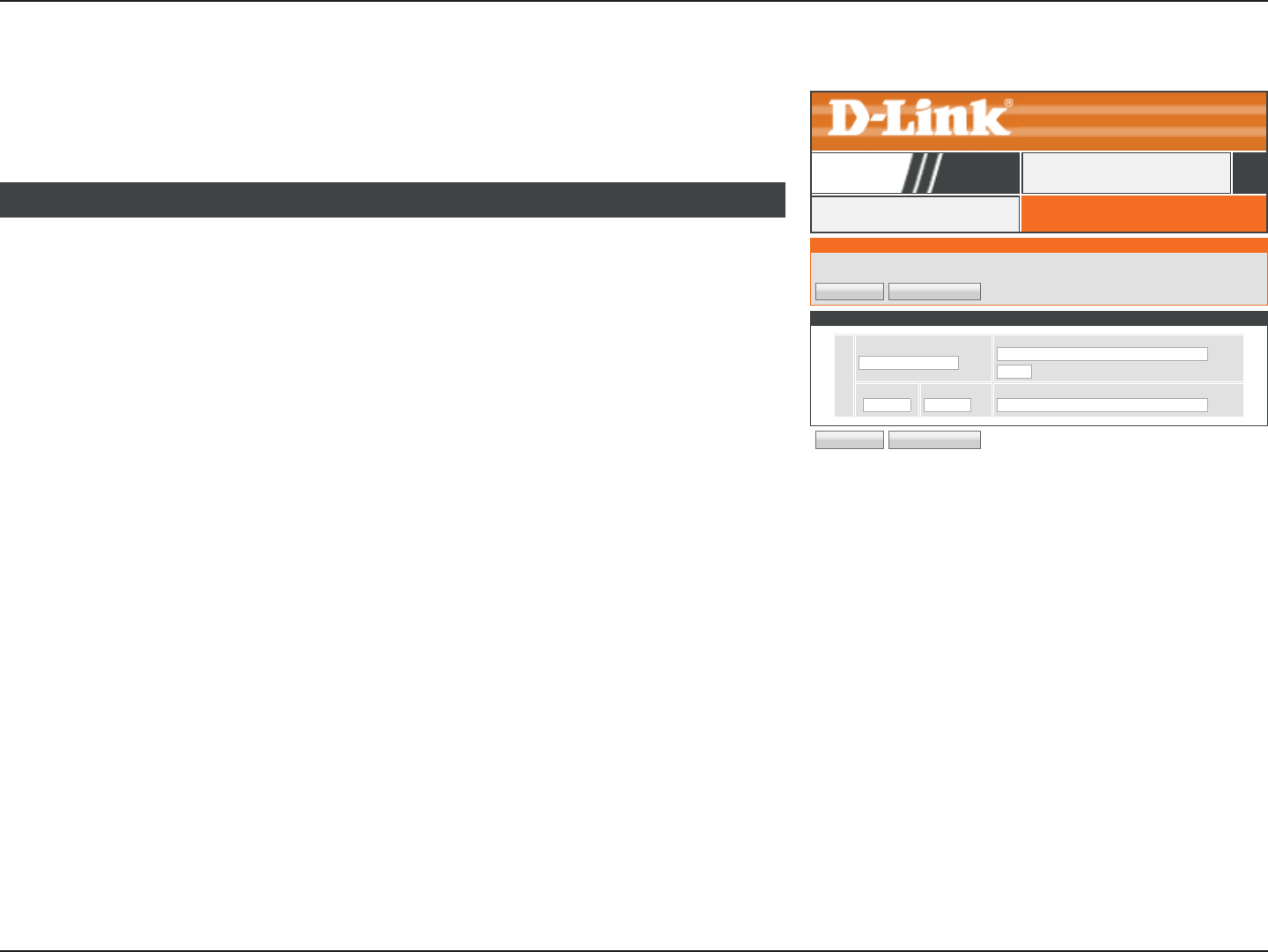
101D-Link DIR-819 User Manual
Section 3 - Conguration
Save Settings Don’t Save Settings
IPv6 Routing
ROUTINGIPV6 ROUTING
DIR-819 ADVANCED
ROUTING
This Routing page allows you to specify custom routes that determine how data is moved around your network.
Save Settings Don’t Save Settings
10 -- ROUTE LIST
☐
Name
Destination IPv6 / Prex Length
/
Metric
256
Interface
NULL ▼
Gateway
Enable: Check the box to enable this rule.
Name: Enter a name for this IPv6 static route.
Destination IPv6 /
Prex Length:
Enter the destination IPv6 address and Prex Length.
Metric: Enter the metric value between 1-255.
Interface: Select the Interface from the drop-down menu.
Gateway: Enter the gateway IPv6 address.
Click the Save Settings button when you are nished.
10 ROUTE LIST
Click IPv6 Routing on the navigation menu to congure IPv6 Routing. The routing page
allows you to dene custom static routes to control the route which your data takes. When
you are satised with your conguration, click Save Settings.
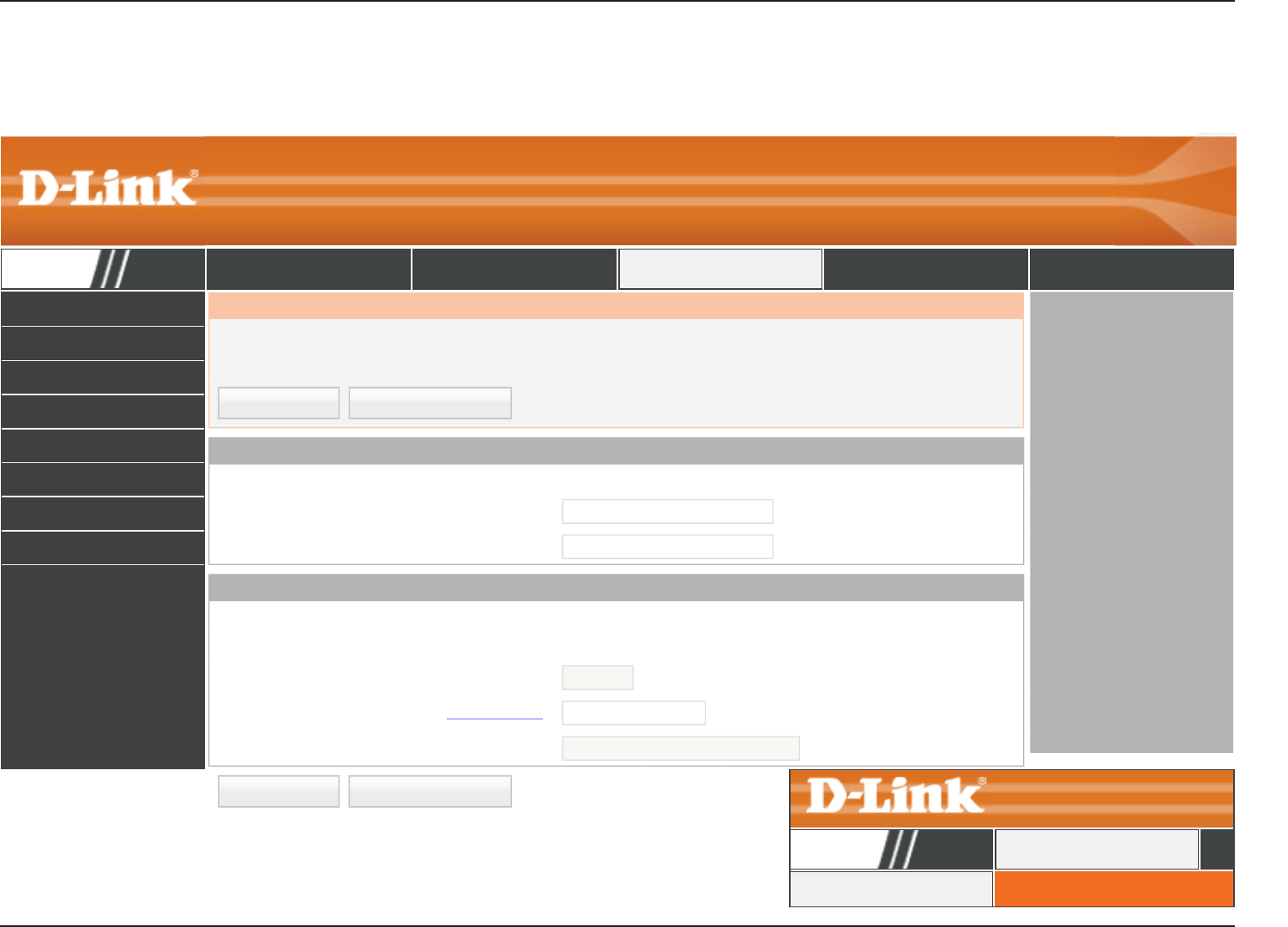
102D-Link DIR-819 User Manual
Section 3 - Conguration
Tools
ADMIN
TIME
SYSLOG
SYSTEM
FIRMWARE
DYNAMIC DNS
SYSTEM CHECK
SCHEDULES
To return to this Web UI Table of Contents page, simply click the D-Link logo on the top
right of each page. INTERNET CONNECTIONINTERNET
DIR-819 SETUP
The Tools tab provides access to administration related settings of your DIR-819.
DIR-819 SETUP ADVANCED TOOLS STATUS SUPPORT
Save Settings Don’t Save Settings
ADMINISTRATOR SETTINGS
The 'admin' account can access the management interface. The admin has read/write access and can change password.
By default there is no password congured. It is highly recommended that you create a password to keep your router secure.
Save Settings Don’t Save Settings
ADMIN PASSWORD
Please enter the same password into both boxes, for conrmation.
Password :
Verify Password :
ADMINISTRATION
Enable HTTPS Server : ☐
Enable Remote Management : ☐
Remote Admin Port : 8080 Use HTTPS: ☐
Remote Admin Inbound Filter : Allow All ▼
Details : Allow All
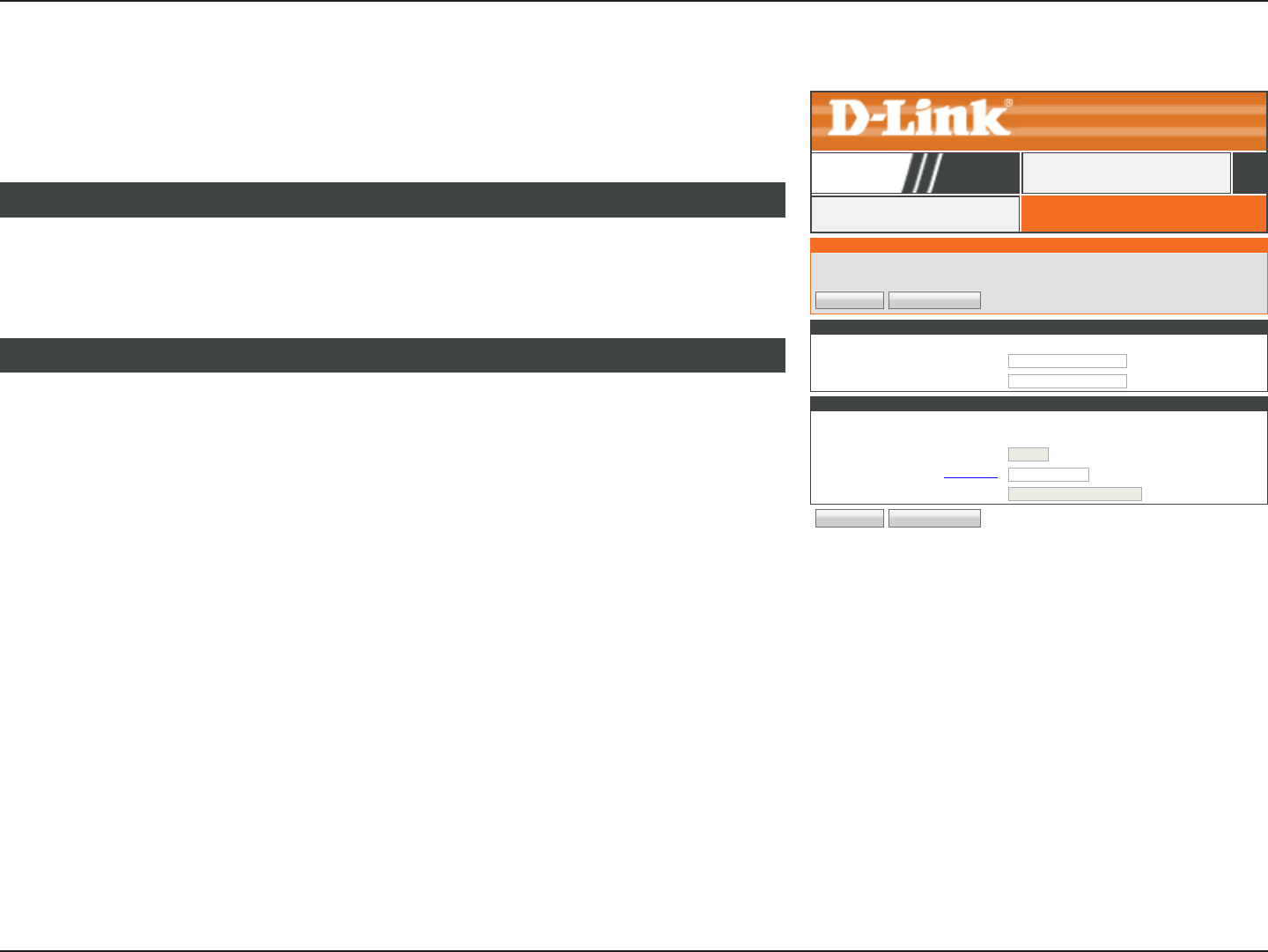
103D-Link DIR-819 User Manual
Section 3 - Conguration
Save Settings Don’t Save Settings
Admin
ADMINISTRATOR SETTINGSADMIN
DIR-819 TOOLS
Click Admin on the navigation menu to congure the administration settings. This page
allows you to congure access to the web conguration utility. When you are satised with
your conguration, click Save Settings.
Password: Enter the new password for the admin account.
Verify Password: Enter the new password for the admin account one more time.
ADMIN PASSWORD
Enable HTTPS
Server::
Check to enable HTTPS to connect to the router securely. You may
access the web conguration utility using https://dlinkrouter.local./.
Enable Remote
Management:
Remote management allows the DIR-819 to be congured from the
Internet by a web browser. A password is still required to access the
web management interface.
Remote Admin
Port:
Enter the port number you wish to use to access the DIR-819’s web
conguration utility. Example: http://x.x.x.x:8080 where x.x.x.x is
the Internet IP address of the DIR-819 and 8080 is the port used for
the web management interface.
Note: If you enabled HTTPS Server and wish to access the router remotely
and securely, you may enter https:// at the beginning of the address.
Remote Admin
Inbound Filter:
You may select an inbound lter from the drop down menu to restrict
remote administration. Refer to Inbound Filter on page 86 for
more information.
Details: The current status of the Remote Administration Inbound lter is
displayed here.
Click the Save Settings button when you are nished.
ADMINISTRATION
ADMINISTRATOR SETTINGS
The 'admin' account can access the management interface. The admin has read/write access and can change password.
By default there is no password congured. It is highly recommended that you create a password to keep your router secure.
Save Settings Don’t Save Settings
ADMIN PASSWORD
Please enter the same password into both boxes, for conrmation.
Password :
Verify Password :
ADMINISTRATION
Enable HTTPS Server : ☐
Enable Remote Management : ☐
Remote Admin Port : 8080 Use HTTPS: ☐
Remote Admin Inbound Filter : Allow All ▼
Details : Allow All
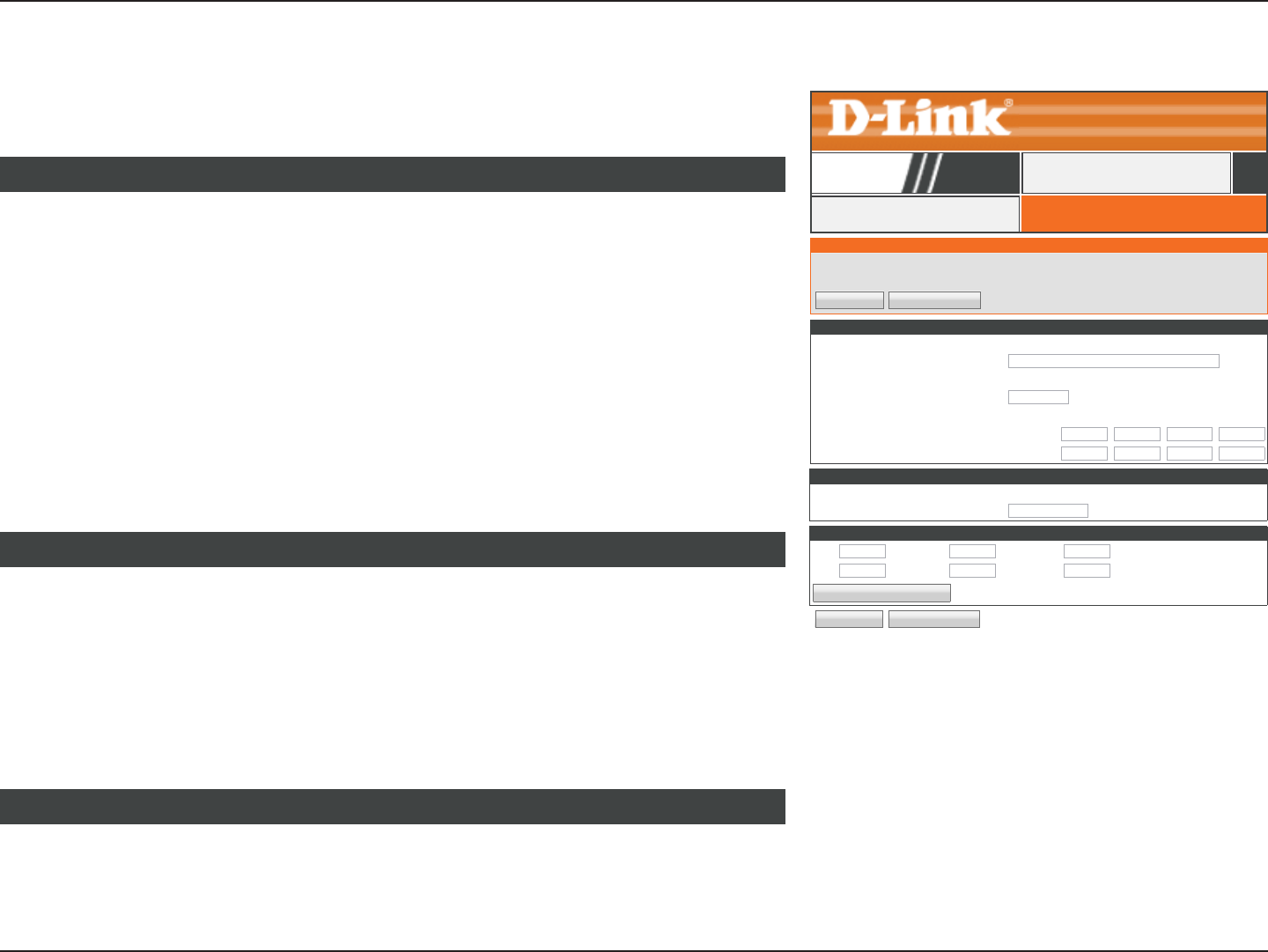
104D-Link DIR-819 User Manual
Section 3 - Conguration
Time
TIME AND DATETIME
DIR-819 TOOLS
Click Time on the navigation menu to congure the time. When you are satised with your
conguration, click Save Settings.
Time: The currently set time on the router is displayed.
Time Zone: Displays the current date and time of the router.
Enable Daylight
Saving:
Enable or disable daylight saving time.
Daylight Saving
Oset:
Select the daylight saving oset if Daylight Saving time will be used.
Daylight Saving
Dates:
Select the date range for when to start and stop daylight savings time.
TIME AND DATE CONFIGURATION
TIME AND DATE
The Time and Date Conguration option allows you to congure, update, and maintain the correct time on the internal system clock.
From this section you can set the time zone you are in and set the NTP (Network Time Protocol) Server. Daylight Saving can also be
congured to adjust the time when needed.
Save Settings Don’t Save Settings
TIME AND DATE CONFIGURATION
Time : 2016-09-19 12:00:00
Time Zone : (GMT+08:00) Taipei ▼
Enable Daylight Saving : ☑
Daylight Saving Offset : -02:00 ▼
Daylight Saving Dates : Month Week Day of Week Time
DST Start Mar ▼2nd ▼Sun ▼2 am ▼
DST End Nov ▼1st ▼Sun ▼2 am ▼
Save Settings Don’t Save Settings
AUTOMATIC TIME AND DATE CONFIGURATION
☑ Automatically synchronize with D-Link’s Internet time server
NTP Server Used : ntp1.dlink.com ▼
SET THE TIME AND DATE MANUALLY
Year 2016 ▼Month Sep ▼Day 19 ▼
Hour 4▼Minute 6▼Second 59 ▼
Sync. your computer’s time settings
Automatically
synchronize with
D-Link’s Internet
time server:
Enable this option to get the current time from an NTP server on the
Internet. To congure the router's time and date manually, disable
this option and use the drop-down menus that appear to input the
time and date.
NTP Server Used: If you enable this option, select an NTP server from the drop-down
menu.
AUTOMATIC TIME AND DATE CONFIGURATION
You may manually set the time from this option or set the time by clicking Sync. your
computer’s time settings.
Click the Save Settings button when you are nished.
SET THE TIME AND DATE MANUALLY
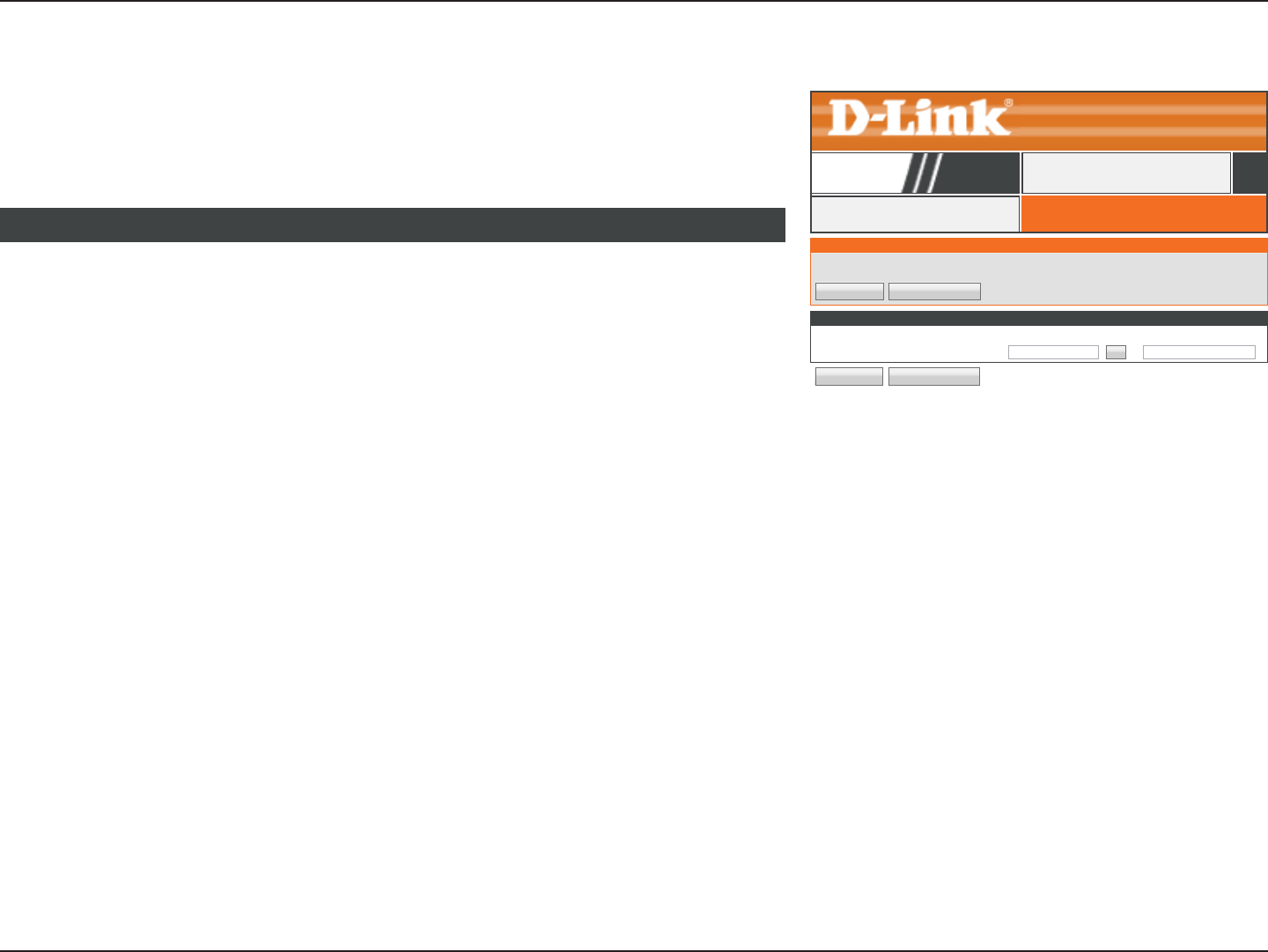
105D-Link DIR-819 User Manual
Section 3 - Conguration
Syslog
SYSLOGSYSLOG
DIR-819 TOOLS
Click Syslog on the navigation menu to congure the system log settings. This device
maintains a running log of events which can be sent to a syslog server. Refer to Logs on
page 114 for an example system log. When you are satised with your conguration, click
Save Settings.
Enable Logging to
SysLog Server:
Enable or disable the sending of router logs to a syslog server.
If you enable Logging to SysLog Server, enter the Syslog Server IP Address:
SysLog Server IP
Address:
Enter the IP address of the syslog server. Use the Computer Name
dropdown menu and the << button to quickly select a device. The
IP address is automatically populated.
Click the Save Settings button when you are nished.
SYSLOG SETTINGS
SYSLOG
The SysLog options allow you to send log information to a Syslog Server.
Save Settings Don’t Save Settings
Save Settings Don’t Save Settings
SYSLOG SETTINGS
Enable Logging To SysLog Server: ☑
Syslog Server IP Address: << Computer Name ▼
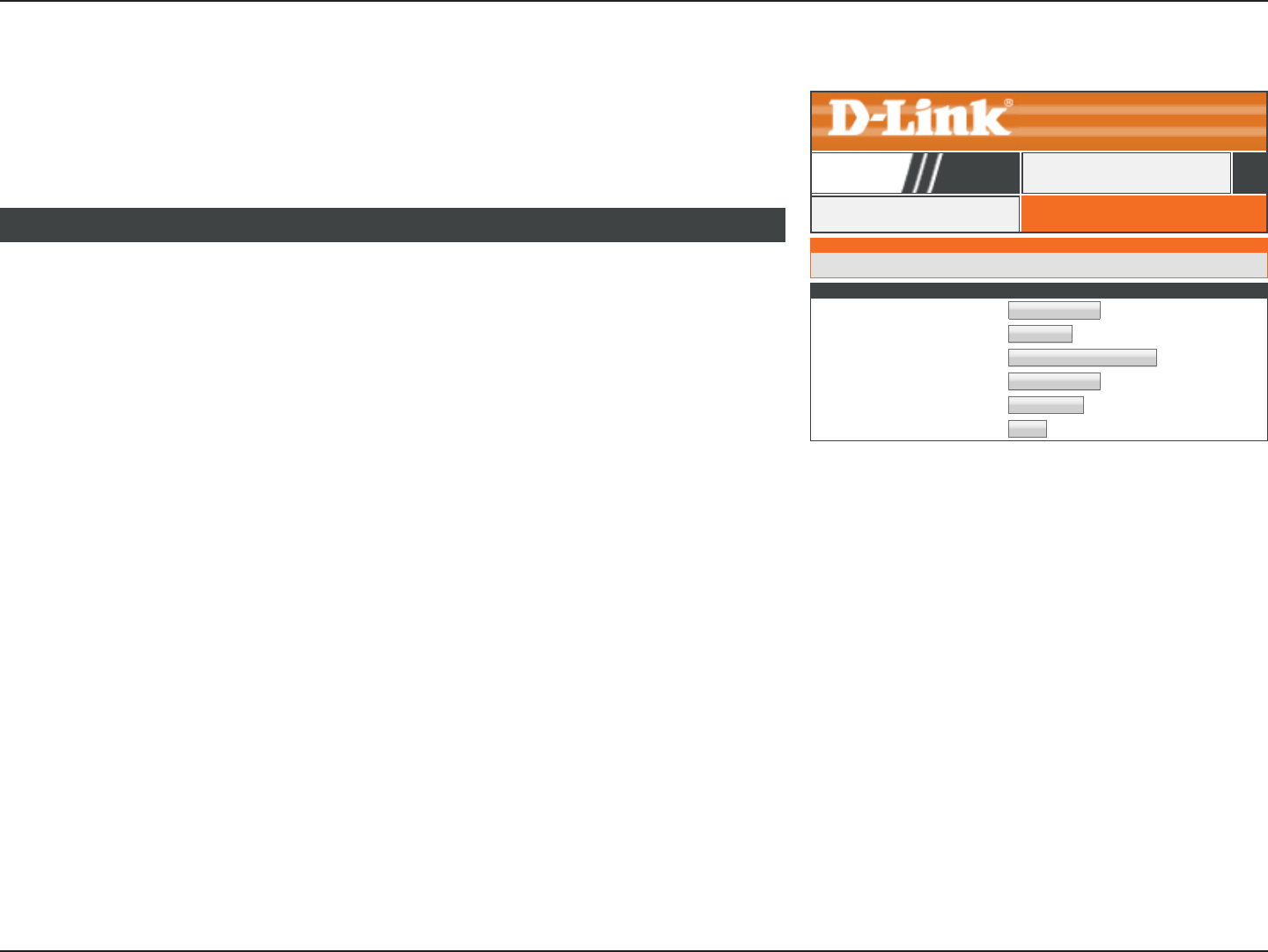
106D-Link DIR-819 User Manual
Section 3 - Conguration
System
SAVE AND RESTORE SETTINGSSYSTEM
DIR-819 TOOLS
Click System on the navigation menu to congure the system settings. This section allows
you to manage the router’s conguration settings, reboot the router, and restore the router
to the factory default settings. Restoring the unit to the factory default settings will erase
all settings, including any rules that you’ve created.
Save Settings To
Local Hard Drive:
Use this option to save the current router conguration settings to
a le on the hard disk of the computer you are using. Click the Save
Conguration button. A le dialog will appear, allowing you to select
a location and le name for the settings.
Load Settings From
Local Hard Drive:
Use this option to load previously saved router configuration
settings. Use the Choose File option to nd a previously saved le
of conguration settings and then click the Restore Conguration
From File to transfer those settings to the router.
Restore To Factory
Default Settings:
This option will restore all conguration settings back to the settings
that were in eect at the time the router was shipped from the factory.
Any settings that have not been saved will be lost, including any
rules that you have created. If you want to save the current router
conguration settings, use the Save button above.
Reboot The Device: Click this button to reboot the device.
Clear Language
Pack:
If the device is of other language than English, clicking this button
to convert the router’s language back to English.
SAVE AND RESTORE SETTINGS
SAVE AND RESTORE SETTINGS
Once the router is congured you can save the conguration settings to a conguration le on your hard drive. You also have the
option to load conguration settings, or restore the factory default settings.
SAVE AND RESTORE SETTINGS
Save Settings To Local Hard Drive : Save Conguration
Load Settings From Local Hard Drive : Choose File No le chosen
Restore Conguration From File
Restore To Factory Default Settings : Restore Factory Defaults
Reboot The Device : Reboot the Device
Clear Language Pack : Clear
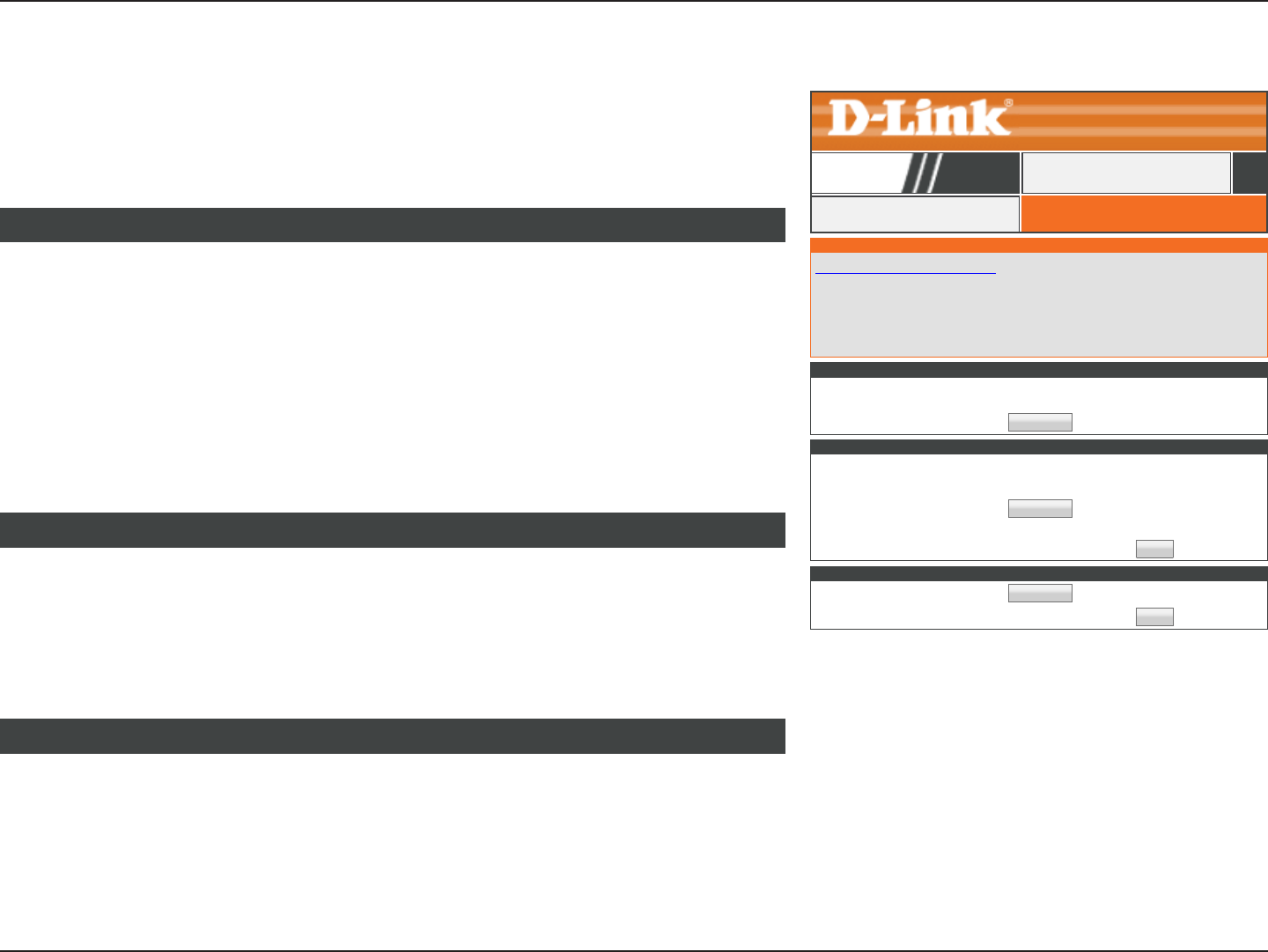
107D-Link DIR-819 User Manual
Section 3 - Conguration
Firmware
FIRMWARE UPDATEFIRMWARE
DIR-819 TOOLS
Click Firmware on the navigation menu to configure the firmware. Please check
the D-Link support website for firmware updates and new language packs at
http://support.dlink.com. Be sure to keep your router rmware updated to help protect
against the latest cyber threats.
Current Firmware
Version:
The current rmware version is displayed here.
Current Firmware
Time:
The release date and time of the current rmware is displayed here.
Check Online Now
for Latest Firmware
Version:
Click this button to prompt the router to check for a new rmware
version.
FIRMWARE INFORMATION
Upload: Select a le to upgrade your device with by clicking the Choose File
button. Click the Upload button to begin the rmware upgrade.
Clear Cong: Check this box to clear the current settings of your DIR-819 once the
rmware update is applied.
FIRMWARE UPGRADE
Upload: You can change the language of the web UI by uploading language
packs. Select a le to upgrade your device with by clicking the Choose
File button. Click the Upload button to begin the rmware upgrade.
Click the Save Settings button when you are nished.
LANGUAGE PACK UPGRADE
FIRMWARE UPDATE
There may be new rmware for your router to improve functionality and performance.
Click here to check for an upgrade on our support site.
To upgrade the rmware, locate the upgrade le on the local hard drive with the Browse button. Once you have found the le to be
used, click the Upload button to start the rmware upgrade.
The language pack allows you to change the language of the user interface on the router. We suggest that you upgrade your current
language pack if you upgrade the rmware. This ensures that any changes in the rmware are displayed correctly.
To upgrade the language pack, locate the upgrade le on the local hard drive with the Browse button. Once you have found the le to
be used, click the Upload button to start the language pack upgrade.
SAVE AND RESTORE SETTINGS
Current Firmware Version : V1.01
Current Firmware Time : Sep-29-2016T21:40:49
Check Online Now for Latest Firmware Version : Check Now
LANGUAGE PACK UPGRADE
Upload : Choose File No le chosen
Upload
FIRMWARE UPGRADE
Note: Some rmware upgrades reset the conguration options to the factory defaults. Before performing an upgrade,
be sure to save the current conguration.
To upgrade the rmware, your PC must have a wired connection to the router. Enter the name of the rmware upgrade
le, and click on the Upload button.
Upload : Choose File No le chosen
Clear Cong : ☐
Upload
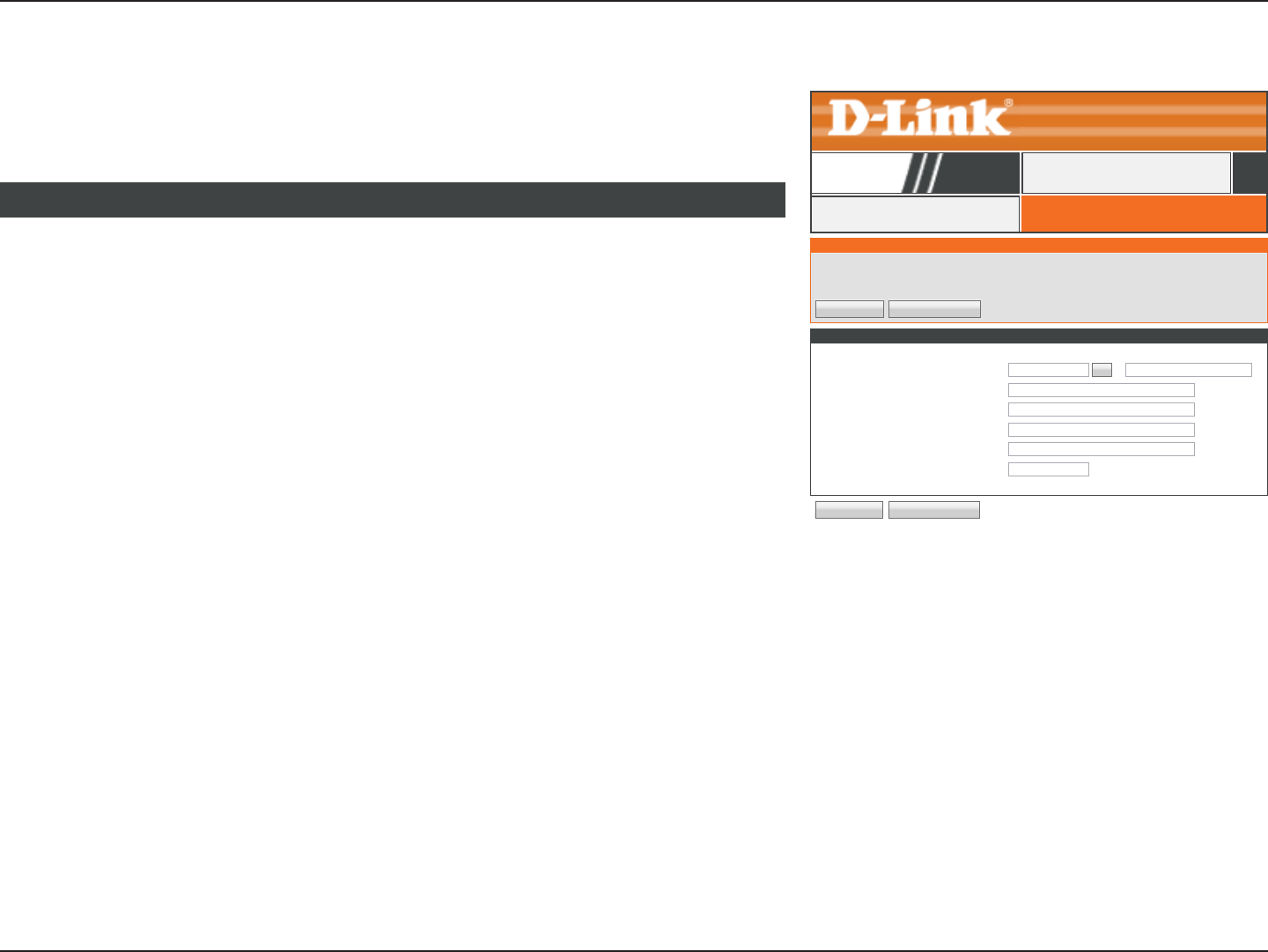
108D-Link DIR-819 User Manual
Section 3 - Conguration
Dynamic DNS
DYNAMIC DNSDYNAMIC DNS
DIR-819 TOOLS
Click Dynamic DNS on the navigation menu to congure the Dynamic Domain Name Server
(DDNS) client. DDNS makes accessing your network from the Internet easier by providing
you with an easy to use web address. Owners of D-Link routers can use the dlinkdns service.
Enable Dynamic
DNS:
Enable or disable the Dynamic DNS feature.
If you enabled Dynamic DNS, congure the following settings:
Server Address: Enter the IP address of your DDNS provider. Use the Select Dynamic
DNS Server dropdown menu and the << button to quickly select a
device. The IP address is automatically populated.
Host Name: Enter the host name that you registered with your DDNS service
provider.
Username: Enter your DDNS username.
Password: Enter your DDNS password.
Verify Password: Enter your DDNS password one more time.
Timeout: Enter a timeout time (in hours) before the DDNS information is
automatically updated.
Status: The current status of your DDNS service is displayed here.
Click the Save Settings button when you are nished.
DYNAMIC DNS SETTINGS
DYNAMIC DNS
The Dynamic DNS feature allows you to host a server (Web, FTP, Game Server, etc...) using a domain name that you have purchased
(www.whateveryournameis.com) with your dynamically assigned IP address. Most broadband Internet Service Providers assign
dynamic (changing) IP addresses. Using a DDNS service provider, your friends can enter your host name to connect to your game
server no matter what your IP address is.
Save Settings Don’t Save Settings
DYNAMIC DNS SETTINGS
Enable Dynamic DNS : ☑
Server Address : << Select Dynamic DNS Server ▼
Host Name :
Username :
Password : ···
Verify Password : ···
Timeout : 576 (Times)
Status : Disconnected
Save Settings Don’t Save Settings
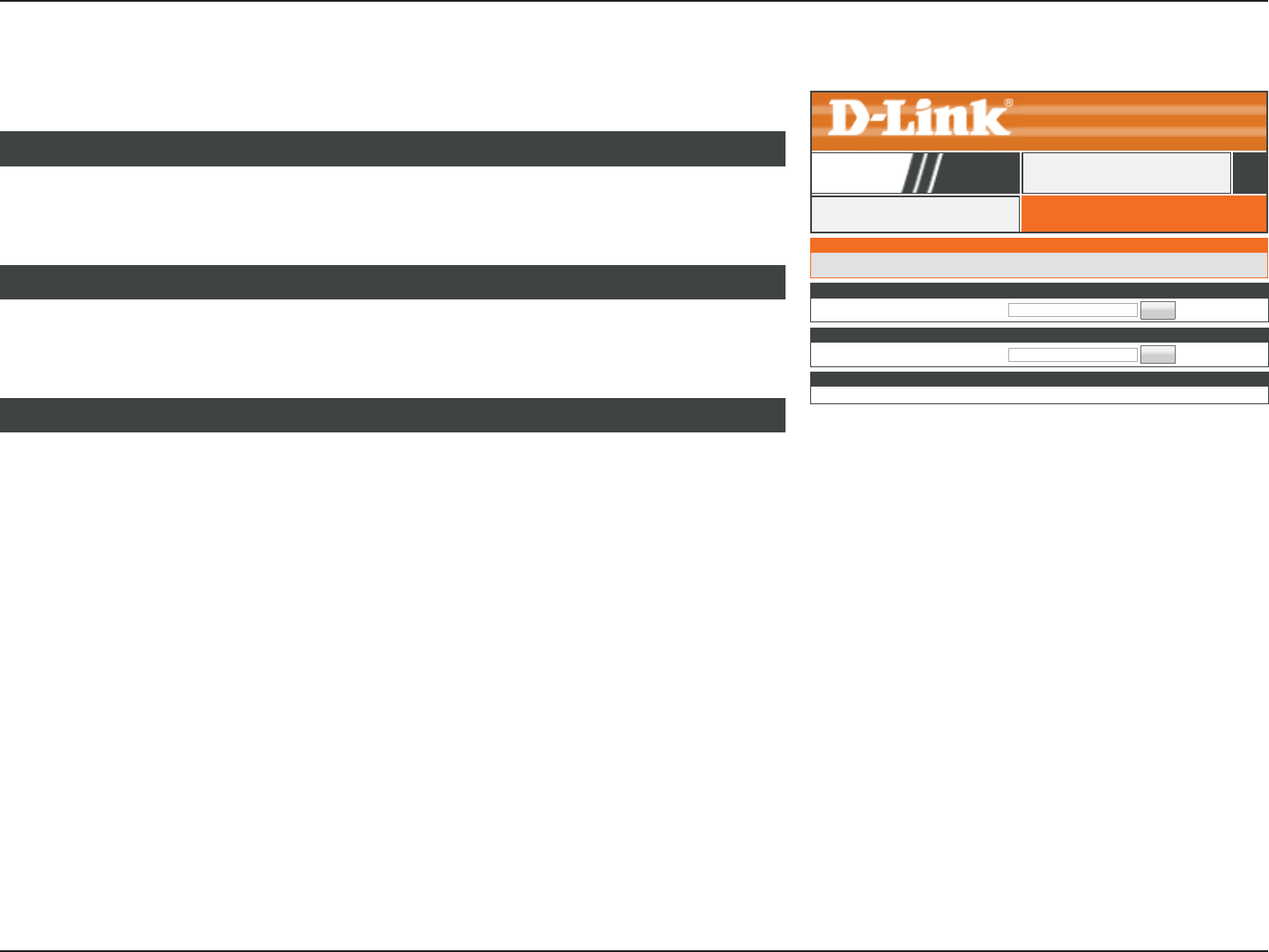
109D-Link DIR-819 User Manual
Section 3 - Conguration
System Check
PING TESTSYSTEM CHECK
DIR-819 TOOLS
Click System Check on the navigation menu to test your connection to the Internet.
Host Name or IP
Address:
Enter either an IP address or web address that you wish to Ping and
click Ping.
PING TEST
Host Name or IPv6
Address:
Enter either an IPv6 address or web address that you wish to Ping
and click Ping.
IPV6 PING TEST
The results of the test are displayed in this dialog box.
PING RESULT
PING TEST
Ping Test sends "ping" packets to test a computer on the Internet.
PING TEST
Host Name or IP Address : Ping
IPV6 PING TEST
Host Name or IPv6 Address : Ping
PING RESULT
Result here
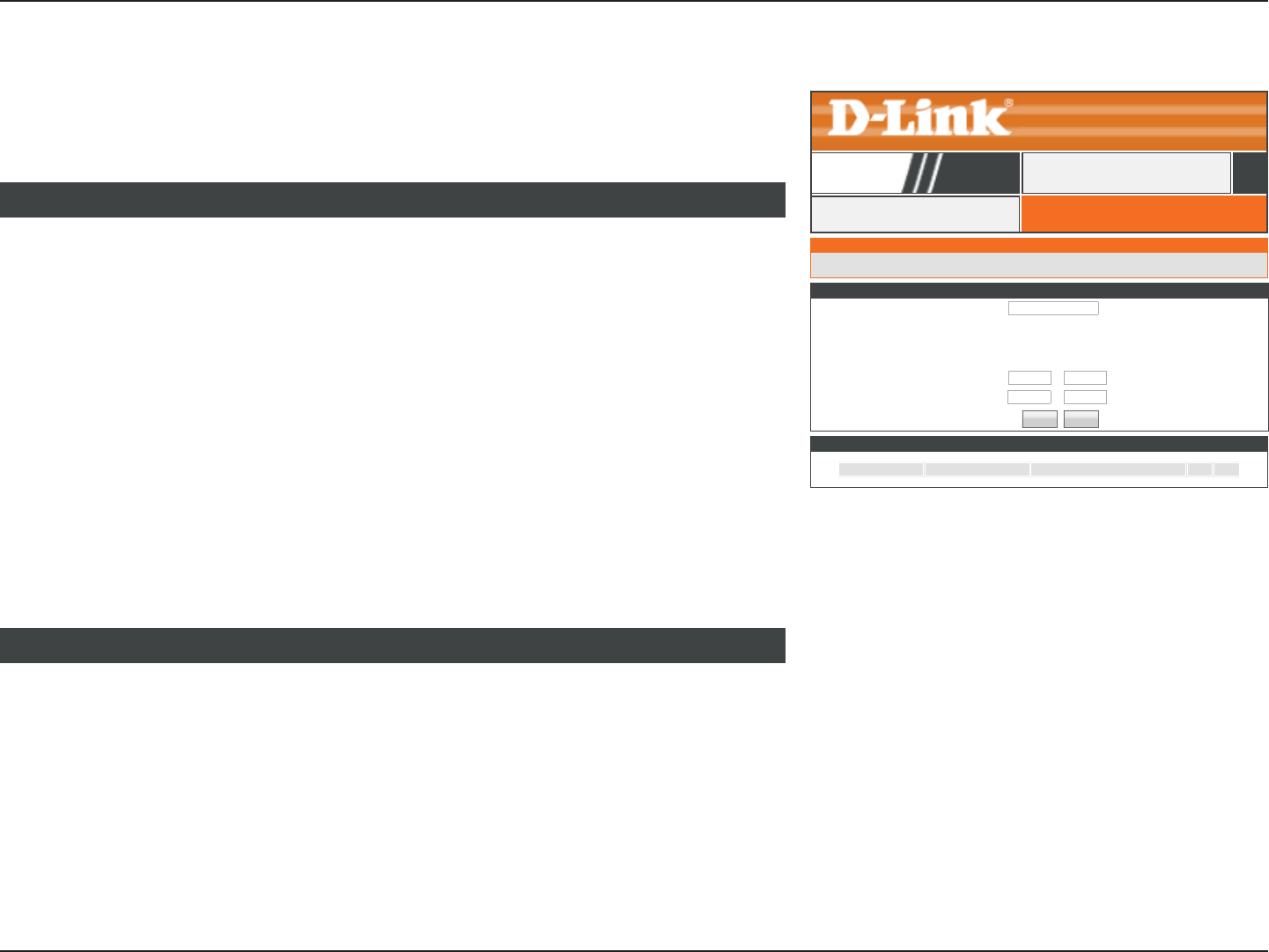
110D-Link DIR-819 User Manual
Section 3 - Conguration
Schedules
SCHEDULESSCHEDULES
DIR-819 TOOLS
Click Schedules on the navigation menu to congure the system schedules. Several router
functions be operated according to a pre-congured schedule which may be created from
this page.
If you wish to create a new schedule, ll in the following elds:
Name: Enter a name for your new schedule.
Day(s): Choose to have the schedule apply to All Week or Select Days and
check the boxes of the days to apply the rules to.
All Day - 24 hrs: Check this box to have the rule apply all day or leave this box
unchecked at ll in the Start Time and End Time elds.
Start Time: Enter the start time for this rule to start.
End Time: Enter the end time for this rule to stop.
Click the Add button when you are satised with your new schedule.
10 ADD SCHEDULE RULE
The currently added rules are displayed in this table. You may edit or delete a rule by clicking
on its corresponding Edit or Delete buttons.
SCHEDULE RULES LIST
SCHEDULES
The Schedule conguration option is used to manage schedule rules for "WAN", "Wireless", "Virtual Server", "Port Forwarding",
"Applications" and "Network Filter".
10 -- ADD SCHEDULE RULE
Name :
Day(s) : All Week Select Days
☐Sun ☐Mon ☐Tue ☐Wed ☐Thu ☐Frid ☐Sat
All Day - 24 hrs : ☐
Start Time : :(hour:minute)
End Time : :(hour:minute)
Add Cancel
SCHEDULE RULES LIST
Name Days Time Frame
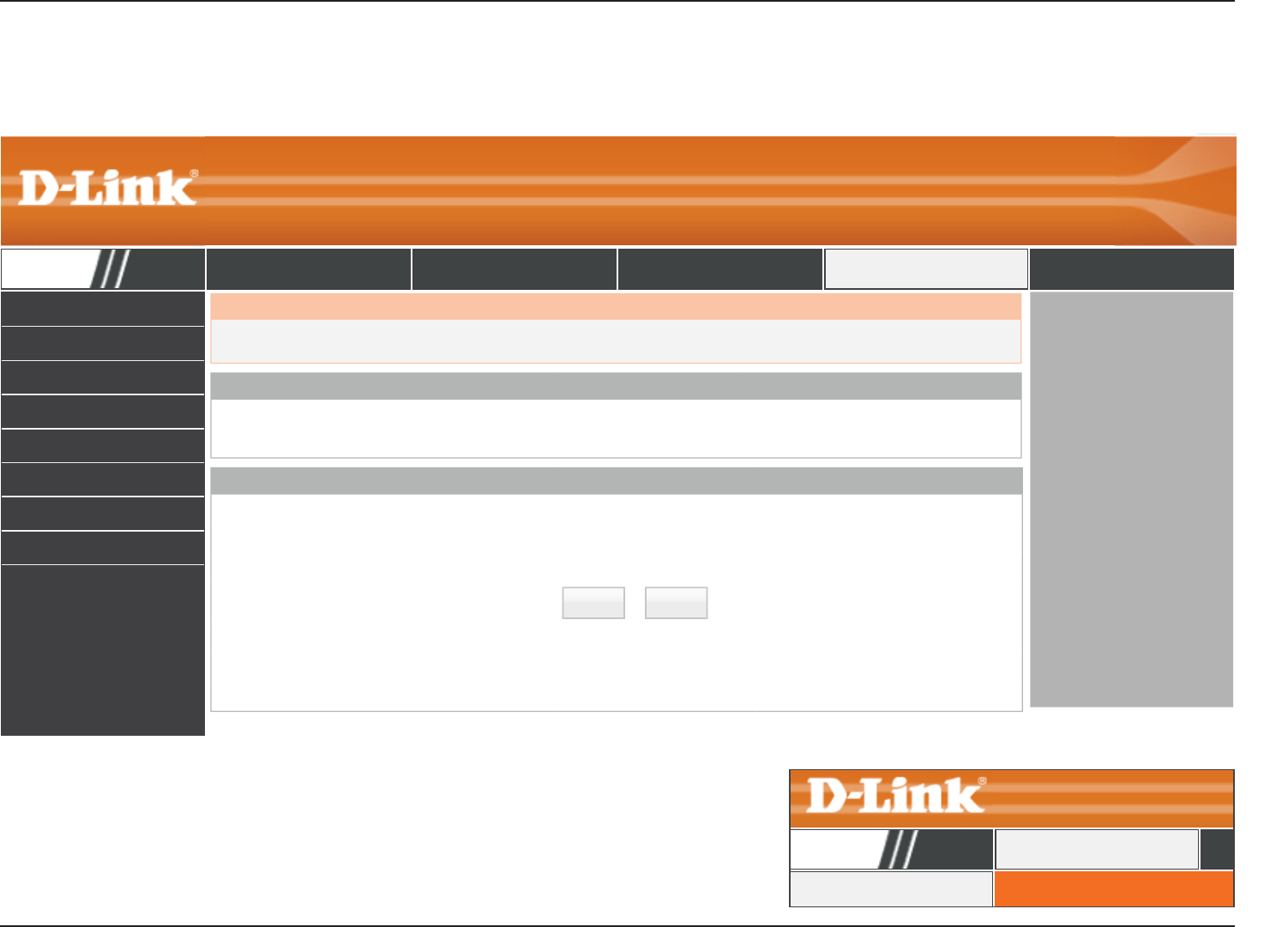
111D-Link DIR-819 User Manual
Section 3 - Conguration
Status
DEVICE INFO
LOGS
STATISTICS
INTERNET SESSIONS
WIRELESS
ROUTING
IPV6
IPV6 ROUTING
To return to this Web UI Table of Contents page, simply click the D-Link logo on the top
right of each page. INTERNET CONNECTIONINTERNET
DIR-819 SETUP
The Status tab provides information about the DIR-819’s current status.
DIR-819 SETUP ADVANCED TOOLS STATUS SUPPORT
DEVICE INFORMATION
All of your Internet and network connection details are displayed on this page. The rmware version is also displayed here.
WAN
Connection Type : DHCP Client
Cable Status : Connected
Network Status : Connected
Renew Release
Connection Up Time : 0 Day 0 Hour 0 Min 0 Sec
MAC Address : ff:ff:ff:ff:ff:ff
IP Address : 192.168.0.1
GENERAL
Time: 2016-09-19 13:00
Current Firmware Version : V1.01
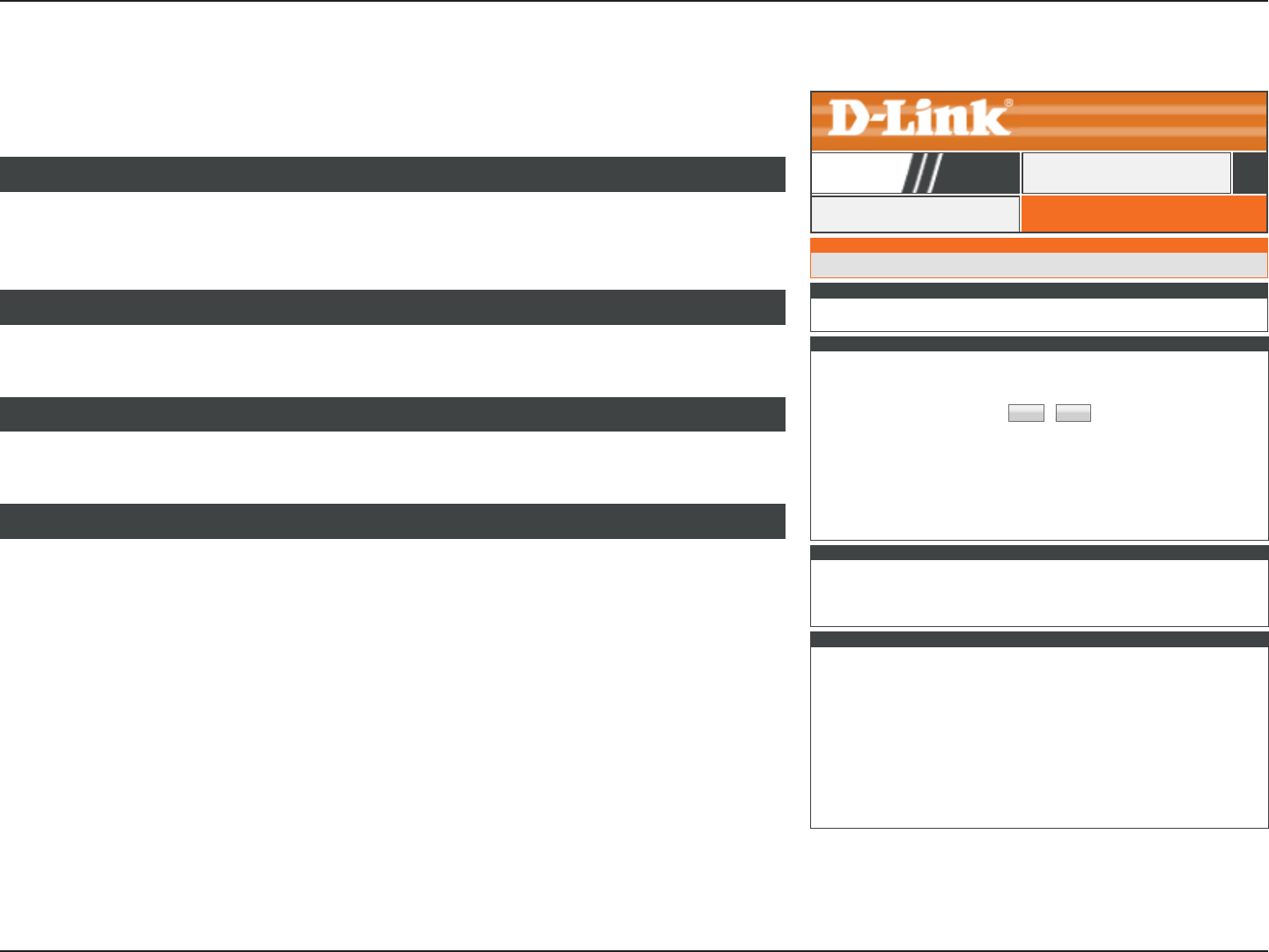
112D-Link DIR-819 User Manual
Section 3 - Conguration
Device Info
DEVICE INFORMATIONDEVICE INFO
DIR-819 STATUS
Click Device Info to see current information about the DIR-819. This pages displays LAN,
WAN (Internet), and Wireless information.
The DIR-819’s currently set time and rmware are displayed here.
GENERAL
The DIR-819’s currently congured Internet connection settings are displayed here.
WAN
The DIR-819’s currently congured local network settings are displayed here.
LAN
The DIR-819’s currently congured 2.4 GHz wireless network settings are displayed here.
WIRELESS LAN
DEVICE INFORMATION
All of your Internet and network connection details are displayed on this page. The rmware version is also displayed here.
WAN
Connection Type : DHCP Client
Cable Status : Connected
Network Status : Connected
Renew Release
Connection Up Time : 0 Day 0 Hour 0 Min 0 Sec
MAC Address : ff:ff:ff:ff:ff:ff
IP Address : 192.168.0.1
Subnet Mask : 255.255.255.0
Default Gateway : 192.168.0.1
Primary DNS Server : 192.168.0.1
Secondary DNS Server : 192.168.0.1
LAN
MAC Address : ff:ff:ff:ff:ff:ff
IP Address : 192.168.0.1
Subnet Mask 255.255.255.0
DHCP Server : Enabled
WIRELESS LAN
Wireless Radio : Enabled
MAC Address : ff:ff:ff:ff:ff:ff
802.11 Mode : Mixed 802.11n, 802.11g and 802.11b
Channel Width : 20/40MHz
Channel : 1
Network Name (SSID) : Your_2.4GHz_Network
Wi-Fi Protected Setup : Enabled/Not congured
Security : NONE
Guest Zone Wireless Radio : Disabled
Guest Zone Network Name (SSID) :
Guest Zone Security : NONE
GENERAL
Time: 2016-09-19 13:00
Current Firmware Version : V1.01

113D-Link DIR-819 User Manual
Section 3 - Conguration
WIRELESS LAN2
Wireless Radio : Enabled
MAC Address : ff:ff:ff:ff:ff:ff
802.11 Mode : Mixed 802.11ac, 802.11n and 802.11a
Channel Width : 20/40/80MHz
Channel : 161
Network Name (SSID) : Your_5GHz_Network
Wi-Fi Protected Setup : Enabled/Not congured
Security : NONE
Guest Zone Wireless Radio : Disabled
Guest Zone Network Name (SSID) :
Guest Zone Security : NONE
LAN COMPUTERS
MAC Address IP Address Name(if any)
ff:ff:ff:ff:ff:ff
IGMP MULTICAST MEMBERSHIPS
IPv4 Multicast Group Address
IPv6 Multicast Group Address
Device Info (continued)
The DIR-819’s currently congured 5 GHz wireless network settings are displayed here.
WIRELESS LAN2
The devices currently connected to the DIR-819’s are displayed here.
LAN COMPUTERS
The DIR-819’s current IGMP multicast information is displayed here.
IGMP MULTICAST MEMBERSHIPS
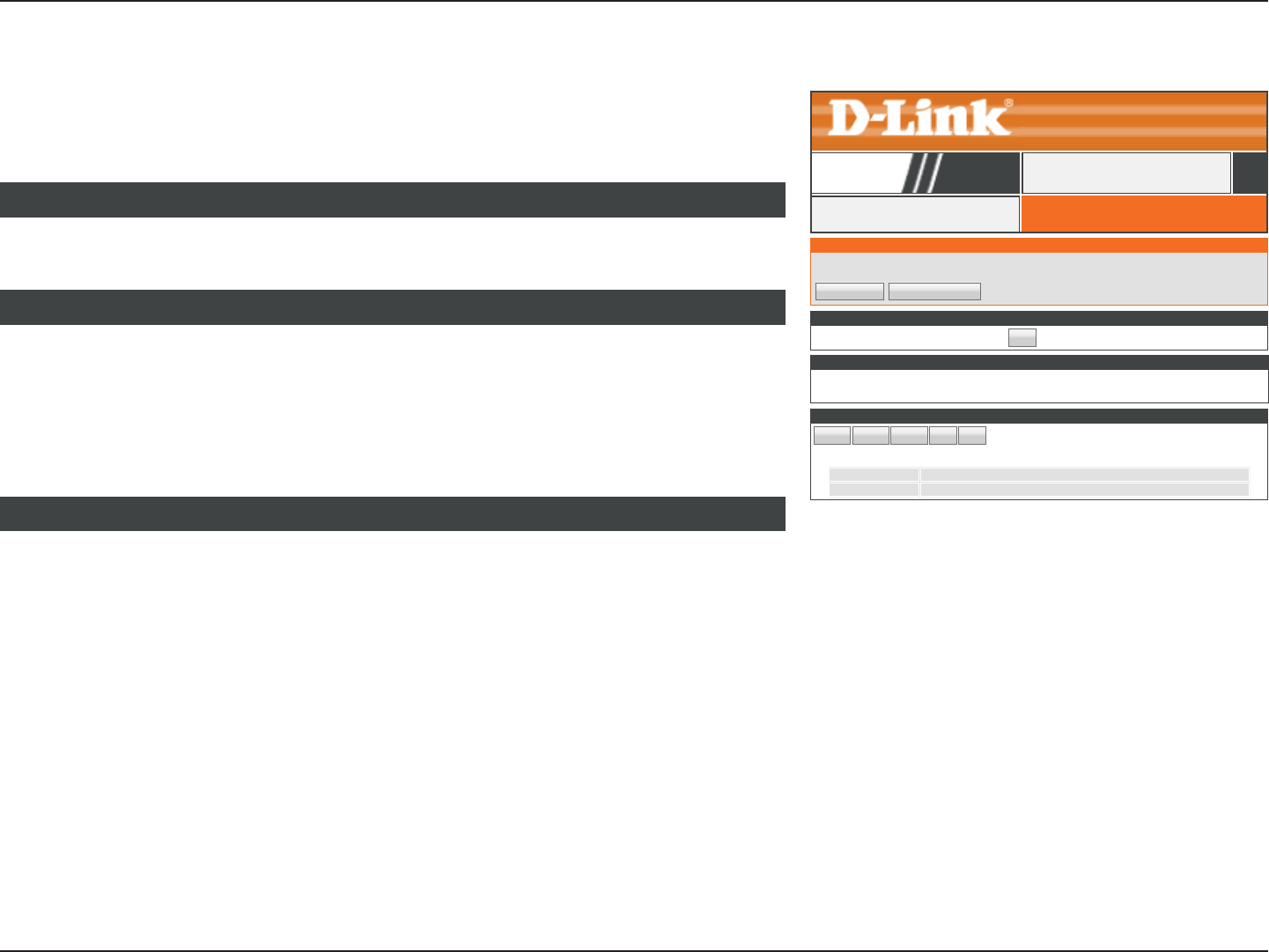
114D-Link DIR-819 User Manual
Section 3 - Conguration
Logs
VIEW LOGLOGS
DIR-819 STATUS
Click Logs on the navigation menu to view the system log. This device maintains a running
log of events which can be sent to a syslog server. Refer to Syslog on page 105 for more
information on conguring the system log.
Click the Save button to save the log le to your local hard drive.
SAVE LOG FILE
Click the navigation buttons to view the log le.
LOG FILES
Log Type: To change the type of information to view and then click the Save
Settings button.
Log Level: To change the levl of information to view and then click the Save
Settings button.
WAN
VIEW LOG
The View Log displays the activities occurring on the router.
Save Settings Don’t Save Settings
SAVE LOG FILE
Save Log File To Local Hard Drive. Save
LOG FILES
First Page
Last Page
Previous
Next
Clear
1/1
Time Message
Sep 19 09:15:05 2016 User Admin login success
WAN
Log Type : System Firewall & Security Router Status
Log Level : Critical Warning Information
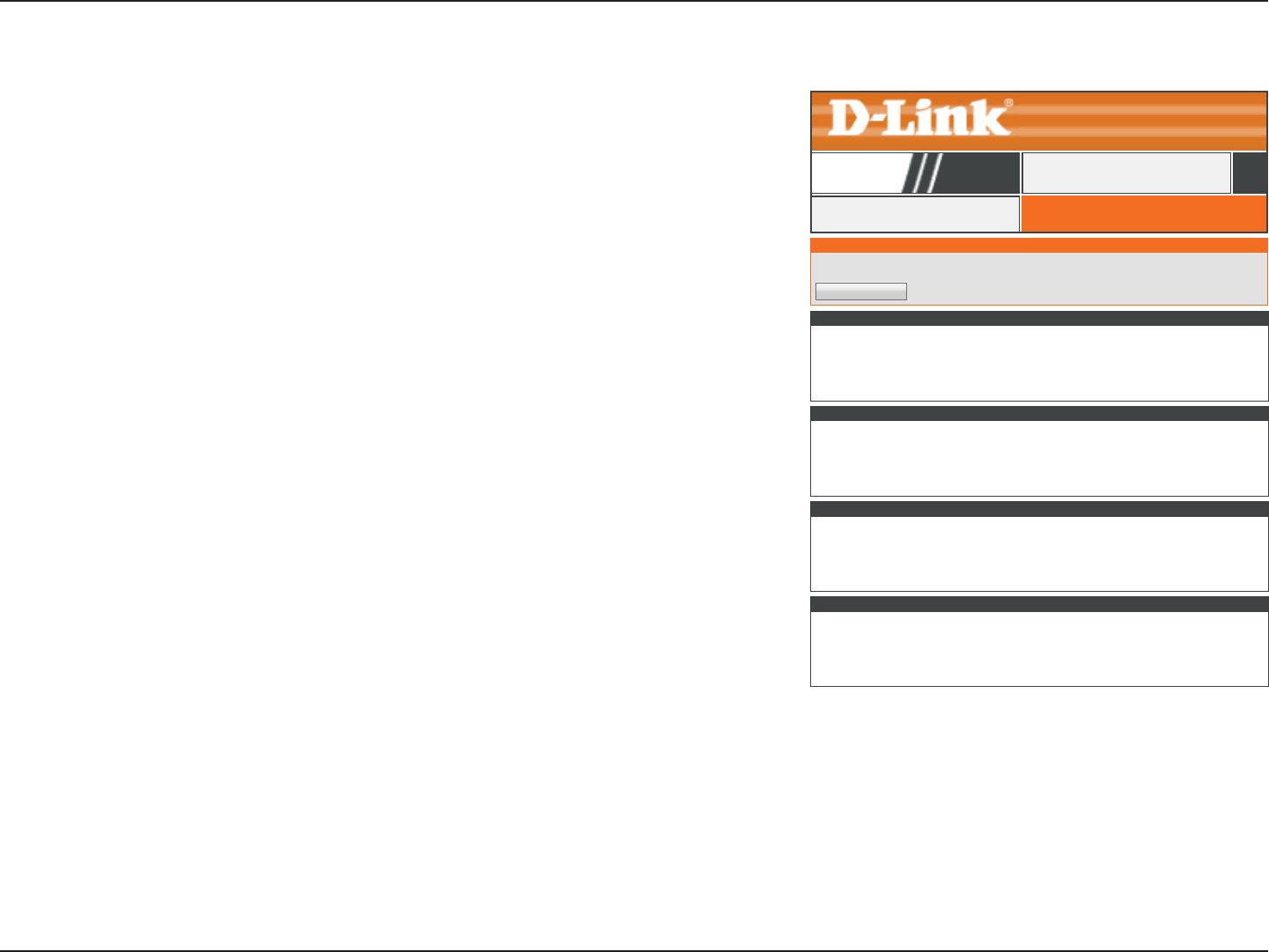
115D-Link DIR-819 User Manual
Section 3 - Conguration
Statistics
TRAFFIC STATISTICSSTATISTICS
DIR-819 STATUS
Click Statistics on the navigation menu to view statistics on the amount of trac which
has passed through the DIR-819’s interfaces. Click the Refresh Statistics button to view
the latest numbers.
TRAFFIC STATISTICS
Trafc Statistics displays Receive and Transmit packets passing through the device.
Refresh Statistics
LAN STATISTICS
Sent : 0Received : 0
TX Packets Dropped : 0RX Packets Dropped : 0
Collisions : 0Errors : 0
WAN STATISTICS
Sent : 0Received : 0
TX Packets Dropped : 0RX Packets Dropped : 0
Collisions : 0Errors : 0
WIRELESS STATISTICS - 2.4GHZ BAND
Sent : 0Received : 0
TX Packets Dropped : 0RX Packets Dropped : 0
Collisions : 0Errors : 0
WIRELESS STATISTICS - 5GHZ BAND
Sent : 0Received : 0
TX Packets Dropped : 0RX Packets Dropped : 0
Collisions : 0Errors : 0

116D-Link DIR-819 User Manual
Section 3 - Conguration
Internet Sessions
INTERNET SESSIONSINTERNET SESSIONS
DIR-819 STATUS
Click Internet Sessions on the navigation menu to view information about currently active
Internet connections. This page helps to diagnose connectivity issues. Click the Refresh
button to view the latest information.
INTERNET SESSIONS
This page displays Source and Destination sessions passing through the device.
Refresh
IP Protocol NAT Internet State Dir Time Out
192.168.0.100 UDP 54674 192.168.0.1 Out 60

117D-Link DIR-819 User Manual
Section 3 - Conguration
Wireless
CONNECTED WIRELESS CLIENT LIST
WIRELESS
DIR-819 STATUS
Click Wireless on the navigation menu to view information about currently connected
wireless clients. You may view each client’s MAC address, IP address, 802.11 mode, speed,
and signal strength.
CONNECTED WIRELESS CLIENT LISTV
View the wireless clients that are connected to the router. (A client might linger in the list for a few minutes after an unexpected
disconnect.)
NUMBER OF WIRELESS CLIENTS - 2.4GHZ BAND : 0
MAC Address IP Address Mode Rate(Mbps) Signal (%)
NUMBER OF WIRELESS CLIENTS - 5GHZ BAND : 0
MAC Address IP Address Mode Rate(Mbps) Signal (%)

118D-Link DIR-819 User Manual
Section 3 - Conguration
Routing
ROUTINGROUTING
DIR-819 STATUS
Click Routing to view the currently congured IPv4 routing table.
ROUTING
Routing Table
This page displays the routing details congured for your router.
ROUTING TABLE
Destination Gateway Genmask Metric Iface Creator
192.168.0.100 0.0.0.0 255.255.255.0 0 eth1 0
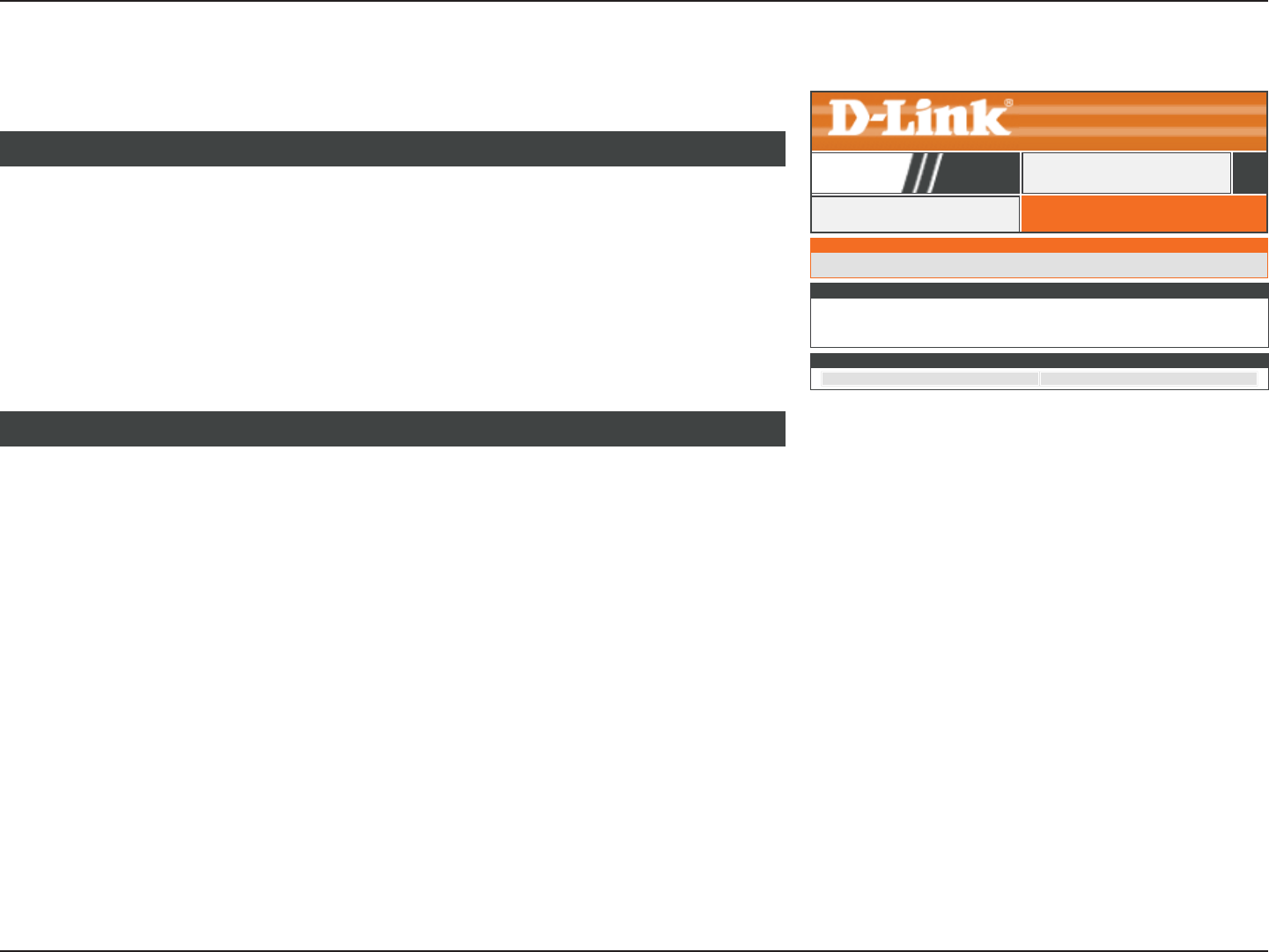
119D-Link DIR-819 User Manual
Section 3 - Conguration
IPV6
IPV6 NETWORK INFORMATIONIPV6
DIR-819 STATUS
IPv6 Connection
Type:
The currently congured IPv6 connection type is listed here.
IPv6 Default
Gateway:
The current IPv6 default gateway is listed here.
LAN IPv6 Link-Local
Address:
The current IPv6 Link-Local address is listed here.
IPV6 CONNECTION INFORMATION
The currently connected IPv6 computers are listed in this table.
LAN IPV6 COMPUTERS
IPV6 NETWORK INFORMATION
All of your IPv6 Internet and network connection details are displayed on this
IPV6 CONNECTION INFORMATION
IPv6 Connection Type : Link-Lcoal
IPv6 Default Gateway : NONE
LAN IPv6 Link-Local Address : ffff::fff:fff:ffff:ffff
LAN IPV6 COMPUTERS
IPv6 Address Name(if any)
Click IPv6 to view the currently IPv6 information.

120D-Link DIR-819 User Manual
Section 3 - Conguration
IPv6 Routing
IPV6 ROUTINGIPV6 ROUTING
DIR-819 STATUS
IPV6 ROUTING
This page displays IPV6 routing details congured for your router.
IPV6 ROUTING TABLE
Destination IP Gateway Metric Interface
fe800000000000000000000000
000000/64
000000000000000000000000
00000000 256 br0
Click IPv6 Routing to view the currently congured IPv6 routing table.
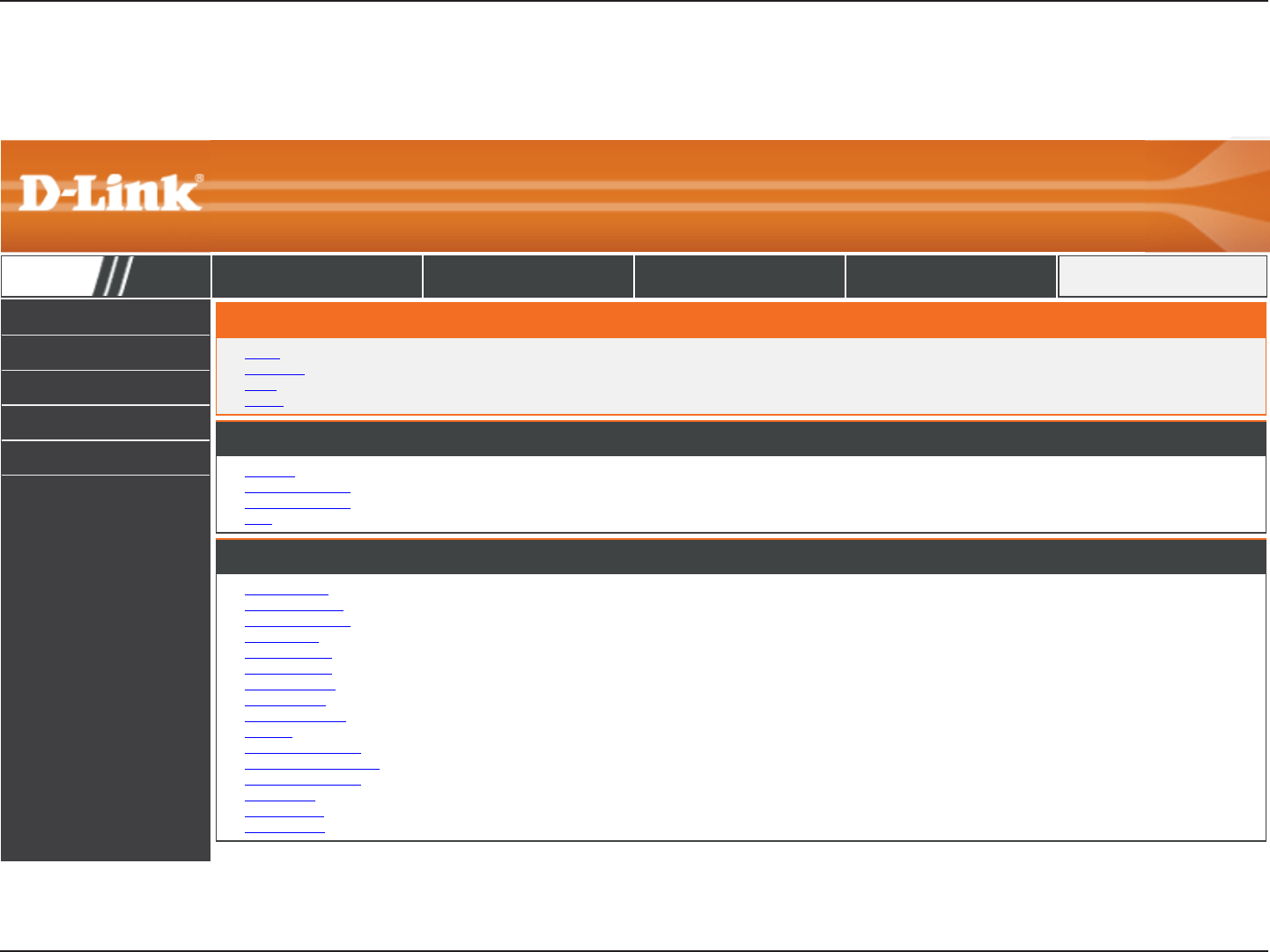
121D-Link DIR-819 User Manual
Section 3 - Conguration
Support
MENU
SETUP
ADVANCED
TOOLS
STATUS
IPV6 ROUTING
• Setup
• Advanced
• Tools
• Status
SETUP HELP
• Internet
• Wireless Settings
• Network Settings
• IPv6
ADVANCED HELP
• Virtual Server
• Port Forwarding
• Application Rules
• QOS Engine
• Network Filter
• Inbound Filter
• Access Control
• Website lter
• Firewall Settings
• Routing
• Advanced Wireless
• Wi-Fi Protected Setup
• Advanced Network
• Guest Zone
• IPv6 Firewall
• IPv6 Routing
DIR-819 SETUP ADVANCED TOOLS STATUS SUPPORT
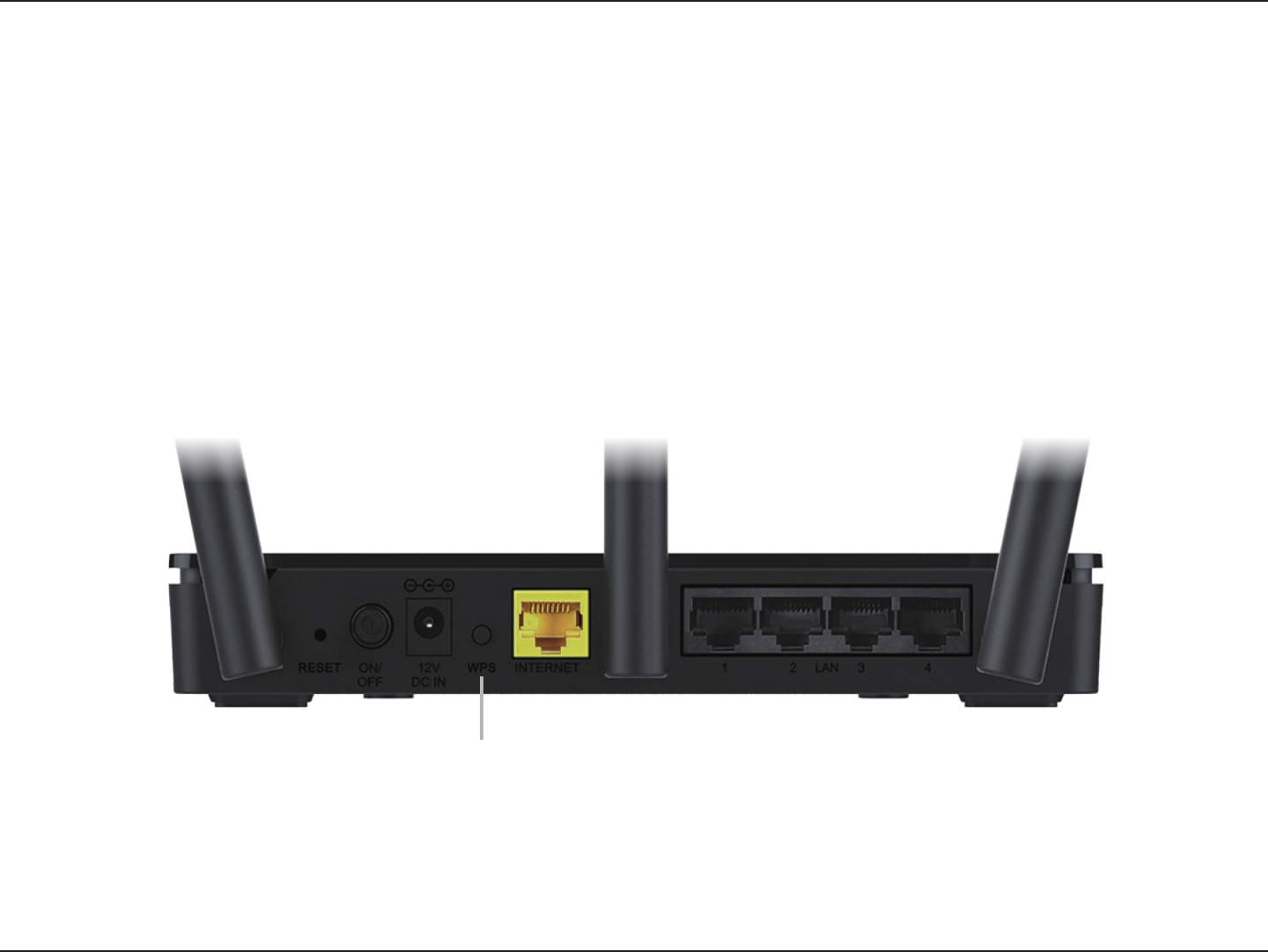
122D-Link DIR-819 User Manual
Section 4 - Connecting to a Wireless Network
Connect a Wireless Client to Your Router
WPS Button
Step 2 - Within 2 minutes, press the WPS button on your wireless device (or launch the software utility and start the WPS
process).
The easiest and most secure way to connect your wireless devices to the router is with WPS (Wi-Fi Protected Setup). Most wireless
devices such as wireless adapters, media players, Blu-ray DVD players, wireless printers, and cameras will have a WPS button
(or a software utility with WPS) that you can press to connect to the DIR-819 router. Please refer to your user manual for the
wireless device you want to connect to make sure you understand how to enable WPS. Once you know, follow the steps below:
Step 1 - Press the WPS button on the DIR-819 for about 1 second. The wireless LED on the front will start to blink.
Step 3 - Allow up to 1 minute for your connection to be congured. Once the WPS LED stops blinking, you will be connected
and your wireless connection will be secure with WPA2.
WPS Button
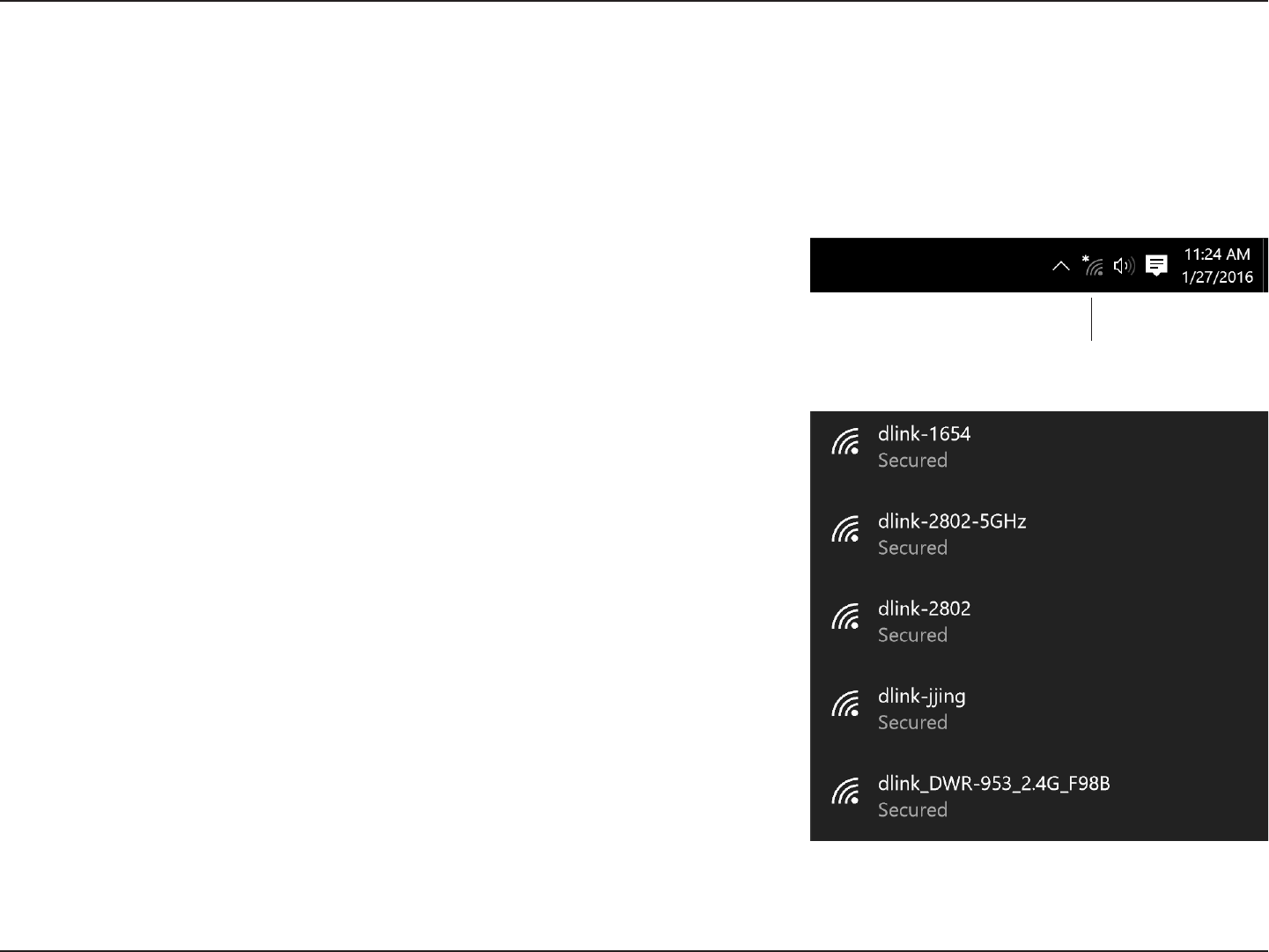
123D-Link DIR-819 User Manual
Section 4 - Connecting to a Wireless Network
When connecting to the DIR-819 wirelessly for the rst time, you will need to input the wireless network name (SSID) and Wi-
Fi password (security key) of the device you are connecting to. If your product has a Wi-Fi conguration card, you can nd the
default network name and Wi-Fi password here. Otherwise refer to the product label for the default Wi-Fi network SSID and
password, or enter the Wi-Fi credentials set during the product conguration.
To join an existing network, locate the wireless network icon in the taskbar,
next to the time display and click on it.
Wireless Icon
Clicking on this icon will display a list of wireless networks which are within
range of your computer. Select the desired network by clicking on the SSID.
Windows® 10
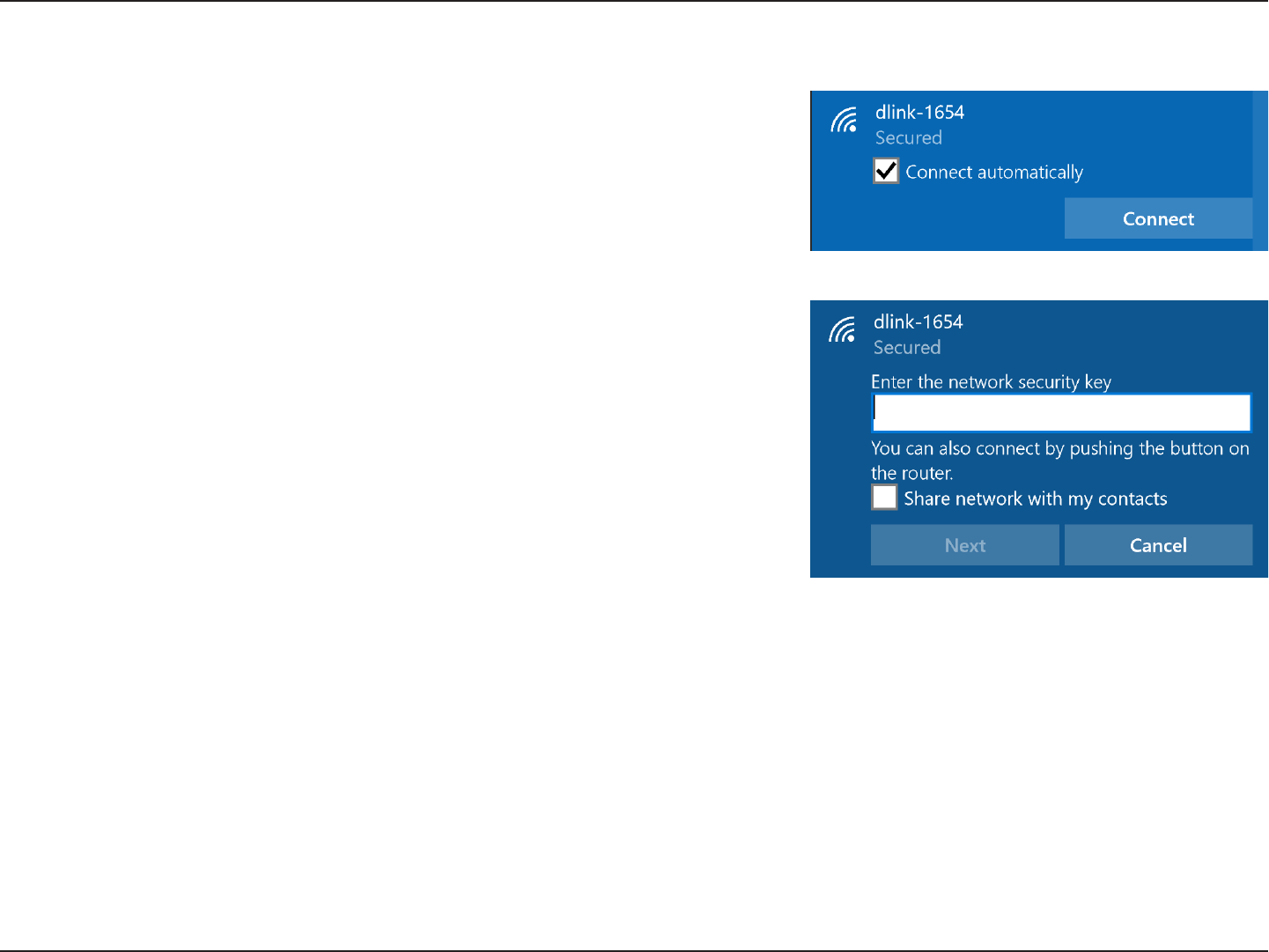
124D-Link DIR-819 User Manual
Section 4 - Connecting to a Wireless Network
To connect to the SSID, click Connect.
To automatically connect with the router when your device next detects the
SSID, click the Connect Automatically check box.
You will then be prompted to enter the Wi-Fi password (network security key)
for the wireless network. Enter the password into the box and click Next to
connect to the network. Your computer will now automatically connect to this
wireless network when it is detected.
You can also use Wi-Fi Protected Setup (WPS) to connect to the router. Press the
WPS button on your D-Link device and you will be automatically connected.
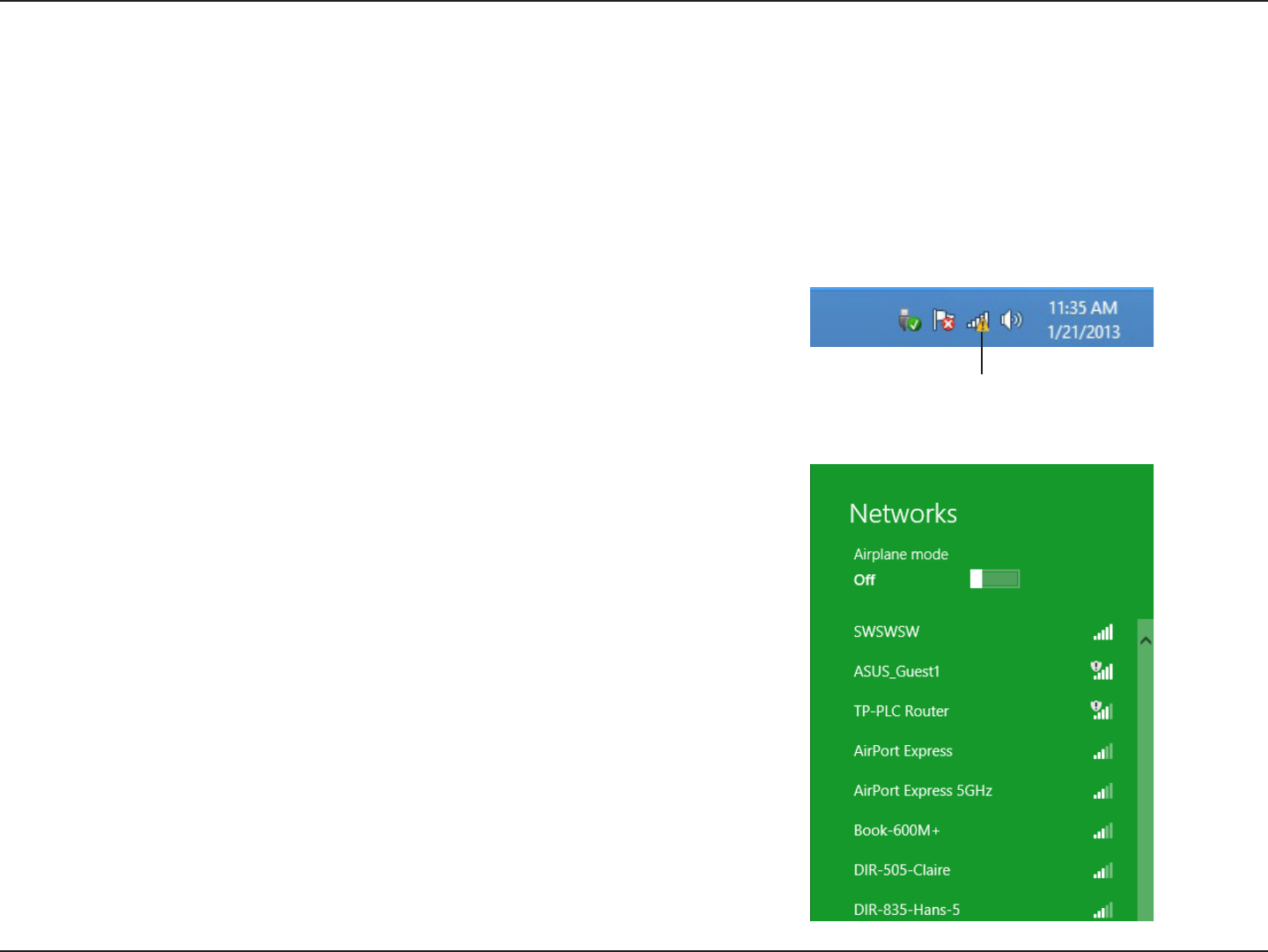
125D-Link DIR-819 User Manual
Section 4 - Connecting to a Wireless Network
Windows® 8
WPA/WPA2
It is recommended that you enable wireless security (WPA/WPA2) on your wireless router or access point before conguring
your wireless adapter. If you are joining an existing network, you will need to know the security key (Wi-Fi password) being used.
To join an existing network, locate the wireless network icon in the taskbar
next to the time display.
Wireless Icon
Clicking on this icon will display a list of wireless networks that are within
connecting proximity of your computer. Select the desired network by clicking
on the network name.
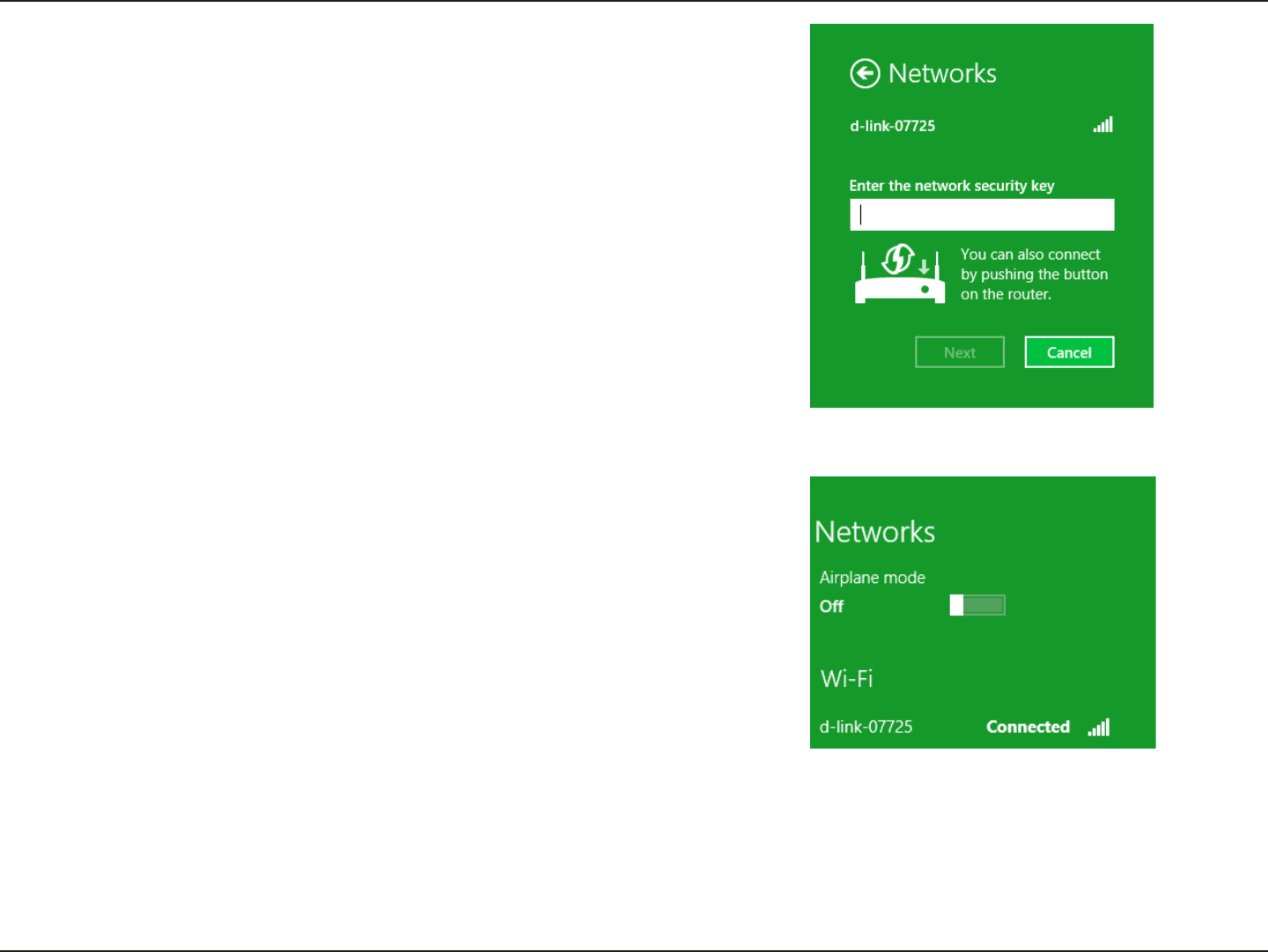
126D-Link DIR-819 User Manual
Section 4 - Connecting to a Wireless Network
You will then be prompted to enter the network security key (Wi-Fi password)
for the wireless network. Enter the password into the box and click Next.
If you wish to use Wi-Fi Protected Setup (WPS) to connect to the router, you
can also press the WPS button on your router during this step to enable the
WPS function.
When you have established a successful connection to a wireless network, the
word Connected will appear next to the name of the network to which you
are connected to.
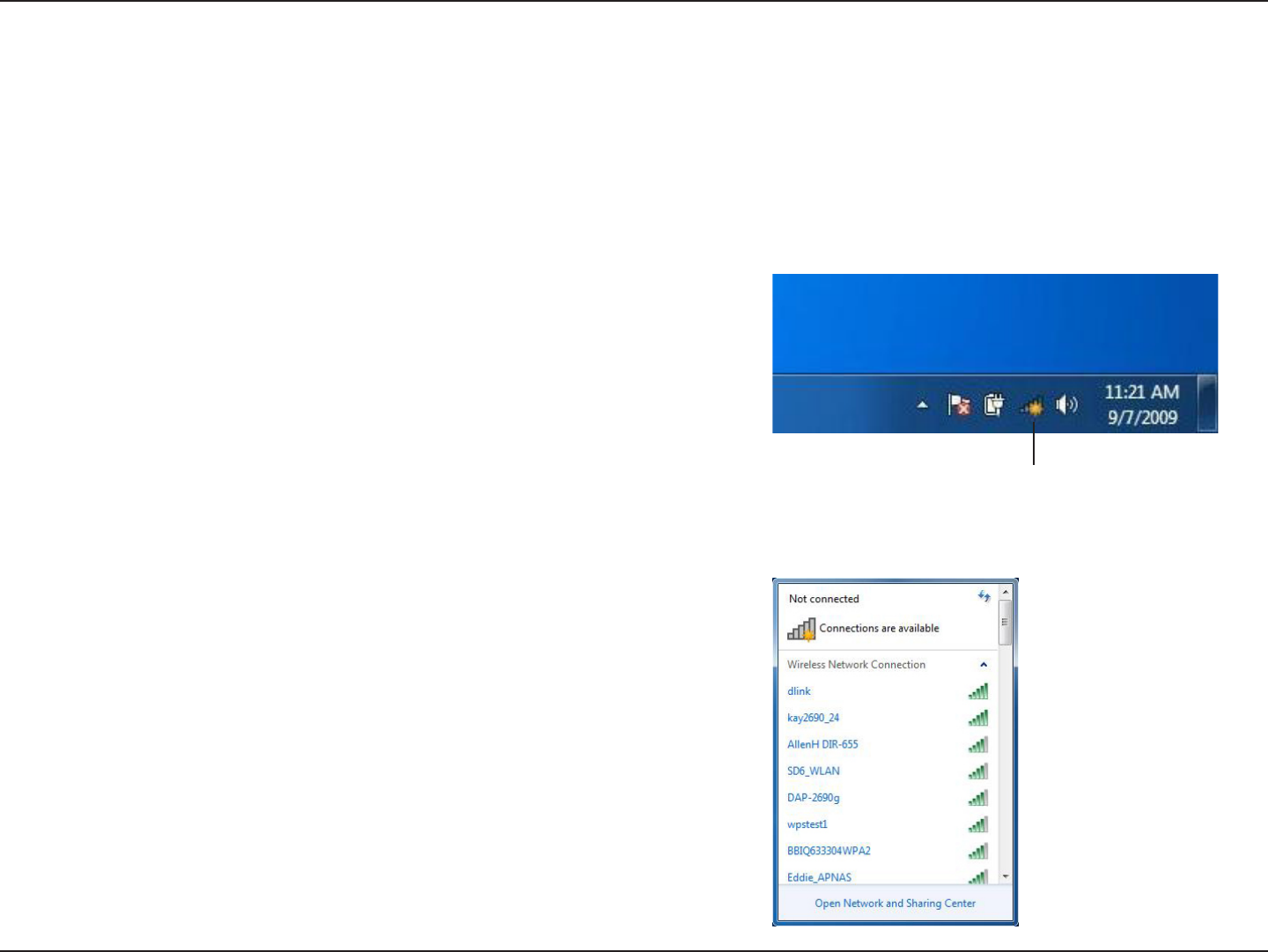
127D-Link DIR-819 User Manual
Section 4 - Connecting to a Wireless Network
Windows® 7
It is recommended that you enable wireless security (WPA/WPA2) on your wireless router or access point before conguring
your wireless adapter. If you are joining an existing network, you will need to know the security key or passphrase being used.
1. Click on the wireless icon in your system tray (lower-right corner).
2. The utility will display any available wireless networks in your area.
Wireless Icon
WPA/WPA2
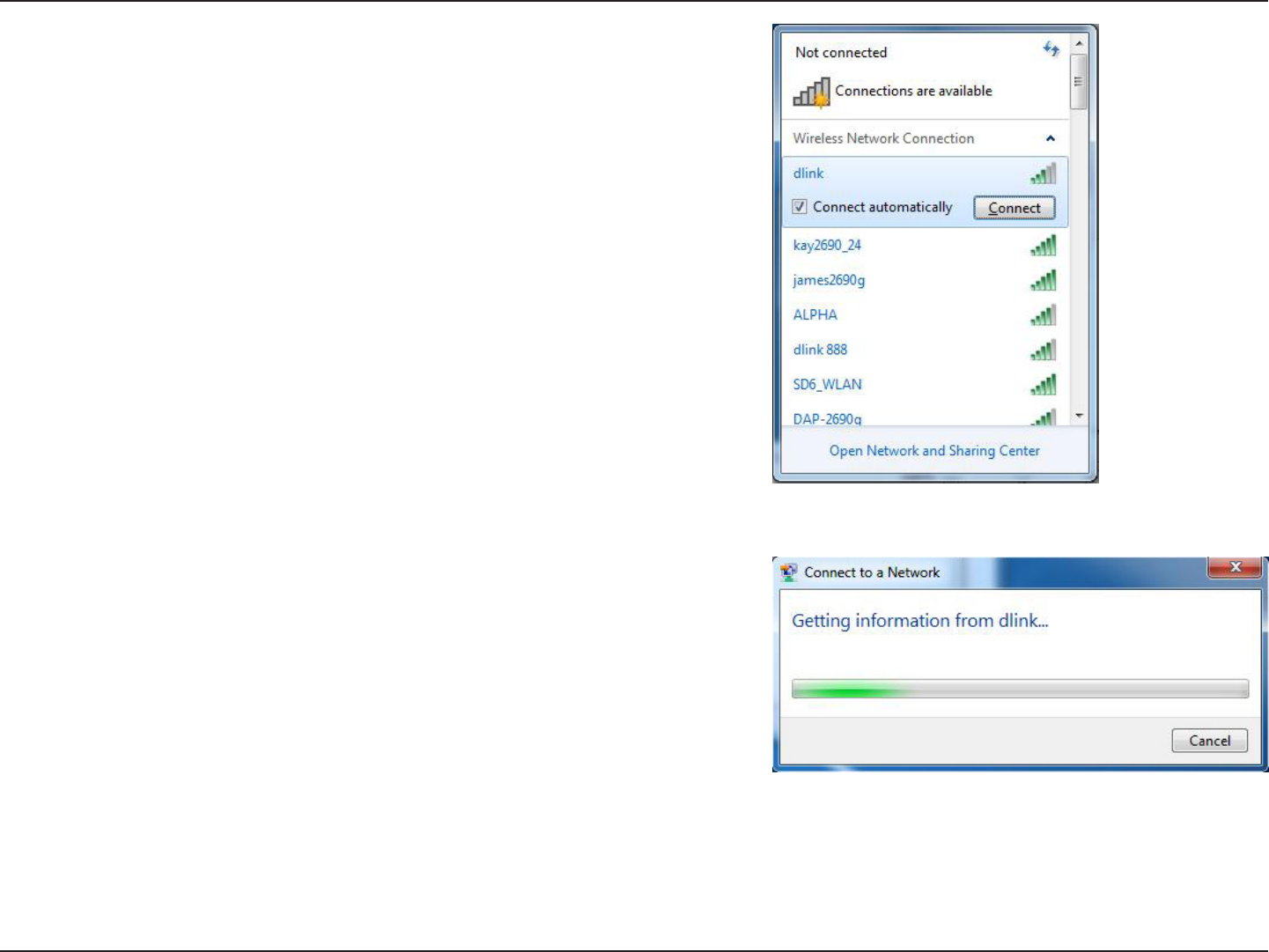
128D-Link DIR-819 User Manual
Section 4 - Connecting to a Wireless Network
3. Highlight the wireless connection with Wi-Fi name (SSID) you would
like to connect to and click the Connect button.
If you get a good signal but cannot access the Internet, check your TCP/
IP settings for your wireless adapter. Refer to the Networking Basics
section in this manual for more information.
4. The following window appears while your computer tries to connect
to the router.
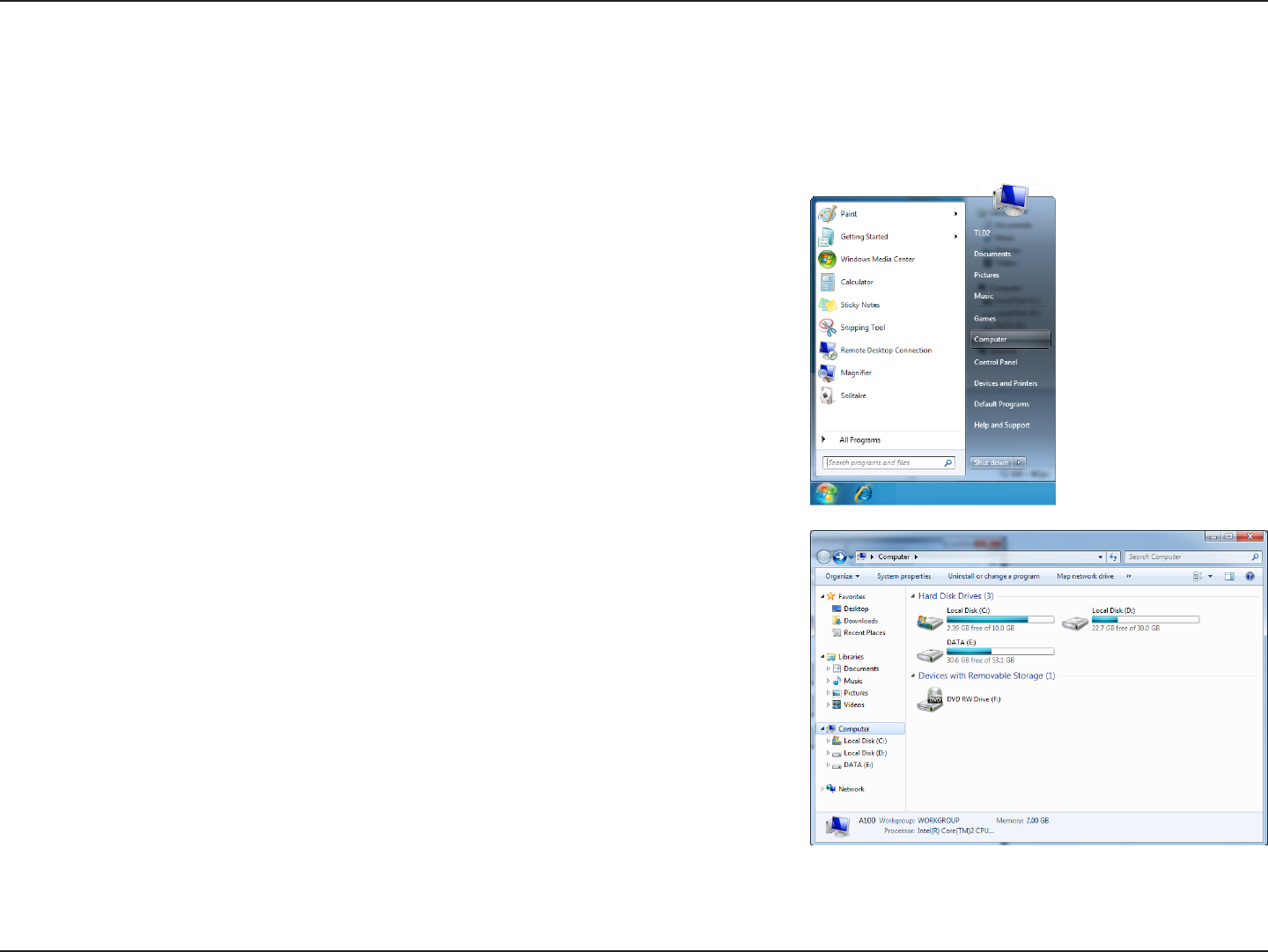
129D-Link DIR-819 User Manual
Section 4 - Connecting to a Wireless Network
WPS
The WPS feature of the DIR-819 can be congured using Windows® 7. Carry out the following steps to use Windows® 7 to
congure the WPS feature:
1. Click the Start button and select Computer from the Start menu.
2. Click Network on the left side.
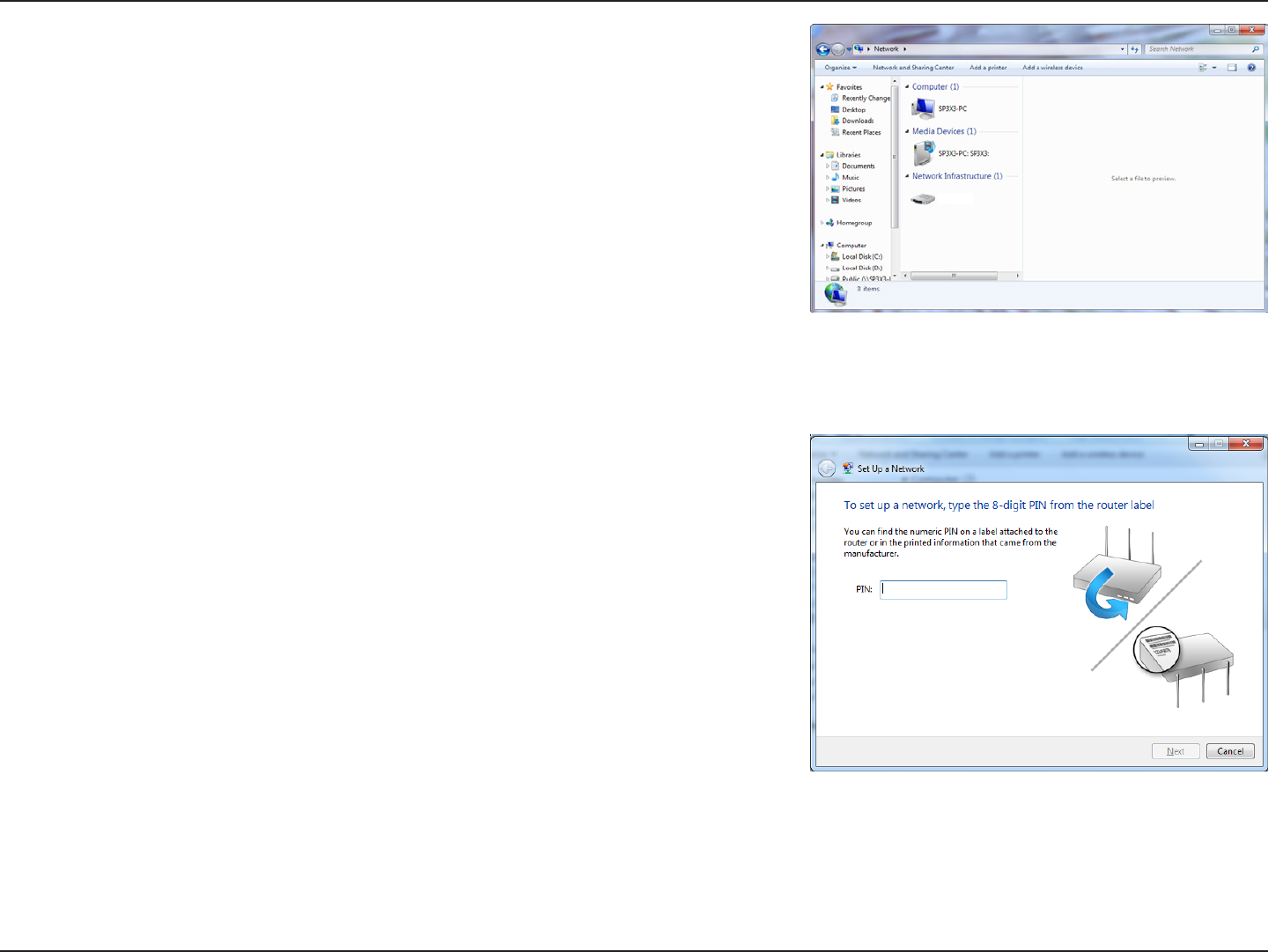
130D-Link DIR-819 User Manual
Section 4 - Connecting to a Wireless Network
3. Double-click the DIR-819.
4. Input the WPS PIN number (on the router label) in the Setup > Wireless
Setup menu in the Router’s Web UI) and click Next.
DIR-819
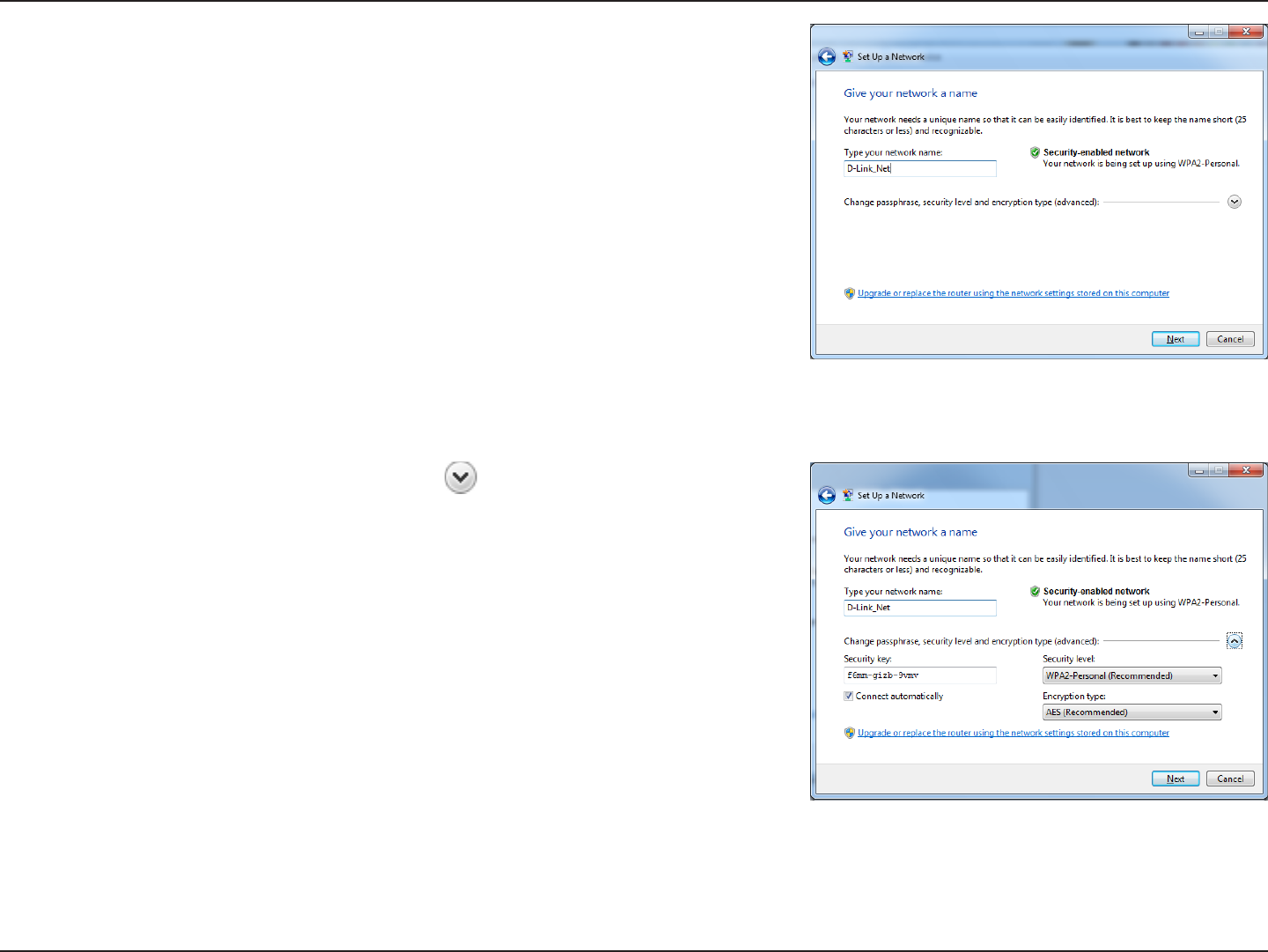
131D-Link DIR-819 User Manual
Section 4 - Connecting to a Wireless Network
5. Type a name to identify the network.
6. To congure advanced settings, click the icon.
Click Next to continue.
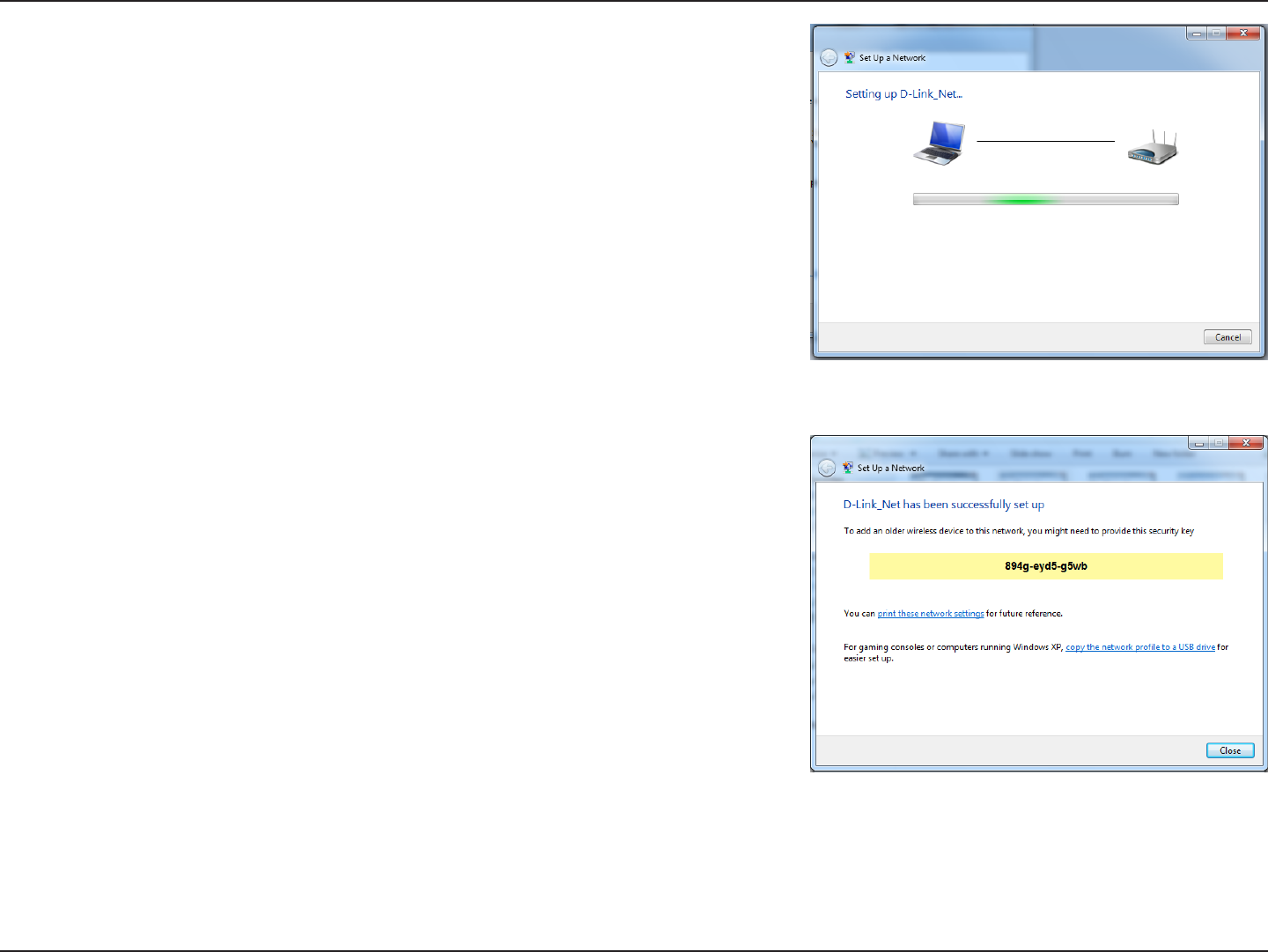
132D-Link DIR-819 User Manual
Section 4 - Connecting to a Wireless Network
7. The following window appears while the DIR-819 is being congured.
Wait for the conguration to complete.
8. The following window informs you that WPS on the DIR-819 has been set
up successfully.
Make a note of the security key as you may need to provide this security key
if adding an older wireless device to the network in the future.
9. Click Close to complete WPS setup.
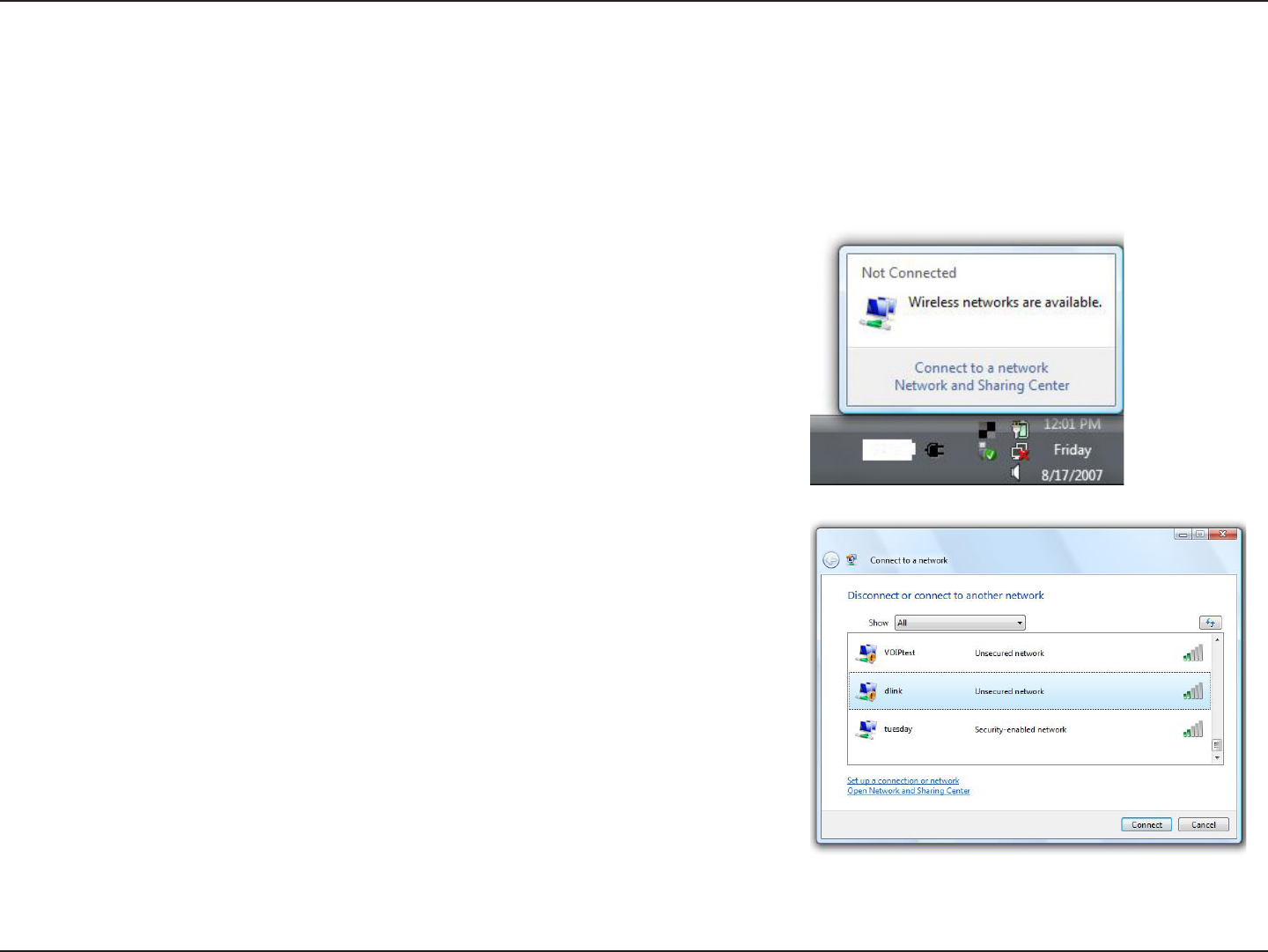
133D-Link DIR-819 User Manual
Section 4 - Connecting to a Wireless Network
Windows Vista®
Windows Vista® users may use the built-in wireless utility. If you are using another company’s wireless utility, please refer to the
user manual of your wireless adapter for help connecting to a wireless network. Most wireless utilities will have a “site survey”
option similar to the Windows Vista® utility as seen below.
Right-click on the wireless computer icon in your system tray (lower-right corner
next to the time). Select Connect to a network.
If you receive the Wireless Networks Detected bubble, click on the center of
the bubble to access the utility.
or
The utility will display any available wireless networks in your area. Click on a
network (displayed using the SSID) and click the Connect button.
If you get a good signal but cannot access the Internet, check your TCP/IP
settings for your wireless adapter. Refer to the Networking Basics section in
this manual for more information.
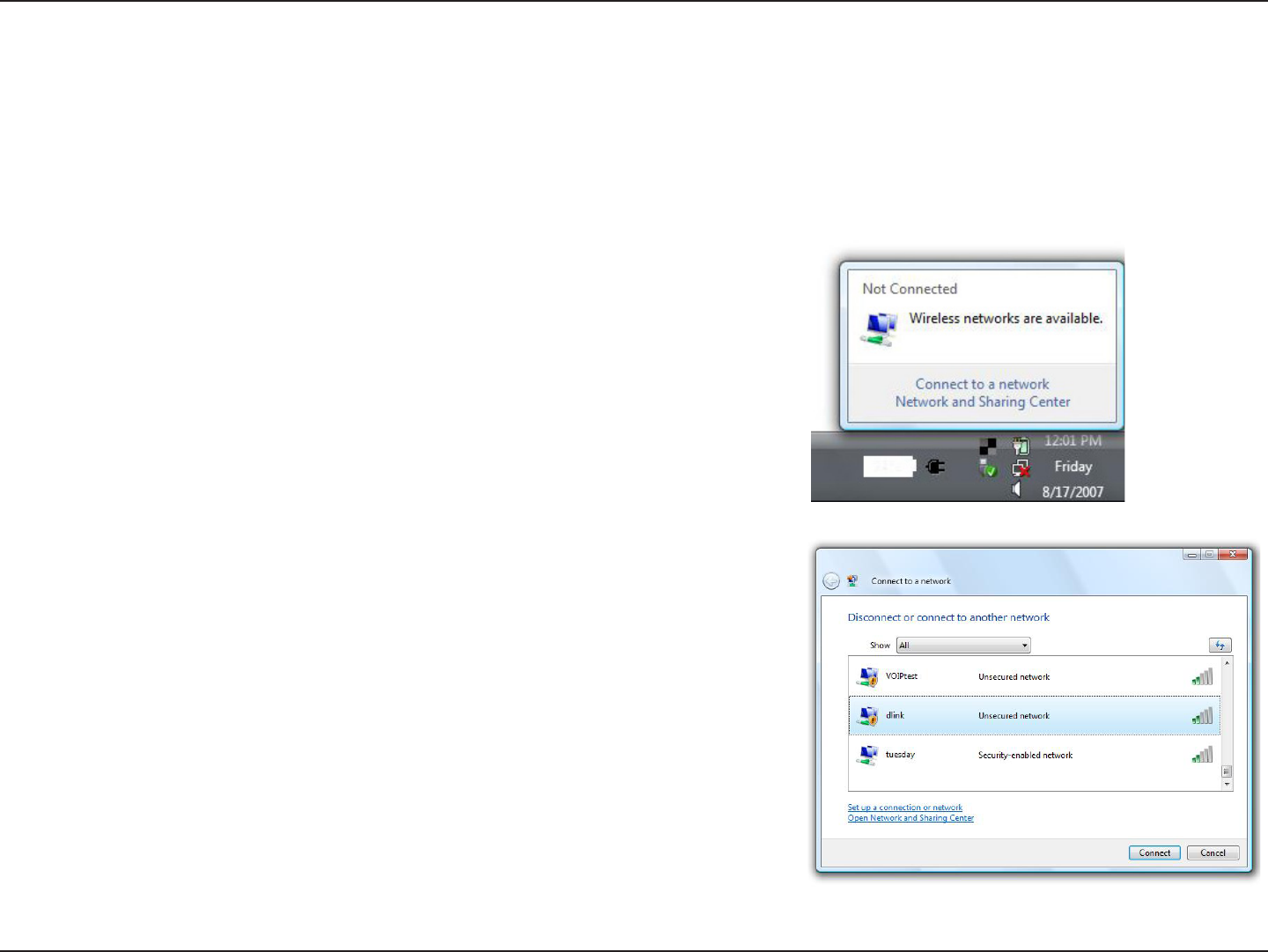
134D-Link DIR-819 User Manual
Section 4 - Connecting to a Wireless Network
WPA/WPA2
It is recommended that you enable wireless security (WPA/WPA2) on your wireless router or access point before conguring
your wireless adapter. If you are joining an existing network, you will need to know the security key or passphrase being used.
2. Highlight the Wi-Fi name (SSID) you would like to connect to and click
Connect.
1. Open the Windows Vista® Wireless Utility by right-clicking on the wireless
computer icon in your system tray (lower right corner of screen). Select
Connect to a network.
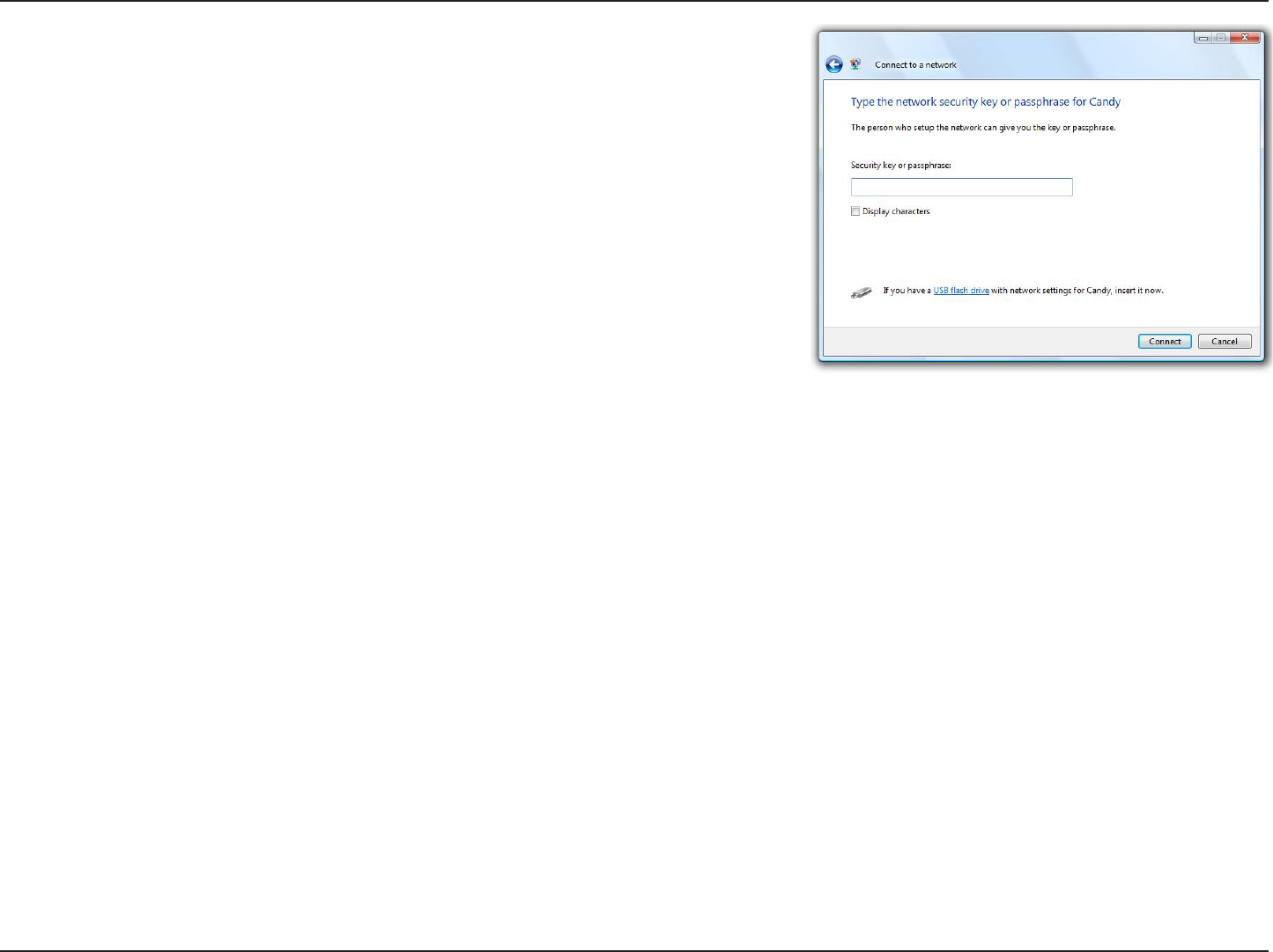
135D-Link DIR-819 User Manual
Section 4 - Connecting to a Wireless Network
3. Enter the same security key or passphrase (Wi-Fi password) that is on your
router and click Connect.
It may take 20-30 seconds to connect to the wireless network. If the connection
fails, please verify that the security settings are correct. The key or passphrase
must be exactly the same as the one on the wireless router.

136D-Link DIR-819 User Manual
Section 5 - Troubleshooting
Troubleshooting
This chapter provides solutions to problems that can occur during the installation and operation of the DIR-819. Read the
following descriptions if you are having problems. The examples below are illustrated in Windows® XP. If you have a dierent
operating system, the screenshots on your computer will look similar to these examples.
1. Why can’t I access the web-based conguration utility?
When entering the IP address of the D-Link router (192.168.11.1 for example), you are not connecting to a website, nor do
you have to be connected to the Internet. The device has the utility built-in to a ROM chip in the device itself. Your computer
must be on the same IP subnet to connect to the web-based utility.
• Make sure you have an updated Java-enabled web browser. We recommend the following:
• Internet Explorer 10 or higher
• EDGE Browser 20 or higher
• Firefox 28 or higher
• Safari 6.0 or higher
• Chrome 28 or higher
• Verify physical connectivity by checking for solid link lights on the device. If you do not get a solid link light, try using a
dierent cable, or connect to a dierent port on the device if possible. If the computer is turned o, the link light may not
be on.
• Disable any Internet security software running on the computer. Software rewalls such as ZoneAlarm, BlackICE, Sygate,
Norton Personal Firewall, and Windows® XP rewall may block access to the conguration pages. Check the help les included
with your rewall software for more information on disabling or conguring it.

137D-Link DIR-819 User Manual
Section 5 - Troubleshooting
• Congure your Internet settings:
• Go to Start > Settings > Control Panel. Double-click the Internet Options Icon. From the Security tab, click
the button to restore the settings to their defaults.
• Click the Connection tab and set the dial-up option to Never Dial a Connection. Click the LAN Settings button.
Make sure nothing is checked. Click OK.
• Go to the Advanced tab and click the button to restore these settings to their defaults. Click OK three times.
• Close your web browser (if open) and open it.
• Access the web management. Open your web browser and enter the IP address of your D-Link router in the address bar. This
should open the login page for your web management.
• If you still cannot access the conguration, unplug the power to the router for 10 seconds and plug back in. Wait about 30
seconds and try accessing the conguration. If you have multiple computers, try connecting using a dierent computer.
2. What can I do if I forgot my password?
If you forgot your password, you must reset your router. This process will change all your settings back to the factory defaults.
To reset the router, locate the reset button (hole) on the rear panel of the unit. With the router powered on, use a paperclip
to hold the button down for 10 seconds. Release the button and the router will go through its reboot process. Wait about 30
seconds to access the router. The default IP address is 192.168.11.1. When logging in, leave the password box empty.
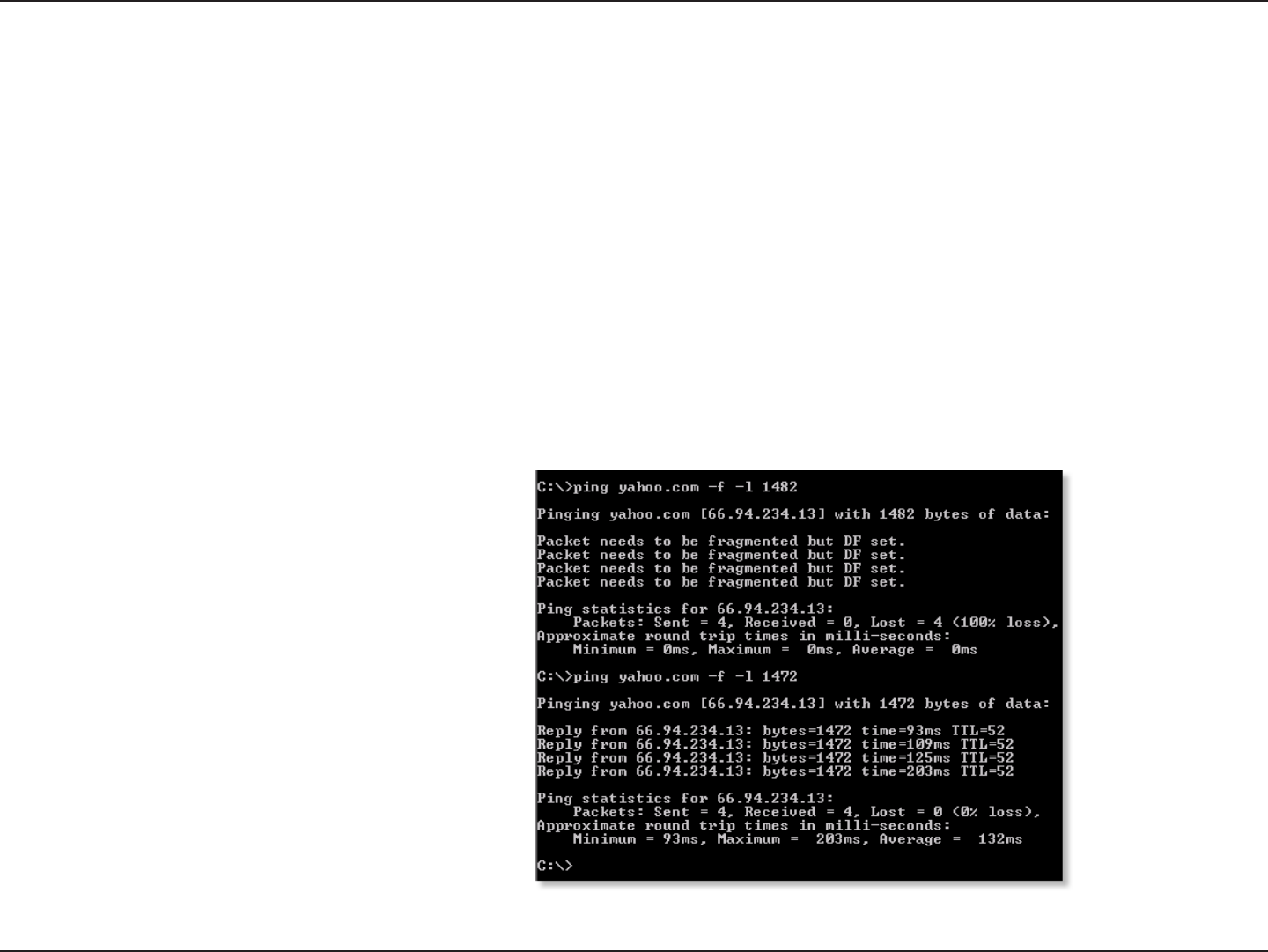
138D-Link DIR-819 User Manual
Section 5 - Troubleshooting
3. Why can’t I connect to certain sites or send and receive emails when connecting through my router?
If you are having a problem sending or receiving email, or connecting to secure sites such as eBay, banking sites, and Hotmail,
we suggest lowering the MTU in increments of ten (Ex. 1492, 1482, 1472, etc).
To nd the proper MTU Size, you’ll have to do a special ping of the destination you’re trying to go to. A destination could be
another computer, or a URL.
• Click on Start and then click Run.
• Windows® 95, 98, and Me users type in command (Windows® NT, 2000, XP, Vista®, and 7 users type in cmd) and
press Enter (or click OK).
• Once the window opens, you’ll need to do a special ping. Use the following syntax:
ping [url] [-f] [-l] [MTU value]
Example: ping yahoo.com -f -l 1472

139D-Link DIR-819 User Manual
Section 5 - Troubleshooting
You should start at 1472 and work your way down by 10 each time. Once you get a reply, go up by 2 until you get a fragmented
packet. Take that value and add 28 to the value to account for the various TCP/IP headers. For example, lets say that 1452 was the
proper value, the actual MTU size would be 1480, which is the optimum for the network we’re working with (1452+28=1480).
Once you nd your MTU, you can now congure your router with the proper MTU size.
To change the MTU rate on your router follow the steps below:
• Open your browser, enter the IP address of your router (192.168.11.1) and click OK.
• Enter your username (admin) and password (blank by default). Click OK to enter the web conguration page
for the device.
• Click on Setup and then click Manual Congure.
• To change the MTU, enter the number in the MTU eld and click Save Settings to save your settings.
• Test your email. If changing the MTU does not resolve the problem, continue changing the MTU in increments
of ten.

140D-Link DIR-819 User Manual
Appendix A - Wireless Basics
D-Link wireless products are based on industry standards to provide easy-to-use and compatible high-speed wireless
connectivity within your home, business, or public access wireless networks. Strictly adhering to the IEEE standard, the D-Link
wireless family of products will allow you to securely access the data you want, when, and where you want it. You will be able
to enjoy the freedom that wireless networking delivers.
A wireless local area network (WLAN) is a cellular computer network that transmits and receives data with radio signals instead
of wires. Wireless LANs are used increasingly in both home and oce environments, and public areas such as airports, coee
shops and universities. Innovative ways to utilize WLAN technology are helping people work, and communicate more eciently.
Increased mobility and the absence of cabling and other xed infrastructure have proven to be benecial for many users.
Wireless users can use the same applications they use on a wired network. Wireless adapter cards used on laptop and desktop
systems support the same protocols as Ethernet adapter cards.
Under many circumstances, it may be desirable for mobile network devices to link to a conventional Ethernet LAN in order to
use servers, printers or an Internet connection supplied through the wired LAN. A wireless router is a device used to provide
this link.
Wireless Basics

141D-Link DIR-819 User Manual
Appendix A - Wireless Basics
What is Wireless?
Wireless or Wi-Fi technology is another way of connecting your computer to the network without using wires. Wi-Fi uses radio
frequency to connect wirelessly so you have the freedom to connect computers anywhere in your home or oce network.
Why D-Link Wireless?
D-Link is the worldwide leader and award winning designer, developer, and manufacturer of networking products. D-Link
delivers the performance you need at a price you can aord. D-Link has all the products you need to build your network.
How does wireless work?
Wireless works similarly to how cordless phones work, through radio signals that transmit data from one point A to point B.
But wireless technology has restrictions as to how you can access the network. You must be within the wireless network range
area to be able to connect your computer. There are two dierent types of wireless networks: Wireless Local Area Network
(WLAN), and Wireless Personal Area Network (WPAN).
Wireless Local Area Network (WLAN)
In a wireless local area network, a device called an Access Point (AP) connects computers to the network. The access point
has a small antenna attached to it, which allows it to transmit data back and forth over radio signals. With an indoor access
point the signal can travel up to 300 feet. With an outdoor access point the signal can reach out up to 30 miles to serve places
like manufacturing plants, industrial locations, university and high school campuses, airports, golf courses, and many other
outdoor venues.
Wireless Personal Area Network (WPAN)
Bluetooth is the industry standard wireless technology used for WPAN. Bluetooth devices in WPAN operate in a range up to
30 feet away.

142D-Link DIR-819 User Manual
Appendix A - Wireless Basics
Compared to WLAN the speed and wireless operation range are both less than WLAN, but in return it doesn’t use nearly as
much power. This makes it ideal for personal devices, such as mobile phones, PDAs, headphones, laptops, speakers, and other
devices that operate on batteries.
Who uses wireless?
Wireless technology as become so popular in recent years that almost everyone is using it, whether it’s for home, oce, business,
D-Link has a wireless solution for it.
Home Uses/Benets
• Gives everyone at home broadband access
• Surf the web, check email, instant message, etc.
• Gets rid of the cables around the house
• Simple and easy to use
Small Oce and Home Oce Uses/Benets
• Stay on top of everything at home as you would at oce
• Remotely access your oce network from home
• Share Internet connection and printer with multiple computers
• No need to dedicate oce space
Where is wireless used?
Wireless technology is expanding everywhere, not just at home or oce. People like the freedom of mobility and it’s becoming
so popular that more and more public facilities now provide wireless access to attract people. The wireless connection in public
places is usually called “hotspots”.
Using a D-Link USB adapter with your laptop, you can access the hotspot to connect to the Internet from remote locations like:
airports, hotels, coee shops, libraries, restaurants, and convention centers.

143D-Link DIR-819 User Manual
Appendix A - Wireless Basics
Wireless network is easy to setup, but if you’re installing it for the rst time it could be quite a task not knowing where to start.
That’s why we’ve put together a few setup steps and tips to help you through the process of setting up a wireless network.
Tips
Here are a few things to keep in mind, when you install a wireless network.
Centralize your router or access point
Make sure you place the router/access point in a centralized location within your network for the best performance. Try to
place the router/access point as high as possible in the room, so the signal gets dispersed throughout your home. If you have
a two-story home, you may need a repeater to boost the signal to extend the range.
Eliminate Interference
Place home appliances such as cordless telephones, microwaves, and televisions as far away as possible from the router/access
point. This would signicantly reduce any interference that the appliances might cause since they operate on same frequency.
Security
Don’t let your next-door neighbors or intruders connect to your wireless network. Secure your wireless network by turning on
the WPA or WEP security feature on the router. Refer to the product manual for detail information on how to set it up.

144D-Link DIR-819 User Manual
Appendix A - Wireless Basics
There are basically two modes of networking:
• Infrastructure – All wireless clients will connect to an access point or wireless router.
• Ad-hoc – Directly connecting to another computer for peer-to-peer communication using wireless network
adapters on each computer, such as two or more wireless network USB adapters.
An Infrastructure network contains an access point or wireless router. All the wireless devices, or clients, will connect to the
wireless router or access point.
An Ad-hoc network contains only clients, such as laptops with wireless USB adapters. All the adapters must be in Ad-hoc mode
to communicate.
Wireless Modes
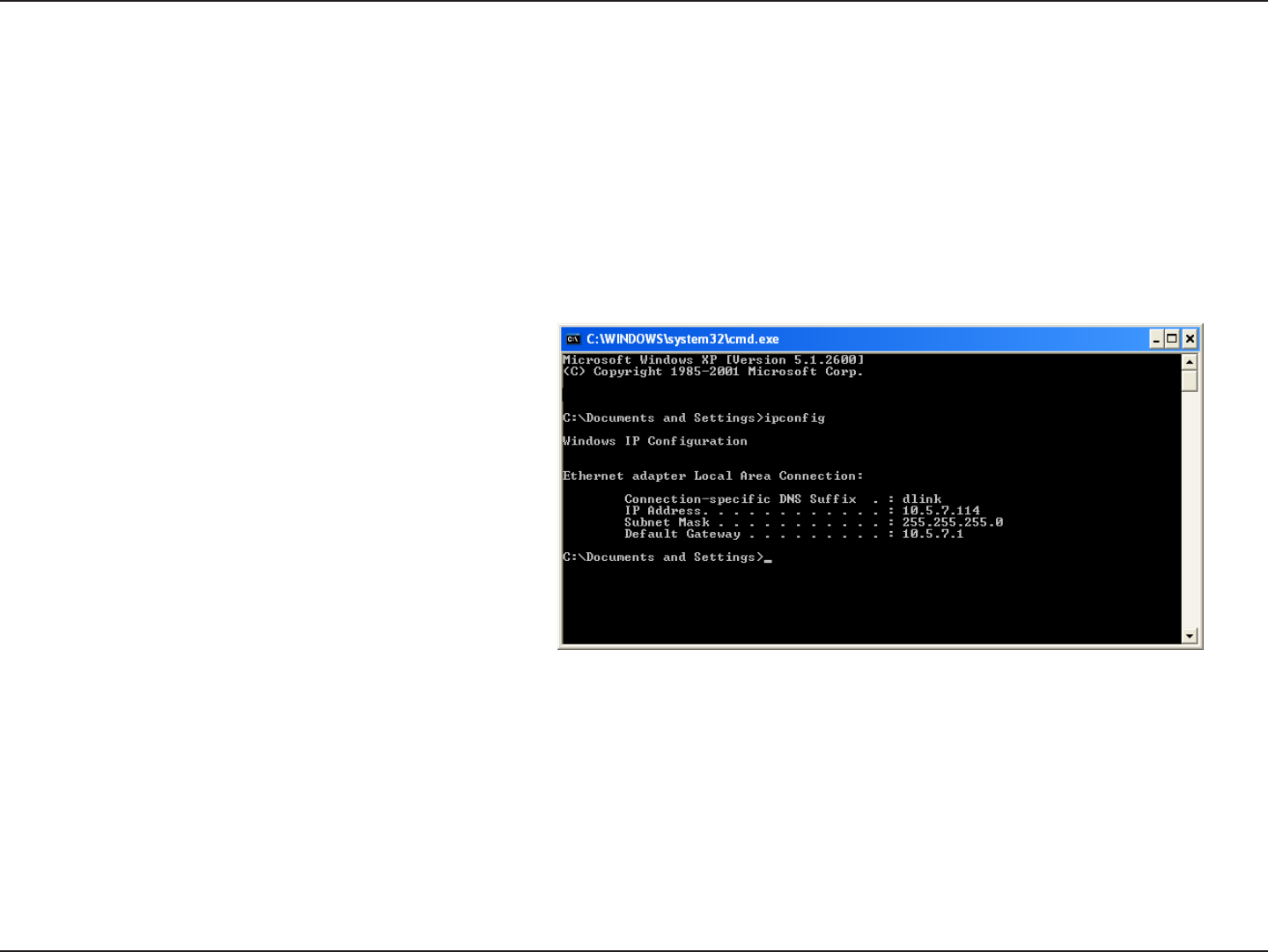
145D-Link DIR-819 User Manual
Appendix B - Networking Basics
Networking Basics
Check your IP address
After you install your new D-Link adapter, by default, the TCP/IP settings should be set to obtain an IP address from a DHCP
server (i.e. wireless router) automatically. To verify your IP address, please follow the steps below.
Click on Start > Run. In the run box type cmd and click OK. (Windows® 7/Vista® users type cmd in the Start Search box.)
At the prompt, type ipcong and press Enter.
This will display the IP address, subnet mask, and the
default gateway of your adapter.
If the address is 0.0.0.0, check your adapter installation,
security settings, and the settings on your router.
Some rewall software programs may block a DHCP
request on newly installed adapters.
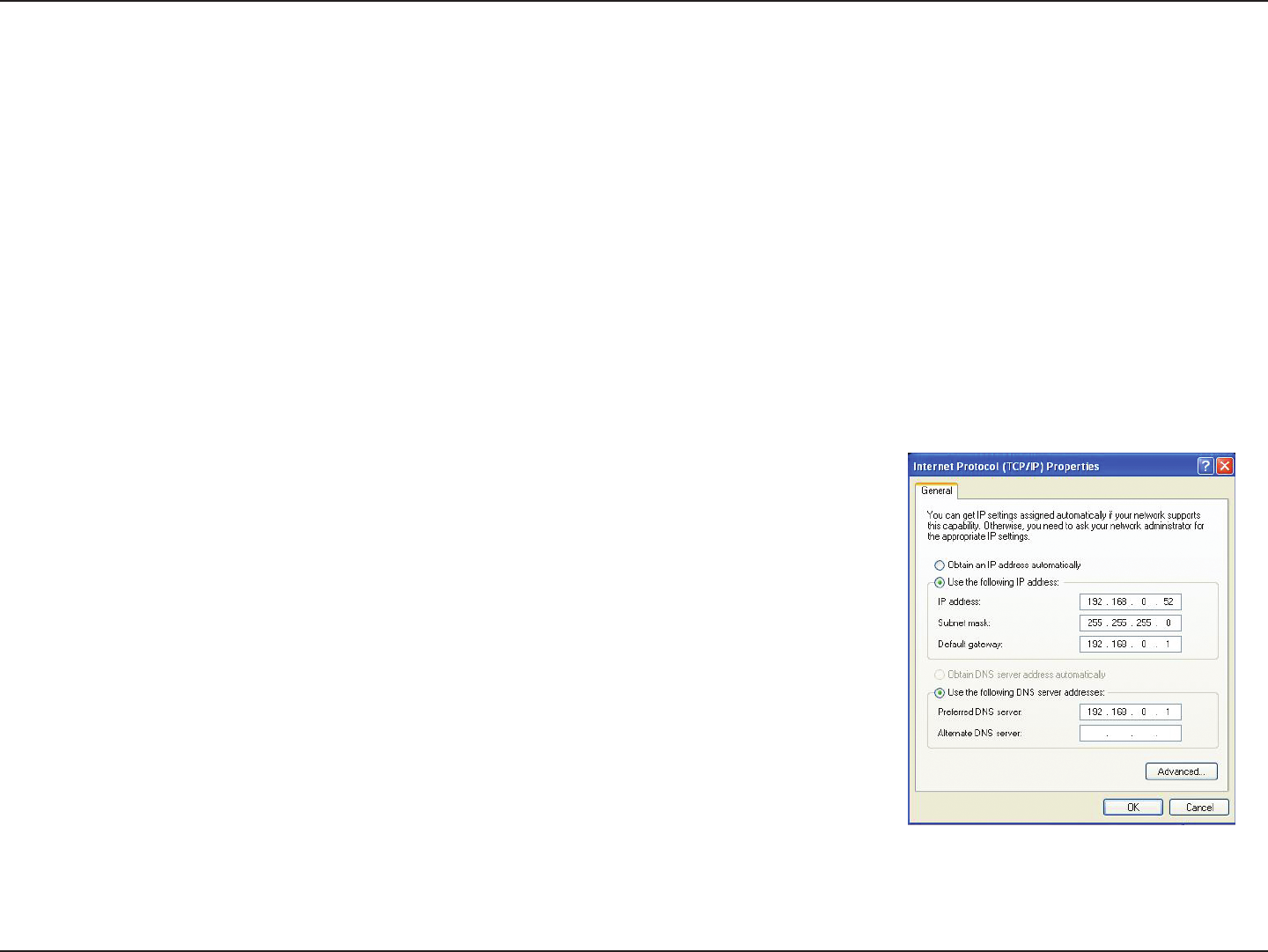
146D-Link DIR-819 User Manual
Appendix B - Networking Basics
Statically Assign an IP address
If you are not using a DHCP capable gateway/router, or you need to assign a static IP address, please follow the steps below:
Step 1
Windows® 7 - Click on Start > Control Panel > Network and Internet > Network and Sharing Center.
Windows Vista® - Click on Start > Control Panel > Network and Internet > Network and Sharing Center > Manage Network Connections.
Windows® XP - Click on Start > Control Panel > Network Connections.
Windows® 2000 - From the desktop, right-click My Network Places > Properties.
Step 2
Right-click on the Local Area Connection which represents your network adapter and select Properties.
Step 3
Highlight Internet Protocol (TCP/IP) and click Properties.
Step 4
Click Use the following IP address and enter an IP address that is on the same subnet as your network
or the LAN IP address on your router.
Example: If the router´s LAN IP address is 192.168.11.1, make your IP address 192.168.0.X where X is a
number between 2 and 99. Make sure that the number you choose is not in use on the network. Set
the Default Gateway the same as the LAN IP address of your router (I.E. 192.168.11.1).
Set Primary DNS the same as the LAN IP address of your router (192.168.11.1). The Secondary DNS is
not needed or you may enter a DNS server from your ISP.
Step 5
Click OK twice to save your settings.

147D-Link DIR-819 User Manual
Appendix B - Networking Basics
Wireless Security
This section will show you the dierent levels of security you can use to protect your data from intruders. The DIR-819 oers
the following types of security:
• WPA2 (Wi-Fi Protected Access 2) • WPA2-PSK (Pre-Shared Key)
• WPA (Wi-Fi Protected Access) • WPA-PSK (Pre-Shared Key)
What is WPA?
WPA (Wi-Fi Protected Access), is a Wi-Fi standard that was designed to improve the security features of WEP (Wired Equivalent Privacy).
The 2 major improvements over WEP:
• Improved data encryption through the Temporal Key Integrity Protocol (TKIP). TKIP scrambles the keys using a hashing
algorithm and by adding an integrity-checking feature, ensures that the keys haven’t been tampered with. WPA2 is based
on 802.11i and uses Advanced Encryption Standard (AES) instead of TKIP.
• User authentication, which is generally missing in WEP, through the extensible authentication protocol (EAP). WEP
regulates access to a wireless network based on a computer’s hardware-specic MAC address, which is relatively simple
to be snied out and stolen. EAP is built on a more secure public-key encryption system to ensure that only authorized
network users can access the network.
WPA-PSK/WPA2-PSK uses a passphrase or key to authenticate your wireless connection. The key is an alpha-numeric password between
8 and 63 characters long. The password can include symbols (!?*&_) and spaces. This key must be the exact same key entered on your
wireless router or access point.
WPA/WPA2 incorporates user authentication through the Extensible Authentication Protocol (EAP). EAP is built on a more secure public
key encryption system to ensure that only authorized network users can access the network.

148D-Link DIR-819 User Manual
Appendix C - Technical Specications
Technical Specications
1 Maximum wireless signal rate derived from IEEE Standard 802.11a, 802.11g, 802.11n, and 802.11ac specications. Actual data throughput will vary. Network conditions and environmental factors,
including volume of network trac, building materials and construction, and network overhead, lower actual data throughput rate. Environmental factors will adversely aect wireless signal range.
2 Frequency Range varies depending on country’s regulation.
3 The DIR-819 does not include 5.47-5.725 GHz in some regions.
Device Interfaces
• 802.11 ac/n/g/a/b wireless LAN
• Four 10/100 Fast Ethernet LAN ports
• One 10/100 Fast Ethernet WAN port
Antenna Types
• Three external antennas
Standards
• IEEE 802.11ac1,2,3
• IEEE 802.11n
• IEEE 802.11g
• IEEE 802.11b
• IEEE 802.11a
• IEEE 802.3
• IEEE 802.3u
Security
• WPA™ - Personal/Enterprise
• WPA2™ - Personal/Enterprise
• Wi-Fi Protected Setup (WPS) PIN/PBC
Power
• Input: 100 to 240 V AC, 50/60 Hz
• Output: 12 V DC, 0.5 A
Operating Temperature
• 0 to 40 °C (32 to 104 °F)
Storage Temperature
• -20 to 65 °C (-4 to 149 °F)
Operating Humidity
• 10% to 95% maximum (non-condensing)
Storage Humidity
• 5% to 95% maximum (non-condensing)
Certications
• FCC
• ISED
• UL
• Wi-Fi Certied
• Wi-Fi Protected Setup (WPS)
Dimensions & Weight
• L = 192 mm (7.56 inches)
• W = 108 mm (4.25 inches)
• H = 30 mm (1.8 inches)
• 240 g (8.5 ounces)

149D-Link DIR-819 User Manual
Appendix D - Regulatory Statements
Regulatory Information
Federal Communication Commission Interference Statement
This equipment has been tested and found to comply with the limits for a Class B digital device, pursuant to Part 15 of the FCC Rules. These limits
are designed to provide reasonable protection against harmful interference in a residential installation. This equipment generates, uses and
can radiate radio frequency energy and, if not installed and used in accordance with the instructions, may cause harmful interference to radio
communications. However, there is no guarantee that interference will not occur in a particular installation. If this equipment does cause harmful
interference to radio or television reception, which can be determined by turning the equipment o and on, the user is encouraged to try to
correct the interference by one of the following measures:
- Reorient or relocate the receiving antenna.
- Increase the separation between the equipment and receiver.
- Connect the equipment into an outlet on a circuit dierent from that to which the receiver is connected.
- Consult the dealer or an experienced radio/TV technician for help.
Non-modications Statement:
Any changes or modications not expressly approved by the party responsible for compliance could void the user’s authority to operate this
equipment.
Caution:
This device complies with Part 15 of the FCC Rules. Operation is subject to the following two conditions:
(1) This device may not cause harmful interference, and (2) this device must accept any interference received, including interference that
may cause undesired operation.
This device and its antenna(s) must not be co-located or operating in conjunction with any other antenna or transmitter except in accordance
with FCC multi-transmitter product procedures. For product available in the USA/Canada market, only channel 1~11 can be operated. Selection
of other channels is not possible.
Note
The country code selection is for non-USA models only and is not available to all USA models. Per FCC regulations, all WiFi product marketed in
the USA must be xed to USA operational channels only.

150D-Link DIR-819 User Manual
Appendix D - Regulatory Statements
RF Frequency Requirements
This device is for indoor use only when using all channels in the 5.125 to 5.250 GHz frequency range. High power radars are allocated as primary
users of the 5.725 to 5.850 GHz bands. These radar stations can cause interference with and/or damage this device.
It is restricted to indoor environments only.
IMPORTANT NOTICE:
FCC Radiation Exposure Statement
This equipment complies with FCC radiation exposure limits set forth for an uncontrolled environment. This equipment should be installed and
operated with minimum distance 20 cm between the radiator and your body.

151D-Link DIR-819 User Manual
Appendix D - Regulatory Statements
Innovation, Science and Economic Development Canada (ISED) Statement:
This Class B digital apparatus complies with Canadian ICES-003.
Cet appareil numérique de la classe B est conforme à la norme NMB-003 du Canada.
Innovation, Science and Economic Development Canada (ISED) Statement:
This device complies with ISED licence-exempt RSS standard(s). Operation is subject to the following two conditions:
(1) this device may not cause interference, and
(2) this device must accept any interference, including interference that may cause undesired operation of the device.
Le présent appareil est conforme aux CNR d'ISED applicables aux appareils radio exempts de licence. L'exploitation est autorisée aux deux
conditions suivantes :
(1) l'appareil ne doit pas produire de brouillage, et
(2) l'utilisateur de l'appareil doit accepter tout brouillage radioélectrique subi, même si le brouillage est susceptible d'en compromettre le
fonctionnement.
(i) the device for operation in the band 5150-5250 MHz is only for indoor use to reduce the potential for harmful interference to co-channel
mobile satellite systems;
(i) les dispositifs fonctionnant dans la bande 5150-5250 MHz sont réservés uniquement pour une utilisation à l’intérieur an de réduire les risques
de brouillage préjudiciable aux systèmes de satellites mobiles utilisant les mêmes canaux;
(iii) for devices with detachable antenna(s), the maximum antenna gain permitted for devices in the band 5725-5850 MHz shall be such that the
equipment still complies with the e.i.r.p. limits specied for point-to-point and non-point-to-point operation as appropriate;
(iii) pour les dispositifs munis d'antennes amovibles, le gain maximal d'antenne permis (pour les dispositifs utilisant la bande de 5725 à 5850
MHz) doit être conforme à la limite de la p.i.r.e. spéciée pour l'exploitation point à point et l'exploitation non point à point, selon le cas;
Radiation Exposure Statement
This equipment complies with ISED radiation exposure limits set forth for an uncontrolled environment. This equipment should be installed and
operated with minimum distance 20 cm between the radiator and your body.
Déclaration d'exposition aux radiations
Cet équipement est conforme aux limites d'exposition aux rayonnements ISED établies pour un environnement non contrôlé. Cet équipement
doit être installé et utilisé avec un minimum de 20 cm de distance entre la source de rayonnement et votre corps.